« April 2006 | Main | June 2006 »
May 31, 2006
16 Horsepower
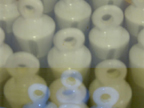
Body Modification and the "Internet of Things"
16 Horsepower, by Meghan Trainor, is a performance piece in which Trainor scans pieces of ceramic and graphite embedded with RFID tags to trigger different sounds from an audio database culminating in a series of tracks triggered by a RFID chip in her arm. This piece aims to help the audience understand and imagine the coming "Internet of Things" as well as emerging capabilities to modify the human body.
Trainor collaborated with ceramicist Michelle Anderson and programmer Stephen Koch. Anderson created 16 ceramic plumb bobs that walk a line between handmade and mass-produced objects. Koch built an application in Flash that allows her to rapidly and easily create and manage audio dense RFID projects. This piece will be debuted at the upcoming Ask the Robot show on June 4th, 2006.
Previous RFID projects: With Hidden Numbers, 2005 [video], Radio Frequency Remix, 2005 [video], RFID Project, 2004 [video].
Posted by jo at 04:26 PM | Comments (0)
MUTEK Festival - Montreal
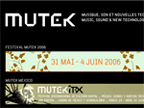
Epicenter of the World Electronic Scene
From May 31 to June 4 this year, the MUTEK Festival grabs hold of Montreal and ushers in the summer festival season by shaking up the city for its 7th consecutive year. Gathering more than 70 local and international artists, the programming for MUTEK 2006—as always—boasts several headliners and overflows with new discoveries...
With approximately 40 performances divided over 10 programs, along with its peripheral program (including panels, workshops and other diverse activities), the Festival is shaping up to be genuine whirlwind of sound, music and audiovisual creation where every event will reveal its own brand of awe-inspiring creativity. Let yourself be transported by this maelstrom of digital culture, making Montreal the epicenter of the world electronic scene for 5 full days and nights.
Posted by jo at 04:17 PM | Comments (0)
Franziska Baumann + Matthew Ostrowski
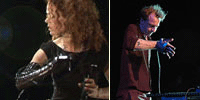
VOICE SPHERE
VOICE SPHERE / ARCHITECTURE & DESIRE (for voice, glove, and live electronics)" Featuring Franziska Baumann, Matthew Ostrowski; Slought Foundation | Friday, June 02, 2006; 8:00-10:00pm; $10.00 at Door (Reservation not required)
Please join us for a special concert with Swiss artist Franziska Baumann (voice and sensorglove live electronics) and Matthew Ostrowski (laptop and P5 glove). Baumann and Ostrowski will each play solo, then in duo. The interactive technologies pioneered by these artists enable them to control articulations of their voices and computers in real time via gesture and movement. A variety of sensors connect their music to the real world of physical phenomena.
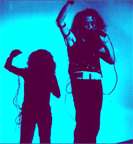
As a vocalist, Franziska Baumann explores the human voice as a multi-faceted instrument and has developed an extensive vocabulary of experimental and extended vocal techniques such as multiphonics and glottal clicks, as well as a variety of unique microtonal, timbre-modifying, and percussive vocal techniques that have become her signature sounds. In her performances, Baumann often modulates and "electrifies" her voice through the use of a SensorLab based Cyberglove linked to her Mac. She sculpts her live voice in combination with pre-composed multitrack sound-map via gesture and movement.
Matthew Ostrowski has been using electronics since the early 1980s. In an attempt to bring a truly instrumental quality to live computer music practice, he has developed a system based around the P5 glove, a commercially available video game controller.
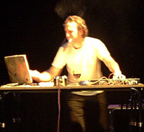
This device is connected to a Max/MSP program of his own design, which uses principles of physical modeling to control musical parameters. By manipulating virtual objects in a multidimensional parameter space, his instrument brings some of the nonlinear behaviors of physical objects into the electronic domain.
Slought Foundation | New Futures for Contemporary Life: 4017 Walnut Street, Philadelphia | Ph: 215.222.9050 | Thur-Sat 1-6pm | Director: Aaron Levy, alevy[at]slought.org
Posted by jo at 11:51 AM | Comments (0)
Summary of the Mobile Studio Web Conference, May 26, 2006
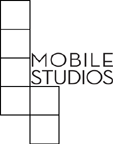
The Challenges of Curating Net Art
Summary of the Mobile Studio The Challenges of Curating Net Art Web Conference, May 26, 2006: After several attempts to connect all four parties with the festoon video conferencing system, which seemed to run quite unstable as a beta version, we switched over to the skype audio conferencing module.
Helen Thorington from Turbulence.org in Boston opened the discussion with a quote by Steve Dietz: “Internet art projects are art projects for which the net is both a sufficient and necessary condition of viewing/ expressing/ participating.” This brought the talk immediately into the question of what net art actually is, versus new media versus contemporary art and what it means to all of us to work with this terminology.
Ela Kagel from Mobile Studios thereafter added another quote, stated by Kit Galloway in 1999: “Net art is dead! Net.art (the jodi-shulgin-bunting-vuk) style was a product of a particular technical constraint: low bandwidth, net art is low bandwidth through and through.”
Ursula Endlicher, initiator of the NY round table, questioned the definition of the term, in describing her art work, which in some cases exists only on the Internet, but other work of hers also extends into “physical” space while pulling in information from the Web. In as much as it may seem to be a contradiction, to bring the net outside the screen into space, it interests her to develop interfaces and performances that communicate between the net and the “physical” space.
Michele Thursz, independent curator, added her position: “I think of net art as a data-dynamic type of work which can be seen through and on the net, and on a specific platform. To create a multi-user performance would be another way to address the net versus being net art. Regarding limitations of bandwidth, I don’t think this is the case any longer.”
At this point, Petko Dourmana, director of InterSpace in Sofia, explained: “I do not believe that the term “net art” has a meaning any longer. My business card for example says: “New media artist.” I would rather like to call it new media art, as it seems to be a broader term to me.” He then suggested that the Internet is not just present on the computer, but is rather an overall phenomenon.
Ela Kagel gave examples of different art works, which have their starting point on the Internet and then get visible in the “outside”, in the city or in public space for example, such as the project “blinkenlights” at Berlin-Alexanderplatz, produced by Chaos Computer Club Hamburg. Susa Pop, initiator of the Mobile Studios, stressed her special interest in projects like these, which have an impact on the public space and could serve as model for other nomadic projects.
Ela Kagel added, that many of the projects produced within the framework of the Mobile Studios tour, use a similar approach with the city as a stage. For example, the project CT_BT_GRAFFITI|Mausoleum.2 by Petko Dourmana and Kyd Campbell. This project proposes to virtually recast the lost physical space of the Mausoleum to Georgi Dimitrov at its former site, where the Mobile Studios were temporarily located in Sofia. The Mausoleum to Georgi Dimitrov (Sofia, BG) used to be the most remarkable public symbol during the Communistic period in Bulgaria. Using Bluetooth technology embedded in many mobile communication devices, visitors to the exhibition who have this functionality on their mobile phones are invited to activate it and will receive a series of visual and audio fragments which recreate the space of the former Mausoleum.
Question-in-between by Ela: “Is the screen of a mobile phone an exhibition space? Can we still talk about exhibitions there?”
Petko Dourmana spoke about this project and stated, that net art works should not be presented in galleries or museums. From his point of view, net.art works best in its native environment, the Internet. He gave the example of the presentation of the Bluetooth graffiti project at Kunstverein in Stuttgart where they refused to provide a curatorial structure in terms of creating a space with devices for people to interact with, but they rather asked the audience to bring their own interfaces, so that they could access the works there.
The question was raised to what extend a curator is still needed when it comes to net art?
Ela then introduced Kyd Campell, who is the initiator of the Upgrade! Sofia Festival. Kyd brought up the issue of archiving net art and problems of inaccessibility of older net art works. Should net art undergo a continuous revision? Or do these artworks represent a certain state of art and technology at a certain time and should be left like that?
Helen Thorington responded that they are trying to keep turbulence.org alive as an archive of older work and a place where new work can be seen.
At this moment Liz Slagus, director of the Education Department at Eyebeam, and Yael Kanarek, the founder of Upgrade, joined the discussion.
Liz Slagus summarized that the Education Department at Eyebeam, provides access points for a variety of audiences, also youth audiences; it hosts workshops in different media, and has public programs for adults and for artists. They also support artistic practice through workshops, programs such as The Upgrade!, which is hosted by Eyebeam, and deals with communication and community issues.
Yael Kanarek stated that the original promise of “The Upgrade!” was to provide, share and exchange ideas about technology, and build an environment for discussion, where else the different Upgrades around the world run depending on their locations and communities.
They create a place where people can come to, engage and learn.
From Sofia came the question about mediating net art and what it means to communicate net art to different audiences, and what it means to develop new audiences.
Michele Thursz answered that on the net there is no public in the same sense as there is in a Gallery space. She mentioned a new piece by Marisa Olson, “The Gif Show”, which is up in a gallery as well as at MySpace; both address a certain public space, MySapce being a semi-public space. She added that it is important to create a link between the work and the space.
At this moment, Lauren Cornell, director of Rhizome and Marisa Olson, Curator at Large at Rhizome, joined the talk. Ela asked them about their specific approach towards net art curating, especially the question where to present net art and how to contextualize the art works in an exhibition space.
Marisa described the just mentioned “Gif show”, and pointed out that some of the show was offline and some was online, in MySpace, which received more visitors than the show in the San Francisco Gallery. Both Lauren and Marisa continued talking about their curatorial practice and described the MySpace-net art presence as a community tool for a broad audience, or as a way to reach a broader audience.
Stoycho from InterSpace Sofia took the microphone and asked Lauren and Marisa about the commercial aspect of “The Gif Show” since it is presented among quite a lot of advertisement on the MySpace site. Marisa answered to this, stating that those commercial aspects have to be taken into account, especially when presenting artworks in those kinds of “public spaces” on the Internet, as Petko puts it. “For me the internet is a public space” he says.
And he added that in his opinion the role of a net art curator is obsolete. People would access the artworks on their own interfaces and machines and they would not need extra mediation.
Lauren juxtaposed Petko’s opinion that it is indeed very important to bring the work out in the public and to show it in galleries, because the works need to be communicated on platforms other than the Internet.
Helen Thorington added that she really was interested in this show, because in 1996 gifs were what everyone had to work with. Helen suggested further that everyone could talk now about proposals to curate work on MySpace. She then further mentioned the explosion of “hybrid” work, produced for instance between artist and computer scientist; she sees this explosion of hybrid work as the forerunner of what was predicted as the era of ubiquitous computing.
Here Lauren Cornell talked about Rhizome and how the work that has evolved on Rhizome, and how it has changed in the last 10 years. It is a different work now that the Internet has extended into space, onto bodies, and onto devices and off just only the Web – a terrain of hybrid works has opened up.
Ela asked Marisa and Lauren from Rhizome about their special approach with community tools for curating net art exhibitions and Lauren explained that those are important tools, because it is a goal for rhizome to encourage curating around net art and media art, and let people explore it in different ways.
Ela came in with the question, what all this meant for the role of the traditional curator, who organizes objects in space and puts them into a particular context? Could this be applied to net art?
Lauren answered that their exhibitions are set up right now so that people can organize works by linking to them; it is more about coming up with a theme and a concept, and exploring it through a choice of works. She added that the Web opens up the possibility to link to all sorts of objects, art and non-art, similar to blogs. Right now their shows have themes, which speaks to the way exhibitions are organized offline, but they also explore unique ways for exhibition online, through guest-curators and blog-formats.
Ela mentioned that she and Ursula discussed different art-shows, which dealt with net art in all different ways. When Ela visited New York they visited exhibitions were net art works were offline or put on a CD-Rom. What is the role of the curator there?
Lauren commented with a remark, that it is a common question, “Why one cannot look at net art at home?” Seeing net art on a screen in a museum doesn’t seem to live up to the promise, but at the same time net art shown in a museum like this, is a valid way of showing it.
Helen asked about Anne Barlow from the New Museum in NY, who tried joining via audio skype from San Juan. Due to technical difficulties the conversation was limited to chat functionality in skype. Ursula reminded and invited everyone to continue the conversation later in the blog, so all participants could share their opinion.
Lauren added that galleries and museums could pose a danger to net art; specifically because galleries are market driven and therefore compel net artist to transform an ephemeral piece of work into an object.
Lauren added another thought, that she thinks it is a fantastic idea for a curator, trying to mediate the art to the audience. She in her own practice as a curator is constantly working on making the audience understand the work and give context.
Liz from Eyebeam joined in and spoke about the editorial program of Eyebeam. About their offers and approaches.
Yael and Kyd said hello to each other and Kyd came closer to the web cam, because they have never met before in person. Big hello. Then they talked about the Upgrade! and the question came up: “Does The Upgrade! have an educational task as well?“
Yes, Helen said, as for her it is an essential part of those gatherings to see other artist’s work and learn from it.
Kyd talked about the local Upgrade!-meeting in Sofia, where media art centers from the countryside of Bulgaria have been invited to present themselves and their artworks. She also talked about the daily Upgrade!-talks that have been hosted by the Mobile Studios.
Lauren also asked Ela what her major concerns in net art curating were. What does net art curation mean to you? Can you tell us something about it?”
Ela talked about her experiences as a net art curator and her approach to communicate net art on a personal level, of creating a context, not just with arranging the artworks in space, but also by communicating with people and providing extra information. She then speaks about the Mobile Studios as mobile communication platform where the production, the display, but also the communication and reflection about the works of local artists all happen at the same time, or at least are a part of the same spatial and structural setting. So it all opens a new context…
Lauren added that this conversation is opening a new context.
Michele brought up that net artists or artists that are using technologies, are making use of a social structure. She then mentioned several examples, such as the Web Biennial with hack.art, and another piece, “Velvet Strike” by Anne-Marie Schleiner, a collection of spray paints to use as graffiti on the walls, ceiling, and floor of the popular network shooter game “Counter-Strike.”
All of these were not necessarily “curatorial”, but apply a certain structure to the medium.
Ursula added that there were several net art projects out there that were dealing with including other artist’s work in the piece, so the artist becomes somewhat a curator.
Ela and Ursula started wrapping up the conversation. We reached the timeframe, and skype was running now over an hour without troubles.
Ela and Ursula were thanking everyone, and invited everyone to continue the conversation and to stay in touch. Everyone agreed.
Posted by jo at 11:39 AM | Comments (0)
The Exchange Project
![]()
Toronto Free Trade
Nancy Nisbet :: The Exchange Project:: Innis Town Hall - University of Toronto, 2 Sussex Avenue, Toronto. On Sunday June 4th at 4:30PM, artist Nancy Nisbet's truck will pull up in front of Innis Townhall in Toronto where The Subtle Technologies Festival will host an Exchange event. Please bring items to trade!
Multidisciplinary artist Nancy Nisbet explores the boundaries of free trade, surveillance, and the politics of exchange from the back of a semi-transport truck. Over the next 6 months artist and professor Nancy Nisbet will drive a transport truck in excess of 30,000 km across Canada, the United States and Mexico as part of her Exchange project. The items available for trade will include all her worldly possessions, which have been catalogued and tagged with Radio Frequency Identification (RFID) technology – a widely used, but invasive form of consumer tracking. Along the way she will stop in major cities and engage in “free trades” with people she encounters – exchanging a variety of goods based on the value and richness of their stories, rather than any sort of material currency.
Posted by jo at 11:28 AM | Comments (0)
Music for Bodies
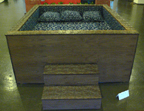
Sonically Mapping the Body to Architecture
Music for Bodies: terrestrial and virtual research into new ways of making and listening to music; directed by Kaffe Matthews.
Music for Bodies is a research project linking the sonic mapping of human bodies to architecture, through a practical study of bioresonance and interface building. Its aim is to discover new methods of experimental music making, as well as make new music more accessible to the wider community. It is doing this concentrating on making music to feel rather than just listen to. Currently it is making Sonic Beds around the world; it recently won an Award of Distinction for Digital Music at Prix Ars Electronica:
"Kaffe Matthews’ Sonic Bed_London installation consists of a bed equipped with built-in loudspeakers; when installation visitors lie down on it, an endless loop of sounds washes over them. Due to their frequency and intensity, these sounds are perceived not only with the ears but also with the entire body in what is a very pleasant experience.
The installation has already been exhibited several times and has proven to be a popular attraction with young and old alike since it harmoniously appeals to several different dimensions of human life. The choice of what is actually a rather intimate object used in everyday life as well as the proximity of other installation visitors opens up a strong social component. On the other hand, the installation also makes it possible to experience sound in a new way and thereby provides access to a new auditory dimension."

Sonic Bed_London's public launch is on Saturday June 17th, where the public are invited to come lie in it and contribute to an open forum at Annette Works studio, Hackney, London E8.
Following the launch, Matthews will run free workshops facilitating anyone wanting to make music for the Bed using this instrument over the summer after which research will continue developing and building new interfaces and new music for them.
Overall this work is intended to continue in 2 strands as follows: -
I.
To continue to develop new prototypes, interfaces/spaces, for music appreciation which interface via physical contact to the human body, carried out through collaboration with multidisciplinary professionals
II
:: To develop an understanding of the electromagnetic frequency maps of the human body and of the effect of different sonic vibrations on its different areas. To use what is learnt to build a new software instrument, a bio sonic mapping processor, (bsmp) to make music for these interfaces.
:: To use the developing bsmp to make music with members of the community for the prototype interfaces.
:: To install and test these interfaces in the community, eg. the laundrette, café, bank, chip shop.
:: To pull it back to studio, evaluate, ask questions and move the process on.
All aspects of the research will be documented here at www.musicforbodies.net
Other projects by Kaffe Matthews include Three Crosses of Queensbridge and Radio Cycle.
Posted by jo at 11:06 AM | Comments (0)
May 30, 2006
EtchASound
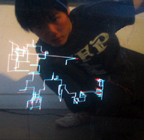
Drawn Words
You talk, and EtchASound makes your words into 3D sketches - "EtchASound is an installation inspired by the world famous toy Etch-A-Sketch. By interacting with EtchASound audiences can have the unique experience of drawing with their own voice. First the user creates a 2 dimensional image in real time with his or her voice, and after a few moments the computer converts this into a 3 dimensional drawing. Then when you wear anaglyph glasses (3d red and cyan glasses) users can see in real space the drawing that you have created." [via] - Link. & process of EtchASound (photos). [Posted by Phillip Torrone on Make Blog]
"The user's voice is input through four microphones. Volume controls the vertical and the horizontal variables. Pitch controls the depth. Therefore by using nothing but your voice you create a 3d drawing. Voice is one of our most defining characteristics, we can usually recognise a person just by his or her voice. In addition, in this project we aim to let people discover a new and creative application for their voice, namely drawing. The artist usually uses his hand to draw, but in EtchASound our voice plays the role of the hand."
Posted by jo at 02:30 PM | Comments (0)
Waves
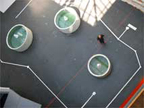
Wading Compositions
Waves is a sound installation that uses buoys to connect wading pools in two different locations and create sound compositions generated by the energy of waves in a wading pool.
An accelerometer in each buoy measures the magnitude of waves through x- and y-axis position changes caused by the rocking back and forth of the buoy on the water's surface. The accelerometer's readings are converted into sound waves by a microcontroller connected to a SPEAKjet sound synthesizer IC. The SPEAKjet's output is then amplified and sent to a speaker integrated into the buoy. Each buoy plays a electronically generated minimalistic tone that reflects the participant's movements in the wading pool.
Each group of waders create their own audio composition as they influence the magnitude and frequency of waves in the pool with their splashing and playing. When no waders are in the pool, the buoys reflect their environment by responding to the waves created by wind blowing through the park, or silence when both air and water are still.
By Shannon McMullen and Fabian Winkler. Images courtesy of the Fabian Winkler. Other work by this artist: Dielectric. [blogged by Régine on we-make-money-not-art]
Posted by jo at 02:10 PM | Comments (0)
BIENNALE of ELECTRONIC ARTS PERTH
![]()
CALL FOR PAPERS
perthDAC 2007: The Future of Digital Media Culture; 7th International Digital Arts and Culture Conference; 15 -18th September 2007, Perth, Australia.
KEYWORDS: computer games, hypertext theory and literature, new media narrative, streaming media, interactive and networked performance, digital aesthetics, interactive cinema, theory, art, bio-art, nano-art, augmented reality, cyberculture, electronic fiction, electronic music, electronic art, games culture, games system design, games theory, interactive architecture, cinema and video, MOOs, MUDs, RPG, virtual reality, virtual worlds.
ABOUT perthDAC: perthDAC is the seventh iteration of Digital Arts and Culture. DAC was the first conference to attract and present the work of researchers, practitioners and artists working across the field of digital arts, cultures, aesthetics and design. In September 2007, DAC will be hosted as the key international conference in the Public Program of the Biennale of Electronic Arts Perth (BEAP) in Perth, Australia. BEAP celebrates and critiques new and novel technologies (digital, bio, nano, other) by showcasing artworks made with, or that are about, new technologies. perthDAC's conference program will be closely inter-woven with BEAP's exhibitions.
perthDAC's academic program is being developed with the close co-operation and support of the fibreculture forum, who will also be active on the perthDAC conference steering committee.
CALL FOR PAPERS
Papers are sought for PerthDAC 2007 that will illuminate both the near and long term Future of Digital Media Culture. Papers which present research outcomes, track trends or developments, describe case studies or works in progress, are speculative projection, challenge existing paradigms or record a history, are all welcome. Submissions are encouraged from any professional, craft or scholarly field that relates to communications art/design, cultural expression, practice and aesthetics, and the technical means by which they are enabled.
perthDAC 2007 accepts submissions from fields such as the humanities, social sciences, human-computer interaction and computer science studies, as well as those working both practically and theoretically in specific areas such as: digital/interactive art, digital/electronic literature, game studies, online communities, new media studies, affective computing, experience design, virtual environment design, etc.
Topics of interests may include, but are not limited to, computer games, hypertext theory and literature, new media narrative, streaming media, interactive and networked performance, digital aesthetics, interactive cinema, theory, art, bio-art, nano-art, augmented reality, cyberculture, electronic fiction, electronic music, electronic art, games culture, games system design, games theory, interactive architecture, cinema and video, MOOs, MUDs, RPG, virtual reality, virtual worlds.
Artists, early career scholars and PhD students are particularly encouraged to submit.
All abstracts and then full papers will be double blind peer reviewed by an international panel, and will be published in the proceedings. Some papers will be published as a special themed journal edition.
Dates for the submission of 500 word abstracts and then full papers are:
Abstracts: 14th August 2006
Full papers: 4th December 2006
See the perthDAC website ³method² page for more details on the abstracts, papers and presentations process.
perthDAC website http://www.beap.org/dac
Biennale of Electronic Arts Perth
Innovation Centre
Suite 3, Enterprise Building 3
11 Brodie Hall Drive
Bentley WA 6102
AUSTRALIA
T: +61 8 6424 8203
E: admin[at]beap.org
W: http://www.beap.org
Posted by jo at 01:00 PM | Comments (0)
Johannes Birringer
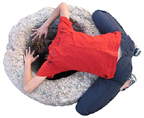
DANCE AND NEW MEDIA TECHNOLOGIES
Johannes Birringer will direct an international workshop on DANCE AND NEW MEDIA TECHNOLOGIES in Istanbul, Turkey, April 3 - 7, 16:00 - 21:00, each day at Çaty Dance Studio; There will be a final workshop demonstration / performance, Friday, April 7, 20:30. The Seminar: "Media Technologies" will be held on April 6, 11;00 - 13:00, Bilgi University, Dolapdere Kampüsü, Çizgi Atölje. This workshop is part of a larger series of events planned this year in Istanbul, involving practical laboratories, performances, and seminars with local artists and guest artists from the dance world and the dance and technology community.
Workshop and events organisation by: Vivian Saragosi, Dijan Albayrak, Ayse Orhon, Mekan Contemporary Dance Studio & (new) Contemporary Dance and Certificate Program (Bilgi University) in cooperation with Aylin Kalem, TECHNE Festival.
Posted by jo at 09:49 AM | Comments (0)
Virtueel Platform
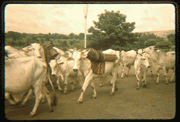
MOBILE HABITS
MOBILE HABITS: How do you trace a cow in West-Africa? Antropologists and media artists take up the challenge--Date: 29 june 2006; Time: 9.30 - 17.30; Fee: 100 Euro, student discount fee 25 Euro; How to apply: send an email with your CV and short bio to: info[at]virtueelplatform.nl
Both the arts and sciences have carried out extensive research into the issues of mobility and space. Both fields use new media such as GPS and GIS to back up their research. As a result the more recent research into mobility and space has been given a big boost. Both art and science now need each other as never before. The ‘Mobile Habits’ workshop brings artists, designers and scientists together and challenges them to exchange concepts and new working methods in relation to space, place and mobility.
Locative media artists and designers are opening themselves up to theories about mobility and space from the worlds of anthropology and social and at the same time social scientists are discovering the different cartographic and visualisation techniques found in the world of art and media design.
Mobile Lifestyles: Esther Polak is an artist working in the field of ‘locative media’. She is currently researching the possibili! ties of setting up a project in Nigeria with the Fulani, West African nomadic cattle farmers. Her initial research came up with a variety of people and researchers, including vets, anthropologists and social geographers, with a shared interest in mobile lifestyles. These various fields have come up with a number of innovative practical and theoretical tools that could be used to set up a project proposal with a well thought out, interdisciplinary basis.
Talkshop: The setting will be a ‘talk-shop’ – a cross between a workshop and a talk show. The morning session will focus on concepts and methods using a series of project presentations/case studies. The afternoon will be more interactive, with participants critically analysing the case studies in terms of what kind of insight they aim to generate – artistic, historic or practical.
Participants: Taking part in the workshop will be an interdisciplinary mix of media artists, designers and social scientists (anthropologists, social geographers) working in the field of place, mobility, storytelling and visualisation. In order to get a balanced interdisciplinary mix we ask to send a CV and short bio when applying to participate. Deadline june 8th 2006.
Speakers/support team:
Esther Polak
Esther Polak is a visual artist working in the field of new media. She is best known for two ‘locative media’ projects, AmsterdamREALTIME and the MILKproject. Both projects use GPS to &lsq! uo;imagine’ the contemporary landscape. In both projects the par ticipants were given a GPS tool to carry as they went about their daily lives. Their movements were mapped and the participants were asked to reflect upon the routes they had made. The projects resulted in large public installations. Esther Polak in constantly in search of new ways of researching space and can as such be seen as part of a long European tradition of ‘imagining the landscape’.
www.milkproject.net
www.waag.org/realtime
Christian Nold
Christian Nold is an artist and cultural activist who has spent ! the past few years mapping human emotions in the urban landscape. His research project is called Biomapping. It looks at the various ways that we as individuals can obtain information about our own body. Security technology has brought about a situation in which we are losing ownership over our own body and health. This project aims to give people access to their own biodata, to interpret and share it.
www.softhook.com
http://biomapping.net
Hanne Kirstine Adriansen
Hanne Kirstine Adriansen is a senior research fellow at the Danis h Institute for International Studies. Her training is in human geography and she has fieldwork experience from West Africa and the Middle East. Her research interests include pastoralists and their use of mobility, dryland management, and community development. She takes special interest in understanding different people\'s perception of concepts such as space and place.
Ab Drent
Ab Drent is a Master of Science in Rural Development and Management of Natural Resources in the tropics. His disciplinary specialisation is anthropology and ecology. He has followed afoot over more than 500 km nomadic Fulani herders in the Extreme North of Cameroon during ten months. Drent has written an extensive case study about the transhumance cycle of a nomadic group and tested the suitability of traditional social theories to describe the relation between man and nature. He proposes two Actor Oriented approaches and Actor Network Theory as better suited to describe the complexity and unpredictability of nomadic mobility. In a related quantitative study Drent used GPS data to build a Correlated Random Walk model to investigate the relation between mobility and environmental factors. Currently he is preparing a project with Esther Polak to visualize nomadic mobility in alternative ways combining science and art.
www.virtueelplatform.nl/mobilehabits
Virtueel Platform
Keizersgracht 264
1016 EV
Amsterdam
Nederland
Email: info[at]virtueelplatform.nl
Posted by jo at 09:19 AM | Comments (0)
SonarMatica presents Always On
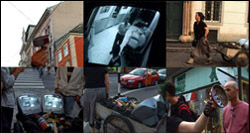
Into the Streets
ALWAYS ON--curated by Drew Hemment, José Luis de Vicente, Óscar Abril Ascaso and Advanced Music--is a display dedicated to mobile culture and location projects. It is an initiative based on exhibition and participation, taking SonarMática out onto the streets for the first time. Advance tickets for Sónar by Night as well as general passes for the three days and two nights of Sónar 2006 are already on sale.
This year, Sonarmatica presents itself more participative than ever: a game involving relationships using mobile telephones for nine hundred players at the same time organised by Blast Theory; a walk through Barcelona's electromagnetic old quarter of Ciutat Vella with Michelle Teran; and a geocaching session are some of the ideas at the exhibition.
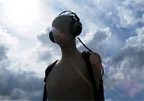
:: Participation Projects :: Those wishing to register to take part in the participation projects should go to the information stand in the exhibition: Blast Theory (UK), Day of the Figurines; Michelle Teran (CA), Life: A User's Manual; Akitsugu Maebayashi (JP), Sonic Interface; Counts Media (US), Yellow Arrow; Geocaching
:: Exhibition Projects :: Antoni Abad (ES), Taxistas, gitanos y prostitutas transmiten desde móviles en www.zexe.net; Alejandro Duque (CO), TTSM, http://soup.znerol.ch, http://co.lab.cohete.net, www1.autistici.org/communa/platanal;
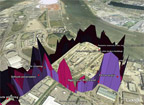
Jeremy Wood (UK), Meridians; Jens Brand (DE), gPod / G-Player; Preemptive Media (UK), Zapped!; Proboscis (UK), Urban Tapestries / Social Tapestries; Christian Nold (UK), Bio Mapping; Mark Shepard (US), Tactical Sound Garden Toolkit; Socialfiction (NL), .walk; Jeff Knowlton / Naomi Spellman (US), The Interpretive Engine for Various Places on Earth; ExtraMàtica, raster-noton, Essential Room.
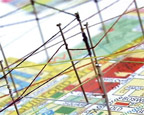
Advance tickets for Sónar by Night as well as general passes for the three days and two nights of Sónar 2006 are already on sale. Advance Tickets On-line: www.ticktackticket.com. By phone: +34 93 445 06 60: from abroad, opening hours Mon-Fri from 10.00am to 10.00pm; 902 150 025: from Spain, opening hours Mon-Sun from 10.00am until 10.00pm, from abroad, opening hours Sat-Sun from 10.00am until 10.00pm.
At any www.ticktackticket.com Sales Centre in Spain. At FNAC in France, Switzerland and Belgium: (www.fnac.com). Distribution cost not included.
Note: Neither general passes nor accreditations give admission to the Thursday the 15th concert at the L'Auditori de Barcelona
All the information at:
www.sonar.es/sonarmatica
Posted by jo at 08:55 AM | Comments (0)
May 26, 2006
Art Interactive
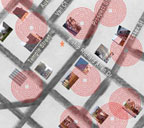
Urban Networks
Urban Networks--June 9-August 6, 2006--features five interactive art projects that examine social encounters and explorations in urban places. The works in this exhibition employ a range of technological devices that create urban community connections and offer insights into how emerging technologies might play an alternative role in our experience of everyday urban life.
Finishing School presents two projects Meet/Greet and Write/Send from the Public Interaction Objects (PIO) series. Engineered to create meaningful interaction with individuals in various public contexts, each object is informed by varying cultural customs, market economies, lifestyle, entertainment and commercial technologies.
Imaging Place by John (Craig) Freeman is a site-specific installation that consists of an interactive, location-based, virtual reality environment. The Imaging Place method uses a combination of panoramic photography, digital video, and three-dimensional technologies to investigate, document, and map locations.
Objects of Wonderment created by Urban Atmospheres is the first in a series of new public artifacts that are designed to expand our expectations of mobile phones as they transcend beyond personal connections and begin to interface directly with locations. Combining Bluetooth sensing technology with a newly fabricated public object, this work dynamically generates new urban sonic experiences.
Primarily operating outside of the gallery La rue c'est mise a nu par ses orielles, partout (the street is stripped bare by her ears, everywhere) by URBANtells, is comprised of numerous, micro am transmitters tuned to the same frequency and placed within the Central Square neighborhood.
Disembodied Voices by Jody Zellen is a multi-sensory interactive installation that explores the differences between public and private life and how the global phenomenon of public cell-phone conversations have become a ubiquitous irritant in contemporary society.
Artist Bios
Finishing School featuring Brian Boyer and Ed Giardina is a collective identity based in Southern California that enlists tactical media to investigate the intersections between educational models, critical theory, and both covert and common everyday activities.
John (Craig) Freeman is an artist and Associate Professor of New Media at Emerson College in Boston, Massachusetts. The Imaging Place project has been under development since 1997 and includes work from Sao Paulo Brazil, British Columbia, Canada, Warsaw Poland, the U.S./Mexico Border, Miami, Kaliningrad Russia, Niagara, New England, and Appalachia.
Urban Atmospheres featuring Eric Paulos and Tom Jenkins is a research group at Intel Berkeley lead by Eric Paulos. The project explores methods to explore the fabric of our emerging digital and wireless urban landscape. Eric received his PhD in Electrical Engineering and Computer Science from the University of California, Berkeley.
URBANtells featuring Steve Bradley, Joe Reinsel, and James Rouvelle is a collective of three media artists whose work focuses on the relationships between architecture, cityscape and the human and cultural geography found within any city. Their practice explores forms and modalities for enhancing connections among community residents using technology and research.
Jody Zellen is an artist living in Los Angeles, California. She works in multiple media including photography and net art, as well as artist books that explore the subject of the urban environment.
Posted by jo at 06:06 PM | Comments (0)
HTTP Gallery
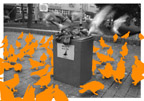
Urban Eyes
HTTP Gallery is pleased to present Urban Eyes, an intermedia project by Marcus Kirsch and Jussi Angesleva. Private View: 1st June 2006 7-9pm; Exhibition: 1st June - 9th July 2006, Friday- Sunday: 12 noon-5 pm; Unit A2, Arena Business Centre, 71 Ashfield Rd, London N4 1NY; tel: + 44 (0)20 8802 2827; info[at]http.uk.net
Urban Eyes uses wireless technology, birdseeds and city pigeons to reconnect urban dwellers with their surroundings. The Urban Eyes feeding-platform stands in one of London's public spaces. By landing on the platform, pigeons tagged with RFID chips send aerial photographs of their locality to surrounding Bluetooth-enabled devices. In this work pigeons become maverick messengers in the information super-highway, fusing feral and digital networks. HTTP Gallery provides an interface to the project, mixing live and documentary footage and offering visitors an opportunity to experiment with Bluetooth.
Being one of the last remaining signs of nature in a metropolis such as London, the urban pigeon population represents a network of ever-changing patterns more complex than anything ever produced by a machine. However pigeons' movements are based on a one-mile radius around their nest. Any pigeon you see everyday shares the same turf as you. Urban Eyes crosses and expands human mobility patterns offering to reconnect you with your neighbourhood.
In the 1960s, situationists Debord and Jorn composed psycho-geographic diagrams of Paris, which described navigational systems based on their drift through the city. For this, they used Blondel la Rougery's Plan de Paris a vol d'oiseau, a bird-eyes map of Paris. Inspired by this methodology, Urban Eyes enlists our feathered neighbours to establish a connection between the bird-eyes view of the city as now distributed by Google Earth and our terrestrial experience. [Related]
About Marcus Kirsch and Jussi Angesleva
Marcus Kirsch holds an MA in Interaction Design from Royal College of Art. He was invited to the 2004 Seoul Biennale and as exhibiting artist and to last year's Rotterdam International Film Festival and DEAF Festival. He was awarded a silver Art Directors Club NY and a fusedspace.com award in collaboration with Jussi for 'Urban Eyes'.
Jussi Angesleva holds MA in Audio Visual Media Culture from the University of Lapland in Finland, and MA in Interaction Design from the Royal College of Art and has shown at the Tokyo Metropolitan Museum of Photography, Siggraph, ZKM and Science Museum London. He has received awards from Royal Society of Arts, NESTA, from D&AD (together with Ross Cooper), Prix Ars Electronica and the Art Directors Club of Europe. He is currently working at ART+COM in Berlin, Germany and is a co-founder of new media agency Prosopon.
For more information and images, please contact Stephanie Delcroix
This project is supported by Arts Council England (London), V2 lab (Rotterdam, Netherlands) and Furtherfield.org.
Posted by jo at 05:36 PM | Comments (0)
June on empyre

Liquid Narratives
The topic of June at the - empyre - mailing list will be Liquid Narratives. The concept of 'liquid narrative' is interesting in that it allows to think about the unfoldings of contemporary languages beyond tech achievements, by relating user controlled applications with formats such as the essay (as described by Adorno in "Der Essay als Form", The essay as a form) and procedures related to the figure of the narrator (as described by Benjamin in his writings about Nikolai Leskov), among others.
How does the concept of narrative is related to comtemporary culture? Can we really describe nowadays fragmentary and user related procedures of organizing data as narratives? Should they be considered liquid, since they are fluid, reshapable, pliable? How does devices such as the GPS and mobile phones change narrative? How technologies broadband internet and DVD allow other modes of organizing them?
To debate this topic, this month, we welcome Dene Grigar, Lúcia Santaella, James Barret and Sérgio Basbaum. They will discuss how their projects and ideas can be related to the notion of 'liquid narratives', or explain how they have been thinking about connected concepts.
+ subscribe https://mail.cofa.unsw.edu.au/mailman/listinfo/empyre
+ guests
Dene Grigar (http://www.nouspace.net/dene/) is an Associate Professor of English at Texas Woman's University and specializes in new media, interactive arts and electronic literature. Her book "New Worlds, New Words: Exploring Pathways In and About Electronic Environments" (with John Barber, Hampton Press, 2001) speculates about the ways in which writing and thinking change when moved to electronic environments. She is Associate Editor of Leonardo Reviews and International Editor for Computers and Composition. Her second book, "Defiance and Decorum: Women, Public Rhetoric, and Activism" (with Laura Gray and Kay Robinson) looks at the way women have used Rhetoric to achieve social and political goals.
James Barret (http://soulsphincter.blogspot.com/) is PhD at Umeå University (Sweden). He works between the Department of Modern Languages and HUMlab, an interdisciplinary digital lab and studio. He researches narrative and textuality, focusing on stories using new media, their interpretation by peoples and cultures.
Lucia Santaella is full professor at São Paulo Catholic University (PUCSP), PhD in Literary Theory (1973-PUCSP) and Livre-docente in Communication Studies (1993-ECA/USP). She is the director of CIMID, Center of Research in Digital Media, PUCSP, and also the director of the Center for Peircean Studies. She directed the Brazilian side of a PROBRAL research project (Brasil-Germany/Capes-DAAD) on word and image relations in the media, from 2000 to 2003. She was also the director of other collective research projects: “Technical Images: from the industrial mechanical to the electronic post industrial world”, PUC/SP-FINEP, 1989-1991; a thematic research project on “The advent of new technologies and the new sound grammars”, financed by FAPESP, 1992-1995; the collective project, “Production and diffusion of scientific research in the digital era”, financed by FAPESP, 1999-2002.
Sergio Roclaw Basbaum (http://www.globalstrike.net) is PhD in Communication and Semiotics and professor at São Paulo Catholic University (PUCSP). He is author of the book “Syneathesia, art and technology - the foundations of Chromossonics” (Annablume, 2002). His PhD thesis, “The primacy of perception and its consequences to the media environment” , discusses topics such as perception, art and the relation of technology and contemporary culture. As a musician, he has released the brazilian jazz album "Captain Nemo in the All Saint's Forro" (1999).
Posted by jo at 05:18 PM | Comments (0)
The Challenges of Curating Net Art

TODAY! International Web Conference
The Challenges of Curating Net Art - An International Web Conference, LIVE online May 26, 2006: 10:00-12:00 p.m. at Mobile Studios, Sofia (3:00-5:00 p.m. EST online): presented within the framework of the local Upgrade! Sofia meeting, this web conference is hosted by the Mobile Studios project, Eyebeam, New York, and Turbulence.org in Boston. A panel of international artists and curators is meeting up virtually to discuss various aspects of the mediation, curation and funding of net art.
Hosts: Ela Kagel, digital media producer and co-initiator of Mobile Studios and Ursula Endlicher, NY-based media artist & initiator of the round table in New York.
Participants in Sofia, Bulgaria:
Susa Pop, initiator of Mobile Studios
Galia Dimtrova, curator at InterSpace Sofia
Petko Dourmana, director of InterSpace Sofia
Kyd Campbell, initiator of Upgrade! Sofia
Participants in NY/USA:
Yael Kanarek, media artist & initiator of Upgrade! New York
Liz Slagus, director of education at Eyebeam, NY
Michele Thursz, independent curator, NY
Lauren Cornell, director of Rhizome.org, NY
Anne Barlow, curator of The New Museum, NY
Participants in Boston/USA:
Jo-Anne Green, co-director of Turbulence.org and initiator of Upgrade! Boston
Helen Thorington, media artist, co-director and founder of Turbulence.org
A live stream of this event will be available at http://www.mobile-studios.org
Posted by jo at 03:00 PM | Comments (0)
CONFERENCE AND SITE-WIDE PERFORMANCES
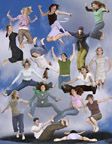
MOVEMENT AND THE VISUAL ARTS
MOVEMENT AND THE VISUAL ARTS (CONFERENCE AND SITE-WIDE PERFORMANCES): June 2, 10:00 a.m.-6:00 p.m.; The Getty Center--This day of lectures, dialogues, screenings, and performances explores the increasingly blurred line between the visual arts, dance, and other forms of performance. Featured speakers are Elise Archias, Martin Kersels, Carrie Lambert-Beatty, Babette Mangolte, Peggy Phelan, and Branislav Jakovljevic.
The L.A. Art Girls bring the conference outdoors and out-of-bounds with Fluxus-inspired artistic interventions across the Getty Center site throughout the day. Free; reservations required for the conference.

AN EVENING OF SHORT PERFORMANCES: June 3, 8:00 p.m.; The Getty Center
In conjunction with the Movement and the Visual Arts conference, the Getty Research Institute presents a wide-ranging evening of dance and performance art. Featuring the West Coast premiere of Yvonne Rainer's "AG Indexical, with a little help from H.M.," this program also showcases dance works by John Jasperse Company and Sally Silvers, and performance pieces by Martin Kersels and the L.A. Art Girls. Tickets $28, students/seniors $22.
Posted by jo at 12:52 PM | Comments (0)
Webvisions 2006 Keynote: The Naked Interface
![]()
Liberating Brain, Body and Digital Interactions
Keynote: The Naked Interface - Liberating Brain, Body and Digital Interactions by Luke Williams: Friday, July 21, 1:00 pm – 2:00 pm.; Webvisions 2006, Explore the Future of the WebJuly 20 to 21, 2006 at the Oregon Convention Center in Portland, OR.
Throughout the electronic age, people have become accustomed to interacting with digital media indirectly, mediated through screens and peripheral devices. But now, as digital technology becomes invisibly embedded in everyday things, the "feeling" of everyday things is also increasingly becoming embedded in digital technology.
In many senses, physical objects are becoming more important. In an immediate way, they can help us define new systems of relationships with digital information. This presentation will examine how perceptions and gestures formed through our experiences with physical products can effectively bring liberty to the relationship between brain, body and digital media interface.
What the audience will learn: :: How patterns and archetypes from product design now frame new ways for people to orientate themselves around information. :: The principle of stimulating one sense through another to create multi-sensory interactions. :: New developments at the collision point between "real world" objects and "digital interfaces" – the touch screen.
Posted by jo at 12:36 PM | Comments (0)
Poker Club, Scotland
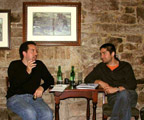
Haque + Bleecker
The Poker Club at the Beehive Inn in Edinburgh featured Usman Haque (artist / architect) and Julian Bleecker (technologist / artist / think tank leader) to discuss the "internet of things" and "open source architecture". Hosted by New Media Scotland.
Both presenters took us through a short run down of their work and then there was a lively exchange between everyone present. Hopefully there will be a podcast from New Media Scotland in the near future.
Haque's presentation was broken into three categories: Invisible Stuff, Collaborative Stuff (produced by non experts - or vernacular creativity) and Social Space. He talked about Architecture as an operating system for the collaborative production of space. He stressed the importance of the necessity of the system (whether an augmented object or space) to have the capacity to build 'its' own perceptual categories. Several examples of previous and current work were shown.
Bleecker started with the question 'Is life hackable?' He characterised the upsurge of activity as a renewed or second order humanism. The term 'change agents' was used and it was pointed out that these are no longer well positioned parties such as New York Times reporters. Several projects were shown which showed how digital networks can shape physical activities in a sort of network practice - social practice continuum. It was stressed that we're not just talking about data transactions.
Some interesting points that came up in the discussion:
:: We are surrounded by invisible information, how do we make this visible or legible?
:: Technology extends the zone of our perception/agency.
::Is the web of objects the end of subjectivity or a new beginning for subjectivity?
:: The role of human beings as filters.
The issues emerging for me are what do we mean by 'understanding' in relation to all the information we have access to and how do we have agency within it? One thing that came up over and over was the spatial or prepositional nature of our relationship to the digital networked public. As Bleeker points out in Why Things Matter are we 'on' or 'in' the network?
[posted by John Marshall on Designed Objects]
Posted by jo at 12:22 PM | Comments (0)
HOW TO - Extract DNA from anything living
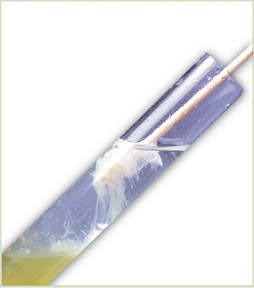
Here's how to extract DNA from peas (or just about anything else) using meat tenderizer for enzymes, water, rubbing alcohol, salt and a blender - Link. [posted by Phillip Torrone on Make Blog]
Posted by jo at 12:01 PM | Comments (0)
Make Podcast:

Graffiti Research Lab's Throwies at the Maker Faire
James Powderly sat down with me and walked me through the process of making throwies. They are easy to make and fun to throw on things. Graffiti Research Labs brought in a bus and they let people make throwies to throw on things. In this video (see original post), James explains that throwies are more than little lights to throw around. GRL takes it conceptually deeper by exploring political issues around prison time for graffiti artists and bringing those issues to communities in a gentle way...
Previous Throwie Articles: howto, throwie talkies, on/off tabs, and motion sensitive. Thowie instructions and interesting discussion is over at instructables and for subscribers, here is the Digital Edition Throwie Article. I used a few seconds of footage from two GRL videos that you can watch here and here. Both vids are great. Go watch them too! Click here to get the video (MP4) delivered automatically with iTunes. This video will play on PC/Mac/Linux/PSPs and iPod video devices - Link. Make Podcast. [Posted by Bre Pettis on MAKE Blog]
Posted by jo at 11:55 AM | Comments (0)
Régine Debatty's

Interview with Blendid
I've met several talented interaction designers and new media artists who have to accept jobs they are not exactly thrilled about in order to be able to "work on their own stuff" in their leisure time. Fortunately I've also met creative practitioners who were brave enough to set up their own practice and do not look back. David Kousemaker, Thomas de Bruin and Tim Olden from the interaction design collective Blendid are three of them. They met at the HKU (Utrecht School of the Arts) and over the past few years they have cooperated on a number of projects about experimental interfaces.
Among the works of the Amsterdam-based studio is Demor, an immersive outdoor game experience for visually impaired children; Robotract, an augmented reality game; TouchMe, an interactive installation that allows the public to leave a personal imprint in the public space. Experimenting with the whole body of a dancer as an input device they also created the Mocap Performance. Continue reading >> [blogged by Régine on we-make-money-not-art]
Posted by jo at 11:06 AM | Comments (0)
Google Bono
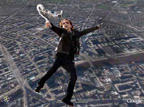
Probability of Seeing Bono in Dublin
Stunned is pleased to announce the Bono Probability Positioning System version 2: Google Bono. We know that for a visitor to Dublin an important attraction is the possibility that they may see U2 frontman and international celebrity Bono.
Google Bono (beta) is a mashup utilising Dublin's extensive surveillance camera network in conjunction with facial recognition software, Google Maps and advanced probabilty techniques to allow visitors to determine the probability of seeing Bono in any of the most probable locations in Dublin's city centre in real time. [blogged by Joel Holmberg on Eyebeam reBlog]
Posted by jo at 07:59 AM | Comments (0)
May 25, 2006
Mawhrin-Skel
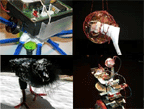
Autonomous Robots
Mawhrin-Skel--by Deanne Achong, Kate Armstrong, Joelle Ciona, David Floren, and Matt Smith, with help from Dina González Mascaró--brings together an eclectic group of local Vancouver artists, who work variously in new media, electronics, sculpture, installation and performance, to create autonmous robots that communicate with one another wirelessly via the internet.
The project--Sheryl [Crowbot] (DA), The Problem of Other Minds (KA), TangleBot (JC), Phono, Mono, and ChartBot (DF), RadBot (MS)--is based on a fictional character--"Mawhrin-Skel"--an intelligent drone that, having failed to meet the conditions of its original purpose, is decommissioned and left to wander aimlessly through a near utopian environment where it becomes a social nuisance and prankster. This character - invented by Ian M Banks in his 1989 novel "The Player of Games" - provides an interesting social and cultural entry point into the study of robots as both cultural artifacts and autonomous members of society.
Robots typically have industrial applications - wireless mines that can dig their way out of the earth and move to a "better" location, machines that cleanup radioactive waste or other hazardous material, surveillance equipment, toasters, coffee makers, etc. It is unusual to build a robot that doesn't have an overt industrial purpose - it may be decorative, dysfunctional, nailed to a tree and bleeping. It exists purely to raise questions about industrial and technological philosophies and ethics in our society. This project examines ideas of function, autonomy, artificial intelligence and purpose-driven technology.
These objects are intended to sit on window sills, desk corners, over doorways, nailed to a post on the back deck, in the gravel pit in the basement, etc. The wireless Internet connection allows the devices to talk to each other and mingle their conversations on the web. The "eyes" of one machine can influence the actions of another. Keywords can generate furious activity or silence. Following the series of workshops, the results of the artists' experiments with robots will be exhibited to the public through a number of events in May 2006 and January 2007.
The Mawhrin-Skel robots communicate with each other using the Scrambler - a message server that was developed in 2003 to connect electronic installation works around the world.
Posted by jo at 10:44 AM | Comments (0)
UBERMORGEN.COM's ART FID [F]original
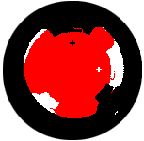
Authenticity as Consensual Hallucination
UBERMORGEN.COM's ART FID [F]original - Authenticity as Consensual Hallucination: Hartware MedienKunstVerein at PHOENIX Halle; in the framework of medien_kunst_netz dortmund; in cooperation with [plug.in], Basel, and overgaden, Copenhagen.
RFID (Radio Frequency Identification) tags are small ’passive radio' tags equipped with silicon chips and antennas “to enable them to receive and respond to radio-frequency queries from an RFID transceiver" (Wikipedia). In the very near future, they will replace the barcode and will play an enormous role in logistics, theft prevention and surveillance of individuals. In an installation consisting of a stylized conveyor belt, several large-format pixel paintings (ART FID, 2005) and a mass of RFID tags, UBERMORGEN.COM scrutinizes the promises of a “beautiful new world".
UBERMORGEN.COM has coined the term “[F]originals".“[F]originals" designate any “original" documents or legal papers that in the narrow sense of the word are not originals any more, i.e. such documents which have been created “by the machine" (in German: “maschinell erstellt") and which are “valid without signature". “[F]original" is a neologism from “to forge" and “original". In the end, according to UBERMORGEN.COM, such “[f]original" documents are nothing more than Pixels on a screen and ink on paper. [F]originals claim authenticity but at closer inspection turn out to be nothing more that a “consensual hallucination." (William Gibson).
The presentation at PHOENIX Halle Dortmund is the first solo show of the Swiss-Austrian artists' duo in Germany. In the mid-1990s, the members of UBERMORGEN.COM were co-founders of the radical Swiss net art group etoy which became famous in 1999/2000 for its spectacular action toywar.com.
PHOENIX Halle Dortmund: May 27 - July 16, 2006; Opening: Friday, May 26, 2006, 17:00. Welcome and introduction: Susanne Ackers, managing director of Hartware MedienKunstVerein, Dortmund, and Jacob Lillemose, overgaden, Copenhagen.
More information. See here also the text by Domenico Quaranta, “Lilly controls my Foriginals"
In cooperation with Kulturbuero Stadt Dortmund, dortmund-project, LEG, PHOENIX
Generously supported by Pro Helvetia - Schweizer Kulturstiftung; Bundesamt fuer Kultur
Opening hours: Wed 11:00 - 17:00, Thu - Sun 11:00 - 20:00
Admission: 4 Euro, reduced 2 Euro (including admission to the exhibitions “Glamour and Globalization" and “Solar Radio Station")
Catalogue: A book will be published at the end of the year (English).
Guided tours: Free guided tours at PHOENIX Halle each Sunday at 16:00 (in German) (included in the admission)
How to get there relatively quickly >>
Contact: Hartware MedienKunstVerein, Guentherstrasse 65, 44143 Dortmund Telefon ++49 (0)231 823 106, info[at]hmkv.de
Posted by jo at 10:26 AM | Comments (0)
IN[ ]EX
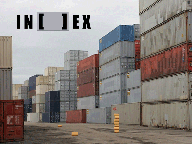
Container Culture
Panel Discussion: RHYTHMS OF URBANITY: MAPPING THE PUBLIC SPHERE THROUGH SOCIO-POLITICAL FORCES--Thursday, May 25 at 7 pm; Room 403, Vancouver Art Gallery.
This public discussion among artists Kate Armstrong, Bobbi Kozinuk, M. Simon Levin, Laurie Long, Leonard Paul, Manuel Piña, Jean Routhier, and curator Alice Ming Wai Jim will speak to “container culture” and the idea that the public sphere is rapidly being privatized and now reflects more on the movement of goods and capital than on the expression of individual rights. in[ ]ex, their interactive, city-wide media art project, will first be exhibited in connection with Centre A and the World Urban Forum in Vancouver, Canada in June 2006, and then in San Jose, California in connection with the Container Culture exhibition at ISEA in August.
In[ ]ex is an audio sculpture which creates a mesh network by releasing thousands of embedded wooden blocks into the world. The mesh network collects and processes data to form a sound environment in the space of a shipping container. This project takes place in the context of shipping and distribution of goods and the movement of people in the two port cities of Vancouver, British Columbia, and San Jose, California. In[ ]ex engages both the subject of things and the mechanisms by which things are distributed in the global economy.
Posted by jo at 10:12 AM | Comments (0)
Art, Emergence, and the Computational Sublime
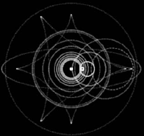
More than the Sum of its Parts
Abstract: This paper looks at some critical and technical issues of relevance to generative art. In particular, it examines the concept of emergence, looking at its historical origins and salient issues surrounding its classification and meaning for developing generative art. These issues include the hierarchy of levels associated with emergence, recognition and ontology of patterns, prediction and determinism. Each of these are then related to attempts to create emergent phenomena with computers for artistic purposes. Several methodologies for developing emergent generative art are discussed including what is termed in the paper “the computational sublime”. This definition is considered in relation to historical and contemporary definitions of the sublime and is posited as a way for artists to suggest their work is more than the sum of its parts." Art, Emergence, and the Computational Sublime by Jon McCormack and Alan Dorin. [Related: Ekpurosis]
Posted by jo at 10:01 AM | Comments (0)
May 24, 2006
Bruce Sterling

The Future of Media Arts
Ally #1, Bruce Sterling, has laid down another phenomenal rant, this time on the future of media arts. It's a lovely stroll through ubiquitous computing, how the Internet of things maps to the 3D world, and why the art world has a critical role to play in understanding how this new blending of smart places, spimes, and systems for making visible the invisible come together, an exploration of what art becomes when the actual is the new virtual. If you have no idea what we mean when we use these phrases, it's even more worth your time.
You can listen to the entire talk here. [blogged by Alex Steffen on World Changing]
Posted by jo at 05:44 PM | Comments (0)
Open Source House
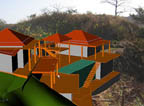
Using Flickr for Participatory Architecture
Rahm Rechtschaffen, an architecture student at Catholic University in Washington DC, is using Flickr to run a participatory architecture project for his senior thesis. We've talked about applications of open source in architecture and design before, and the potential that OS could open for transformation in those fields.
"Unlike the software programmers that participate in open source design projects, the end users of most architectural projects are neither steeped in the guiding principles of architectural design, nor are they able to the use the tools required to create a design," says Rechtschaffen in his introduction to the project, "Although architects often go back and forth between design and client, the architect always keeps the client management and the design process separate. In an open source project the client would be directly involved in the design process."
The idea here is not to eliminate the architect, but to permit all future users of the space full access and participation to any part of the planning and design process, at any time. By putting the project on Flickr, users can track the progress of various contributions and changes as they make their own. Because it's a public project on Flickr, even unsolicited contributors can jump in if they so desire.
Rechtschaffen ran a survey a few months ago to determine how the project was progressing. Based upon the feedback, he developed several new iterations and invited the next round of contributions. He has tracked the entire process in both visual and textual detail on Flickr. It's interesting to scroll through and read the commentary at various stages in the process, which has now been underway for about 4 months.
Where will this fully-participatory ideal dwelling be? A hillside in Costa Rica, an obvious place for utopian dreams to come alive. via: Tropolism [blogged by Sarah Rich on World Changing]
Posted by jo at 05:34 PM | Comments (0)
Discourse Is a Weapon:
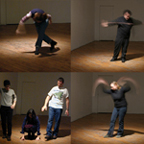
a Legacy Continues
"The history of most artistic disciplines is full of figures that fulfilled several roles at once, often out of necessity. When mediums or concepts are new and inaccessible to the writers, curators, and producers who can help solidify and critically frame a discipline, it’s often left to the artist to explain the new thing. Here, Paddy Johnson surveys various New Media artists who, faced with chronic lack of institutional recognition, have proactively shaped the discourse around their medium through writing and curatorial work." Discourse Is a Weapon: a Legacy Continues by Paddy Johnson, NYFA Current.
Posted by jo at 01:45 PM | Comments (0)
The Institute for Infinitely Small Things
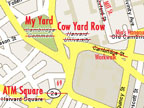
Initiative for the Renaming of Names in Cambridge
The Institute for Infinitely Small Things is a highly original research organization based in Boston, whose mission is to invent and distribute new practices of political engagement in everyday life. This June, they are inviting members of the public to join them in a series of renaming expeditions in Cambridge, which will result in the publication of a new map of The City Formerly Known as Cambridge.
To rename a street, park, square or other part of Cambridge, MA, simply attend an expedition and fill out a form to justify your reasons for renaming. The first expedition takes place on June 1st at the public opening ceremony of the newly redesigned Porter Square plaza. As soon as it is officially named, it will be renamed! [blogged on GUERRILLA INNOVATION]
Posted by jo at 11:20 AM | Comments (0)
DIGITAL TERRITORY: BUBBLES
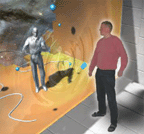
The Domestication of the Ambient Intelligence Space
"[...] By defining digital borders, the vision of digital territory creates a continuum between the physical world and its digitised counterpart. The construction of digital boundaries consolidates the gateways already established between these two worlds. This paradox will be catalysed by the implementation of a growing number of bridges between the two environments. Location-based services, radio frequency identification tags, body implants, ambient intelligence sensors, etc. will permit the implementation of a trustworthy environment and therefore the domestication of the ambient intelligence space by the individual. The vision will facilitate the transition through a traditional society that coexists with an information society, to a single society whose citizens have accepted and adopted the fusion of physical and digital realities. In this future society, people will still be able to control and manage distance from others with new tools provided by ambient intelligence space technologies." From DIGITAL TERRITORY: BUBBLES by Laurent Beslay and Hannu Hakala.
Posted by jo at 11:03 AM | Comments (0)
Seeing Machine
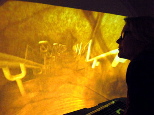
Accessing Texts, Visual Poetry and Architecture
MIT researchers have developed a portable Seeing Machine, a system that could aid some blind people by projecting images directly onto the retina of the eye. Project leader Elizabeth Goldring first conceived of the device ten years ago when she was blind in both eyes due to hemorrhages in her retinas. (Surgery has since enabled her to see with one eye.) A physician examined Goldring with a scanning laser opthalmoscope (SLO), a $100,000 diagnostic medical device that uses a laser to project an image on the retina and detect damage. The Seeing Machine is based on similar technology but the prototype cost just $4,000. (The image here depicts Goldring looking at "an image she created to approximate what she sees when she looks through her seeing machine at an image of a staircase.") From MIT News Office:
Recently the machine received positive feedback from 10 visually challenged people with a range of causes for their vision loss who tested it in a pilot clinical trial...
Participants used the machine to view 10 examples of Goldring's visual language. A majority -- six -- interpreted all 10 "word-images" correctly. "They responded really well to the visual language," Goldring said. "One woman told me she would love to see recipes written that way."
They also used the machine to navigate through a virtual environment, raising the potential for "previewing" unfamiliar buildings a person wants to visit...
All of the participants reported that the machine "may have the potential to assist their mobility in unfamiliar environments," according to the Optometry article. Concluded Goldring: "A couple of them said they'd tried every seeing aid available (magnifying devices, etc.), and this was by far the best, even in this rough, rough shape." Link [posted by David Pescovitz on Boing Boing]
Posted by jo at 10:30 AM | Comments (0)
[ctrl] [alt]: alternatives, encounters, movements
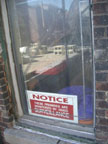
Confronting Mechanisms of Control
[ctrl] [alt]: alternatives, encounters, movements: ; May 3-6, 2007, Montreal, Quebec, Canada. Call for Contributions: Submission due date: September, 18 2006.
In the Fall of 2004, 90 activists, artists and academics from diverse disciplines gathered at McGill University in Montréal, Canada to explore the threat of a global society moving into networks of mechanisms of control. From RFID chips to the cult of beauty, from the Patriot Act to Canadian multicultural policy, from the War on Drugs to the War on Terror, conference participants explored the pressing realities of social, political, economic and institutional modes of control and the urgent significance of constructing an actional politics to (en)counter them.
The challenge of theorizing and developing new forms of resistance will be taken up in [ctrl] [alt]: alternatives, encounters, movements. As the conference's subtitle indicates, [ctrl] [alt] will address potential strategies and tactics for confronting these mechanisms of control.
Working from the notion that control is often best (en)countered via practices that engage experimental methods, transdisciplinarity and creativity, we hope to foster an environment in which we can construct collective visions for social change.
Academia often regards itself as an end in itself, apart from concrete social struggles. Even when progressive academics engage the social world theoretically, they often do not acknowledge an indebtedness to, and impact upon, political struggles. At the same time, anti-intellectualism often circulates within activist groups. And art often becomes a fashionable and institutionalized product, failing to actualize its radical potential.
Given this mess, we seek imaginative works that cross borders between genres and disciplines including the highly political boundaries between art practice, academia and activism. We are particularly interested in papers, panels, roundtables, workshops, interventions, performances and artworks that incorporate critical, anti-oppressive perspectives. We invite contributions by artists, activists, scholars and writers as well as any others working in non-traditional spaces of knowledge production.
Possible themes to address include, but are not limited to:
Alternatives to [CTRL]
non-capitalist economic practices
critical pedagogies/pedagogies of the
oppressed
sub, post-sub and counter cultures
sex/gender radicalism
queering culture and cultural space
reclaiming/creating public and community
space
radical citizenship
Anti-copyright, Copyleft and Creative
Commons practices
alternative, radical, autonomous, tactical, and
citizens¹ medias
anticorporate cultural production
Encountering [CTRL]
art as activism/activism as art
writing resistance/resistant writing
mapping resistance/resistant mapping
cosmopolitics
decolonialization and postcoloniality
negotiating governmentality and bureaucracy
Movements against [CTRL]
immigrant, refugee and migrant worker
movements
affinity politics and coalition building
post/modern protests
transnational feminisms
radical queer movements
unions and organized labour
chaos, ontological anarchy and Temporary
Autonomous Zones
theatre in the street
the media democracy movement
net.criticism, hacktivism, hacker media
diasporic communities
global social justice movements
indigenous movements
anticapitalism and anti-imperialism
co-op movements
squatter movements
artisinal movements, D.I.Y. and crafting
culture
artist-run movements
dis/ability movements
anti-poverty movements
antiracist movements
anti-oppression training
Please send submissions by September, 18 2006.
_SUBMISSIONS_
For individual papers, workshops or roundtables send abstracts of 250 words
max. in .rtf format to : submissions[at]ctrlconference.org.
Workshops are interactive and instructive sessions led by individual or group (1-2 hours). Roundtables are facilitated group discussion around a specific theme or question (1-2 hours).
For panels, send abstracts of 600 words max. which includes both panel rationale and individual paper abstracts in .rtf format to: submissions[at]ctrlconference.org
Panels are collections of individual papers around the same theme or issue (1-2 hours).
For art projects & performances, send an artists statement (250 words max) and a description of the proposed project (250 words max) including materials needed in [.rtf] format to: horea[at]ctrlconference.org.
If images or documentation of the project are available, please contact Horea to make arrangements.
Interventions: Show up!
Please address general inquiries to: ctrlalt[at]ctrlconference.org
Posted by jo at 08:37 AM | Comments (0)
May 23, 2006
Pimp my Heart

HBBB (HeartBeat Bass Booster)
Pimp my Heart is a system that amplifies the heartbeat of a car driver in real time through a special interface with a beefed up car audio aftermarket system, to achieve an ultimate unity between car & driver. The Pimp my Heart system consists of a 'heartbeat bling bling' sensor that is clipped to the ear lobe, & a 'heartbeat bass booster' that amplifies the heartbeat sound with its high power amp & subwoofers. the BPM of songs is adjusted by the heart beat rate in real time. A computer LCD monitor on the car displays a visualization of the heartbeat sound in real-time. see also heartbeat bracelets & heartbeat water bowl & heart songs & heartbeat virtual worlds. [takehitoetani.com|via we-make-money-not-art.com] [blogged on information aesthetics]
Posted by jo at 06:08 PM | Comments (0)
Ursula Endlicher
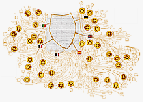
Website Portrait Performances
Ursula Endlicher's Website Portrait Performances (WPPs) consist of graphical visualizations of the hyper-links of a particular website which illustrate the link structure two levels down into it. How the website is written in HTML will define how the links are displayed in the graphic. The grammar of one medium (HTML) is applied to another (graphic).
Furthermore these visualizations are read as so-called "dance notations". Each link is performed depending on how the individual node is defined in the graphic. If a link shows seventy sub-links (HTML) for example, the performance ("dance") will consist of seventy movements. Finally, each link selected by the user also simultaneously displays the real-time URL of the according page of the specific website on a secondary monitor (installation) or window (web).

The "www.whitehouse.gov" Website Portrait Performance exists as interactive installation with "mouse-chair", projection, secondary monitor and real-time web-feed. It also has a web-based version. Other web-based projects in this series are "www.vatican.va" and "www.morexoptimo.com".
Website Portrait Performances are another manifestation of my ongoing interest and research in translating the Web's grammar into other mediums, in this case by superimposing the link structure of a website onto a graphical representation and performances. With the interactive mouse-chair I developed an interface that engages the whole body; a navigation device which expresses my ongoing longing for alternative human-machine communication interfaces.
Posted by jo at 04:54 PM | Comments (0)
GAM3R 7H30RY 1.1 is live!
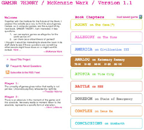
McKenzie Wark's Networked Book
The Institute has published its first networked book, GAM3R 7H30RY 1.1 by McKenzie Wark! This is a fascinating look at video games as allegories of the world we live in, and (we think) a compelling approach to publishing in the network environment. As with Mitch Stephens' ongoing experiment at Without Gods, we're interested here in a process-oriented approach to writing, opening the book up to discussion and debate while it's still being written.
Inside the book, you'll find comment streams adjacent to each individual paragraph, inviting readers to respond to the text on a fine-grained level. Doing the comments this way (next to, not below, the parent posts) came out of a desire to break out of the usual top-down hierarchy of blog-based discussion — something we've talked about periodically here. There's also a free-fire forum where people can start their own threads about the games dealt with in the book or about the experience of game play in general. It's also a place to tackle meta-questions about networked books and to evaluate the successes and failings of our experiment. The gateway to the forum is a graphical topic pool in which conversations float along axes of time and quantity, giving a sense of the shape of the discussion.
Both sections of GAM3R 7H30RY 1.1 — the book and the forum — are designed to challenge current design conventions and to generate thoughtful exchange on the meaning of games. McKenzie will actively participate in these discussions and draw upon them in subsequent drafts of his book. The current version is published under a Creative Commons license.
And like the book, the site is a work in progress. We fully intend to make modifications and add new features as we go. Here's to putting theory into practice!
(You can read archived posts documenting the various design stages of GAM3R 7H30RY 1.1 here.) [posted by ben vershbow on Future of the Book]
Posted by jo at 02:02 PM | Comments (0)
Golden Nica in Net Vision
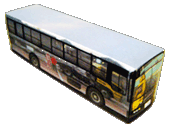
The Road Movie
And the Golden Nica in Net Vision, awarded by Prix Ars Electronica 2006, goes to...The Road Movie, by exonemo (JP), what might be called a mobile installation that originated in conjunction with a live project entitled MobLab in which young Japanese and German artists undertook encounters with art and communication during a journey by bus through Japan. While the group was traveling through a wide variety of landscapes, the webcam mounted on the bus produced five images of the surroundings every five minutes. The image files were uploaded to the Internet in the form of a piece of origami art. Anyone who wants to can print out this origami and create his own road movie with folded busses. Far-off locations are suddenly to be found right in ones own living room.
Posted by jo at 01:47 PM | Comments (0)
Paul DeMarinis

The Messenger Delivers a Golden Nica
The Messenger (1998) by Paul DeMarinis has been awarded the Golden Nica for Interactive Art by Prix Ars Electronica 2006. In The Messenger, email messages received over the internet are displayed letter by letter on three alphabetic telegraph receivers: a large array of 26 talking washbasins, each intoning a letter of the alphabet in Spanish; a chorus line of 26 dancing skeletons and a series of 26 electrolytic jars with metal electrodes in the form of the letters A to Z that oscillate and bubble when electricity is passed through them. Movie.
"The Messenger is an internet-driven installation based on early proposals for the electrical telegraph, in particular those made by the Catalan scientist Francisco Salvá. As in many of my works I examine the metaphors encoded within technology, especially lost or orphaned technologies and try to trace their origins, speculating on the way that mechanisms are the repositories of larger unspoken conceptions and dreams. In The Messenger I take the telegraph as a point of departure from which to examine the relationship between electricity and democracy, and how electrical telecommunication technologies have participated in our solidarity and in our isolation, in our equality and our oppression, in the richness of our experience and the uncertainty of our lives." -- Paul DeMarinis
Paul DeMarinis has been working as an electronic media artist since 1971 and has created numerous performance works, sound and computer installations and interactive electronic inventions. He has performed internationally, at The Kitchen, Festival d'Automne a Paris, Het Apollohuis in Holland and at Ars Electronica in Linz and created music for Merce Cunningham Dance Co. His interactive audio artworks have been shown at the I.C.C. in Tokyo, Bravin Post Lee Gallery in New York and The Museum of Modern Art in San Francisco. He has been an Artist-in-Residence at The Exploratorium and at Xerox PARC and has received major awards and fellowships in both Visual Arts and Music from The National Endowment for the Arts, N.Y.F.A., N.Y.S.C.A., the John Simon Guggenheim Foundation, the Rockefeller Foundation New Media Award and the D.A.A.D. Berlin Artist Fellowship.
Much of his work involves speech processed and synthesized by computers, available on the Lovely Music Ltd. compact disc "Music as a Second Language", and the Apollohuis CD "A Listener's Companion" Major installation works include "The Edison Effect" that uses optics and computers to make new sounds by scanning ancient phonograph records with lasers, "Gray Matter" that uses the interaction of body and electricity to make music, and "The Messenger" and "Firebirds" that examine the myths of electrical communication. Public artworks include large scale interactive installations at Park Tower Hall in Tokyo, at the 1996 Olympics in Atlanta and Expo 1998 in Lisbon and an interactive audio environment at the Ft. Lauderdale International Airport in 2003.
Posted by jo at 01:36 PM | Comments (0)
May 22, 2006
Marching Plague: Germ Warfare and Global Public Health

Book Release + Anti-War Event
Please join us for a book launch and an evening of conversation concerning contemporary warfare: an anti-war event--Wednesday May 24, 2006 - 6:00-8:30 p.m.
Critical Art Ensemble present their latest book, Marching Plague: Germ Warfare and Global Public Health published by Autonomedia and coinciding with the inclusion of their film “Marching Plague” in the 2006 Whitney Biennial. This event is open to the public free of charge and will take place at Eyebeam, 540 W. 21st Street between 10th & 11th Aves.
The evening will include brief presentations by artists Gregg Bordowitz and Paul Chan and CAE Defense Fund representative Lucia Sommer. Films from Peggy Ahwesh, Lynn Hershman and the Yes Men, along with the Critcal Art Ensemble's film "Marching Plague", produced/commissioned by Arts Catalyst, will be screened on monitors throughout the evening.
Marching Plague examines the scientific evidence and the rhetoric surrounding biological warfare, particularly the development of anthrax and other bio-weapons, and makes a strong case against the likelihood of such weapons ever being used in a terrorist situation. Studying the history and science of such weapons, they conclude that for reasons of accuracy and potency, biological weapons lack the efficiency required to produce the widespread devastation typically associated with bioterrorism.
Why, then, the public urgency around biowarfare and why the channeling of enormous resources into research and development of tools to counter an imaginary threat? This is the real focus of Marching Plague: the deconstruction of an exceedingly complex political economy of fear, primarily supporting biowartech development and the militarization of the public sphere. The book addresses the following questions:
• Why is bioterrorism a failed military strategy?
• Why is it all but useless to terrorists?
• How have preparedness efforts been detrimental to public health policy?
• What institutions benefit from the cultivation of biofear?
• Why does the diplomatic community fail to confront this problem?
The book concludes with a brief examination of the actual crisis in global public health, arguing for the redirection of health research away from the military, and promoting a number of strategies for civilian-based preparedness and education.
Autonomedia books are distributed to the trade by SCB Distributors, AK Press Distribution, Small Press Distribution, Pluto Press in Europe and from Autonomedia directly.
Marching Plague and other Autonomedia titles will be available in the Eyebeam bookshop during the event.
EYEBEAM
Art & Technology Center
540 W. 21st Street
New York, NY 10011
T +1 212.937.6580 x222
F +1 212.937.6582
Location: 540 w 21st Street between 10th & 11th Avenues
Hours: Tuesday - Saturday, 12:00 - 6:00pm
Bookstore: Tuesday - Saturday, 12:00 - 6:00pm
Admission: All events are free to the public with a suggested donation unless noted
From Rhizome News:
The Politics of Fear
On May 11, 2004, activist artist Steve Kurtz of the Critical Art Ensemble (CAE) awoke to find his wife Hope had died of cardiac arrest. He dialed 911, launching an Orwellian series of events in which the FBI arrested Kurtz and confiscated his artistic work and supplies, which they interpreted as bio-terrorist weapons and threatening propaganda. This included drafts of CAE's latest book, Marching Plague: Germ Warfare and Global Public Health, which has since been reconstructed and is now being published by Autonomedia. Concurrent with the screening of the Marching Plague video, at the Whitney Biennial, New York's Eyebeam is hosting a book launch on May 24th, at which the book will be discussed and other artists' films concerning the political and social fallout of bio-technological warfare will be screened. In the climate of scare tactics perpetuated by the Bush Administration since 9/11 and the anthrax scare in the 'War on Terror,' CAE's new book is a timely reference on the politics of fear and the rhetoric of the government's assertion that apocalypse awaits us all if we aren't prepared. - Randall Packer, Rhizome News.
Posted by jo at 04:25 PM | Comments (0)
Web Biennial
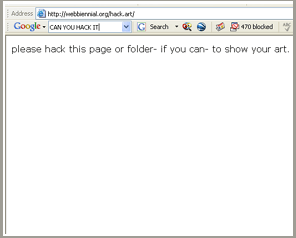
hack.art
Web Biennial's new gallery exclusive for "hack.art" is online. Please hack this folder to show your works. It is free, open for all, first come first serve, self service. Please keep the title tags of the index page as usual; "Web Biennial -Name of the Artist - Name of the Project".
Web Biennial aims to offer an alternative approach to exhibiting online art and it brings an alternative method for exhibiting art online. It is the first international bi-annual contemporary art exhibition created exclusively for the World Wide Web (W.W.W). It is an open non-curated, non-thematic exhibition and it does not have any sponsors.
Istanbul Contemporary Art Museum, iS.CaM; Büyük Hendek Cad. No:37/2, Galata Kuledibi, Beyog˜lu, Istanbul Turkey istanbulmuseum.org | webbiennial.org
Posted by jo at 12:37 PM | Comments (0)
Intermediality in Theatre and Performance

in-between Bodies
Intermediality in Theatre and Performance, CHAPPLE, Freda and Chiel KATTENBELT (Eds.), Amsterdam/New York, NY, 2006, 266 pp.
Intermediality: the incorporation of digital technology into theatre practice, and the presence of film, television and digital media in contemporary theatre is a significant feature of twentieth-century performance. Presented here for the first time is a major collection of essays, written by the Theatre and Intermediality Research Group of the International Federation for Theatre Research, which assesses intermediality in theatre and performance. The book draws on the history of ideas to present a concept of intermediality as an integration of thoughts and medial processes, and it locates intermediality at the inter-sections situated in-between the performers, the observers and the confluence of media, medial spaces and art forms involved in performance at a particular moment in time.
Referencing examples from contemporary theatre, cinema, television, opera, dance and puppet theatre, the book puts forward a thesis that the intermedial is a space where the boundaries soften and we are in-between and within a mixing of space, media and realities, with theatre providing the staging space for intermediality. The book places theatre and performance at the heart of the ‘new media’ debate and will be of keen interest to students, with clear relevance to undergraduates and post-graduates in Theatre Studies and Film and Media Studies, as well as the theatre research community.
Contents
Freda CHAPPLE and Chiel KATTENBELT: Key Issues in Intermediality in theatre and performance
Section One: Performing intermediality
Chiel KATTENBELT: Theatre as the art of the performer and the stage of intermediality
Ralf REMSHARDT: The actor as intermedialist: remediation, appropriation, adaptation
Andy LAVENDER: Mise en scène, hypermediacy and the sensorium
Sigrid MERX: Swann’s way: video and theatre as an intermedial stage for the representation of time
Freda CHAPPLE: Digital opera: intermediality, remediation and education
Section Two: Intermedial perceptions
Peter M. BOENISCH: Aesthetic art to aisthetic act: theatre, media, intermedial performance
Christopher B. BALME: Audio theatre: the mediatization of theatrical space
Meike WAGNER: Of other bodies: the intermedial gaze in theatre
Robin NELSON: New small screen spaces: a performative phenomenon?
Peter M. BOENISCH: Mediation unfinished: choreographing intermediality in contemporary dance performance
Section Three: From adaptation to intermediality
Thomas KUCHENBUCH: Theoretical approaches to theatre and film adaptation: a history
Klemens GRUBER: The staging of writing: intermediality and the avant-garde
Johan CALLENS: Shadow of the Vampire: double takes on Nosferatu
Hadassa SHANI: Modularity as a guiding principle of theatrical intermediality
Me-Dea-Ex: an actual-virtual digital theatre project
Birgit WIENS: Hamlet and the virtual stage: Herbert Fritsch’s project hamlet_X
Freda Chapple trained at the Rose Bruford College of Speech and Drama before working for the Welsh National ‘Opera For All’, English National Opera, Australian Opera and Scottish Opera as singer, stage manager and staff producer. She is now a Lecturer in Continuing Education (Arts) at the University of Sheffield, where she is the programme director of the English Studies and Performing Arts degree track at the Institute for Lifelong Learning. Freda was the stage manager in charge of the opening night of the Sydney Opera House and she continues to perform in and direct opera. Recent productions include: Cavalleria Rusticana and Trial by Jury, 2004; Façade, 2003; The Rise and Fall of the City of Mahagonny and La Traviata, 2000. Her current research is assessing the impact of digital technology on British Theatre practice and education, for which she holds a Society for Theatre Research award, and narrative structures in academic literacy.
Chiel Kattenbelt is associate professor in Media Comparison and Intermediality at Utrecht University (The Netherlands) where he teaches in the programmes of Theatre, Film and Television Studies, Communication and Information Studies, and New Media and Digital Culture. He is also associate professor at the Theatre Academy Maastricht (The Netherlands), where he is head of an interdisciplinary research programme on new theatricality with respect to the public sphere, language and technology. He has published articles in several books and international journals on aesthetics, semiotics, theatre and media theory and intermediality.
Posted by jo at 12:35 PM | Comments (0)
reboot8

A Community Event
reboot8 is a community event for the practical visionaries who are at the intersection of digital technology and change all around us... 2 days. 400 people. A journey into the interconnectedness of creation, participation, values, openness, decentralization, collaboration, complexity, technology, p2p, humanities, connectedness and many more areas. Applied towards us as individuals, citizens, teachers, culture workers, entrepreneurs, creators and change makers.
reboot is the European meetup for the practical visionaries who are building tomorrow one little step at a time, using new models for creation and organization in a world where the only entry barrier is passion. reboot is two days in June filled with inspiration, perspective, good conversations and interesting people.
reboot is a place for people to come together once a year and reboot their minds with perspective, inspiration and relationships. Starting out in 1998 with a Danish focus the event has been turning more and more international throughout the years. In 2005 reboot turned truly european with 400 participants from more than 22 countries.
Posted by jo at 11:36 AM | Comments (0)
Winning (and Losing) the First Wired War
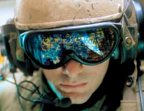
Network Hierarchies + the Connectivity Gap
defensetech.org writes on a digital divide, of sorts, that has put a strangle-hold on the theory that with communication, command and control tethered via digital networks, the armed forces of America would be more effective at conquering soverign states. Such is turning out not to be entirely the case. Most of the command units are able to make use of these networks, but evidently their effectivity plummets because units taking care of firing and dodging bullets and IEDs are off the grid, largely. And yesterday I heard a news story about two armored fighting units that could not communicate with each other — despite the fact that they were only a few meters away. Why? Incompatible communications gear. The radios were literally incompatible. Boggling, but maybe not so much considering the proprietary nature of so much of the gear.
To the US Forces pre-breakup AT&T, the insurgency is playing John Draper aka Cap'n Crunch.
Winning (and Losing) the First Wired War:
This war in Iraq was launched on a theory: That, with the right communication and reconnaissance gear, American armed forces would be quicksilver-fast and supremely lethal. A country could be conquered with only a fraction of the soldiers needed in the past.
During the initial invasion in March 2003, this idea of "network-centric warfare" worked more or less as promised -- even though most of the frontline troops weren't wired up. It was enough that the commanders were connected.
But now, more than three years into the Iraq conflict, the network is still largely incomplete. Local command centers have a torrent of information pouring in. But, for soldiers and marines on the ground, this war isn't any more wired that the last one. "There is a connectivity gap," a draft Army War College report notes. "Information is not reaching the lowest levels."
And the insurgency has taken on a hacker sensibility:
And that's a problem, because the insurgents are stitching together their own communications network. Using throwaway cellphones and anonymous e-mail accounts, these guerrillas rely on a loose web of connections, not a top-down command structure. And they don't fight in large groups that can be easily tracked by high-tech command posts. They have to be hunted down in dark neighborhoods, found amid thousands of civilians, and taken out one by one.
Why do I blog this? Institutions like the military, while barely prone to the social practice adoptions that one finds in democratic formations, in many ways test some of the directions that open society social practices can go under particular situations. Could this be an indicator of how net neutrality plays out if networks get all gummmed up with non-open standards and proprietary protocols? [blogged by Julian Bleecker on techkwondo]
Posted by jo at 11:29 AM | Comments (0)
SoniColumn

Monumental Music Box
SoniColumn is a high column-like cylinder that can be played by touch. Grids of LEDs installed inside the column light themselves on by the users’ touch and emit unique sounds. When a user cranks the handle, the column slowly rotates itself and plays the light patterns of the user’s touch.
By Jin-Yo Mok who also designed the Light Bead Curtain and is working on a portable version of his Music Box.
SoniColumn is currently exhibited at the bitforms Gallery in Seoul, Korea. [blogged by Regine on we-make-money-not-art]
Posted by jo at 11:16 AM | Comments (0)
Monkey Business

Keeping Distributed Groups Connected
Monkey Business is a system that attempts to keep distributed group members more connected and aware of each other's activities; the system aims to facilitate informal and spontaneous communication, while minimizing interruption at inopportune times. The system consists of a network of animatronic agents, one of which will reside in the office of each member of a distributed group. We have chosen the embodiment of a monkey for the form of these agents; hence Monkey Business as the title of this project.
The agent uses a combination of microphones and sensors to recognize the activity in the office that it occupies. If there is a change in the state of the office activity, the agent broadcasts the information out to the network of other agents. The other agents, through subtle gestures, movements, and sounds, indicate the changes of state of the broadcasting office. Thus all members of the group, through their respective agents, are made aware of each other's activities in an ambient manner. more...
Also see Monkey Business: Creating social awareness among distributed group members, using a network of animatronic agents by Rachel Kern and Toward Lighthearted Mobile Non-verbal Expression by Rachel Kern, Chris Schmandt, and Paulina Modlitba. [via Jim Downing on Smart Mobs]
Posted by jo at 10:14 AM | Comments (0)
OZONE TERRACE 1997-1998

Online Apartment Building
OZONE TERRACE Background: Developments in interactive media technologies have created a new role in broadcasting, the programme designer; a cross between programme maker, artist and author. We were commissioned by the BBC television series 'The Net' and Illuminations television to design a programme which was a hybrid between a website and television documentary.
What we did: We made an experimental website which uses simple graphics to construct a virtual skyscraper – the framework for an evolving, multithreaded narrative that occurs when authors of interesting and slightly exhibitionist web sites are invited to 'move in' to the web-building and contribute their stories. After the building had been 'live' and populated for a few weeks, we made an animated documentary about the lives of the building's inhabitants.
The project grew out of an equal interest in both in the content – exploring ways of generating interactive narratives – and in form – how you could use the things that are easy and fast to do on the web, such as block graphics, in elegant and effective ways. The website, which was intended to be self-generating, in fact needed a lot of cultivation – it needed weeding and fertilizing with encouragement if the tenants were to be persuaded to keep contributing. There were several strands in this project: one was to try to understand what made things engaging, what made people want to contribute their stories initially, and then to continue or to stop. Another strand was to try to make a self-generating interactive narrative which, because it was being generated by many people might have qualities of surprise and interest that it would be difficult for one person to generate. The structure needed to be light enough to allow variety and invention but strong enough to give coherence to the potentially very disparate contributions. A third strand was to do with craft: of the web graphics, carefully tuned to the web's limitations, and the final animated film – with its own contrasting set of conventions and possibilities.
Project team
Chris Downs and Ben Hooker
Posted by jo at 09:53 AM | Comments (0)
PerGames 2006 Papers + Slides
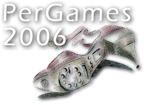
Workshop on Pervasive Gaming Applications
The PerGames series of international workshops addresses the design and technical issues of bringing computer entertainment back to the real world with pervasive games.
:: Pervasive Game Flow: Understanding Player Enjoyment In Pervasive Gaming :: Mobile Device based Interaction Patterns in Augmented Toy Environments; slides :: Talk & Demo Smart Playing Cards – Enhancing the Gaming Experience with RFID; paper :: Participant Roles in socially expanded Games :: Haptic Feedback In Pervasive Games :: ’ERE BE DRAGONS: Heart And Health
:: Talk & Demo Multimodal Multiplayer Tabletop Gaming; paper
:: Talk & Demo PAC LAN; slides; videos
:: Marker-Based Embodied Interaction for Handheld AR Games
:: Exploiting seams in mobile phone games; slides
:: Report about the crossmedia game Epidemic Menace
:: Demo The Mogile Platform
:: Relying on Wireless Sensor Networks to Enhance the RC-Gaming Experience
:: Systematically Exploring the Design Space of Location-based Games
:: Exploring the Usability of Video Game Heuristics for Pervasive Game Development
:: Wanderer
:: An RFID-based game to encourage social interaction
[blogged by nicolas on pasta and vinegar]
Posted by jo at 09:22 AM | Comments (0)
Virtual Sumo

Virtual Energy
Virtual Sumo is inspired by sumo, the Japanese sport in which two contestants try to force their adversary outside the competition area or make him touch the rug. The attack in preceded by a phase of mutual observation (shikiri) in which the fighters use eye contact, study and strategic ploys to make their opponent lose concentration. In this phase it seems that even slight changes on the exposed areas of the contestants’ skin would allow both opponent and audience to judge the state of fighter’s emotions.
In the Virtual Sumo installation two fighters, seated at a table with a monitor set so that they are obliged to assume a position similar to that used in sumo, rest their left hands on a sensor that records the state of their emotions (heartbeat and surface perspiration). On the monitor the competition area can be seen, a circle in which two game pieces represent the two contestants; their emotional state is also visualized, moment by moment. The contestants can thus check on the screen their own and the other’s state of concentration and, given the proximity of their face to that of their opponent, can use disturbing stategies.
The more emotionally neutral their state of mind is, the more their (virtual) energy grows. When they think the moment has come, by pressing a button with their right hand they launch the attack: The piece that represents them flings itself at the opponent’s piece tryng to throw it out of the circle. On the wall above the two contestants a large screen will dramatically reveal the alternation of the two fighters’ emotional responses.
By Mario Canali, Yaniv Steiner, Massimo Banzi, Gabriele Gotini, Leonardo Aurelio, Massimiliano Cavigioli, William Giroldini and Studio Canali S.r.
Similar games of relaxation: BrainBall, Wave UFO, Relax to win, InnerForce, and Wild Divine. [blogged by Regine on we-make-money-not-art]
Posted by jo at 08:06 AM | Comments (0)
May 21, 2006
Call for Participation:
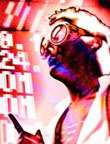
Summer of MySpace
Call for Participation: The Summer of MySpace - an online exhibition; Curated by Patrick Lichty - The Curator of MySpace; myspace[at]voyd.com; Friend Request Dates - 5/21/06 - 8/31/06.
MySpace is a cultural phenomenon. Millions of people have poured their lives into this online community, making it the most successful to date, surpassing Friendster, Xuqa, and Facebook. Millions of hours of creative time by its users, aspiring bands, models, and magazines have been placed into this online agora. But is MySpace a creative space? "Summer of MySpace" asks a number of questions about this burgeoning hang-out haven:
Has MySpace become a new art medium or New Media/Net artform, or can it be used as one? Can the selection of 'friends' and their spaces be called a form of curation? In making profiles, do we make ourselves into art objects? What does it mean to ask to be a 'friend'? Is a form of curation?
Is MySpace merely a space for the colonization of youth culture by corporations and consumer culture? Is MySpace's success representative of a truly new form of community? What other questions about relationships, society, art, and culture does MySpace present? Is MySpace limited by the way it's made, or can we subvert the profile for our own desires?
"Summer of MySpace" fires a probe into this unknown territory, asking all these questions, and setting up a stage for the Internet Summer of Love of the 00's.
Come, be my friend. Let me show you as a shiny new piece of art. Let us curate and be curated, befriend and be befriended in this brave new land of joy and irony.
Let's see what happens. Get on the magic bus.
Submission Procedure:
All you need to do is to set up a profile, make it into an 'artwork', make yourself into an 'artwork', make a place for your 'artwork', and ask me to be your friend. That's what curation is all about, isn't it? The rest is up to us!
Peace, all!
-Patrick Lichty
(The Curator of MySpace)
Posted by jo at 05:51 PM | Comments (0)
Piksel06
![]()
Festival, Exhibition, Call
Piksel06 - festival: october 12-15 2006; Piksel06 - exhibition: october 13-27 2006; call for participation: deadline august 1. 2006.
Piksel [1] is an annual event for artists and developers working with free and open source audiovisual software. Part workshop, part festival, it is organised in Bergen, Norway, by the Bergen Centre for Electronic Arts (BEK) [2] and involves participants from more than a dozen countries exchanging ideas, coding, presenting art and software projects, doing workshops, performances and discussions on the aesthetics and politics of free and open source software.
This years event - Piksel06 - continues the exploration of audiovisual code and it's myriad of expressions, but also brings in open hardware as a new focus area. At Piksel06 we will expand the exhibition part and build upon the open hardware theme, which represents a potential for a new paradigm shift of vital importance for independent artistic expression in the digital domain.
Piksel06 is done in collaboration with HKS art centre[3] which will be the main location for this years events. Piksel is organised by BEK and a community of core participants including members of collectives dyne.org, goto10.org, sustainablesource.net, hackitectura.net, riereta.net, drone.ws, gephex.organd others.
open CALL for PARTICIPATION
The previous Piksel events has primarily focused on live art / audiovisual performance and interactive installations, but for Piksel06 we also introduce open hardware and hardware hacking as new themes. For the exhibition and other parts of the program we are interested in submissions in the following categories:
1. Installations: Projects related to the open hardware theme including but not restricted to: circuit bending, reverse engineering, repurposing, modding and DIY electronics preferably programmed by and running on free and open source software.
2. Audiovisual performance: Live art realised by the use of free and open source software. We specially encourage live coding and DIY hardware projects to apply.
3. Software/Hardware: Innovative DIY hardware and audiovisual software tools or software art released under an open licence.
Please send documentation material - preferably as a URL to online documentation with images/video to piksel06[at]bek.no Deadline - august 1. 2006
Please use the online submit form at: http://www.piksel.no/piksel06/subform.html
Alternatively use this form for submitting:
1. Project name.
2. Email adr.
3. Project URL
4. Name of artist(s).
5. Short bio/CV
6. Category
7. Short statement about the work(s)
8. List of software used in the creation/presentation of the work(s)
Or send by snailmail to:
BEK
att: Gisle Froysland
C. Sundtsgt. 55
5004 Bergen
Norway
More info: http://www.piksel.no/piksel06
piksel06 is produced in cooperation with Kunsthoegskolen in Bergen dep The Academy of Fine Arts, Hordaland Kunstsenter. Supported by Bergen Kommune, Norsk Kulturfond, BergArt and Vestnorsk Filmfond.
links:
[1] http://www.piksel.no
[2] http://www.bek.no
[3] http://www.kunstsenter.no
Posted by jo at 01:08 PM | Comments (0)
Michael Cardenas

Deleuze's Ontology as Expressed in the Global Indymedia Network
Introduction: Delanda, Deleuze and Indymedia: In Intensive Science and Virtual Philosophy, Manuel Delanda tries to explain Gilles Deleuze's ontology in straightforward language “for an audience of scientists and analytical philosophers of science” (Delanda, 7). He tries to untangle the language of Deleuze, a writer who allowed for much play in his language, jumping between various concepts and frequently renaming those concepts. Still, in his writing, Gilles Deleuze developed a rich ontological framework with which one can view the universe. This ontology is based on a rigorous mathematical approach which Delanda explains in great depth.
In this paper I will explain a few components of Deleuze's worldview, as explained by Delanda, using the example of Indymedia, the global Independent Media Center movement. The global Indymedia site, describes Indymedia as “a network of collectively run media outlets for the creation of radical, accurate, and passionate tellings of the truth.” (Independent Media Center, About Indymedia.)
Within the network itself, each collective organizes itself autonomously, without a top-down leadership, while still acting within a framework created by the Global Indymedia Points of Unity. Throughout the paper I will refer to various texts written by different local collectives. My intention is not to create a complete, thorough representation of the network, which is global and very diverse, but to use a few samples which relate strongly to ideas expressed in Deleuze's ontology.
While I realize that Deleuze's ontology serves perfectly well to explain far more simple entities, such as a chair, it is my hope that this analysis will reveal some interesting dynamics because of the affinity between Delanda's motivations and those of the Indymedia network. Delanda states that one of the conclusions of his book is that “the very idea that there can be a set of true sentences which give us the facts once and for all, an idea of a closed and finished world, gives way to an open world full of divergent processes... the kind of world that would not sit still long enough for us to take a snapshot of it and present it as the final truth.” The Indymedia Network works to challenge the claim to objectivity, or truth, of corporate media outlets by providing a space where people can tell their own stories and comment on other's stories, in an ongoing process, in order to help create social change. The processes that create this space will be further illuminated throughout this paper.
Multiplicities not Things
Delanda explains Deleuze's how realist ontology replaces the concept of essences with “dynamical processes” and the “multiplicity”. (Delanda, 5) Where many realist traditions are based on the transcendental concept of essence, describing for example the ideological category of “a chair”, Deleuze replaces that simplistic idea with the multiplicity, “a nested set of vector fields related to each other by symmetry-breaking bifurcations, together with the distributions of attractors which define each of its embedded levels.” Delanda goes on to describe the relation of this concept to group theory and its difference from categories, which define individuals in a population a aberrations from the abstract instead of processes, which are defined by the set of individuals they describe.
The global Indymedia network can be seen as a result of a number of social, technological and economic processes itself: ubiquitous cheap internet access, a tradition of media activism including newspaper propagandists and pirate radio dj's, corporate globalization. At the same time, the Indymedia network is embodied by a number of processes.
Indymedia defines itself as a non-hierarchical network, not as a federation, coalition or collective. Networks are defined by communication among a disparate set of nodes. As a network, Indymedia can itself be seen as a population of collectives, or as a multiplicity described by the characteristics of the collectives in the network. The Global Indymedia Points of Unity, agreed to by all collectives in the network, state: “The Independent Media Center Network (IMCN) is based upon principles of equality, decentralization and local autonomy. The IMCN is not derived from a centralized bureaucratic process, but from the self-organization of autonomous collectives that recognize the importance in developing a union of networks.” (Independent Media Center, Global Indymedia Principles of Unity) As such, there is a wide degree of play across a number of variables such as number of participants, focus on various mediums, degree of cooperation with local communities, degree of transparency of process, openness to differing political viewpoints, amount of finances and more. Systems with many degrees of freedom can be seen as complex systems or dynamical processes. In addition, although there is an official collective that approves entry into the Indymedia network, over time some collectives fade away while others are closely integrated with projects outside of the network, making the strict definition of the network even harder.
Within the network, different collectives can also be seen as multiplicities, some more so than others. In particular, Portland Indymedia defines itself as “not a membership organization; it is a tactic, a concept, and a movement that can be effectively utilized in many different ways.” While some other Indymedia centers do have official membership, many do not and are based on loose affinities and degrees of individual participation. Unlike traditional unions or other forms of political organization with rosters of dues paying members, Indymedia is defined by a process of communication, affinity and participation. Delanda sums up Deleuze's view of things as processes saying “the alternative offered by Deleuze is to avoid taking as given fully formed individuals, or what amounts to the same thing, to always account for the genesis of individuals”. Further blurring the definition of membership in Indymedia is its Open Publishing policy where anyone can post to Indymedia websites, many people do and consider themselves part of Indymedia. As many Indymedia sites say “you ARE Indymedia.” (San Diego Indymedia)
Asking The Right Questions
Open Publishing was a founding concept of Indymedia in 1999, before blogs and myspace were commonplace. Open Publishing has been defined by people within the Indymedia network as “mean[ing] that the process of creating news is transparent to the readers. They can contribute a story and see it instantly appear in the pool of stories publicly available.” (Arnison) The actual implementations of this vary widely and opinions on how open Open Publishing should be very widely even within local collectives. Delanda presents Deleuze's “problematic approach”, saying that “a solution always has the truth it deserves according to how well specified the corresponding problem” and goes on to say that “problems can replace fundamental law statements.” (Delanda 163) While Delanda's approach contains a high degree of rigor and describes specific mathematical models resulting in specific physical entities and populations, one can still see a high degree of correlation in Indymedia's approach of asking questions instead of promoting a party line. Unlike organizations that choose a linguistic statement of truth and promote that statement, Indymedia seeks to create a space for open publishing, diffusion of a variety of varying ideas and debate. The network does engage in editorial work on their sites, based on the Points of Unity which reject hate speech, but within that framework, they seek to ask questions, not provide answers.
The problematic approach is further exemplified by Indymedia's non-hierarchical structure. Since the Indymedia network “is not derived from a centralized bureaucratic process” (Independent Media Center, Global Indymedia Principles of Unity), there is no single set of statements that define the truth of what Indymedia is. There are principles that collectives in the network have agreed to, but those principles are subject to local interpretation and to change at any time by a network wide consensus. Indymedia is defined by a set of problems it is trying to address simply stated as corporate controlled media, not by the theories of any individual or the policies of any bureaucracy. As Richard Day states in Gramsci is Dead, there is “a shift away from hegemonically-oriented 'movements', and towards non-branded strategies and tactics such as Independent Media Center”. (Day 9) The Indymedia network is an example of a tactic for creating change which does not strive to promote a simple set of truths but a set of questions, an invitation.
Time and Communication in Delanda
Moving onto Deleuze's conception of time, Delanda delves into communication theory. While multiplicities can define populations, they still must have invariant properties within those populations that bind them, and “whenever we speak of the invariant properties of an entity we also need to describe an operator, or group of operators, capable of performing rotations, translations, projections, foldings and a variety of other transformations on that entity.. The quasi-cause is, indeed, this operator and it is defined not by its giving rise to multiplicities but by its capacity to affect them.”
The quasi-cause affects multiplicities and links them together. To explain the quasi-causal operator, Deleuze and Delanda use the example of an information channel. (Delanda 84) If one imagines the individual Indymedia collectives as multiplicities, then the information channel between them, the broader network, can be seen as this kind of operator linking them together. When Deleuze says “once communication between heterogeneous series is established, all sorts of consequences follow within the system. Something passes the borders, events explode, phenomena flash, like thunder and lightning,” (Delanda 150) one can see a clear parallel to the global information sharing within the network where the stories of burning tires from the streets of Argentina or of mass border crossings in Morocco are passed from country to country, city to city, through Indymedia.
Attractors and the Virtual
Delanda's book, in Describing Deleuze's ontology, is largely about the virtual and its effect on the actual world. Deleuze says “it is correct to represent a double series of events which develop in two planes, echoing without resembling each other: real events on the level of engendered solutions, and ideal events embedded in the conditions of the problem”. One critical example of a virtual entity is an attractor. “Attractors... may be defined as special subsets of state space, that is, as limit states” (Delanda 80) Later, in his definition of multiplicities, Delanda states that the attractors are “never actualized”. (Delanda 30) For example, the policy of having Open Publishing and the Global Indymedia Principles of Unity can be seen as being two attractors, or as being the virtual corresponding to the actual Indymedia network. While they are stated goals, varying collectives follow them to varying degrees, representing different states in the system at varying distances from the stated goal or the attractor. Deleuze states that “The virtual is fully real in so far as it is virtual... Indeed, the virtual must be defined as strictly a part of the real object”. The attractors that influence the trajectories of multiplicities are no less real because they are not actualized. They are observable.
Conclusion
Any attempt at a mathematically rigorous description of a thing so large, complex and nebulous as a social movement is bound to fail, or at best be inexact. This difficulty is compounded by a the fluidity of a network such as Indymedia. This paper is an attempt to describe the global Indymedia network as an entity within a Deleuzian ontology, while showing affinity between Deleuze's approach and that of Indymedia. Manuel Delanda's book Intensive Science and Virtual Philosophy is an attempt to construct a clear picture of Deleuze's ontology and to provide a detailed alternative to Deleuze's explanation of the mathematical foundations of dynamical processes. (Delanda 5) In bringing Delanda's text, which attempts to described specific physical processes, together with the study of social movements and media culture, there is a bit of inexactness. Nevertheless, as Delanda states, “we philosophers must invent devices to allow us to become 'the quasi-cause of what is produced within us, the Operator'”, and in that tradition this paper is an attempt to explain some of the connections I saw while reading Delanda. As the Zapatistas said in the Second Declaration of La Realidad “We are the network, all of us who resist.” (Graeber)
Works Cited
Arnison, Matthew. "Open publishing is the same as free software" March 2001. May 1, 2006. http://www.cat.org.au/maffew/cat/openpub.html.
Day, Richard J.F. Gramsci is Dead. London: Pluto Press, 2005.
Delanda, Manuel. Intensive Science and Virtual Philosophy. London: Continuum, 2002.
Graeber, David. "The New Anarchists". The New Left Review. Jan-Feb 2002. May 1, 2006. http://www.newleftreview.net/NLR24704.shtml.
Independent Media Center. "About Indymeda". Independent Media Center. May 1, 2006. http://www.indymedia.org/en/static/about.shtml
Independent Media Center. "Global Indymedia Principles of Unity". Indymedia Documentation Project. May 2006. May 1, 2006. http://docs.indymedia.org/view/Global/PrinciplesOfUnity
Independent Media Center. "Indymedia FAQ". Indymedia Documentation Project. Jan 2005. May 1, 2006. http://www.indymedia.org/en/static/about.shtml
San Diego Indymedia. "About Us". San Diego Indymedia. Feb 2005. May 1, 2006. http://sandiego.indymedia.org/en/static/aboutus.shtml
[via nettime]
Posted by jo at 12:47 PM | Comments (0)
OKNO PUBLIC01 ONSITE
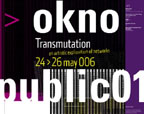
Unruly Artefacts to Replace Crumbling Structures
okno is interested in the creative and unpredictable innovations that stem from unruly combinations of scientific, mediatic and technologic artefacts: seeds to grow new forms of expression where old structures are crumbling...
We offer a virtual and physical public forum for reflection on technologically-inspired media arts. We tend to be a physical and online meeting place for artists, and want to facilitate a dialogue on current forms of artistic practice with a creatively engaged audience. We want a form of media art that is digital, collaborative and networked, interactive and realtime, performative and shared, indivisible in its audio-data-visual output. The cultural and aesthetic influences of media technologies will be critically discussed in the context of an alternative festival setup. The processes and results of artistic research will be presented in a program of round table discussions, performances, experimental concerts, interactive installations and workshops.
/// round table discussions & presentations /// http://okno.be/?id=764 and http://okno.be/?id=763 and http://okno.be/?id=767
+++ wednesday may 24th +++ a focus on media art in Belgium: Beauty in the age of digital art. Transdisciplinary practices. moderated by Maja Kuzmanovic, Michaël Samyn, Elke Van Campenhout.
+++ thursday may 25th +++ a focus on media art in Eastern and Central Europe: History and specific complexities of media art in the region, recounted through the personal narratives of the presenters. moderated by Nina Czegledy.
+++ friday may 27th +++ a look into the future of networks: The working of cultural communities, onsite and online. moderated by Nat Muller.
/// performances, projects, installations and workshops /// http://okno.be/?id=765 and http://okno.be/?id=692
Quix (three monochromes RGB), FoAM (Inflatable Meeting Room), .x-med-a. magazine (launch), Das Netz / the Net (film by Lutz Dammbeck), Peter Beyls (virtual robotics), Andrey Smirnov (laser bugging & windowpane theremin installation), Code31 (SE30-live), GND machine.dream, society of algorithm (networked Bejing/Tokyo/Brussels), mxHz (TICS), transmutation (collaborative physical&virtual project), Résau Citoyen (citynetwork), M+M+ (nomadic multimedia platform), Dusan Barok & Magde Kobzova (save before it’s gone!)
OKNO PUBLIC01 ONLINE An important part of our activities are situated in an independent server structure and in networks of invisible relations between people and information. okno wants to share ideas and develop discourses through different but parallel platforms. We like to play with degrees of visibility, of both people and data. We want to fascilitate participation simultaneously onsite and online. Audiovisual streaming and IRC-chat moderation of the okno public week discussions and performances will encompass the mixtures found in our digitally connected existence. We would like to incorporate online participation of people working in distinct fields such as netart, social work, media art and activist practice.
okno public01 onsite 24 > 26 may 2006, daily from 3pm > 01am
@ matrix art project – koolmijnenkaai 30/34 – 1080 Brussels – Belgium metro Graaf van Vlaanderen / Comte de Flandres ::: tram 18
okno public01 online @ http://okno.be audiovisual streaming & IRC chats, daily from 3pm > 01pm check site for links and updates info[at].be
okno is supported by the Flemisch authorities, the VAF (Flemisch Audiovisual Fund) and the VGC (Vlaamse Gemeenschapscommissie)
Posted by jo at 12:36 PM | Comments (0)
Turbulence Spotlight:
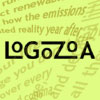
Logozoa by Robert Kendall
Words change everything. We create poems and stories to free the world from itself, to reveal the many feral faces of life. But ironically these liberating words are usually imprisoned on the page or computer screen. Out in the "real" world of day-to-day activity, we use words more crassly. We put labels and signs on things to tame them—identify, categorize, explain, instruct, proclaim ownership. What if instead the labels could liberate the everyday world from the literal, proclaim rather than cover up the mysteries? What if they could become Logozoa—textual organisms that infest the literal with metaphor and give impetuous life and breath to meaning?
Lo•go•zo•a n [fr. Gk logos word + zoia animals] (2005) 1 : word animals: textual organisms 2 : a phylum or subkingdom of linguistic entities that are represented in almost every kind of habitat and include aphorisms, anti-aphorisms, maxims, minims, neokoans, sayings, left-unsaids, proverbialisms, poemlets, microtales, instant fables, and other varieties of conceptual riffs
Find out what happens when you let word animals roam your daily life. Download Logozoa, print them onto your own stickers, and let them loose in your home or neighborhood. Visit the Logozoo to see photos of Logozoa in their natural habitat. To help ensure that these unique creatures do not go the way of so many once-endangered, now-extinct species, photograph your Logozoa and send them to the Logozoo. Explore the Soothcircuit, a unique colony of Logozoa that responds to your questions with insights and prognostications.
BIOGRAPHY
Robert Kendall has been writing electronic poetry since 1990. He is the author of the book-length hypertext poem "A Life Set for Two" (Eastgate Systems) and other electronic works published at BBC Online, Iowa Review Web, Cortland Review, Eastgate Hypertext Reading Room, Cauldron & Net, and other Web sites. His electronic poetry has been exhibited at many venues in the United States, Europe, South America, Asia, and Australia, and he has given interactive readings of his work in many cities. Kendal's printed book of poetry, "A Wandering City," was awarded the Cleveland State University Poetry Center Prize, and he has received a New Jersey State Council on the Arts Fellowship, a New Forms Regional Grant, and other awards. He has taught electronic poetry and fiction for the New School University's online program since 1995. Kendall runs the literary Web site "Word Circuits" and the ELO's "Electronic Literature Directory," and is co-developer of "Word Circuits Connection Muse," a hypertext tool for poets and fiction writers. He has written many articles about electronic literature for national publications, such as Poets & Writers Magazine, and he lectures frequently on the topic.
Posted by jo at 12:16 PM | Comments (0)
May 20, 2006
Kitundu's performance
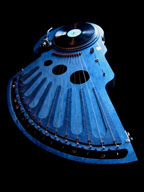
The sound of turntables
An informal gathering and performance by Walter Kitundu and friends will take place on Sunday, June 11 at 3pm at the the luggage store gallery, in San Francisco.
This will be a special musical event, featuring a performance by Walter Kitundu and his friends. The instruments that will be played are now on display at the luggage store gallery.
For over six years, Kitundu has focused his imagination on discovering the potential of the record player as a medium for sound and artistic expression. This process has resulted in hand built turntables powered by the wind and rain, fire and earthquakes, birds, light, and the force of the ocean's waves and tides. He has created a new "family" of instruments called Phonoharps.. Kitundu see the physical properties of a record as being a natural link to the exploration and interpretation of the world around us.
Kitundu's collaborators have included recording artists Douglas Ewart and Meshell N'degeocello, and dancer/choreographer Joanna Haigood/Zaccho Dance. Most recently, he was commissioned by The Kronos Quartet to build instruments and compose.. He performed last month with the Kronos Quartet at Carnegie Hall.
Title:
An Informal gathering and performance by Walter Kitundu
And friends.
Date of Performance:
Sunday, June 11, 2006
Time:
3pm
Where:
the luggage store gallery
1007 Market Street (near 6th)
San Francisco, CA 94103
Public Information:
Telephone: 415. 255 5971
www.luggagestoregallery.org
Cost:
Free - Donations to venue accepted.
Posted by luis at 06:53 PM | Comments (0)
May 19, 2006
Yo, Taxi!
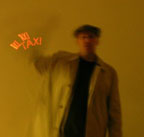
Strobing a Cab
New Yorkers hail a lot of cabs, and it can become quite competitive at rush hour when it’s raining, or late at night when bars and nightclubs close. This battle forces New Yorkers to risk their lives wading into oncoming traffic, frantically trying to get a cabbie’s attention. To give the stylish New Yorker the upper hand, I’ve developed Yo, Taxi!, a design that is sure to stop a Yellow Cab in its tracks.
Yo, Taxi! is a coat embedded with a persistence of vision display, shown through a single row of LEDs positioned in the cuff of the coat. When the wearer raises his or her hand and begins waving it in the natural taxi hailing gesture, the LEDs illuminate. The POV strobes in time with the wearer’s action, creating the illusion of the word "TAXI" floating in mid-air. [posted by Terence Arjo on Clothes Make the Man] [via WMMNA]
Posted by jo at 06:36 PM | Comments (0)
Ann de Gersem

The Life Dress
[...] I spent a lovely time talking with Ann de Gersem about her Life dress designed to give its wearer the possibility to instantly create a personal space, in which she/he can seclude her/himself from the chaotic surroundings. To create her own sanctuary, the wearer of the dress pulls up and zips the skirt at any given moment to close it around her. An air cartridge inflates the skirt to form a perfect bubble around the woman.
Similar garments inspired by the need to gain more space: the Space dress by Teresa Almeida, Wearable Warnings by Phil Worthington. [blogged by Regine on we-make-money-not-art]
Posted by jo at 06:24 PM | Comments (0)
A Virtual Intangible Purchase and Real Lawsuit
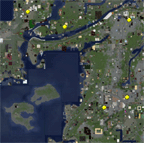
How to Recognize The Future When It Lands On You
"A US gamer has filed a "first-of-its-kind" lawsuit in an acrimonious dispute over the sale of virtual land within the online role-playing game Second Life," this New Scientist article says. "The suit highlights the large amounts of money many gamers are now spending in the hope of reaping a profit within their chosen virtual world. Second Life lets players buy land and build structures that can then be leased or sold on to other players,often for a profit. The game's currency, Linden dollars, can be easily exchanged for real cash.
Marc Bragg, an attorney from Pennsylvania, US, filed the suit against the company behind Second Life, Linden Lab based in California,US. He accuses the company of deactivating his account after he discovered a loophole that enabled him to buy virtual land cheaply within the game. The suit, filed in a local district court, seeks financial restitution for Bragg who claims he invested around $32,000 in the virtual land. "This is probably the first dispute of its kind," Bragg says in a statement posted online. "This suit challenges the legitimacy of a virtual intangible purchase of an asset. "Bragg adds that the dispute could test the relevance to virtual worlds of existing laws". Game company sued over virtual land squabble by Will Knight, NewScientist.com. [blogged by Jim Downing on Smart Mobs]
Posted by jo at 06:04 PM | Comments (0)
Chocolate Infinity
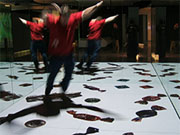
Chocolate Experience for Cadbury
Chocolate Infinity is a project from the HMC MediaLab for Cadburys Chocolate Factory. It’s carried out by Adam Montandon and HMC members. It interestingly used a shock sensitive floor and a series of motion sensors to immerse people in an intriguing interaction (to improve the visitors’ experience):
As you enter the infinity room a giant chocolate bar melts into gloopy puddles beneath you and, when you jump in them, chocolate splashes all over the floor. Then a sprinkling of individual Roses chocolates appear beneath your feet. You won’t believe your eyes when they unwrap as you tread on them – but as you step off they wrap back up.
Chunks of chocolate then fill the floor and when you stamp on them they break open showing gooey caramel, squidgy turkish delight, chunks of mint, orange or Cadbury’s Crunchie inside. Finally you get to chase three Creme Eggs across the floor but don’t stand still because they’ll pop their tops and taunt you until the game is on again.
Why do I blog this? this is one of the trends in roomware: using floor/sensor-based interactions to trigger specific behaviors. I see more and more project about that and I am wondering about potential new places that would allow people to play games with this settings (arcades revival?). [blogged by nicolas on pasta and vinegar]
Posted by jo at 05:26 PM | Comments (0)
Computer Games Edition
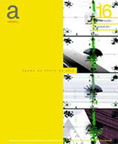
aminima #16
The 16th issue of aminima is out and is dedicated to computer games.
Laura Baigorri discusses Game as critic as art; Joan Leandre, Brody Condom and Anne-Marie Schleiner write about Velvet-Strike and France Cadet about SweetPad; Domenico Quaranta talks with Cory Arcangel; there are articles by Molleindustria, Arcangel Constantini, Margarete Jahrmann and Max Moswitzer, Jodi; Alex Galloway has a story about Warcraft and Utopia; the sexiest geek in the galaxy, aka Marta Peirano, writes about Political games; Jillian McDonald presents Stand by your guns and Ricardo Miranda Zuniga his Vagamundo project and there are many many others texts.
Posted by luis at 01:10 PM | Comments (0)
IP Collage

Distinguishes Participation from Interactivity
IP Collage--by Abram Stern (aka aphid)--is a participative net art piece in which the numbers of each visitor's IP address are added to an image. The four 8-bit numbers that make up the address are recontextualized into php's shape functions in the order they are required: x,y,w,h (x,y coordinate pair & width/height) as well as color: r,g,b,a (red, green, blue, alpha) to create a rectangle of a specific color (& transparency) at a specific location. Viewing the piece changes it permanently.
Generally, 'surfing the net' is thought of as a unidirectional process - one navigates information which comes from the server to the user. However, this is not the case. Every time a user visits a page the web browser transmits information - an IP address, information about the browser (make, model, version number, operating system), and referrer information (what was clicked on to get to the current page). This exchange happens unconsciously and the information provided is often aggregated for commercial marketing purposes.
IP Collage is an attempt to explore this exchange which lies beneath all web content and to use it as the basis for a productive relationship. In exchange for their IP address a user is presented with an image they may save to their local drive, print and/or exhibit.
IP Collage is also an attempt to break participation from interactivity. The piece is participative in the sense that the user directs the aesthetic of the piece, yet it manifests as a static PNG image; it is only interactive in as much as the browser provides interactivity - as it does to all images (much in the same way most video is only as interactive as a VCR & further establishing the dominant aesthetic of interactivity as navigation).
I have compiled a video archaeology of this piece, compressing the first year of its activity into one hour. Each frame of video represents roughly 4 minutes 33 seconds (a synchronistic testament to John Cage) of time between May 13 02002 and may 13 02003. It is currently in DVD and mpeg-4 formats, and I'm still trying to decide how to make it available as I am somewhat ambivalent about transforming a participative piece into a static video record. Feel free to get in touch if you'd like to see it. source code, as usual, is also available upon request.
Posted by jo at 11:45 AM | Comments (0)
Departure & Arrival

Harbour Land/Head/Sketches
As part of the Week of the Sea (20-28 May 2006) on the Dutch island Ameland, foundation Archipel builds for the fourth time a virtual island. This year’s theme is Harbour Land. Harbour Land is a multimedia exploration around the theme "Departure & Arrival."
Media Art Friesland organises two sub-projects for Harbour Land: HARBOUR HEAD and HARBOUR SKETCHES. From 22nd – 26th of May 2006 new material is updated daily at the websites. HARBOUR HEAD will be built via ‘content management systems’ (CMS). The purpose of this project is to generate content with audiovisual recordings and photo’s via experiment with CMS. Ideas and limits of the technique will be searched for, translated by CMS. Random, selected or through association, symbolic or artefacts web collages will arise.
Media artist Michiel Koelink (1972) was invited to be the artistic leader of this project. Jeroen Deen (Noordelijke Hogeschool Leeuwarden) will be in charge of the technique.
The team ‘image & sound beachcombers” exists of the artists José M. Biscaya (Portugal 1973), Sun Ha Borger (1980), Gebrand Burger (1979), Sannah den Engelsen (1979), Henrike Gootjes (1979) and students of the Noordelijke Hogeschool Leeuwarden.
Richard de Boer (1978) is a freelance writer and researcher and will report on a daily basis from Ameland via a blog.
Jeroen Deen is the leader of the project.
For more information contact:
Habour Land: Curator Archipel , Timo Mank - Hollum Ameland 0519 55 44 05 timo[at]archipel.nu.
HABOUR HEAD & HABOUR SKETCHES: Artistic director Foundation Media Art Friesland: Nadine Bors, 06-42670733, info[at]mediaartfriesland.nl.
SPONSORS & PARTNERS:
Provincie Friesland, Gemeente Ameland, Noordelijke Hogeschool Leeuwarden, VVV Ameland, Kabel Noord, Wagenborg Passagiersdienst, Stichting Amelander Musea, Hotel Stay Okay Ameland, Hotel Pension Ambla Ameland.
Nadine Bors
artistiek directeur/ artistic director
stichting/ Foundation Media Art Friesland
www.mediaartfriesland.nl
info[at]mediaartfriesland.nl
F.D Nieuwenhuisstraat 53
8862 WC Harlingen
0031 517 43 40 33
Posted by jo at 11:26 AM | Comments (0)
333 of 1001 nights cast
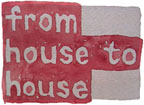
Call for Writers
1001 nights cast has just passed the one-third mark. Performance number 333 with a story by Victoria Spence was performed May 19, 2006.
...1001 nights cast travels back to the northern hemisphere on June 11. I'll be based in Madrid, Granada and London for three months, making a special effort to coax both old and new European writers into the pool. Be aware that writing deadlines and performance times will therefore change in relation to wherever you are and my new, later, sunset times. I will miss my Australian audiences who probably won't feel like getting out of their winter beds at 4am to tune in, but I fully expect them all to keep writing. We might have to say farewell to the west coast of north and south america for that period. Don't worry, they'll be back.
If you've been thinking of writing or know someone who might like to write me a story, please make contact with me at this email address...: barbara[at]1001.net.au" -- Barbara Campbell
Posted by jo at 11:07 AM | Comments (0)
SOLAR RADIO STATION

Sounds of the Universe
SOLAR RADIO STATION, a project by RIXC, Center for New Media Culture, Riga (LV) and r a d i o q u a l i a (NZ / AUS / GB / NL); PHOENIX Halle Dortmund; May 20 - July 16, 2006; Opening: Friday, May 20, 2006, 18:00.
In this (live) installation one can listen to the sounds of the universe originating from various sources. They have been collected by the artists' group r a d i o q u a l i a (Honor Harger, Adam Hyde) in cooperation with RIXC, Center for New Media Culture, Riga. The recordings are coming from various radio telescopes. Additionally, during two days, there will be live feeds from the VIRAC radio astronomy telescope in Irbene (Latvia) which will be acoustically re-worked and interpreted live by the experimental musicians Clausthome (Latvia). VIRAC is the largest radio telescope worldwide (with a dish diameter of 32 meters) accessible for civilian use - thanks to RIXC's continued efforts. During the cold war the KGB used the radio telescope for tapping into NATO's and other military networks.
The installation “Solar Radio Station" consists of three parts. r a d i o q u a l i a's computer and sound installation “solar listening_station" is the first part. It contains recordings and live streams of radio waves from space, especially from the sun. The second part “Spectrosphere" also contains signals originating from the VIRAC radio telescope, this time modulated via electronic instruments and interpreted visually. Here, Clausthome and VJ Ratniks present the results of their live performance from May 20 + 21 at PHOENIX Halle until July 16, 2006. The third part consists of a comprehensive video documentation of the VIRAC telescope by RIXC. Additionally, on a large scale poster the existing frequency spectrum is visualized and its current use is explained.
LIVE INSTALLATION: Sat + Sun, May 20 + 21, 2006, 19:00 - 21:00; The Riga based group Clausthome and VJ Martins Ratniks (F5/RIXC) will perform live in the Solar Radio Station. The live audio stream from the VIRAC radio telescope in Irbene, carrying data from the sun and from space, will be electronically enhanced by Clausthome and interpreted visually by VJ Martins Ratniks.
LINKS
www.museumamostwall.dortmund.de
www.hmkv.de
www.rixc.lv
www.radio-astronomy.net
www.virac.lv
A project by RIXC, Center for New Media Culture, Riga (LV) and r a d i o q u a l i a (NZ / AUS / GB / NL).
RIXC (LV) - Raitis Smits, Rasa Smite, Martins Ratniks, Davis Bojars r a d i o q u a l i a (NZ/AUS/NL/GB) - Adam Hyde, Honor Harger Clausthome (LV) - Lauris Vorslavs, Girts Radzins
In the framework of the exhibition "mit allem rechnen. Medienkunst aus Estland, Lettland und Litauen / face the unexpected. Media art from Estonia, Latvia and Lithuania" - a cooperation between Hartware MedienKunstVerein and Museum am Ostwall, Dortmund/Germany.
SUPPORTED BY: Kulturbuero Stadt Dortmund, 38. internationale kulturtage der stadt dortmund / scene: estland lettland litauen in nrw, Kunststiftung NRW, Der Ministerpraesident des Landes Nordrhein-Westfalen, Kultusministerium der Republik Estland, Kultusministerium der Republik Lettland, Kultusministerium der Republik Litauen, Botschaft der Republik Litauen in der Bundesrepublik Deutschland, Lietuvos Institutas, dortmund-project, LEG, PHOENIX, Medion, Coolibri (Medienpartner).
VENUE: Hartware MedienKunstVerein at PHOENIX Halle Dortmund, Rombergstr. / Ecke Hochofenstr. (no postal address!) Dortmund-Hoerde, Germany.
ADMISSION: PHOENIX Halle: 4 Euro, reduced 2 Euro (incl. admission to the exhibition "Glamour and Globalization") Kombiticket Museum am Ostwall and PHOENIX Halle: 6 Euro, reduced 3 Euro (incl. admission to the exhibition "Glamour and Globalization")
HOW TO GET THERE http://www.hmkv.de/dyn/e_contact_roaddescription/
CONTACT
Hartware MedienKunstVerein
Guentherstraße 65
D - 44143 Dortmund
Germany
Tel: ++49 - 231 - 823 106
www.hmkv.de
Posted by jo at 10:51 AM | Comments (0)
DANM.01:
![]()
AN EXHIBITION OF NEW DIGITAL & NEW MEDIA ART WORKS
The first graduating class of UCSC's DANM M.F.A. program will show original works of digital and new media art at the Digital Media Factory from June 16-18. Twelve new artists will premiere cutting-edge video and animation, special projection presentations, participatory performance pieces, sound installations, web art and much more. Meet a new generation of media artists at the opening reception on Friday, June 16 at 7pm at the Digital Media Factory, 2807 Mission St., Santa Cruz. It's free and open to the public. For more information, contact Felicia Rice, DANM Program Manager, at fsrice[at]ucsc.edu or 831 459-1554 or visit http://danm.ucsc.edu
Please feel free to contact our graduating class for interviews or photos:
Jess Damsen: 831-818-5356 or jdamsen[at]ucsc.edu
Media Mural Project: Collaborative video and music for distribution on Internet and TV. (starts June 1st.)
Darryl Ferrucci: darryl[at]ferrucci.com
Gamelan Lumina: A system elucidating the inner structure of West Javanese gamelan music, by means of a live visual display.
Bob Giges: otom[at]ucsc.edu
Nightingale: An interactive hypertext work that explores a play’s script and its
theoretical underpinnings.
leaf: leaf[at]baymoon.com
Softly Spoken: A participatory ritual / now together gently / mundane shimmers at edges / i see. here we are
Daniel Massey: aboxinsideout[at]hotmail.com
Untitled: A sound installation incorporating fragmented souvenirs and field recordings from the Mexico/U.S border region.
Michael Dale: dale[at]ucsc.edu
Aphid Stern: me@aphid.org
Metavid: Metavid seeks to capture, stream, archive and facilitate real-time
collective [re]mediation of government proceedings.
Alana Perlin: aperlin[at]ucsc.edu
Interactive Interiors | Home Project: An environment where individuals fashion their living spaces through interactive, web-based navigation.
Christopher Angel Ramirez: meditationsonlife[at]hotmail.com
Untitled: Narrating Pieces from the Lives of Latino (Gay) Men.
Michella Rivera-Gravage: hifilores[at]yahoo.com
Train Tracks: A perpetually unfolding collection of downloadable audio programs. Train Tracks is a combination of interviews with riders, histories
about the SF BART system, and ambient/musical elements.
Tiffany Wong: tiffany.lynn.wong[at]gmail.com
My Orientalist Fantasy: A video-installation that circles around the notion of desire as diatribe.
Founded in 2004, the Digital Media Factory is a multi-business facility for the design, development, production, replication, management, and distribution of digital information products. Located in Santa Cruz, California, we provide an operational base for organizations that serve the digital communication needs of business, education, government, entertainment and local communities. Thanks to Ow Properties for co-sponsoring this event.
UCSC’s Digital Arts and New Media (DANM) program is at the forefront of a new discipline that merges the creative and academic potential of digital media and emerging artforms in exciting and unfamiliar ways. DANM was established in 2004 to address the increasingly central role of digital technology in the arts and to examine the impact of digital arts on culture. The program offers a two-year MFA program that brings together students and faculty from across the art and academic spectra to collaborate on artistic practice and scholarly research.
Posted by jo at 10:51 AM | Comments (0)
Sinister
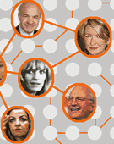
With Enemies Like This...
Wiretaps, leaks, and whistle-blowing have recently become popular topics of discussion within the US. The current Administration’s secrecy seems to depend increasingly upon a lack of secrecy for everyone else, as journalists fight to keep their sources private and activists find themselves targeted by the FBI. One assumes that social networking sites like Friendster are under surveillance... So where can conspiracy-minded people get together? Perhaps on Sinister, a social software tool for our collective dark side. Managed by the suspicious team of Cassandra Rand, Georgia Underwood, and Annina Rüst, Sinister is a connection to underground chat worlds revolving around gardening, real estate, and finance, via the web, IRC, and telephone. One can call access numbers provided on the Sinister Calling Card to listen in on ongoing conversations. More than a mere communication platform, the Sinister website uses theories developed by researchers at Rensellear Polytechnic Institute to analyze the 'shape' of communication patterns in order to reveal the topic of discussion. Sure, conspiracies simmered before social software, but have they ever had their own calling card? - Ryan Griffis, Rhizome News.
Posted by jo at 10:21 AM | Comments (0)
Pall Thayer
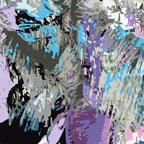
On Everything
On Everything generates a real-time audio/visual presentation of everything by appropriating material being shared by the worldwide public in the form of shared images and diaries. The source material is endless, thus the work goes on forever. Material is synthesized, mixed and, ultimately, abstracted, to allow for varied interpretation. "On Everything" knows nothing of the content of these materials. It reflects everything while reflecting on nothing. That is up to the viewer.
You will be asked to "trust" an application. The application in question is a Java based Mp3 player that allows a live Mp3 stream to be played through a web page. Please click "trust" to enjoy the art work. [blogged by poster on post.thing.net]
Posted by jo at 10:11 AM | Comments (0)
Trebor Scholz

Distributed Aesthetics
"Today, the field of distributed aesthetics is falsely associated with exaggerated rumors of net art's demise. The entire landscape is severely under-studied. In Berlin, last week, a small group of people met for an intensive workshop to respond to this situation. Just returned back to New York what follows is an academic/journalistic quick-response and a follow-up on some strings of the discussion that branched out like a tree.
Many of the exchanges were based on the growth of the Internet from nothing to everything, with the mobile telecommunication technologies and all their "swarming" or "rendezvous" devices. The terrain of the debate embraced issues concerning variously scaled social group formations, mapping and other visualization techniques including sonification, the revenge of the backend algorithm, the vengeance of geography, folkloristic participation in alternative sociable web media, and the re-thinking of affective media. This was quite a bit for a start but a more specific focus was hard to imagine in the early days of what may become a field in its own right.
First of all, the participants brainstormed about core terms of the debate. In the jungle of distributed aesthetics we looked up to a cloud of key terms: crowd, swarm, mob, mass, multitude, and others.
Participants co-formulated working definitions with the full awareness that they mean many things to many people. "Mass" has the connotation of the chaotic, Fordist, and uninformed. Both "multitude" and "mass" are associated with the latent possibility of violence. Multitude, of course, is a term coined by Spinoza that was taken up by the political theorists Michael Hardt and Antonio Negri. In 2000 they formulated the concept of the multitude in opposition to the term "the people" in their book Empire. "Swarm" means informed but decentralized. "Crowds" are always pre-filtered, and related to niche culture. Some think that the difference between these relies merely on scale? Contributors pointed to the intriguing paradox inherent in Howard Rheingold's book title "Smart Mobs."
Rheingold's "Smart Mobs: The Next Social Revolution" argues for the distributed possibilities of evolving communication technologies. He proposes that peer-to-peer networks and pervasive computing are changing the ways in which people organize and share information. "Smart Mobs," for Rheingold are richly interlinked and thus not as dumb as the term "mob" suggests. Smart mobs can develop Collective Intelligence. Rheingold refers to street protests organized by the anti-globalization movement as example of smart mobs.
Collective Intelligence is a process that is able to overcome "groupthink" and compromise in order to solve problems according to Peter Atlee. An additional source is Collective Intelligence (CI) pioneer, George Pór, author of The Quest for Collective Intelligence (1995) whose blog addresses CI [1]. Wired magazine author Kevin Kelly in his book "Out of Control" contributes a chapter on collective intelligence [2]. Pierre Levy who dedicated his book “Collective Intelligence” to the topic has, more recently examined H.G. Wells’s concept of the “world brain.” CI, these authors argue, can restore the power of the citizenry over their society and can counter the centralization of wealth.
James Surowiecki's 2004 pro-free market book "The Wisdom of Crowds: Why the Many Are Smarter Than the Few and How Collective Wisdom Shapes Business, Economies, Societies and Nations." was also subject of discussion. Surowiecki argues for trust networks and their ability for decision making in a decentralized manner, for instance drawing on locally situated knowledge. James Surowiecki points to crowds that are not wise at all. He talks of irrational group behavior at times of stock market crashes and more. In an eerie, uncritical way Surowiecki proposes the adaptable, managerial personality of today who keeps her ties loose while exposing herself to as much information as possible.
http://www.kk.org/outofcontrol/ch2-b.html
Brian Holmes, a “wild American academic living in Paris” (in his own words) took apart the concept of the flexible personality in the essay of the same title. He commented that institutions have the function to discipline crowds into citizenry with predictable norms. He argued that there is something pre-political, unruly about the crowd, the mob, and the multitude. The idea of the "masses" has been associated with citizen formation, he pointed out. In any crowd there are individuals who write its algorithm. The power is with those who are able to set the terms of the debate. The framing of discourse happens through language. Holmes described this carrot-and-stick society as exerting impulses to which citizens react. They are thus modulated and shaped into norms. He linked this to Brian Massumi's notion of resistance that calls for counter-modulation.
At this point the workshop briefly exited into a discussion about leadership in groups. There was a seeming consensus that leadership is important, possibly best implemented through rotating facilitators.
One term that the workshop did not have time to dissect is that of Web 2.0, which now seems accepted by a coalition of the willing. Coined by dot-com entrepreneur and "futureneer" Tim O'Reilly the term asserts that there is something completely new. Version 2.0 also has a strong sales connotation with the imaginary future being the promise. While the term Web 2.0 is short & sweet, it makes the recently popularized participatory architecture of the web sound like a completely novel phenomenon. Instead, I propose the term "sociable web media" as it circumvents such dilemma while still describing the phenomenon.
Online, super-special interest groups form. Here, nobody is off-topic and everybody is an expert at whatever bonding glue holds the group together. Racial tensions, and economical disparities are not an issue and conflict can be kept at a minimum. In cozy isolation issues can be discussed in a focused, yet exclusive way. These archipelagos of the Internet form what Harvard Professor for Economy Amartya Sen, in another context, calls "plural monocultures." The Internet hosts such strange multiculturalism. Often, no two opinions have to confront each other. In their own inner chamber people can forget about racial, ethnic or economical differences and just talk about the very narrow interest set that connects them. Such focus is appealing at times when every minute counts and already unbelievably many hours are spent web drifting. There is too little time to deal with all the information that is thrown at those inhabiting the web. These super-special interest groups are monocultures just like Denmark (Holmes added). Conversations take place next to each other, cross-overs are expelled as being "off-topic" (Harvard sociologist Robert Putnam describes this in detail in his book Bowling Alone) and in this expert culture other voices are assumed to be non-experts. In monocultures, each living in parallel to the other, people do not listen to each other. They just hear their own voices. Neatly labeled special interest groups, just like shelves in a Barnes & Nobles store, are ideal marketing devices into which one only needs to insert the advertisement needle. Corporations think hard about the most viral formatting of information for distribution and the most catching methods of recommendation.
A short discussion about blogs as social surveillance followed. Contemporary pen-pal-networks like FaceBook or Rupert Murdoch's MySpace are frequently used by parents to find out what their kids are really up to and by employers to check out potential laborers’ vices. Such networks are also testbeds for the notion of friendship. Are friends actually rather acquaintances whom we help to move (into our Facebook Top 8) or are they "real" German-style friends who pick us up from the airport.
Amsterdam-based theorist Richard Rogers was fascinated by the ways in which information travels like ships across the planet. He asked: "How does the web know and how does it come to know it?" Rogers introduced his IssueCrawler, a web-based "capture device" that is, for example, able to map the non-profit organization that is most relevant to a particular topic. It can then also locate the geographical focus of this work on a map. IssueCrawler shows where a topic is happening. Rogers works on a critique of Google that, despite its rapid success and pervasiveness is still not developed. He looked for instance, at ways in which Google's search results compare to the dominating news stories. Google results for a search on the term "terrorism" start with sources like the White House, followed by the CIA and FBI. A site by Fairness and Accuracy in Reporting follows 10 pages later. The web loses its side-by-sideness. No longer will one find information by a local pirate next to that of a mainstream bully. The wisdom of Google is now based on the idea that “you have to be fresh to be true.” The more recent (fresh) your links are, the higher your ranking will turn out to be.

Out of this discussion emerged a line of thought about Technorati.com as a practical critique of Google. Technorati is a blog search engine that defines its search results in part based on tags, types of metadata, that users define. The blogosphere becomes a competing search source. The large network of blogs is a recommendation economy. The more in-links a blog can offer the more "in" it is, the higher it ranks. The blogroll, a link list that is part of every decent blog, does not have to indicate that the blogger supports the linked sites. What about an-tag-onistic link lists? Recommendation does not necessarily have to be based on agreement. It is essential, for example, to read the books of the people with whom you do not agree. Why not link to one's foes? This discussion led to Lovink's preview of his thesis on the nihilist blogger (that will become a chapter in his upcoming book). Here he argued that blogs completely sucked dry online creativity, originality, and innovation with regard to design. (He does not think of bloggers as nihilistic media authors but he examines the formats as being highly limiting to distributed creativity.) This may be so. Increasingly, however, blogware is much more flexible, allowing for experimental interfaces that are barely recognizable as blogs.
Furthermore, Geert Lovink commented that on the website Del.icio.us, a social bookmarking web service for storing and sharing web bookmarks, people are in it for themselves. Yahoo-owned Del.icio.us does not work because of a sense of (perhaps romantic) collectivity. It is driven by individuals pursuing their self-interest. This does not have to be a problem. The future may be in such hybrid activities situated between self-interest and collectivity. Lovink pointed to a slightly more collective site called Listible that allows individuals to create recommendations under particular rubrics. Rogers pointed to Shmoogle, which reverses Google page ranking. He who ends up last in Google shall be first on Shmoogle.
http://pzwart2.wdka.hro.nl/~thassine/cgi-bin/shmoogle_form.cgi
http://www.listible.com/list/complete-list-of-web-2-0-products-and-services
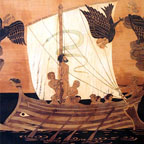
The Wikipedia entry for Del.icio.us tentatively states that the "Use of the Del.icio.us service is currently free." At a time when similar services are bought up by corporations the day they accumulate a good-sized community, the question of resistant strategies is crucial. Services like Del.icio.us will eventually turn commercial. How many alternative, open and free web spaces are left? The big Googles and Amazon.coms are able to offer many "gifts" that look as if they are free. Their upload features are as convenient as the purchase button on iTunes. Companies are successful in luring the online many into their web of content contribution. Like in Homer's Odyssey their sirens sing seductive songs that call up deep desires. But just like Odysseus, online drifters need to be tied to the mast in order not to succumb to the sirens. They need to fix their hands to their desks to avoid going into the trap of American-style convenience. Oxford University professor Nigel Thrift says that "capitalism is now in the business of harnessing unruly creative energies for its own sake." [3] But there are alternatives to soft control and "free labor." Websites like de.lirio.us, del.not.us and sa.bros.us, for example, are free, open source clones of del.icio.us that cannot be commercially exploited as easily.
Moscow-based theorist Olga Goriunova and many other workshop participants were interested in such sociality online: platforms of folkloristic participation. Tom Atlee refers to the current environment as "a deeply participatory universe." Most people are online for emotional reasons. To understand the motivations for their participation matters a great deal. Participation in sociable web media introduces its own political agenda. The question Where did you upload today? reflects on the scarcity of remaining alternative spaces online. Very related is the question of agendas of media critics who write about social networking. Today, the vast majority of theorists engaging with social networking are working in the service of ebay and the Google economy. I introduced the term "oak panel theory" to describe this kind of writing of theorists who are corporate Web 2.0 shareholder.
University of California Santa Cruz professor, artist, programmer, and media theorist Warren Sack outlined his notion of mapping of what he calls Very Large Conversations, communications in newsgroups of many thousand participants. He analyzed who references whom in newsgroups. Who inspires whom to respond, take part in an online conversation? Sack discussed his game-like project Agonistics based on Chantal Mouffe's idea of agonistic democracy. He looks at newsgroup conversations and renders the positionalities of participants visually. She who controls the conversation "wins." Mapping and visualization of network traffic are valuable. The problem with the rhetoric of mapping in arts and politics à la Bureau d'Etudes is the claim of direct change propelled by these maps. How often do these fantastically designed, super detailed revelations of relationships driven by all too justified paranoia, inspire discussions about the specific linkages that are revealed?
Brian Holmes pointed out that mapping practices in an activist context are merely one more tool in the repertoire of resistance. They may not change the concrete situation but they sometimes lead to further action. ("At least people are doing something.") Bureau d'Etudes, he emphasized, now only use their maps in the context of workshops. Holmes and Lovink offered an example of strategic reviewing of movements of people between the Maghreb (the region of Africa north of the Sahara Desert and west of the Nile) and the European Union.
http://estrecho.indymedia.org/newswire/display/7652/index.php
http://mcs.hackitectura.net/tiki-browse_image.php?imageId=179
Maps are not the terrain. They outline the landscape while changing it at the same time. Zurich-based media theorist Nils Roehler contributed the suggestion to look for data-nonvisualization, and opted for auditory systems of mapping. Such “liquid maps” can render the social shapes that they are changing and can help if navigation is unreliable. Why would one need a map if one knows where to go, Roehler asked. He proposed the use of the term compass instead. Maps can reveal information that would otherwise not be available in a corporal and visceral way. They can reveal the conditioning of the backend of computing if applied to networks. The factors that determine computational environments are too often perceived as being merely oriented on the interface level.
There is massive social conditioning evident on the side of coding. A big problem of mapping is based on linguistic computing that does not and perhaps cannot account for affect. Quantitative methods are helpless when it comes to the emotions of participants. Maps and visualizations alike are not charged with any particular politics. The map will equally lead the pirate or the rightful owner to the hidden treasure trove. Revealing network maps can easily become tools of surveillance if they end up in the wrong hands. Once online it is impossible to control who uses them and for which purpose.
The real life politics that leads to decisions programmers make is often written out of history books. Network protocols are hardwired with politics. Coding decisions with regard to database structures, for example, are deeply socially conditioned. Sack, argued that the algorithm is a "third agency," apart from the mob and authority. Political representation of the mob that was formerly in the hands of political parties or unions is now taken over by the algorithm. Who sets the parameters of contribution and navigation? (Warren Sack: "There is a Larry behind every algorithm." Larry Page, co-founder of Google, wrote the page-ranking algorithm of Google.)
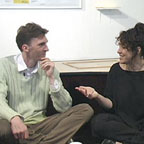
The discussion later moved on to the concept of the "revenge of geography." Place matters once again and is mediated by the Internet and its mobile device tentacles. Some speculations about the death of cyberspace were briefly considered. Berlin media theorist Mercedes Bunz talked about mobile power, turning away from heads-down computing to distributed mobile devices and the new platforms that they facilitate. Sao Paolo-based artists and theorist Giselle Beiguelman demonstrated her cell phone-based electronic billboard projects. While several art projects were shown during the workshop there was not enough time to really talk in depth about art and distributed creativity. It remains unclear if the current situation overcame the anti-aesthetic of the 1980s that largely rejected beauty. Another concern was the coupling of the glitch or blip, the mistake that often rather leads to the creation of art much rather than the streamlined coding process. Perhaps only few of the sociable web media around are related to art not to mention online games like Second Life. The NYC art historian Judith Rodenbeck, linked this discussion to Fench curator Nicolas Bourriaud's much-circulated notion of relational aesthetics. Her critique of relational aesthetics questioned the quality of the relations that are established in the blue chip art world that serves as reference for Bourriaud. “What is the quality of the produced sociality?” Rodenbeck asked.
http://www.desvirtual.com/sometimes/index.htm
Sebastian Luetgert, activist, programmer, artist and co-founder of the Berlin media lab Bootlab, a big bit-torrent and pod-casting aficionado, pointed out that he sees more people watching movies download than people watching downloaded movies. (The aesthetics of data greed.) Luetgert passionately ended by shouting "Podcasts will free the world from TV."
The format of this Digital Aesthetics unconference/workshop had much in common with good improvised jazz. The atmosphere was relaxed and concentrated. There were no planned lectures, of course, and content was introduced through very brief initial statements. The most engaging presentations did not focus on a participant's work, which escaped the tragedy of the common ego-tripping presenter. Sitting in a circle, participants went around with a few minutes for each person to show a project other than their own. The spontaneous exchanges made the debate lively and intensive.
The workshop took place at the Center for Advanced Studies in Berlin [4]. Participants from Australia, Brazil, Russia, the United States, the Netherlands, Germany, and France were invited by the Sydney-based media theorist Anna Munster and University of Amsterdam media philosopher Geert Lovink (who is currently a resident at the Center). Both Munster and Lovink had framed the event with their essay “Theses on Distributed Aesthetics. Or, What a Network is Not,” which appeared in issue #7 of FibrecultureJournal [5]. The shared group memory of this workshop is accessible through meeting minutes on the wiki.
http://www.networkcultures.org/wiki/index.php?title=Dada:_Distributed_Aesthetics_Workshop
-Trebor Scholz
An-tag-onistic links:
http://www.creativeclass.org/
http://www.sap.com/usa/index.epx
People who attended this workshop also looked at:
http://en.wikipedia.org/wiki/Alan_Kay
http://www.blort.meepzorp.com/
http://www.ephemeraweb.org/conference/index.htm
http://journal.media-culture.org.au/0512/04-alybalnaves.php
http://www.emotionmap.net/map.htm
http://the-phone-book.ltd.uk/
http://ringtonesociety.com/
http://www.verbosity.net/creative/read.asp?id=100
http://affect.media.mit.edu/
http://microsound.org/
http://www.upliftacademy.org/wiki/index.php?title=Ebay_Value_Model>
http://artport.whitney.org/commissions/thedumpster/
http://www.citizenlab.org/modules.php?op=modload&name=Archive&file=index&req=listarticles&secid=2
http://freq1550.waag.org/preview.html
http://mapomatix.sourceforge.net/
http://pzwart.wdka.hro.nl/mdr/pubsfolder/whymap/
http://zefrank.com/smallworld/
http://metavid.ucsc.edu/
http://chaosradio.ccc.de/chaosradio_international.html
http://yeastradio.podshow.com/
http://video.google.com/videoplay?docid=-4662694154560792485&q=pomme+and+kelly
http://interruptions.org/
http://en.wikipedia.org/wiki/Weak_tie
http://berlin.ccc.de/index.php/Hauptseite
http://www.khm.de/~digitale/digitale95/guests/roeller.html
http://www.de-bug.de/cgi-bin/debug.pl?what=show∂=texte&ID=3484
http://journal.media-culture.org.au/0603/02-goggin.php
http://www.micromusic.net/
http://jcmc.indiana.edu/vol8/issue3/wellman.html
References:
[1] Collective Intelligence Blog
http://www.community-intelligence.com/blogs/public/
[2] Kelly, K. (1994) The Collective Intelligence of a Mob, In: Out of
Control
http://www.kk.org/outofcontrol/ch2-b.html
[3] Thrift, N. (2005) Knowing Capitalism. Sage: London. pp16.
[4] Center for Advanced Studies in Berlin
http://www.wiko-berlin.de/
[5] Lovink, L., Munster, (2006) A. Theses on Distributed Aesthetics. Or,
What a Network is Not, In: Fibreculture 7,
http://journal.fibreculture.org/issue7/issue7_munster_lovink.html
[posted by Trebor on Journalisms]
Posted by jo at 08:58 AM | Comments (0)
12m4s reactive public display
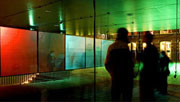
Combines Projection & Reflection
A visual & architectural intervention, tracking the movements of visitors in real time via image recognition & ultra sound sensors. The main parameters, such as position, orientation & speed are translated visually (in dynamic 3d particles) & sonically (through granular synthesis). The result is a "complex particle synthesis" that is projected on a semi-transparent mirror that combines projection & reflection, so that a common space between the digital & the physical world emerges. see also interactive waterfall. [lab-au.com|via interactivearchitecture.org] [blogged on information aesthetics]
Posted by jo at 07:41 AM | Comments (0)
America's Army: Special Forces (Overmatch)
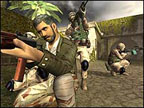
War Vets Feature in US Army Game
War Vets Feature in US Army Game by Alfred Hermida, Technology editor, BBC News website: The US military is putting soldiers who fought in Iraq and Afghanistan into its video game in an attempt to put a human face on its operations overseas. The soldiers' stories are part of a new version of America's Army, a game which is part of its recruitment strategy.
The US military denies that the project is a way of selling an unpopular war to the American public. Instead the free game is designed to inspire young people by relating the real-life experiences of the troops. "The majority of the public is not touched by the war," said Major Jason Amerine, who served in Afghanistan and is one of the nine soldiers appearing in the game. "It is dangerous to have an army overseas fighting and for a public to become so disconnected that they don't realise that we are not automatons over there. We're real people," he told the BBC News website.
'Real heroes'
America's Army was first released in July 2002 and has gone on to become one of the top online games, with seven million registered players.
It taps into the popularity of military and war simulation titles among predominantly young men.
It shows we are not robots, that we're not trained killing machines. We're just people.
It was developed by the Army to simulate combat and life in the military and reach young people for whom video games are a part of everyday life.
In the latest version of the game, called America's Army: Special Forces (Overmatch), the military is adding the experiences of nine soldiers who served in Afghanistan or Iraq.
The title has a so-called real heroes section when players can learn about the real-life troops.
In a virtual recruiting room, gamers can click on a soldier to hear them tell their story. They can also compare their achievements in the game to those of the GIs.
"It gets our stories out there about what the army is doing," said Sergeant Matt Zedwick, who served and was wounded during a tour of duty in Iraq in 2004.
"It is a good communications device to introduce people to what is really going on, rather than what you see on the news."
"It shows we are not robots, that we're not trained killing machines. We're just people," said the 25-year-old who is now studying graphic design at a college in Oregon.
Reaching the public
The US military sees America's Army as an information, rather than as a recruitment, tool.
The latest version was showcased at last week's E3 games expo in Los Angeles and is due to be released in the summer.
It comes at a time of growing unease in the US about the war in Iraq.
And last year, an official US government study warned that the military was falling behind in its effort to recruit troops for combat operations in Iraq and Afghanistan.
But the people involved in the title say there is no connection between the new game and America's troubles over its combat operations.
"We're not talking about the war, we're talking about people in the war," insisted Major Amerine, who served in Afghanistan in 2001 during the initial invasion.
"We are not attempting in any way to sell a war to the people, that has nothing to do with our agenda.
"We're trying to create awareness about the people doing the fighting, and that is a very apolitical agenda," said the major who now teaches at West Point.
Toy soldiers
As part of "real heroes" campaign, figures of the soldiers featured in the game are to go on sale.
The Army says these are not designed to be toys for children but items for collectors who wish to express their support for the troops.
Seeing themselves as little plastic soldiers is a strange experience for the troops involved.
"It is kinda funny and a little creepy. Unbelievable in a way," said Sergeant Zedwick.
"It is kind of funny to think there are going to be millions of people buying little dolls of you in the stores." [posted by Ryan Griffis on Rhizome Raw]
Posted by jo at 07:30 AM | Comments (0)
May 18, 2006
PIPS:lab
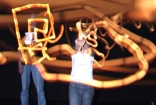
Luma2solator
PIPS:lab, Luma2solator, Interactive Performance; Sunday, 21 May, 10 a.m. - 6 p.m., Edith-Ruß-Haus für Medienkunst -- PiPS:lab is a collective of young Dutch artists specialised in different disciplines. With the computer as a mixer and music, theatre, film, text, photography and a significant dose of humour as ingredients, a PiPS:lab production never fits the expectations. From absurd media theatre to interactive installations, PiPS:lab produces every single element itself: the software, a great deal of the hardware, the music, the stories, the performance and visuals.
Create a piece or place your tag, write or paint with light. The Luma2solator has its own visual language. The technique designed by PiPS:lab enables every user to become the artist. The light tracks will directly become visible on the large screen. After 30 seconds the result gets stored and if the installation is connected to the Internet will be published under a unique number as well. This enables the artist to look up his or her works at home as well.
Posted by jo at 12:52 PM | Comments (0)
Inside Out
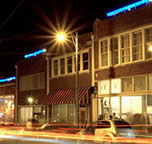
Urban Ambient Display
[Inside Out is a] set of aesthetic lighting displays on top of 9 buildings that visually samples the real-time activity levels from the inside of the buildings. The installation measures the movement & energy within buildings & makes them ambiently visible outside, so as people walk around the South Main gallery district of Memphis, they are able to see each building node & it's activity before they enter them. The rooftop ambient light system consisted of a microcontroller to intepret the data sent to it from below & solid state relays to control 16 bulbs diffused by blue plexi in a minimally designed display. [jamesclar.com|via we-make-money-not-art.com] [blogged on information aesthetics]
Posted by jo at 12:30 PM | Comments (0)
Madrid Abierto 2007
Call for Projects
After the wide reception of its three previous editions, the program of public art MADRID ABIERTO opens its call for proposals for 2007. The program will produce a series of interventions of ephemeral or temporary character in the center of Madrid that will be selected among the submissions received from these international opened call. For the first time, a specific call for sound works and audio-visual works is included.
BASES OF PARTICIPATION FOR THE SUMMONS:
1. The aim of this summon is to select for realization a maximum of ten artistic projects of temporary or short-term/ephemeral character, including two specific projects for the buildings of the Casa de América and the Círculo de Bellas Artes (images of both façades in http://www.madridabierto.com ), which will join Madrid Abierto together with other invited projects and with sonorous and audio-visual works selected for its emission for Radio 3 and for the circuit of the underground channel, Canal Metro
2. The interventions will develop in Madrid, coinciding with ARCO, in February 2007 inside the axes of the Paseo de La Castellana – Paseo del Prado boulevard and Puerta de Alcalá – Gran Vía street.
3. You may submit individual or group projects (for group projects you must name a representative). This call is open to artists of any nationality.
4. A) Each project must include:
•Curriculum Vitae of no more than 2.000 characters and a photocopy of passport or an equivalent document of the author or authors of the project.
•Description of the project with an extension not superior to 4.000 characters.
•A maximum of six outlines or images of the project in jpg format with a maximum resolution of 72 ppp.
•Description of the assembly system and technical requirements.
•Approximate and itemized budget, including details of the concepts which may be able to be self-financed.
•Each file have to be compatible with PC. The files that are sent from a MACINTOSH have to have the corresponding extension (doc, xls, pdf, jpg, tif...).
•In case of not receiving all the information previously detailed the project will be dismissed.
•Maximum funding for each selected project is 12.000 euros, including the travel expenses, housing, production, transport and assembly, author or authors fees (maximum of 2.000 Euros) and all applicable taxes.
B) The sonorous and audio-visual works must include:
•Curriculum Vitae of no more than 2.000 characters and a photocopy of passport or an equivalent document of the author or authors’ of the project.
•Description of the project with an extension not superior to 4.000 characters.
•The audio-visual works for the circuit of the underground channel (Canal Metro) will have a maximum of 2 minutes duration, and can be sent in any digital format (AVI, MOV, WMW, SWF) for the selection process. The works selected by the jury should be sent on format DVD, miniDV, Betacam SP or VCPRO. The sonorous works will be broadcasted in Radio 3, will have a maximum of 10 minutes duration and should be send in CD format.
•The selected works will receive 600 Euros and a copy of the master will be part of Madrid Abierto´s public file, with a web location in http://www.madridabierto.com, previous agreement with the authors.
5. Projects should be sent by e-mail to: abierto[at]madridabierto.com, before the 31st of May, 2006 (or by standard post to: Fundación Altadis-Madrid Abierto, calle Barquillo, nº 7, 28004 Madrid, Spain).
6. The commission of selection, presided by the programme director Jorge Díez, it will be integrated by: Juan Antonio Álvarez Reyes (Madrid Abierto 2007 curator), Cecilia Andersson, Guillaume Desanges and Ramon Parramon. Casa de América and Círculo de Bellas Artes will designate a representative for the selection of the project that will shelter every institution.
The commission will choose a maximum of ten projects, evaluating the quality and viability of the proposals, as well as the total reversibility of the projects. As we are dealing with projects that will occupy public areas, it will be essential to obtain the corresponding authorisation from the municipal authorities for their installation, that will be managed by Madrid Abierto.
If the selected projects make any use of third party images, the artists must provide the express authorisation of the owners of these images for their use in the project.
7. Madrid Abierto reserves the right of publication and reproduction of the selected projects for all case relating to the promotion of the programme, and shall incorporate all generated documentation into its documentary resources and public archives. The projects and works selected shall be the property of the authors and the promoting institutions shall have a preferential right to their possible purchase.
8. Participation in this call implies total acceptance of the rules.
Posted by luis at 12:27 PM | Comments (0)
Eyebeam and Wooster Collective
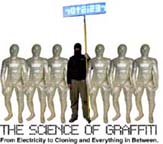
A Night of Technology Based Graffiti
Eyebeam and the Wooster Collective present a night of technology based graffiti projects. Mark Jenkins, the Graffiti Research Lab, and students from the Parsons Geek Graffiti course show a range of experimental work in new materials and techniques for urban communication. Monday, May 22nd, 5:30 – 8pm; Eyebeam, 540 W. 21st Street, New York, NY. [blogged by Joel on reblog]
Posted by jo at 12:02 PM | Comments (0)
Alan Sondheim with Leslie Thornton
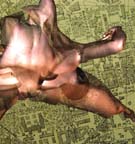
em/bedded
Track 16 Gallery presents em/bedded: A multi-media installation by Alan Sondheim with Leslie Thornton; Guest curated by Tyler Stallings; May 27-June 24, 2006; Reception: Saturday, May 27, 6:00-9:00 p.m.; Performance: 8:00 p.m. Free.
About the performance at 8:00 p.m.: Alan Sondheim will present em/bedded (assembled performance) (45 mins. approximately). It consists of a laptop performance that deals with political, sexual, and cyber issues. He runs video/audio/text segments from a laptop in combinatory fashion, typing a real-time commentary at screen bottom. The result is an extended body, the digital problematized by analog, purity by error, language by language-stumbling. He uses various avatars who “live” in a world that has collapsed into pixel- annihilation.
About the installation: In his first solo exhibition in California, Alan Sondheim, along with filmmaker Leslie Thornton, will transform Track 16 Gallery’s cavernous main gallery into the multi-media installation, em/bedded. Sondheim brings together video projections of cyborgian, mutating, sexual bodies and the artifacts of battlefields soaked in banal horror. Together, they offer a distorted beauty of the disasters of war and the pleasures of love. Guest curated by Tyler Stallings.
Scattered amongst the video projections of furiously moving dancers, of sexual confrontations, of computer generated “avatars,” there will be antennae, battlefield telephones, off-kilter combat tents, photographs of battleships, trenches, and bodies, souvenirs taken from Japanese soldiers, old microscope slides, and antique book editions of du Maurier's Trilby, Confessions of a Magnetiseur, a Japanese pre-Meiji book of black and white block prints of Westerners, Volney's Ruins of Empire, and Albert Dreyfuss' Five Years of My Life. Together they all suggest attempts at communication amidst fortifications created around language and confinement.
Integral to the installation will be a large tent that contains Leslie Thornton’s recent video work, Let Me Count the Ways: Minus 10, Minus 9, Minus 8, Minus 7, Minus 6…. In this work, Thornton explores the social effects of new technologies and media, but here she pushes even further into autobiographical territory to suggest the ways in which we are all implicated in these changes. Juxtaposing aerial footage of pre-9/11 New York City; scientific data on genetic mutation; audio testimony about the bombing of Hiroshima, and a home movie of her father, an engineer on the Manhattan Project, as he is dispatched to that city, Thornton creates a dense and compelling meditation on violence.
Like nomads, Sondheim and Thornton create an ensemble of videos and the physical remains of history that traverse the landscape of memory and time. The work occurs in the far future - mutations, extinctions, broken spaces of information. The work occurs in the past - organisms huddled as if protected against the fury of the world, primitive electrical machines tuned into atmosphere and universe. In em/bedded, the distorted bodies are our own of course, in the present, of course. em/bedded offers no solution - there isn't any - but presents a distorted beauty of its own within an image storm that is a continuous splay, spew, emission, of violence, sexuality, and cloned
grotesques.
Track 16 Gallery
Bergamot Station
2525 Michigan Ave., C1
Santa Monica, CA 90404
310.264.4678
About the artists and the curator
Alan Sondheim's work is trans-media; his emphasis is on writing, theory, and digital performance.
His books include the anthology Being on Line: Net Subjectivity (Lusitania, 1996), Disorders of the Real (Station Hill, 1988), echo (alt-X digital arts, 2001), Vel (Blazevox 2004-5), Sophia (Writers Forum, 2004), Orders of the Real (Writers Forum, 2005), and The Wayward (Salt, 2004) as well as numerous other chapbooks, ebooks, and articles. His video and film have been widely exhibited. Sondheim co-moderates several pioneering email lists, including Cybermind, Cyberculture and Wryting. Since 1994, he has been working on an Internet Text, a continuous meditation on philosophy, psychology, language, body, and virtuality. In 1999, Sondheim was the 2nd Virtual Writer in Residence for the Trace online writing community (Nottingham-Trent University, England). In 2004, he was a resident of the Center for Literary Computing and the Virtual Environments Laboratory at West Virginia University, and in 2005 he was resident artist/writer at Grand Central Art Center in Santa Ana. He produced two CDs at the latter (his older records have been reissued by ESP-Disk and Fire Museum). In 2001, Sondheim assembled a special issue of the America Book Review on Codework, which was seminal in its genre. He is currently working with the Swiss dancer/ choreographer Foofwa d'Imobilite on new work to be premiered in Switzerland and Italy in summer 2006. Sondheim lives in Brooklyn, New York.
Text and image of his work can be found a the following URLS:
• http://www.anu.edu.au/english/internet_txt/
• http://nikuko.blogspot.com
• Recent related to WVU http://www.as.wvu.edu:8000/clc/Members/sondheim
• Trace writing projects http://trace.ntu.ac.uk/writers/sondheim/
Leslie Thornton is an internationally acclaimed media artist working in film, video, photography and installation. Her conceptually rigorous and lush work explores the outer parameters of ethnographic and narrative form, and consistently breaks new ground. She was born in Knoxville, Tennessee. She studied with filmmakers Hollis Frampton, Paul Sharits, Stan Brakhage and Richard Leacock. Her numerous awards include the Maya Deren Lifetime Achievement Award, the first Alpert Award in the Arts for media and grants and fellowships from the Rockefeller Foundation, the NEA, NYSCA, NYFA, and The Jerome Foundation. Thornton's film and media works have been exhibited worldwide, in such venues as The Museum of Modern Art, the Whitney Biennial Exhibition, Centre George Pompidou, capcMusée Bordeaux, and at the Pacific Film Archives. Festivals include The Rotterdam International Film Festival, The New York Film Festival and the film festivals of Oberhausen, Graz, Mannheim, Berlin, Austin, Toronto, Tokyo and Seoul. Thornton is Professor of Modern Culture and Media at Brown University. She lives and works in New York City and Providence, Rhode Island.
Tyler Stallings, the guest curator for em/bedded, is an artist, curator, and writer. He has been the chief curator at Laguna Art Museum since 1999. His curatorial projects focus on contemporary art and popular culture. Past exhibitions that he has organized include: The Juxtapoz School: An Art Movement (upcoming); Whiteness, A Wayward Construction (2003); Surf Culture—The Art History of Surfing (2002);Cyborg Manifesto, or the Joy of Artifice (2001); Sandow Birk's 'In Smog and Thunder: Historical Works from the Great War of California' (2000); Rubén Ortiz Torres: Desmothernismo (1998); Kara Walker: African't (1997); Robert Williams: New Work (1997); among others. He is also the co-editor of the anthology, Uncontrollable Bodies: Testimonies of Identity and Culture (Seattle: Bay Press, 1994). Stallings is also an artist who has shown in Los Angeles, New York, and Europe. Concurrent with em/bedded, Stallings has a solo exhibition of his new paintings at Newspace Gallery in Los Angeles, May 9-June 17, 2006.
em/bedded has also been made possible by additional collaborations with Azure Carter, Foofwa d'Imobilite, and Thomas Zummer.
Posted by jo at 11:10 AM | Comments (0)
Régine Debatty's Interview with Marc Bohlen

"Machines are their own species"
Marc Bohlen's website has provided me with some amazing stories ever since i started blogging: from the Open Biometrics Project that i posted back in 2004, to the Universal Whistling Machine, first prize at Vida 7.0, and the cursing Amy and Klara.
Marc is trained in Stone Masonry (sic), Art History and Electrical Engineering and Robotics. He has been an invited speaker at Cornell University, Harvard University, The Ludwig-Maximilians-Universität München, the Banff New Media Institute and the Royal Institute of Technology in Stockholm, etc. Marc is currently directing the MediaRobotics Lab at the University of Buffalo (Department of Media Study).
Shoeveillance sounds like "souveillance." Is there a hint of activism behind the project?
Certainly! My approach overlaps to a strong degree with that of art-activisism. It is also different. If you leave the development of technology to market forces alone, the solutions leave out too many market-irrelevant, but important, interesting and pleasurable factors. Realtechsupport tries to cast engineering problems in a light that includes their social/cultural context, and tries to make this a design parameter that needs to be 'solved'(addressed, discussed, solved) with the same diligence as the isolated technical problem.
Shoeveillence is a good example of this approach. Shoeveillence is capable of monitoring the passage of people in to and out of a room (and by extension a building). It acknowledges the fact that, in this world, this might be necessary [There is a fire in a 100 story building – is there anyone on the 91^st floor?]. At the same time, it counters data-creep and prevents data that is not "needed" from being collected. [The camera sees only feet and legs up to knee height; the machine algorithm finds directionality of motion and objects that look like shoes only].
In this regard shoeveillence is related to previous work in biometrics. The Open Biometrics Project included the design of a fingerprint analysis system that made its probabilistic results apparent so one could watch the machine in action. Having complex machines make binary decisions about us is really a problem.
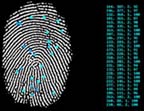
A friend of mine told me about an interaction designer who had devised a way for people living in a not very posh neighborhood of London to pass through the streets of their area and yet avoid the gaze of the CCTV network. But it turned out that people were not happy with the idea, they actually liked to be on surveillance camera. Do you think a system like Shoeveillance could make everyone happy: maximum data collection and minimum invasion?
Yes. Let's make everyone happy! Shoeveillence plays with the desire to be seen to some degree. Parading your shoes is a special kind of pleasure, an accepted form of exhibitionism. It is one I would like machines we share the world with to be fluent in. We will have to wait for compliments, though, the appreciation of good shoes is beyond AI today. In HCI (Human Computer Interaction) community, some people speak of 'shy sensors', sensors with low-bandwidth input (such as a button) from which you derive information based on the sensor's location. If you want to know if someone is sitting in a chair without watching them on a camera, for example, you put a button in the chair. Shoeveillence, however, takes in high-bandwidth data (streaming video). It is tamed physically (by its position on the ground and its lens system), disciplined programmatically (by its algorithm) not to notice anything but shoes and incapable of being invasive but geared to be persistently and maximally shoe centric. This is a new kind of problem solving, I think.
Shoeveillance has found a first application in 8-bit Architecture. Can you tell us something about that project? how does shoeveillance fit in 8-bit A?
8-bit Architecture is a concept for a new joint between lived spaces and synthetic systems in the widest sense. To date, our new technologies are add-ons to the buildings in which we live and they enforce a master-slave relationship. The "smart home" got it all wrong. We don't need more convenience in our lives.
8-bit A wants to find out if there can be new ways of bringing the separate entities of synthetic and controlling systems together with lived spaces. Think about Cory Arcangel's Mario Brother game hack where he removed from the game engine everything but the scrolling clouds to create a 'game' the technical staff never imagined. 8-bit Architecture will try to find solutions like that (but different) for built and lived systems. Home automation has got to deliver more than garage-door openers that can be activated from the armchair and lights that dim on command.

I like one of your older project: Advanced Perception. Are you still investigating the field of "animal machine interaction design"?
Yes! That project really set the path for my work. The Universal Whistling Machine project continues the thrust with the question of communication beyond species boundaries. And the Glass Bottom Boat will move from land to sea creatures. I think we should replace HCI (Human Computer Interaction) with HAMI (Human Animal Machine Interaction). Animal activism meets robotics. The new world must have space for all of us.
How affected were the chicken by the presence of the robot?
At first indifferent. Once the robot moved, they were very frightened. But having the robot 'announce' its motion prior to actually moving (by activating the motors for a fraction of a second as to make a noise) made the chickens accept the machine much more readily. The robot was then instructed to avoid the feeding corner, so the chickens had their reserved territory. That seemed to help as well.
The results of these robot-chicken experiments were presented to both the scientific as well as the art communities. did they react in a different manner?
I had a famous chef (Rudi Stanish) cook omelets from the eggs of the chickens. In the gallery we had a taste-the-interaction session. People enjoyed the omelets and, hopefully, thought about a future world where animals, humans and robots roam freely.
I presented parts of the work in two scientific venues. There the interest was on "robots in adverse environments" (you can't sell omelets to the scientists). They were keen in hearing about how to deal with the messy side of things (dirt, chicken droppings, reliability over time, control mechanisms). But, in the end, the discussion also went to the 'high end' topics of shared spaces for different species. But the technical diversion was necessary to get to that point.

You seem to mingle with the artisitc as well as with the scientific communities. What's your crowd? How open is the scientific community to art projects?
(left: Advanced Perception gourmet performance) My crowd: Mixed. I think people who are trying to (experimentally) find ways of living with the fallout from automation technologies respond to my work. I am not a visual artist. The science community is selectively appreciative of the work. I do solve problems and deal with the same kind of messy and complicated information processing issues the engineering sciences do. The criticism I get from the sciences is that I am weak on evaluating my "results". But I am really not into handing out questionnaires and doing factorial designs experiments. I understand the critique, and understand where it comes from, but limit myself in accepting it in order not to loose the thrust of the work.
On the other hand, one does have to really understand the questions the sciences are concerned about. You can not speak the dialect of art (and expect to be understood) when you play the science game. Else you are delegated to a beautifier (and your voice is not taken seriously beyond that task). This was an important insight into really getting discussions going across disciplines: you have to be in the disciplines. This is a huge problem with much of the current "art meets science" endeavors. It really takes more than talk to move between different domains of knowing.

(Left) Amy and Klara and The Universal Whistling Machine) Other recent projects on your website deal with the replication of human features in artificial systems as well. Do you feel that the quest for the machine that will look and sound exactly like we do is senseless?
Yes, the quest for the synthetic system that looks, feels, acts and sounds like us is a dead end, in my view. Synthetic systems designers (from literature, cybernetics, robotics, and AI) have always been attracted to the mimesis of human features. Mostly because humans see humans as the pinnacle of evolution. If you are going to make synthetic life, why not work off the 'best' example you can find, the human, so the argument goes. But there is a different argument I am more attracted to. What the machine affords (in the sense of what is is capable/incapable of) is fundamentally different from how we are.
Machines are their own species, they are aliens, in a way. Sensors can see and hear things outside of our human perceptual boundaries. We have no access to microseconds as a computer does. Entities that can access this kind of 'stuff' are different, in a similar way as a dog that can hear sounds I can not hear, is different from me because of that.
Thanks Marc!
More on the projects discussed here at Realtechsupport. [blogged by Regine on we-make-money-not-art]
Posted by jo at 10:11 AM | Comments (0)
Cabspotting
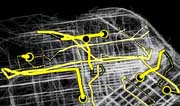
Taxis Mapped in Real Time
Cabspotting: As part of Invisible Dynamics, Stamen, a collaboration with The Exploratorium and Scott Snibbe, has been exploring visualizations of GPS data generated by Yellow Cab taxi cabs in San Francisco. In these frame-by-frame maps of the locations of cabs in the Bay Area, the city ebbs and pulses like the beating of a heart. These movies are available on the cabspotting site.
Invisible Dynamics is a research project sponsored by The Exploratorium which explores the meanings and representations of place. Working across the domains of art, design, cultural geography, cartography, information design, sociology, hydrology, marine sciences, and history, Invisible Dynamics hosts residencies and workshops, as well as developing exhibitions and public programs. Using new technologies for the representation and analysis of spatial information, the project investigates the complexities of the San Francisco Bay Region in the context of the Pacific Rim. The contiguities of bay waters, shores, industrial zones, the interlacing and often unseen systems that give this area its character are all a part of the project focus—extending to explorations of the entire Pacific Rim.
Posted by jo at 09:52 AM | Comments (0)
PSP SSS (Site Specific System) + Nintendo Amusement Park
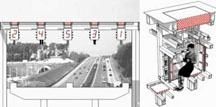
"Physically Augmented Reality" Games
Shona Kitchen and Ben Hooker's PSP SSS (Site Specific System) concept adds a subtle degree of physical competition to computer games.
They have imagined specific structures in specific places in the city for specific PSP communities. Rather than sitting in the comfort of your home playing against other people who are physically distant, the Site Specific System provides a platform for the ultimate physical-virtual gaming session. For example a platform built above a road would be particularly suitable for people to play racing games.
The System takes on the characteristics of a high tech factory processing machine, containing steel panels that move via pneumatic pistons. The player is taken down into the system by a lift and positioned in their seat, the panels move in around them so that they fit neatly around the player like a glove. A panel is then catapulted away from under their feet, leaving their feet dangling to feel the swirling air and amplified noise of the traffic below. Each player has an additional set of buttons attached to their PlayStation Portable, which allow them to control the panels of their opponents. (video)
A project developed at the PSP Design Club, a lab where European creatives were invited to create a manifesto incorporating the PSP and drawing on inspiration from one of its core values "freedom". Via Digital Experience.
Much more physically challenging:

ITP students Daniel Albritton, Huang-ling Chen and Noah Shibley's aim with the Nintendo Amusement Park project is to build a life-sized game of Super Mario Brothers that you jump through in real space. The amusement park would use mechanical technology to give a player super powers which they must learn to control as they bound through a massive obstacle course in 3D space.
This includes a special jumping power that would be provided by an intelligent winch mounted on a two axis crane in the ceiling. It would work similarly to the types used for Hollywood stunts.
The early prototype lets the user begin exploring the sensation of augmented jumping power. The player is strapped into a parachute harness, bungees are attached to a motorized trellis in the ceiling, and the trellis is raised until the users feet just touch the ground. They are left to explore the 'bounce space' for a few minutes, and are then tasked with a few challenges (jump over an object, hit an object high in the air, avoid an object moving on the ground).
Via unmediated. More images at the bottom of this page. [blogged by Regine on we-make-money-not-art]
Posted by jo at 08:41 AM | Comments (0)
Upgrade! Lisbon #05
![]()
May meeting featuring Sofia Oliveira
Lisboa 20 Arte Contemporânea welcomes next Wednesday, May 24th @19:30, The Upgrade! Lisbon monthly gathering featuring Sofia Oliveira, executive coordinator of Atmosferas - Digital Arts Center. The entrance is free and drinks will be served.
Sofia Oliveira will present Atmosferas as well as the winners of the 2005 edition of the Atmosferas Ideas Contest: Skechter by Gonçalo Tavares, an extension to the Firefox browser; Re-cordis by Tiago Pedroso, a project about memory, based on text and image; and See-Music by Maria da Gandra, a project exploring the relations between sound and image, through the creation of several systems for sound visualizing.
Sofia Oliveira's work within Atmosferas has been one of developing a platform for creation and reflection about the experimental aspect of new technologies, by directly supporting artists, producing workshops, starting an Ideas contest and putting up a tv show about the digital arts in Portugal.
She has also curated the online projects Gas and Memória and is developing a work and reflection platform dedicated to Processing, both a community and language for generative visual programming.
Upgrade! is an international, emerging network of autonomous nodes united by art and technology. Its decentralized, non-hierarchical structure ensures that each Upgrade! node (i) operates according to local interests and their available resources; and (ii) reflects current creative engagement with cutting edge technologies. While individual nodes present new media projects, engage in informal critique, and foster dialogue and collaboration between individual artists, Upgrade! International functions as an online, global network that gathers annually in different cities to meet one another, showcase local art, and work on the agenda for the following year. Upgrade! Lisbon is curated by Luís Silva
For more information or project submission, please go to http://www.lisboa20.pt/upgrade or http://www.theupgrade.net/
Posted by luis at 07:42 AM | Comments (0)
JavaMuseum Interview Project
3 more interviews
JavaMuseum Interview Project is featuring this week 3 interviews with Jody Zellen (USA), Reiner Strasser (Germany) and Caterina Davinio (Italy).
Jody Zellen is an artist living in Los Angeles, California. She works in many media simultaneously making photographs, installations, net art, public art, as well as artists' books that explore the subject of the urban environment. She employs media-generated representations of contemporary and historic cities as raw material for aesthetic and social investigations She had numerous solo shows in USA and abroad and is represented on all relevant media art festivals around the globe.
Reiner Strasser is living and working in Wiesbaden, Germany, was born 1954 in Antwerpen, Belgium. He studied art, art history and philosophy at the University of Mainz, Germany in the 1970's. His Web works, international collaborations, and Web art projects date from 1996. Strasser's Web work has appeared in several exhibitions/publications all over the world since 1997.
Caterina Davinio is multitalented and active as Italian techno-artist, writer and poet, experiments in computer art, net-art, video, digital visual poetry, Internet-performance, video-performance. She realized also computer, printings exhibitions, painting, and artist books, using together writing, traditional and digital techniques. Pioneer of Italian digital art, she has done curatorial and consultant activity in international festivals. Her work has been featured in more than 100 exhibitions world wide Caterina Davinio has published articles, poems, and digital works, in international magazines and journals of the avant-garde.
JIP - JavaMuseum Interview Project will be released on an ongoing basis, whereby the selection of the most interesting answers can be found a) online on the new project site - http://jip.javamuseum.org , but b) immediately also in form of one interview per week on the new weblog - JIP - JavaMuseum Interview Project and c) to be published in a printed form at a later stage.
Until now interviews /answers by
Babel (Canada), Andrea Polli (USA), Jorn Ebner (UK), Roberto Echen (Argentina), Jeremy Hight (USA), Ian Page-Echols (USA), Humberto Ramirez (Chile/USA), Enrico Tomaselli (Italy), Carlos Katastrofsky (Austria), Paivi Hintsanen (Finland), Shankar Barua (India), Luke Duncalfe (New Zealand), FilH (France), Nadja Kutz (Germany), Yvonne Martinsson (Sweden), Avi Rosen (Israel), Letizia Jaccheri (Norway), Tamara Lai (Belgium), tobias c. van Veen (Canada), DLSAN (Italy), Irene Coremberg (Argentina), Carla Della Beffa (Italy), Peter Lind (Denmark), Philippe Langlois (France), Salvatore Iaconesi (Italy), Pat Badani (USA), Calin Man (Romania), Myron Turner (Canada), Domenica Quaranta (Italy), Juan Manuel Patino (Argentina), Alison Williams (South Africa), Rahima Begum (India), Anahi Caceres (Argentina), Raivo Kelomees (Estonia), santo_file (Spain), Sachiko Hayashi (Sweden).
Posted by luis at 04:48 AM | Comments (0)
May 17, 2006
Michael Markert's m3 at Cybersonica
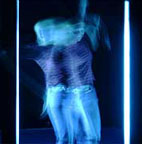
Virtual Music Gate
Michael Markert's m3, a virtual music gate, that sensors body movements in a space between two illuminated columns and processes the data in realtime to harmonic and rhythmic music. The art arises with the interaction of its users and their different and unique behavior in the gate: they can go through or stay in between, shake and bend their body in the gate, dance, stand still or crawl… and listen how their movements are turned into a sound experience.
The gate is operated by a matrix of distance sensors which triggers and alters different sounds. A Cocoa-based software processes the realtime MIDI-Events (harmonize & quantize) and routes the signals to a complex output setup of software synths and beat generators. (video) Currently at Cybersonica. [blogged by Regine on we-make-money-not-art]
Posted by jo at 07:33 PM | Comments (0)
tank.tv introduces 11 Japanese artists

Theory Of Everything
May - June 2006: Forget Albert Einstein, forget Stephen Hawking. tank.tv goes science.
Theory of Everything for tank.tv curated by Yuki Okumura with the works of the following artists: Taro Izumi, Kohei Kobayashi, Hiroaki Morita, Daisuke Nagatsuka, Daisuke Nose, Yuki Okumura, Ken Sasaki, Koki Tanaka, Mai Yamashita + Naoto Kobayashi and Naho Yokoya.
Just like physicists, the Japanese video artists introduced in this video-screening program work with the fundamental question: "what is the world?" or "what is the universe?" While physicists studies on particles that natural human eye can never grasp, in mathematics that is a purely theoretical realm, or on the begging and the ending of the universe in terms of both space and time - all based on trans-humanity and non-everyday life, the artists produce "small events" in everyday life to elicit how (the laws of) the universe is strange, mysterious and unrealistic, probably much more than any sci-fi movie.
Posted by jo at 03:38 PM | Comments (0)
Performance Paradigm, Number 2

Japan After the 1960s: The Ends of the Avant-Garde
"It is widely acknowledged that dramatic changes wrought in 1960s Japan were such that art and cultural practice were transformed into an emergent avant-gardism. Hybridity, physical and intellectual intensity, formal innovations and transgressive acts are all characteristics of 1960s theatre, dance, cinema, literature and performance art in Japan and elsewhere.
The 1960s era was significant not least for the emergence of new aesthetics connected to a rapid evolution of political sensibilities. In Japan, as in Europe and America, artists were rethinking materials and forms often in terms of bodies juxtaposed with mediated spaces and objects. Art works began rejecting academic and formal qualities of art and instead related to the everyday experience of the world, foregrounding experiences of time and immediate sensory perception in a language which was conceptual and dynamic. This emerging performative discourse challenged ideas of representation and politics in art as performance began re-connecting with the social sphere.
As Marvin Carlson suggests, it is a language and a set of practices which became paradigmatic of the post 60s world: 'With performance as a kind of critical wedge, the metaphor of theatricality has moved out of the arts into almost every aspect of modern attempts to understand our condition' (Carlson, 1996: 6). This issue of Performance Paradigm looks at some of the places this metaphor migrated to and investigates how, in the process, ideas of culture and experiences of the world became actively performative. In a similar vein, this issue examines how perception and experience in the arts in the post 60s era came to stand for the embodiment of a new politics..."
ARTICLES
- Peter Eckersall and Edward Scheer 'Introduction'
- Satô Makoto, translated by Yuji Sone 'On Vernacular Theatre'
- Yasuko Ikeuchi 'Performances of Masculinity in Angura Theatre: Suzuki Tadashi on the Actress and Satô Makoto's Abe Sada's Dogs'
- Michael Hornblow 'Bursting Bodies of Thought: Artaud and Hijikata'
- Shannon C. Moore 'Ghosts of Premodernity: Butoh and the Avant-Garde'
- Jonathan Marshall 'Dancing the Elemental Body: Butoh and Body Weather: Interviews with Tanaka Min and Yumi Umiumare'
- Lisa Kuly 'Translation, Hybridity, and 'The Real Thing': Don Kenny's English Kyôgen'
- Vera Mackie 'The Spectacle of Woman in Japanese Underground Theatre Posters'
- Midori Yoshimoto 'Off Museum! Performance Art That Turned the Street into 'Theatre,' Circa 1964 Tokyo'
- Gunhild Borggreen 'Ruins of the Future: Yanobe Kenji Revisits Expo '70'
- Uchino, Tadashi 'Mapping/Zapping 'J' Theatre At The Moment'
BOOK REVIEWS
M.Cody Poulton, 'Unspeakable Acts: The Avant-Garde Theatre of Terayama Shûji and Postwar Japan' Carol Fisher Sorgenfrei
Mika Eglinton, 'Into Performance: Japanese Women Artists in New York' Midori Yoshimoto (New Jersey and London: Rutgers University Press, 2005).
Yuji Sone, 'Alternatives: Debating Theatre Culture in the Age of Con-Fusion,' Peter Eckersall, Uchino Tadashi and Moriyama Naoto (eds.), No. 11 in the series Dramaturgies: Texts, Cultures and Performances (Brussels: P.I.E.-Peter Lang 2004).
EVENT REVIEW
Zack Fuller, Tradition and Innovation: Dance Hakushu 2005. August twelfth through twenty-first, Body Weather Farm, Yamanashi, Japan.
From Japan After the 1960s: The Ends of the Avant-Garde, Performance Paradigm, Number 2, Edited by Peter Eckersall, March 2006 [ISSN 1832-5580]
Posted by jo at 10:02 AM | Comments (0)
Circuit #2 @ Eyebeam
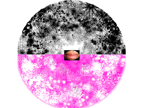
polymorphic [d(eoxyribo)n(ucleic) a(cid)]: a love story
polymorphic [d(eoxyribo)n(ucleic) a(cid)]: a love story--by Marta Lwin--is a networked performance installation of a DNA driven conversation between two people in love. Featuring actual personal DNA sequences mapped to generative language revealing the inner secrets of genetic compatibility. At Circuit #2, Eyebeam; Friday and Saturday, May 19-20 from 12-6pm. The artists will give public presentations and/or performances on May 20 at 4:00pm, followed by a reception at 5:30pm. These events are free and open to the public.
The DNA sequenced are derived from an collaboration between Lwin and scientists at NYU Medical Center, Study of Human Genomics, and the American Museum of Natural History, Center for Comparative Genomics. The are visualized by using two video monitors (with audio), and computers running custom software written in Java. A synergistic interaction exists between the DNA sequence and the custom software to trigger video. The video depicts lips speaking the DNA sequence a mapped to the Roman alphabet. The disembodied lips take turns speaking the code to one another, at times interrupting at other times remaining silent.
The DNA, while invisible is encased in visible plates which are laser etched with contemporary scientific iconography, creating a decorative surface polymorphic [d(eoxyribo)n(ucleic) a(cid)]: a love story looks at the contemporary methodology for encoding DNA, and it's application and ethical ambiguities. The web based documented process of creating the installation comprises the theoretical investigation of turning material DNA into binary information, with special attention to lab process.
Lwin is looking at the current scientific lab practice of extracting DNA, and treatment of human materiality as it moves into binary representation. With special attention to Norbert Wiener's cybernetic theory, Lily Kay's analysis of the inherent informatic bias in DNA science, and theoretical writings by Marx, Deleuze + Guattari, and contemporary thinkers such as Thacker, Massumi, and Agamben.
Posted by jo at 09:16 AM | Comments (0)
ISEA2006 Symposium Registration Launches
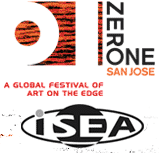
The Early Bird Gets the Discount!
Coming to San Jose, California, August 7-13, Seven Days of Art and Interconnectivity: ISEA2006 Symposium Registration Launches 33% discount for Early Bird Registration through June 15th. Registration: Hotels: Press Release.
Early Bird registrants also receive 20% discount on ticketed events including blockbusters like Peter Greenaway, Tulse Luper Live VJ version, Survival Research Laboratories, Builders Association/dbox, Super Vision, and Ryoji Ikeda's North American premiere of data.matrix.
The most progressive artists, cultural producers, media theorists and curators from around the world will be gathering in the birthplace of computing innovation - Silicon Valley - to share and discuss the latest ideas and practices about art and digital culture.
The ISEA2006 Symposium is taking place in conjunction with the inaugural ZeroOne San Jose: Global Festival of Art on the Edge and offers attendees an immersive, interactive, exposure to the art, ideas, theories, and new developments in the field of interactive media and digital art as it relates to the symposium themes of Community Domain, Interactive City, Transvergence, and the Pacific Rim.
Online pre-symposium paper abstracts and a pre-publishing model for Symposium presentations and participation, allows the public to join the discussions online both before and during the Symposium. This innovative structure is designed to enable lively, free conversations across disciplines, ideologies, and philosophical frame-works.
For One Week Only ISEA Registrants will have the first opportunity to purchase event tickets - tickets that are sure to sell out - in advance of General Public ticket launch. May 12 - May 19th, ISEA2006 Registration
Click Here to Sign Up.
About the Inter-Society for Electronic Arts: The Inter-Society for Electronic Arts (ISEA) is an international non-profit organization fostering interdisciplinary academic discourse and exchange among culturally diverse organizations and individuals working with art, science and emerging technologies. The ISEA Symposium is an international conference on electronic art that is held every two years in different locations around the world and attracts attendees from over 50 countries. The Thirteenth International Symposium on Electronic Arts is being held in San Jose, California, August 7-13, 2006, in conjunction with the inaugural biennial ZeroOne San Jose: A Global Festival of Art on the Edge.
About: ZeroOne San Jose Global Festival of Art on the Edge is an innovative, ground-breaking biennial art festival in the Silicon Valley designed to show exhibits, performances, workshops, and events that have been created using the newest developments in contemporary art practice. The festival's themed projects examine and reflect issues and experiences of everyday life. Artistic and revolutionary digital culture elements are woven throughout. A serious art event, ZeroOne San Jose Global Festival of Art on the Edge provides academics, artists, and technology enthusiasts an inside look at new territories in creative imagination and inventiveness. However, the event is also designed with facets of learning, play, and virtual technology that make it an enjoyable experience for families, students, teens, underground culture enthusiasts, and explorers of new millennium digital culture alike.
Many thanks to our sponsors: Adobe Systems, City of San Jose, San Jose State University, Comerica Bank, IDEO, Montgomery Hotel-Paragon Restaurant, The William and Flora Hewlett Foundation, Knight-Ridder, Inc., Hewlett-Packard, the David and Lucille Packard Foundation, Sun Microsystems Inc., Flora Family Foundation, Arts Council Silicon Valley, IBM, Intel Corporation, DIVCO, Inc., and all the individual contributors and volunteers that make ZeroOne San Jose/ISEA2006 possible.
Steve Dietz
Director, ZeroOne: The Network
Director, ISEA2006 Symposium +
ZeroOne San Jose: A Global Festival of Art on the Edge: August 7-13, 2006
Posted by jo at 09:04 AM | Comments (0)
@ Beyond Dance Film: Physical Expression
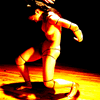
Wear + Tear
@ Beyond Dance Film: Physical Expression and Visual Media, Hammer Museum Courtyard, Saturday, June 10, 8 - 11pm. Beyond Dance Film is a unique installation of 25 international short dance films that explores the body and movement as a means of expression through all kinds of electronic visual experiments projected continuously on multiple screens and surfaces throughout the Hammer Museum Courtyard.
Wear + Tear; Interactive Performance; USA 2005/18 min; Director: Eric Koziol; Choreographer: Mei Yin Ng--Inspired by the quest for perfection, the degradation of a dancer’s body over time, medical imaging, and robots, Wear + Tear presents the dancer as a newly created robot. A series of repetitive physical tasks akin to a self-diagnostic are augmented by the sounds of mechanistic limbs and joints as body-mounted surveillance cameras permit the audience to adopt the perspective of the robot-dancer’s wrist and knee.
As the robot-dancer malfunctions, another series of tests uses rays of light to mimic an internal diagnostic as video projected directly onto the body reveal its inner workings. Making visible the normally invisible aspect of dance, these interior views of the body are synthesized from animated sources that include machine part, graphic depictions of the Chakras, Japanese anime, time-lapse photography, and “cellular animation.
As the robot-dancer begins to sputter, spin, and fall, the viewer’s perspective shifts to beneath the floor. Nearly exhausted, it drags itself across the floor as an awareness of its own deficiency conjures up a mental image of a body trapped inside a bubble. The restricted movement mirrors the body’s own limitations, revealing that perfection is impossible to achieve and that, from its inception, this bio-machine is destined to break down.
Wear + Tear was co-produced by the LEAP Festival 2005 Liverpool, UK
Eric Koziol: A founding member of the media collective H-Gun Labs, director Eric Koziol has collaborated with musical artists such as Nine Inch Nails, Public Enemy, Sound garden, De La Soul, Diamanda Galas, as well as television personalities Howard Stern, Roseanne Barr, and Michael Moore. His film and video work encompasses both experimental single screen works and multi-screen interactive video environments for theater, music and dance. His films have screened in the Dance on Camera Festival in New York, American Dance Festival, Cinema Museum Moscow, Fillmore Far East in Tokyo, and TTV Festival in Riccione, Italy. His live multi-media works have been showcased at PS 122 in NYC, Ontological Theater NYC, The Leap Festival in Liverpool, Rotterdam International Film Festival, and Boston’s Cyberarts Festival.
Mei Yin Ng: Chorographer and dancer Mei Yin Ng has collaborated with Remote Control Productions/ Michelle Laub in Europe, Nyo-Ba & Dancers in Malaysia, AMEYE in New York City, and choreographers such as Sally Gross, Bryan Hayes, Manuel Alum, Karl Hoass/ Damage Control & Maureen Fleming. The founder of the interactive artists collective Mei-Bee Whatever Company, her work has been presented at Dance Theater Workshop, La Mama Etc., PS122, Movement Research, The Construction Company, Italy’s Fabbrica Europa, and the International Choreographer’s Platform in Almada Portugal. Her work with Mei-Bee whatever has been funded by the Manhattan Community Arts Fund & a New York Foundation for the Arts Fellowship.
See culturebot.org interview >>
Posted by jo at 08:37 AM | Comments (0)
May 16, 2006
Interactive Telecommunications Program
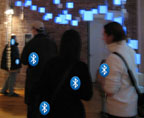
Spring Show 2006
Each ITP (Interactive Telecommunications Program) expo seems bigger, crazier, and more well-produced than the next. Last week's show was no exception with projects like the De-Painter, a machine that uses viewers' movements to generate paintings, and a Bluetooth person-tracking system called BlueWay... Robert Seward's trippy Consciousness Field Resonator ... takes the concept behind Princeton's Global Consciousness Project and integrates it into a personal device designed to resonate with users by alluding to uncanny correlations. If you really want to geek out, Seward's website has instructions for how to create your own True Random Number Generator. Other pieces were much more literal translations of much less metaphysical subjects, like Dimensional Cursive which transforms script into three dimensions and reminds of Fred Eerdekens' work. Look out for more, including a piece incorporating the algorithms of sunlight reflecting off of water and a zipper orchestra, in a Cool Hunting Video later this week.
Also on Cool Hunting: ITP Winter Show Videos, ITP Spring Show Review, Cellphedia. [blogged by ami kealoha on Cool Hunting]
Posted by jo at 01:01 PM | Comments (0)
Gizmodo Interview/Article by Jonah Brucker-Cohen
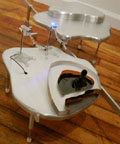
Sabrina Raaf
"With an ever-increasing amount of technology intended to “improve”, “augment”, and / or “add convenience” to our busy lives, there seems to be less of an emphasis on creating devices to reflect or comment on our natural or built environments. Taking this challenge as a starting point with her work, Chicago-based artist, Sabrina Raaf, examines the seemingly “invisible” elements of modernized and technologically equipped spaces by re-interpreting this covert data through mechanized objects that create feedback in the form of sound or other visual outputs. From exploring live data sets in the immediate gallery space with “Translator II: Grower”, a robot that measures carbon dioxide levels and draws corresponding blades of grass on the wall, to exploring the tension between humans and adaptive or automated systems with “Dry Translator”, Raaf’s work exposes the unspoken conflicts between society’s push for technological autonomy and the struggle to retain human emotion and sensibility. Her most current work, “Icelandic Rift” comments on the almost “alien” nature of future forms of agriculture that could exist in zero-gravity environments.
Gizmodo recently caught up with Raaf to discuss her unique and calculated artistic approach to creating work that not only challenges common perceptions of technological utopia, but also examines just how deeply we’ve become entrenched in high-tech fetishism." [via coin operated]
Posted by jo at 12:51 PM | Comments (0)
How Bodies Matter: Five Themes for Interaction Design
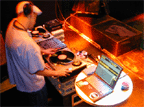
Physical Bodies
The body is the ultimate instrument of all our external knowledge, whether intellectual or practical… experience [is] always in terms of the world to which we are attending from our body. — Michael Polanyi
"ABSTRACT: Our physical bodies play a central role in shaping human experience in the world, understanding of the world, and interactions in the world. This paper draws on theories of embodiment — from psychology, sociology, and philosophy — synthesizing five themes we believe are particularly salient for interaction design: thinking through doing, performance, visibility, risk, and thick practice. We introduce aspects of human embodied engagement in the world with the goal of inspiring new interaction design ap-proaches and evaluations that better integrate the physical and computational worlds.
Author Keywords: Embodiment, bodies, embodied interaction, ubiquitous computing, phenomenology, interaction design." How Bodies Matter: Five Themes for Interaction Design by Scott R. Klemmer, Björn Hartmann and Leila Takayama [via pasta and vinegar]
Posted by jo at 12:34 PM | Comments (0)
nabaztag

WiFi Rabbit Opera -Flash Mob
Regine pointed me on this cool event: a opera for nabaztag at the Web Flash Festival on May 27th. It’s a kind of flash mob with communicating artifacts: 100 Nabzatags (Wifi rabbits) brought by their owners will play an opera created by Antoine Schmitt et Jean-Jacques Birgé at the Centre Pompidou in Paris. [blogged by nicolas on pasta and vinegar] [Related]
Google Translation of text [French to English]: The technical constraints are sometimes determining to compose. Thus the Nabaztag rabbits which will be present on the scene of the Web Flash Festival on May 27 are unable to play together in a synchronous way, they shift over one 10 seconds duration. It is enormous, since if we send only one note in wi-fi to them the result will be 100 repetitions of this played note on average all the tenths of a second, like a tremor of mandoline!
We obtain effects interesting of Brownian movements, magmats moving of small crystalline notes, the stamp chosen for the first movement being the ordinary one of Nabaztag, a kind of glockenspiel. To send a melody to the format midday will thus produce effects of agreements changing slowly with the liking of the intervals height and duration. But our rabbits have their own behavior and can choose between such or such file midday. Option of which we will use briskly in the second movement to constitute a succession of agreements more or less consonants starting from monodic melodies, this time made up of long notes. Long random agreements thus succeed the first movement whose irritated bunches alternate with silences where the only sound comes from the choreography of ears of the pack.
For the third movement, we plan to reproduce extracts of works of classical music, completely transformed by the effect of dephasing of the system. The passages selected by our care, but whose 100 rabbits will use with their discretion, are initially made up of short sentences of introduction to end in a collection of coded which will end up putting all our small beasts of agreement. Luminous choreography will complete the table, also retransmitted on large screen in bottom of scene.
The result will depend on testable simulations with the small program which is manufacturing Antoine…
I deliver below the first official statement sent to the press:
Nabaz' mob, opera for 100 communicating rabbits of Antoine Schmitt and Jean-Jacques Birgé
Coproduction Web Flash Festival and Purple (creators of the Nabaztag rabbit) An original initiative of Guylaine Monnier
Answering the Purple call of the company, 100 Nabaztag rabbits brought by their respective owners give each other appointment, in the spirit of the flashmobs, on the scene of the Center Pompidou to interpret, all together, an opera especially composed for the occasion by Antoine Schmitt and Jean-Jacques Birgé.
Convening John Cage, Steve Reich and Conlon Nancarrow, this open musical and choreographic partition in three movements, transmitted by wifi, exploits the tension between communion of the unit and individual behavior to create an at the same time strong and engaged work.
On May 27, 2006 with 20h
in the Center George Pompidou (Paris)
Evening of opening Flash Festival
(free entry within the limit of the places available)
Posted by jo at 12:09 PM | Comments (0)
Wilderness Information Network
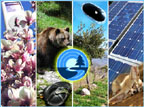
Nature Sonically Streamed + Transmitted
WILDERNESS INFORMATION NETWORK is an environmental installation featuring the work of over thirty international sound artists selected to create a sonic field of information produced with renewable energy, digital technologies, and ecological imagination. Hikers to the back woods location will use bluetooth-enabled devices or transistor radios to receive sonic information through digital downloads and radio transmissions.
The project was initiated and curated by Cary Peppermint and The Department of Ecology Art and Technology, a performative collaborative of artists seeking to create works that explore issues that lie at the intersection between digital media technologies and the environment.
If we encountered a pod-cast, or a streaming radio server in the woods, in the “natural” environment, what kind of information would be distributed? If there was an entity, a life-form, or a “natural” other that disseminated sonic information, wild-information, how would this information sound? This project encouraged artists to create audio sound works that imagine the “voice” of the ecological other and explore its translation into the language of digital art technologies.
If “nature” encountered a pod-cast, or a streaming radio server in the woods, in the “natural” environment, what kind of information would be distributed? This project could take on unpredictable, interactive, and experimental dimensions as it also encourages artists to consider themselves as human animals, beings within “nature” producing sound works for unknowable others, e.g. ferns, salamanders, flowers, mosquito, beetles, flowers, deer, coyotes, bear, water, etc.
Featuring the sound works of: Dirk Adams - Tamara Albaitis - Sheinagh Anderson - Tanguy Arnaud - Steven Matthew Brown - Hillary Charnas - Catherine Clover - Richard Curtis - Jan de Weille - The Dry Heeves - Ivan Elezovic - Jeff Gburek - Josh Goldman - David Hahn - Scott F. Hall - Francis Heery - Fabrice Janssens - Mike Johnson - David Kasdorf - François Martig - Eric Morrill - Andrea Polli - Joao Ricardo - Tara Rodgers - Leif Sandberg - Laura Solari – Charles Stankievech - Michael Trommer - The UN in Unnatural - Juha Valkeapää - Thomans Parker Williams
OPENING RECEPTION: Saturday, May 27th, 2006, at 4:00pm (Rain date: June 10). At the Pine Lake Environmental Campus of Hartwick College, 940 acres of woods in the upper Catskills of New York State, USA. Visitors to the opening are encouraged to spend the night onsite experiencing the audio transmissions and to bring along their camping gear and a Bluetooth enabled device or a transistor radio. Directions and additional information available on the website. Installation will be active May 27th through June 27th, 2006.
This project is made possible by support from Hartwick College, The Upper Catskills Community Council for the Arts, the NYSCA, and The Pine Lake Environmental Campus of Hartwick College.
Posted by jo at 11:58 AM | Comments (0)
WAVES: Electromagnetic Waves as Material and Medium of Art
![]()
Everything Flows
ART + COMMUNICATION 2006: WAVES--The 8th International New Media Art festival; August 24 - 26, 2006 in Riga, Latvia. The opening of the festival and exhibition - August 24, 2006. The exhibition will be open till September 17, 2006.
WAVES brings together about 40 international works of (media) art, in which electromagnetic waves are seen not just as carriers of information, but as the material and/or theme of the artwork. The artists are challenging conventional knowledge about and perception of waves. Electronic media such as radio, TV and the internet are of defining influence on today's societies. Subsequently the information sphere is tightly controlled and subject to various artificially imposed political limitations. Yet artists with their electronic and digital DIY kits are exploring numerous ways of thinking outside the box, making their own waves, creating alternative networks and engaging with strange scientific phenomena -- which points at actually existing utopian potential.
The artworks on display at the Waves exhibition cover a wide range of topics. Some of the works engage with interesting scientific phenomena to provide unusual aesthetic experiences such as listening to the background noise of the universe (Franz Xaver) or engaging with the visual and aural qualities of light bulbs (Artificiel). As the human sensory perception system gives us only limited access to electromagnetic waves, sonification and visualisation of scientific data are a major component of the exhibition. Other works explore social and political implications of wave regulation (Julian Priest, Bureau d'Etudes) and offer viable alternative communication systems (Marko Peljhan).
Those are just a few examples out of a large scale exhibition which interrogates the conventions of media art exhibitions. Whereas some works are based on screens and audio-visualisations of waves, many works rely on physical objects (Joyce Hinterding, David Haines), obscure or forgotten communication technologies (Paul De Marinis) and the antenna as an art object. Bringing together experienced and well known artists with young experimentators between art and science, Waves makes a statement by being the first large scale international exhibition to focus uniquely on waves as the material and medium of art.
The exhibition features about 40 works by 70 artists from 18 different countries, including: Anthony McCall (US), Derek Holzer (NL), Bas van Koolwijk (NL), Jean-Pierre Aubé (CA), Luke Jerram (UK), Bureau d'Études (FR), Franz Xaver (AT), Scanner (UK), Erich Berger (NO), Jacob Kirkegaard (DK), Joyce Hinterding (AU), David Haines (AU), Mr.Snow (AU), Marko Peljhan (SL), Steve Heimbecker (CA), Catherine Richards (CA), Farmersmanuel (AT), Yunchul Kim (KO/DE), Robert Adrian X (AT), Norbert Math (AT), Martins Ratniks (LV) Clausthome (LV), Antanas Dombrovskij (LT), Artificiel (CA), Bulat Galejev (RU), TAKE2030 (UK), Paul De Marinis (US), Judith Fegerl (AT), Julian Priest (UK), Roland Jankowski (AT), Aaron Kaplan (AT), Barry Hale (UK), Disinformation (UK), Janis Garancs (LV), Adam Hyde (NL), Lotte Meijer (NL), Aleksandar Erkalovic (HR), Adam Somlai-Fischer (HU/SE), Danil Lundbäck (SE), Bengt Sjölén (SE), Mark Fischer (US), Jay Needham (US), Atau Tanaka (FR), Cecile Babiole (FR), Laurent Dailleau (FR), Gints Gabrans (LV), Oskars Poikans (LV), Martins Vizbulis (LV), Voldemars Johansons (LV), and others.
The WAVES exhibition is complemented by a festival programme consisting of a conference a performanceprogramme, a community day and film screenings of classic and contemporary experimental movies.
Publication: CALL FOR PAPERS (Acoustic Space. Issue #6): The Acoustic Space journal is a forum for net.radio, sound art and creative explorations in the networked electro-acoustic environments. Now in its 6th edition, Acoustic Space Issue will be devoted to WAVES related thematic. read more... >
Locations: The exhibition takes place at the Exhibition Hall ARSENALS of the Latvian National Museum of Art (Torna iela 1, Old Town in Riga). Conference, performances and film programmes ? at the RIXC Media Space (11. Novembra Krastmala 35, entrance from Minsterejas iela).
Organisers: the RIXC Center for New Media Culture
Idea: Armin Medosch
Curatorial team: Raitis Smits, Rasa Smite, Armin Medosch (UK/AT)Curator assistants and managers: Daina Silina, Signe Pucena
Film programme curator: Erwin van?t Hart (NL)
Streaming programme co-ordinator: Adam Hyde
Technical director: Davis Bojars
Exhibition architect: Rudolf Bekic (AT/LV)
Designer: Martins Ratniks
Press coordinator: Agnese Rucina
Address: The RIXC, The Center for New Media Culture:
Address: 11. Novembra Krastmala 35 - 201, Riga, LV 1050, Latvia. Tel. +371-7228478, +371-6546776 (mob.), Fax: +371-7228477; URL: http://rixc.lv
Support: State Culture Capital Foundation, Riga City Council, Nordic Council of Ministers' Office in Latvia, Centre Culturel Francais de Riga, the Royal Netherlands Embassy in Riga, Nordic Culture Fund.
Posted by jo at 11:41 AM | Comments (0)
Public Private Interface - Art and Technology in Public Space

Workshop at Atelier Nord
Public Private Interface - Art and Technology in Public Space by Susanne Jaschko & Erich Berger: Wednesday 7th of June - Saturday 10th of June at Atelier Nord ,Oslo/Norway. Free participation. Application deadline Friday 19th of May. Send applications with CV to sense[at]anart.no
Urban public space operates as an interface between the individual and the public. It is a highly social, political and economic space. Nowadays digital technologies are omnipresent in this space, employed as systems for communication, control and organisation. The use and application of these technologies have strongly effected our understanding, perception and behaviour of public and private spaces.
The workshop will deal with the public space as field of artistic expression. We will analyse the properties and conditions of public space and the potential for art responding to this specific environment. Special attention will be laid on art and design using the existing technological infrastructure.
The workshop will consist of:
* Introduction into the theory and history of public space
* Analysis of public space and its typology
* Technological infrastructure of public spaces
* Potential for art in public space
* How to conceive art and design for public space
* Concept development and discussions
* Hands on experiments, research and presentations
WORKSHOP PARTICIPATION
Participation is free of charge. Artists, designers and practitioners interested in participating are asked to apply with a CV to sense[at]anart.no
Application deadline Friday 19th of May
Workshop directors and producer:
Susanne Jaschko (DE) http://www.sujaschko.de
Erich Berger(AT/FI) http://randomseed.org
Private public interface is part of the Interface and Society Project at Atelier Nord.
Upcoming workshops at Atelier Nord:
September: Mobile media art with Laura Beloff (FI)
ATELIER NORD
PHONE +47 23060880
FAX +47 23060884
E-MAIL office[at]anart.no
URL http://anart.no
MAIL Lakkegata 55 D, N-0187 Oslo, Norway
Posted by jo at 11:25 AM | Comments (0)
May 15, 2006
RFID Snakes and Ladders
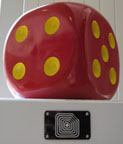
The Real World as Board for Online Game
RFID Snakes and Ladders is a giant game of snakes and ladders that shows how RFID (Radio Frequency Identification) technology can be used beyond the warehouse door. The game has been developed by new media company Blink and is being played at the Media Centre, Huddersfield, until June 2nd. It’s just like any other game of snakes and ladders, except the whole building – which is home to over 120 separate small businesses - becomes part of the game board.
First and foremost, RFID Snakes and Ladders is fun. Players are issued with a counter containing an RFID chip. All they have to do to get into the game is pass it in front of the giant dice and check how far they ‘rolled’ on a connected website. If they land at the bottom of the ladder, they pass their counter in front of the model ladder to climb it. If they hit the head of a snake, it’s a slippery slide unless they get to the model snake in time.
Models are placed at intersections around the Media Centre: in the entrance, the café bar and outside the lifts.
Players take a turn every three hours (unless they throw a six or land on a snake or a ladder, when they have to act quickly). In this way the game becomes part of the normal working day. Players might take a turn when they first arrive, another when they grab a coffee, and another at lunchtime. Playing takes just a few moments each day.
And if they land on a bonus square, they get a secret bonus prize. Players who reach the top square first win prizes from the centre’s Café Ollo menu.
RFID Snakes and Ladders is one of a number of experiments in mixed reality gaming, using the real world as the board for an online game, including Pac-Manhattan in New York and Mogi in Tokyo.
But it’s something more besides. It’s also a way of connecting people who may ostensibly inhabit the same location, but who often feel isolated from each other.
“After the Media Centre we hope to test the game in places where people are in danger of feeling cut off or lonely,” said Andrew Wilson of Blink Media. “For example in sheltered housing or the children’s ward of a hospital, where playing a simple, ongoing game with others might help to bring people together face to face.”
For more information on RFID Snakes and Ladders contact Andrew Wilson at Andrew[at]blinkmedia.org or 07980 224927.
Notes For Editors
Blink are a Huddersfield based company working with film, new media and mobile technology since 1999. Projects include the Guardian newspaper’s interactive SMS event in 2001, which taught the mainstream media how to use text messaging.
The Snakes and Ladders game programming and web design was by C.H.I.P.S. vzw (www.chipsvzw.be), new media specialists based in Antwerp, Belgium. In 2004 they created the SMS project STADSchromosomen for UNESCO’s World Book Capital Antwerp.
RFID hardware was designed and built by Daniel Blackburn of Carbon Based Games, Huddersfield. Daniel was recently awarded a two year Fellowship by the National Endowment for Science, Technology and the Arts (NESTA).
Illustrations were by Andy Sykes, an award winning illustrator and animator from Leeds. He has been awarded a Pocket Shorts commission to make a film for mobile phones, and the commissioned film won a runner up prize at the Texas DCI Mobile Content Festival and has been screened at festivals in Bristol, Rotterdam and San Francisco, as well as on BBC2's Homegrown Hollywood.
The Snakes and Ladders models were made by Richard Dawson, an experienced TV set designer who works on Casualty and Life on Mars.
Posted by jo at 05:40 PM | Comments (0)
Aura - the stuff that forms around you
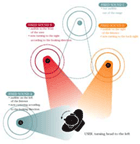
Sonic workshop with Steve Symons
Manchester based artist Steve Symons will be in residence at E:vent for a period of three days when interested public, practitioners, sound artists, visual artists, computer programmers and engineers will be invited to engage with his new work around immersive sonic environments using binaural sound and surround sound. Following the success of Aura - the stuff around the stuff around you, an immersive sound experience made for a single user, Symons has been researching and developing a second phase of the work for use in a multi-user and collective environment. Through a custom-built backpack, participants are invited to enter an environment - either outdoor using GPS to provide pointers for the sound or indoors through the use of simulated 'cells' or hotspots - that alters, through sound, their perception of the project environment.
Two workshops will be held where participants will be asked for feedback to Steve's work and talk about their own experiences of making sonic or locative media art work. This will be followed by a discussion session on Tuesday evening. Steve is open to different possibilities for presenting new content on the aura system and the workshop will provide a platform for exploring ideas together.
SCHEDULE:
----------------------------------------------
MON 22nd |12-5PM| Open to public
MON 22nd |5-7PM| Workshop
----------------------------------------------
TUE 23rd |12-5PM| Open to public
TUE 23rd |5-7PM| Workshop
TUE 23rd |7-10PM| Discussion session and networking event
----------------------------------------------
WED 24th |12-4PM| Open to public
----------------------------------------------
This micro-residency at E:vent is the first of three, with others following at STEIM, Amsterdam in June 2006 and F.City, Lancaster in October 2006. 'Aura - the stuff that forms around you' is supported by ACE, SCAN and Folly with thanks to E:vent for collaborating on this part of the residency.
Posted by jo at 05:10 PM | Comments (0)
NEW ADVENTURES IN SOUND ART PRESENTS:

RADIO WITHOUT BOUNDARIES CONFERENCE
The Deep Wireless "Radio Without Boundaries" conference explores the many potentials, boundaries and artist perspectives of radio and transmission art. Session topics include:
Whose Radio Art is it anyway? by Magz Hall (UK); free103point9 by Tianna Kennedy and Matt Mikas (US); Listening Sessions (limited spaces) with Darren Copeland and Steve Wadhams (CBC, Toronto); EarSpace Workshops: Exercises in Listening by Andra McCartney. Trevor Wishart (UK) speaks about his own radiophonic works; The Wire by Jowi Taylor, Paolo Pietropaolo and Chris Brookes (Toronto, Vancouver, Nfld); Radio, networks, Ether by Joe Milutis (US); The Deep Wireless panel with Debashis Sinha, Micheline Roi, Christian Nicolay & Damiano Pietropaolo; Wireless Imagination by Tetsuo Kogawa (Japan) & Kathy Kennedy (Montreal, QC); Radio of the Future panel chaired by Magz Hall and includes Charlotte Scott, Tetsuo Kogawa and Neil Sandell (CBC, Toronto).
Where: opens at the Drake Hotel May 26th (1150 Queen Street West) and continues at Ryerson University Student Campus Centre (55 Gould Street), Toronto, Canada; When: May 26-28, 2006 with workshop on May 29th; Conference Pass $150/130; $85/75 day pass. Deadline to register May 22, 2006!
Your 2-day conference pass also includes: performances each evening May 26th, 27th & 28th; FREE workshops on May 29th (Kogawa, Wadhams & Wishart); lunch each day May 27th & 28th; Opportunities to network during wine & cheese receptions.
Deep Wireless also includes:
Performances, installations and artist-residencies throughout the month of May
Radio broadcasts on CBC Radio's Outfront 99.1-FM May 3, 10, 17, and 24, 2006
Radio art interventions on CKLN 89.1-FM;
The launch of the Deep Wireless 3 radio art compilation CD
The Deep Wireless festival is partially funded by the government of Canada through the Department of Canadian Heritage, the Canada Council for the Arts, the Ontario Arts Council, the Toronto Arts Council, the SOCAN foundation and the British Council. Thanks also to Third Coast Festival, Association for Independents in Radio, free103point9, CKLN-FM and electrocd.com for their on-going support of the Radio Without Boundaries conference.
New Adventures in Sound Art is a non-profit organization that produces performances and installations spanning the entire spectrum of electroacoustic and experimental sound art. Included in its Toronto productions are: Deep Wireless, Sound Travels, Sign Waves and SOUNDplay.
Contact: Nadene Thériault-Copeland
Tel: 416-910-7231, naisa[at]naisa.ca
Posted by jo at 04:53 PM | Comments (0)
The Virtual Residency

International call for a Virtual Mass Migration
Europe is expanding. Europe is becoming seclusive. Master-minded by the media artists Monika Bohr, Claudia Brieske, Leslie Huppert and Gertrud Riethmüller, the multimedia and exhibition project The Virtual Residency is inspired by the overwhelming transformation and migration processes that Europe has been experiencing for over fifteen years now. During a three-year period the project group will conduct an experiment involving an appeal calling on artists worldwide to embark upon a communal virtual migration. The resulting ideas, concepts and pictures will then be provided with a provisional abode.
The Virtual Residency: [...] the Internet is considered an amorphous crossroads for constant artistic migrational flux. The Virtual Residency Internet platform forms the heart of the project as a whole. Functioning like a transmitter it will use the World Wide Web as a medium to challenge all artists on earth to take part in a creative journey, a virtual mass migration. New data streams will emerge, take shape and be attracted. The Internet platform will offer this migration a virtual "refuge". The ideas of the individual migrants will occupy the Virtual Residency; their designs will become virtual residents. They are to reflect the desire for a place to stay and deal with themes such as homeland, foreign lands and the unknown, travel, roots, hope, departure, loss, emptiness, stimulus, etc. [...]
Posted by jo at 04:26 PM | Comments (0)
Media, Minorities and Politics in Post-Communist Europe Conference
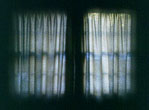
Old Curtains, New Screens
Old Curtains, New Screens: Media, Minorities and Politics in Post-Communist Europe Conference and screenings June 16-17 2006 in De Balie, Amsterdam (NL).
The fall of the Berlin Wall in 1989 formally removed the separation that had divided Europe for decades. The post-Wall landscape has been quickly transformed by new forms of mediation: changing infrastructures, techno-logies, and aesthetic forms that range from print to mobile phone to satellite television networks. This media boom has linked the post-communist region to the circulation of Europe and the globe at large in the last fifteen years. At the same time, new lines of separation, new curtains are also visible within policies and representations alike. We are particularly interested in how ethnic, gender, sexual, and religious minorities have been affected by the increased post-Wall attention that has been focused on them, and how they have been able to turn new media and social technologies into political and representational tools.
This symposium will bring together leading regional and national experts in the fields of broadcasting, visual art, new media activism, and film production to examine recent East and Central European media and political transformations. All panellists are involved in both the daily tasks of negotiating policy issues and in the theoretical work of understanding new identity formations that are no longer locked into national systems but are inevitably hybrid, sustained by and actively absorbing transnational affiliations. The event will be constructed as an interweaving series of engaging and informative short presentations, discussions, as well as film and video screenings.
Xenophobia and the Emergence of New Media Networks
17 june, 10:30 – 11:15
Tomász Kitlinski focuses on how new forms of xenophobia have accompanied the emergence of transnational gay, lesbian, and feminist media networks in Central and Eastern Europe. In the center of his presentation is the “sexual dissident,” whose coming out introduces a new voice into post-socialist literature, culture, and activism. The discourses of official media often dehumanize women and sexual minorities. Kitlinski addresses these forms of exclusion and the ways in which the groups involved try to challenge them through mobilizing new media networks.
Tomász Kitlinskiis lecturer in philosophy at the Marie Curie University, Lublin, Poland. He is the author of The Stranger Is Within Us (Aureus, 2001), co-author of Love and Democracy: Reflections on the Homosexual Question in Poland (Aureus, 2005) and contributed to Our Monica, Ourselves: The Clinton Affair and the National Interest (New York University Press, 2001). He contributed to‘New Europe, Old Monsters’ and other texts on international and Polish new media.
Virtual Space and Internet Media: Self-Representations of East European Women on the Web
17 june, 11:45 – 12:35
Arturas Tereskinas analyzes the visual strategies articulated by Eastern European women in their internet personals. What issues of self-representation, gender, body and sexuality do these images raise? What representational conventions do they employ? Examining the problems of fantasy, pornography and desire, Tereskinas argues that through these images women describe and specify not only their sexualities but also their longings, insecurities, yearnings and their movement towards new possibilities. Iconography and narrative of these personals offer imaginary forms of resolution for contradictions that exist in both Eastern European cultures and women’s lives.
Arturas Tereskinasis Associate Professor of Sociology at Vytauras Magnus University and Vilnius University, Lithuania. He is the author of Bodily Signs: Sexuality, Identity and Space in Lithuanian Culture (2001) and Imperfect Communities: Identity, Discourse and Nation in the Seventeenth-Century Grand Duchy of Lithuania (2005) and the editor of Public Lives, Intimate Places: Body, Publicity, and Fantasy in Contemporary Lithuania (2002) and Men and Fatherhood: New Forms of Masculinity in Europe (2005, with Jolanta Reingardiene).
The Role of European Institutions in Support of New Media: The Case of Roma Media
17 june, 12:30 – 13:15
Valeriu Nicolae will discuss the role that European institutions and NGOs play in supporting media-related projects. He will explicitly focus on the ways in which Roma media have emerged in post-1989 Europe, and how these media have started both to challenge mass media and to function as alternative sources of information.
Valeriu Nicolaeis secretary-general of ERGO, the European Roma Grassroots Organizations Network, a network of Roma organizations from Slovakia, Serbia, Moldova, Bulgaria, Romania and Albania, and an OSI fellow. From 2003 until March 2006, he was deputy director of ERIO, the European Roma Information Office in Brussels. He developed an educational project for Roma children in his hometown Craiova, Southern Romania.
Ghetto Entertainment: Mainstream media and Minority Representation
17 June, 14:15 – 15:45
Anikó Imre will address the ways in which films and television programs that explicitly deal with minority issues have become central to public debates on minorities. In a case study, Imre will present a ‘close-reading’ of the film Nyócker (Hungary, 2004, 90 min) by the Hungarian director Áron Gauder. Nyóckeris an animation movie on the conflicts between different Hungarian minorities and the municipality in the eight district of Budapest, commonly known as the ‘Roma ghetto’.
Anikó Imreis a postdoctoral fellow at the Amsterdam School for Cultural Analysis, University of Amsterdam. She has written extensively on East Central European film and media. She is the editor of East European Cinema (Routledge, 2005).
Governments versus Art? Art as Alternative Media Space
17 June, 16:15 – 17:00
Pawel Leszkowicz will look at the ways in which artistic representation functions as an alternative medium that counterbalances the one-dimensional gender structure of the official, often still state-supported media. The range of images of sexuality and gender projected by contemporary art might function as an opening into the hidden history of Polish subjectivity and society, supplementing and enriching the dominant media sphere.
Pawel Leszkowiczis is lecturer in Contemporary Art and curator at the Department of Art History, Adam Mickiewicz University Poznan, Poland. He is the author of The Iconography of Subjectivity: Helen Chadwick (Aureus, 2001), co-author of Love and Democracy: Reflections on the Homosexual Question in Poland (Aureus, 2005) and contributed to Our Monica, Ourselves: The Clinton Affair and the National Interest (New York University Press, 2001). He contributed to Polish feminist and gay collections and magazines, and curated the art exhibitionLove and Democracy.
Special Evening Program: Timescapes by Angela Melitopoulos
17 June, 20:00 – 22:00
Timescapes is a collective video project based in South-Eastern Europe that explores collective memory in video imagery and new forms of filmic representation through the possibilities of non-linear editing via the Internet. Timescapes’ basis is a database built by five video artists/activists from Cologne (Angela Melitopoulos), Berlin (Hito Steyerl), Belgrade (Dragana Zarevac), Athens (Freddy Viannelis), and Ankara (Videa: media collective) who shaped different subject matters on the theme of mobility and migration—and memories thereof—in so-called “B-Zone territories” in South-Eastern Europe and Turkey. Angela Melitopoulos will discuss and screen her contribution to
Timescapes, the artistic road movie “Corridor X”.
Angela Melitopoulosis a video artist from Cologne, Germany. She studied fine arts at the Academy of Arts in Düsseldorf with Nam June Paik. She has worked with electronic media since 1986 and has experimented with single-channel-tapes, video installations, video essays and documentaries. Her video essay Passing Drama (1999) has won several prizes, among which the Prize of the Council of Europe (2000).Timescapes was exhibited as part of a larger exhibition on B-Zone: Becoming Europe and Beyond at Kunstwerke Berlin earlier this year.
Program Saturday 17 June
10:00 Ginette Verstraete, Anikó Imre, Huub van Baar, Welcome
10:30 Tomász Kitlinski, Xenophobia and the Emergence of New Media
Networks
11:15 Coffee Break
11:45 Arturas Tereskinas, Virtual Space and Internet Media:
Self-Representations of East European Women on the Web
12:30 Valeriu Nicolae, The Role of European Institutions in Support
of New Media: The Case of Roma Media
13:15 Lunch Break
14:15 Anikó Imre, Ghetto Entertainment: Mainstream Media and Minority Representation Abridged Screening of Nyóckerby Áron Gauder
(Animation Movie, Hungary, 2004)
15:45 Coffee Break
16:15 Pawel Leszkowicz, Governments versus Art? Art as Alternative
Media Space
17:00 Panel Discussion moderated by Huub van Baar
17:45 Dinner Break
20:00 Ginette Verstraete, Introduction to Angela Melitopoulos’s
Timescapes
20:15 Angela Melitopoulos, Timescapes (Video art, Germany, 2005)
Film Program De Balie Cinema– 16 and 17 June
Special event
On 16 and 17 June De Balie Cinemawill show the documentary The Danube Exodus by the Hungarian filmmaker Péter Forgács (A Dunai Exodus, Hungary, 1998, 60 min). Time: 20:15.
On 16 June the German film critic Jörg Taszmanwill interview Péter Forgács, and moderate a discussion with him and the audience.
Péter Forgácsis a leading practitioner of ‘found footage’ filmmaking. Home movies and amateur films in particular serve as the sources from which he composes his stories. The Danube Exodus is a travelogue documenting the Jewish exodus from Slovakia just before the beginning of the Second World War. In two ships, a group of 900 Slovak and Austrian Jews try to reach the Black Sea via the Danube, and from there to go to Palestine. Forgács based his film on the amateur films made by the captain of one of the ships, Nándor Andrásovits. He filmed his passengers while they prayed, slept, and even got married. At the end of this journey, it becomes clear that the boat will not return empty: in an historical paradox, a reverse exodus takes place, this time the repatriation of Bessarabian Germans, fleeing to the Third Reich because
of the Soviet invasion of Bessarabia. A fascinating personal and historical document.
Jörg Taszman grew up in East-Berlin and Paris, finished the Budapest Film School in 1991 and lives in Berlin. He works as a journalist and film critic specialized in East European cinema.
Old Curtains, New Screens is organized by the NWO Research group Globalization and the Transformation of Cultural Identities in Central and Eastern Europe(Amsterdam School for Cultural Analysis, University of Amsterdam), De Balie, The NetherlandsOrganization for Scientific Research (NWO), the Faculty of the Arts at the Vrije Universiteit Amsterdam, and Architecturalia.
De Balie, Kleine-Gartmanplantsoen 10 (near Leidseplein), Amsterdam. Entrée fee Symposium, 17 June: 5 € (day progam); 5 € (evening program) 7,50 € (both). Language: English. Reservations: 020 – 5535100 Entrée fee Péter Forgács’s The Danube Exodus, 16 and 17 June: 7 € / 5 € with reduction. Reservations: 020 – 5535100 or: www.debalie.nl/cinema
Further Information
De Balie: www.debalie.nl
Huub van Baar Huub.van.Baar[at]uva.nl
Anikó Imre A.Imre[at]uva.nl
Ginette Verstraete gee.verstraete[at]let.vu.nl
John Neubauer J.Neubauer[at]uva.nl
Posted by jo at 04:03 PM | Comments (0)
MEMEFEST 2006
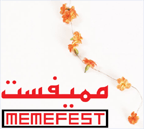
CREATION, SUBVERSION, AND RESISTENCE!
Memefest, the International Festival of Radical Communication- born in Slovenia and rapidly reaching a critical mass worldwide- is proud to announce its fifth annual competition. Once again, Memefest is encouraging students, professionals, writers, artists, designers, thinkers, philosophers, and counter-culturalists to submit their work to our panel of renowned judges. This year, jury members will include Richard Barbrook, esteemed author, research pioneer, radio vigilante, and critic of neo-liberalism, along with radical designers and activists Sandy Kaltenborn, Kernow Craig, Paul Shoebridge and Jason Grant, Clinical Psychologist and "Bag news" blog author Dr. Michael Shaw and design critic Kenneth Fitzgerald.
Students who work with the written word can respond to Richard Barbrook's own article The High-Tech Gift Economy, which makes the ominous but relevant claim that, because of the realities of market capitalism, the utopia of an anarcho-communist gift economy on the internet is a deluding fiction. Artists and graphic designers can create static and interactive works in response to The Declaration Towards a Global Ethic, a call to "spiritual arms" and the creation of a collective consciousness.
Non-students, and those whose work doesn't fit in the box of conventional communications, can enter the visionary Beyond… category, where the name of the game is challenging mainstream practices and beliefs! Absolutely anything innovative, either written or visual, is acceptable, so long as it challenges mainstream modes of communication. Check out some examples and the winners from the 2005 and 2004 sites at http://beyond.memefest.org. Beyond… is open to non-students as well!
Memefest occurs almost completely online, and all entries will be available for full access and commentary in the site galleries. In 2005, Memefest received almost 500 entries from participants of every continent on the globe ('cept Antarctica). We hope to get bigger, and to spread more of those good infectious ideas, so keep thinking- and producing. Check out the beta version of our 2006 web site for more information: http://www.memefest.org Deadline for submissions is May 20th 2006.
Subvert, Create, Enjoy!
Patricia Laboca
Memefest
Contact us: memefest at memefest dot org
Posted by jo at 03:56 PM | Comments (0)
[MediaRuimte]'s MR.xpo 12
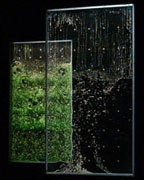
Stream Space by Peter Maschke
During his residency at MediaRuimte (MR.tmp06), Peter Maschke is developing in collaboration with LAb[au] (electronics+programming), Geert Feyton from Noise Maker's Fifes (analog sound) and Frederik de Wilde (digital sound) an interactive audiovisual installation under the title Stream Space. The result of his residency will be presented in the exhibition MR.xpo 12, taking place at MediaRuimte from 25.05 - 03.06.2006. For the opening, Thursday 25.05.2006 at 22:00, Stream Space will be performed live.
Stream Space is an audiovisual installation, which takes the properties of water as its starting point. Water has always had a strong and meditative force of attraction on mankind, be it the stillness of the sea or the sound of streaming water. The installation is an attempt to translate the ever being fascination for the element water into an audio-visual concept, that invites the auditor to create his personal visual sound score.
Four acrylic glass windows measuring 210 x 110 x 2 are suspended in a space, each filled with water, dyed in a different colour. A system of air tubes arrives at the bottom of the windows and is connected to a compressor. Air can be injected, that will rise as bubbles in the water.
The idea is to capture the sound of the burbling water, to modulate it and to emphasize its quality. This will result in a specific sound-colour for each window. The project foresees a combination of passive and active elements. The passive part of the interaction, consisting of sonar boxes (or web cams), will scan the surroundings of the installation within a specific range. When a movement is captured, it will be translated into an electrical signal that will operate the valves of the air supply. In the active part, a console with four joysticks on independent circuits can be operated. Through the console, the visitor can control the amount of air injected into each of the windows, thus manipulating sound and visual contents of the installation. By this means, an interaction takes place between the visitor, the visual object and the randomised modulated tone.
PETER MASCHKE
Born in Germany, Peter Maschke has been living in Brussels since 1991. He started his career as a dancer in 1984 when, after studying dance at the London School of Contemporary Dance (UK), the Folkwang School in Essen (De), and the CNDO in Arnhem (Nl), he joins the company Plan K in Brussels. He dances in Icare and later participates in the creation of Titanic. He then participates in a series of choreographic and theatrical creations through which his interests start to be more and more directed towards set-design.
Meanwhile, he has created the sets for various dance and theatre company’s, more in particular for Rideau de Bruxelles (Les Indifférents, Prometheus), Compagnie José Besprosvany (Lara, Dos y Dos), Théâtre Le Public (L’Invisible, Belle à mourir), Pé Vermeersch (The Story of Salomé and Yokanan), Avi Kaiser (Lieber R), Juliette Bougard (The Sorry Piece), Leporello (Onkel Vania) and Compagnie Thor (l'Âme au diable).
As scenographer and/or assistant director he has collaborated with the music theatre company Tirasila, creating sets for numerous creations: Roi Ubu, K-Bel, Het Laatste Verlangen, Krsk and Slachtwerk. In 2004, he participated as assistant director in the creation of Theater Stap’s theatre piece Frankenstein, directed by Vital Schraenen.
He regularly works with the choreographer Fernando Martin's company Fuepalbar, for whom he designed sets for the choreographies Mismorigen, Ten Sueño and Mordre à travers. For these last two creations he also participated as assistant choreographer.
Currently, he is working with the artist Alexandra Dementieva on an installation, which is foreseen for Spring 2006.
LAb[au]
LAb[au], laboratory for architecture and urbanism examines possible textual, graphical and spatial forms of transcription of inFORMation processes, transmission, computation and editing through theoretic works, research / writings and production /c onception. The core of Lab[au]'s theoretical research is the impact of new information technologies on the spatial and semantic mutations through projects implicating a reflection on the perception and conception of space. The contents of Labau's work is to find a definition of architecture as a set of codes or a language drawn from concepts of communication and information sciences, by opening up the fields considered by today's architectural concept with those considered in communication and new media. Here, 'Metadesign' can be understood as a technology determinism that constitutes the main vector/thought in the concerns of networked, information-based societies with the goal to build up connectivity and effectiveness.
Posted by jo at 03:28 PM | Comments (0)
Gustav Metzger, Works
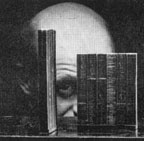
Auto-Destructive and Auto-Creative Art
Gustav Metzger’s first Manifesto for an Auto-Destructive Art from 1959 proved directional for one of the most uncompromising artistic careers in our time. Auto-destructive art is made to be self-destroyed. The act of destruction is crucial to the work.
In London in the 1960s one could see Metzger’s actions (such as his painting performance involving acid and nylon canvases) or hear his lectures. In 1966 he gathered large parts of the avant-garde of the time for the legendary Destruction In Art Symposium (DIAS). At the first Fluxus exhibition in London his work was censored, since the organisers didn’t understand his project of plastering a wall with all sheets of a newspaper. In a later reconstruction the work reveals itself as strongly historically charged. It coincided in time with the revelations about Soviet nuclear bases in Cuba and the most serious political crisis of the post-war period, when the world was at the brink of nuclear war.
The boundary between art and political activism has always been kept open in Gustav Metzger’s art. He was among the pioneers of the struggle against nuclear weapons, and he protested already in the 1950s against new motorways and increased pollution in London. His auto-destructive art is best understood against this background, as an answer to and an attack on the destruction that happens around us all the time. Destruction, however, is not all negative. It is also a precondition for change and creation. Metzger has spoken of both auto-destructive and auto-creative art.
Many of Gustav Metzger’s projects have remained unrealised and exist only as proposals and models. His practice is more to do with today’s art than with the period when it was created. In 1972 he was supposed to participate in Documenta 5 in Kassel with the work Karba, consisting of four cars whose exhaust fumes fill up a large plastic cube. For unknown reasons the work was never realised. This also happened with Stockholm, June, a proposal for the UN Environmental Conference in Stockholm the same year, for which 120 cars were to be encased in plastic, overheat and self-combust. It is only now that Karba, the work for Documenta, is realised for the exhibition in Lund. It is both sculpture and process, a protest as well as an ambiguous monument.
Gustav Metzger’s art reveals a strong interest in processes. His works are at the same time art and investigation. Technology and science have clearly influenced him, for instance his experiments with chemical and physical processes, his automatic art and his early interest in the possibilities of the computer. Sometimes this open-endedness has spawned unforeseeable results. His experiments with projected images of heated liquid crystals that create short-lived, ever-changing colour fields were integrated into the psychedelic aesthetic of the 1960s by bands such as Cream and The Who. In addition, it was Gustav Metzger's lectures that inspired Pete Townsend to end The Who's concerts with the destruction of all the instruments.
Metzger’s practice is founded in a dark vision of Man and History. Born 1926 to a Polish-Jewish family in the German city of Nuremberg, he was fascinated as a child by the spectacular Party Days that the Nazis organised there every year. He had an early interest in German art and culture, and has remained attached to the German language. Most of his family, including both parents and an older sister, perished in the Holocaust, while he and his brother Mendel escaped to England in 1939.
Throughout the 1990s Gustav Metzger has continuously elaborated the series Historical Photographs, in which images relating to difficult moments in history are made hard to access or altogether hidden to he viewer. Several of the works deal with Nazism and the Holocaust, but the artist also addresses topics such as the massacre on Temple Mount in Jerusalem and violence against the environment.
During the last decade a series of exhibitions have highlighted Gustav Metzger, making his importance for post-war developments in art ever more obvious. The exhibitions have also given him the possibility to realise several new projects, such as Eichmann and the Angel (2005) and In Memoriam (2006). Both these works reflect on memory, history, the Holocaust and in particular the fate of the philosopher and writer Walter Benjamin.
Pontus Kyander
Curator of the exhibition
Gustav Metzger, Works: 20 May - 27 August 2006; Opening 19 May 5 - 8 pm; Lund Konsthall, Mårtenstorget 3, Box 2051, SE-220 02 Lund; Phone: +46 46 355295; Fax: +46 46 184521. [via e-Flux]
Posted by jo at 03:11 PM | Comments (0)
May 13, 2006
TXTual healing
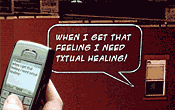
Interactive Text Messaging Enabled Public Performance
Using public space to engage a performative, open dialogue. In Paul Notzold's current work "TXTual Healing uses a cell phone a computer and a projector to create a mobile public performance by posting a person's text messages into speech bubbles that are strategically placed on the facades of buildings."
more from the project site:
"Using 'always on' technology, cell phones with SMS messaging allow an audience to interact with large speech bubbles projected onto a flat surface, like the facade of a building. The bubbles are positioned near windows and doors to encourage an audience to create the conversations happening inside. The audience receives a flyer with the number and simple instructions. A participant sends a text message to the provided phone number and it is then displayed inside the speech bubble. Multiple bubbles may be used and the audience can direct their input to a specific bubble.
The piece explores the use of mobile technology to trigger dialogue, action and create content in a staged public performance. By using the facade of a building the intention is to engage an audience to think about the spaces we move through, live in and share. I'm trying to address public vs. private space and what kind of dialogue might transpire if we publicised our private thoughts. The piece was designed to encourage play, idea sharing, thought, discourse, and entertainment."
Paul mentions he is exploring the use of silhouettes in his performance dialogues as the project evolves.
Posted by michelle at 03:43 PM | Comments (0)
May 12, 2006
Eryk Salvaggio
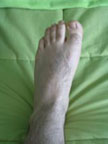
MySpaces
MySpaces is a project about the projection of the self that we must make onto social networking sites such as friendster and myspace. Usually, this projection reduces us to a few paragraphs designed to be read by anyone. This project is an attempt to create a real sense of physical intimacy, by changing my top 8 to reflect my relationships with various parts of my own body.
In theory, the idea is the first step towards the "myspacing" of the intimacy of a sexual act, where the connections of body parts are seen as connections of the associations one has with the body parts. i.e., if another participant created a similar project, and we charted the relationship between both of our body parts through the lens of our individual relationships, quite literally a kind of intimate sexual encounter would emerge between the two of us, as the profiles of our body parts communicated with one another through the comments board on each profile. [posted by Eryk on salsabomb]
Posted by jo at 01:36 PM | Comments (0)
Poetry Machine 1.0 + Electrophile
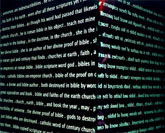
Welcome to the World of Spooky Keyboards
David Link's Poetry Machine 1.0 is a word processor that generates texts through a combination of user input and autonomous web bots. Its sources of information are the gigantic pools of information on the Internet. In a room, a text that is written by nobody runs on a projection screen. The keys of the keyboard move swiftly as if by a ghost's hand and a mechanical voice reads out the generated text, sentence by sentence.
But when visitors approach, the text generator staggers, hesitates, at times grows completely silent. If a visitor strikes the keys himself, the text appears on the screen as well. If the user's input contains words that are unknown to Poetry Machine, the program sends "bots" into the internet to get appropriate informations. Their search process (visited sites, their valuation and the documents found) can be followed on a second screen.
In this interaction of machine words and human text, «Poetry Machine» creates a new écriture automatique, where language is no longer the exclusive domain of human thought but also that of the internal logic of computers. Video.
The work is part of the Beijing International New Media Arts Exhibition and Symposium, June 30 - July 10 2006, China Millennium Museum, Beijing. Images.

Writing about uncanny keyboard, gives me a great opportunity to mention Crispin Jones's Electrophile, a keyboard designed for celebrity fans who have limited means for communicating the fandom through email messages. The keys on this tool for adding a sense of devotion to email messages are fitted with tiny metal contacts that deliver an electric shock to users. The shock becomes progressively stronger as more characters are entered. You've got to be a real fan of the celebrity to finish your letter to him/her. The shocks are controlled by a circuit based on one which was designed for a muscle toning device ("Gym Relax"). [blogged by Regine on we-make-money-not-art]
Posted by jo at 01:07 PM | Comments (0)
Radio 1's One Big Weekend
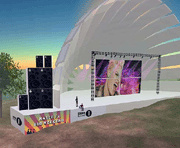
Second Life Virtual Festival
While E3 rages on over Stateside, here in the UK it's wellies and arm-waving in the Dundee sunshine: Radio 1's One Big Weekend, all weekend, all free, all festival fabulous: starting tomorrow. And if you're nowhere near Dundee or didn't get a ticket, you can still join in, because the Radio 1 team have only gone and built a virtual festival in the also-free Second Life:
Every virtual festival-goer will get a wee digital radio to take away with them, which will broadcast Radio 1 in-game, wherever you are.
![]()
There's also, I hear, these Radio 1 teeshirts for your avatars. And dancing. And a chance that you could appear on-screen at the actual festival - the jumbotrons may or may not take screengrabs of the in-game festivalgoers.
Obvious disclaimer: I work for the BBC, and I work with the guys who made this happen, and I TOTALLY {heart} them. This blog is still all my own opinions and not necessarily those of my employer. Disclaimer over.
If you're in there, say hi! Just load up SL, search for Radio 1, and head over - but not now, because it opens tomorrow morning, GMT. Or IM me, and I'll teleport you there: Crystaltips Pavlova. [Posted by Alice on Wonderland] [Related]
Posted by jo at 12:22 PM | Comments (0)
Delft University of Technology
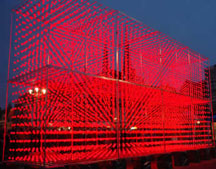
World’s Largest 3D-Display
Electrical engineering students at the Delft University of Technology in the Netherlands have created the world’s largest 3D-display. The display consists of 8,000 suspended ping pong balls that each contain a red LED light. It play games of 3D snake, 3D pong, and 3D duckhunt, as wll as displaying SMS messages and simple animations.
4 kilometres of copper wire, 3 kilos of solder, a couple of hundred metres of aluminium and eight printed circuit boards. [blogged by Ruairi on Interactive Architecture dot Org]
Posted by jo at 11:28 AM | Comments (0)
MoBeeline + The Compass Coat
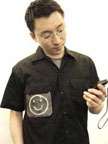
Wearables
MoBeeline allows people to send data about a user’s emotions to another’s clothes via SMS. The MoBeeline wearable Bluetooth accessory can receive data from a mobile phone. For example, one mobile phone user can send operative directions to the other's clothes and share his/her feelings and emotions by sending signals to the other person's clothes. According to the emotion the user wants to communicate, He or she will be able to modify the colors or patterns of the garment, or send emoticons to LEDs on the garment.
Video. Developed by Chang Soo LEE and HyeJoo Lee at the ITP. [blogged by Regine on we-make-money-not-art]
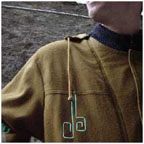
The Compass Coat, by Stijn Ossevoort, uses compass technology to read direction. The display of the information is integrated into the design of the coat offering information for both the wearer and the people around him. North is indicated through glowing plant-like shapes like a tree which is covered with moss in the main wind direction.
The coat contains magnetic sensors and 24 sections that can light up individually, using Electro Luminescent wires. The section that points north lights up while its surrounding sections glow dimly. As soon as the wearer turns, the light gradually moves onto the new section that points north.
Related: CabBoots, the navigation shoes, A belt with with tactile sense to show you the way, Melodious Walkabout. [blogged by Regine on we-make-money-not-art]
Posted by jo at 11:22 AM | Comments (0)
NETTIME_NORTH_AMERICA_GATHERING
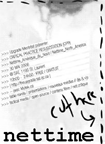
CRITICAL PRACTICE RESUSCITATION (CPR)
UPGRADE MONTRÉAL PRÉSENTE: NETTIME_NORTH_AMERICA_GATHERING ::: CRITICAL PRACTICE RESUSCITATION (CPR) ::: NETTIME_AMERIQUE_DU_NORD
Links: [ http://theupgrade.sat.qc.ca ] - Upgrade Montreal & Nettime_North_America web-site [ http://www.nettime.org ] - Nettime.org; partenaires / partners: Mutek.ca / Turbulence.org / Rhizome.org / SAT / CKUT 90.3 FM / esse / Parachute / V2 / Upgrade International / Nettime.org
---[ english ]---[french and spanish follow]: Nettime.org has long been the focal point of global indymedia, net-art, tactical media and the technology arts. Since 1994 its mailing lists, online and offline discussions, publications and gatherings have galvanized a flurry of global networks and their practitioners. __But what is the continuing role and impact of Nettime today_? In 2006, the Upgrade Montreal welcomes Nettime to Montreal for the first ever fleshmeeting in North America. The Gathering will also launch the 2006 edition of the Mutek festival of digital culture. As a node in the expanding, grassroots technology arts network Upgrade International, it poses a series of questions to the future of Nettime:
_who are the new practitioners & what are the new directions in tactical media_?
![]()
On Tuesday, May 30th 2006 the Upgrade Montréal will bring together the first North American gathering of the global mailing list, nettime. Since 1995, Nettime has been a focal point for discussion and criticism of internet culture and art, technologies and politics, developing an expression of Net culture known as "net.criticism." In over seven languages, Nettime has served as the testing ground for numerous texts and artistic works of new media and contemporary theory. In 2006, Nettime celebrates its 11th birthday against the backdrop of over a decade of publications, interventions and debates.
Members of the public, artists, theorists, writers, codemonkeys and the curious are welcome to attend a series of talks, panels and workshops followed by an evening of music and performance devoted to Nettime, its members, it works, its pasts and its futures. International members of Nettime will be in attendance including list moderators. Nettime is an open list and this event is open to all of the public! nettime is not just a mailing list but an effort to formulate an international, networked discourse that neither promotes a dominant euphoria (to sell products) nor continues the cynical pessimism, spread by journalists and intellectuals in the 'old' media who generalize about 'new' media with no clear understanding of their communication aspects. We have produced, and will continue to produce books, readers, and web sites in various languages so an 'immanent' net critique will circulate both on- and offline.
The formation of the Nettime group goes back to spring 1995. A first meeting called nettime was organized in June 1995, at the Venice Bienale, as a part of the Club Berlin event. The list itself took off in the Fall. A first compilation on paper appeared in January 1996, at the second Next Five Minutes events (the so-called ZKP series). The list organized its own conference in Ljubljana in May 1997, called 'The Beauty and the East'. A 556 pages nettime anthology came out in 1999: Readme! Ascii Culture and the Revenge of Knowledge (Autonomedia: New York (ISBN: 1570270899)).
The Upgrade is an international, emerging network of autonomous nodes united by art, technology, and a commitment to bridging cultural divides. Upgrade Montreal is organised by tobias c. van Veen, Sophie Le-Phat Ho and Anik Fournier, and over the past two years has featured diverse events bridging digital culture and the technology arts, from new media and net-art to electronic music and performance, from an eclectic political benefit for Critical Art Ensemble to a subzero celebration of Art's Birthday. The Upgrade Montréal is produced by SAT and collaborates with various organisations including Studio XX, La Centrale, terminus1525.ca, OBORO and Hexagram among others. The Upgrade began in 1999 with a regular gathering of new media artists and curators in New York City organised by Yael Kanarek. Upgrade New York partnered with Eyebeam in 2000, and in 2004 the Upgrade went international with Vancouver and Montreal joining the network, followed by over a dozen worldwide locations in 2005 (and growing!). The first Upgrade International Gathering was held September 2005 in NYC at Eyebeam with representatives from each global node.
---[ français ]---
Nettime.org est depuis longtemps le point focal du indymedia mondial, du net-art, des médias tactiques et des arts technologiques. Depuis 1994, sa liste de diffusion, ses discussions enligne et hors ligne, ses publications et ses rencontres ont galvanisé une quantité de réseaux transnationaux de même que leurs praticiens. _Cela étant dit, quel est le rôle continu et l'impact de Nettime de nos jours_? En 2006, Upgrade Montréal accueille Nettime à Montréal pour une première rencontre en Amérique du Nord. La rencontre inaugura aussi l'édition 2006 du festival des arts numériques de Mutek. Étant un noeud d'Upgrade International, un réseau grassroots d'art technologique en expansion, une série de questions seront posées à l'égard du futur de Nettime:
quels en sont les nouveaux participants, et quelles sont les nouvelles directions prises par les médias tactiques?
Le mardi, 30 mai 2006, Upgrade Montréal sera l'hôte de la première rencontre nordaméricaine de la liste de diffusion internationale nettime. Depuis 1995, Nettime a servi de point de rencontre important pour la discussion et la critique de la culture du Net et de l'art, des technologies et de la politique, développant ainsi une expression de cette culture sous le nom de "net.criticism." En plus de sept langues différentes, Nettime a servi de banc d’essai pour de nombreux textes de théorie contemporaine et d'oeuvres artistiques des nouveaux médias. En 2006, Nettime célèbre son 11e anniversaire, fort d'une décennie de publications, d'interventions et de débats.
Membres du public, artistes, théoriciens, auteurs, codeurs, et curieux de tous genres sont les bienvenu(e)s à cette série de conférences, de panels et d'ateliers qui seront suivis d’une soirée de musique et de performance dédiées à Nettime, ses membres, ses oeuvres, ses passés et ses futurs. Des membres internationaux de Nettime seront de la partie, ainsi que des modérateurs de liste. Nettime est une liste ouverte et cet événement est ouvert au public nettime n'est pas seulement une liste de diffusion, mais un véritableeffort collectif à la formulation d'un discours international et en réseau qui ne fait pas la promotion d’une euphorie dominante (afin de vendre des produits) ni ne perpétue un pessimisme cynique répandu par des journalistes et des intellectuels des "vieux" médias qui ont tendance à généraliser les "nouveaux" médias avec une compréhension vague de leurs aspects communicatifs. Nous avons produit, et continuerons de produire, des livres, des manuels et des sites web en diverses langues pour qu'une critique "immanente" du Net circule à la fois enligne et hors-ligne.
La formation du groupe Nettime date du printemps 1995. Une première rencontre intitulée nettime s'est tenue en juin 1995, à la Biennale de Venise, faisant partie de l'événement du Club Berlin. La liste en tant que telle a débuté ses activités à l'automne cette année-là. Une première compilation sur papier est apparue en janvier 1996, à la deuxième édition de l'événement Next Five Minutes (la sois-disante série ZKP). La liste a organisé sa propre conférence en mai 1997 à Ljubljana et était intitulée "The Beauty and the East". Une anthologie de 556 pages est sortie en 1999 : /Readme! Ascii Culture and the Revenge of Knowledge/ (Autonomedia: New York (ISBN: 1570270899)).
The Upgrade est un réseau international et émergent de noeuds autonomes unis par l'art, la technologie et un engagement à faire le pont entre divisions culturelles. Upgrade Montréal est organisé par tobias c. van Veen, Sophie Le-Phat Ho et Anik Fournier, et a présenté au cours des deux dernières années divers événements liant culture numérique et arts technologiques, des nouveaux médias au net-art, de la musique électronique à la performance, d'un événement bénéfice, éclectique et politique, pour le Critical Art Ensemble à une célébration sous-zéro de la Fête de l'Art. Upgrade Montréal est produit par la SAT (Société des arts technologiques) et collabore avec une variété d'organismes dont Studio XX, La Centrale, terminus1525.ca, OBORO et Hexagram, entre autres. Upgrade est né en 1999, à New York City, avec des rencontres régulières de commissaires et d'artistes des nouveaux médias, organisées par Yael Kanarek. Upgrade New York est devenu partenaire de Eyebeam en 2000, et en 2004, Upgrade devient une entité internationale avec les villes de Vancouver et de Montréal se joignant au réseau, suivis par plus d'une douzaine de villes à travers le monde en 2005 (et ça continue!). La première Rencontre Internationale Upgrade a eu lieu en septembre 2005, au Eyebeam (NYC), avec la participation de représentants de chaque noeud.
--- [ espagnol ] ---
El martes 30 de Mayo del 2006, Upgrade Montreal será el hospedador del primer encuentro norte-americano de la lista de difusión internacional nettime. Desde 1995, Nettime ha sido un punto de encuentro importante para discutir y criticar la cultura del Net y el arte, las tecnologías y la política, desarrollando así una expresión de esta cultura llamada el “net.criticism.” Disponible en siete idiomas, Nettime también ha sido al inicio de la difusión de muchos textos de teoría contemporánea y de obras artísticas en nuevos medias. En 2006, Nettime celebra su 11e aniversario, fuerte de una decena de publicaciones, intervenciones y debates.
Que sean miembros del publico, artistas, teóricos, autores, codeurs o personas curiosas, todos están bienvenidos a asistir a esta serie de conferencias, paneles y talleres, que estarán seguidos por una noche de música y prestaciones artísticas dedicadas a Nettime, a sus miembros, a sus obras, a sus pasados y a sus futuros. Este evento contará con la presencia de unos miembros internacionales de Nettime así como de unos moderados de lista. Nettime es una lista abierta y este evento está abierto al publico.
nettime no es solamente una lista de difusión, también es un verdadero esfuerzo colectivo para la formulación de un discurso internacional. Tampoco se define como una red para la promoción de una euforia dominante (para vender productos) y tampoco quiere perpetuar un pesimismo cínico que es típico de los periodistas y intelectuales de los viejos medias con tendencia a generalizar los nuevos medios con una comprensión limitada de sus aspectos comunicativos. Hemos producido, y seguiremos produciendo libros, manuales y sitios web en diversos idiomas para que circule una crítica inmanente del Net en línea y fuera de línea. El grupo Nettime se creo en la primavera del 1995. Un primer encuentro llamado nettime se organizó en junio del 1995, en la Bienal de Venecia, y como parte del evento Club Berlín. La lista empezó a ser disponible en el otoño de este mismo año. Una primera compilación en formato papel fue creada en enero del 1996 en la segunda edición del evento Next Five Minutes (conocida por el nombre de serie ZKP). La lista también organizó su primera conferencia en mayo del 1997 en Ljubljana y era intitulada ‘The Beauty and the East’. (Belleza y Este). Una antología de 556 páginas salió en 1999 : Readme! Ascii Culture and the Revenge of Knowledge (Autonomedia: New York (ISBN: 1570270899)).
El Upgrade es una red internacional de nodos autónomos unidos por el arte, la tecnología y por el compromiso de ser un puente entre divisiones culturales. Upgrade Montreal está organizado por Tobias c. van Veen, Sophie Le-Phat Ho y Anik Fournier, y presentó durante los dos últimos años muchos eventos que juntan la cultura numérica a los artes tecnológicos, los nuevos medias al net-art, la música electrónica a la prestación artística, y la organización de un evento sin lucro, ecléctico y político para el Critical Art Ensemble a una celebración bajo-cero para la Fiesta del Arte. Upgrade Montreal está producido por la SAT (Sociedad de Artes Tecnológicos) y colabora con una variedad de otros organismos, entre ellos Studio XX, La Centrale, terminus1525.ca, OBORO y Hexagram. Upgrade nació en 1999 en Nueva York, en forma de encuentros entre conservadores y artistas de nuevos medias, y organizados por Yael Kanarek. En 2000, Upgrade New York se hizó socio de Eyebeam, y en 2004, Upgrade llegó a ser una entidad internacional, difundido en ciudades como Vancouver y Montreal, ganándose así a una red de mas de doce ciudades a través el mundo (y sigue!) El primer Encuentro Internacional Upgrade tuvó lugar en septiembre del 2005, en el Eyebeam (NYC), y contó con la participación de representantes de cada nodo.
L'Upgrade est une organisation autonome, internationale et rhizomatique de rendezvous mensuels pour la culture numérique et les arts technologiques. Upgrade Montréal bénéficie du soutien généreux de la Société des arts technologiques [SAT], ainsi que de ses réseaux formant Upgrade International, des divers partenaires avec lesquels il collabore, des artistes faisant don de leur temps, et de l'énergie bénévole de son triumvirate organisateur.
http://theupgrade.sat.qc.ca | http://www.theupgrade.net
The Upgrade is an autonomous, international and grassroots organisation of monthly gatherings for digital culture and the technology arts. Upgrade Montreal is generously supported by The Society for Arts and Technology (SAT), through the networks of the Upgrade International, the various partners we work with, the artists who donate their time and the personal energies of its organiser triumvirate.
---- bisous from the triumvirate:
tobias c. van Veen
Sophie Le-Phat Ho
Anik Fournier
Posted by jo at 11:06 AM | Comments (0)
SONARAMA 2006
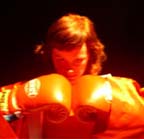
Year of Japan
As part of its "Year of Japan," Sonar presents Sonarama 2006, featuring two of the brightest stars in the firmament of Japanese electronic culture, Ryoji Ikeda and Toshio Iwai. “Datamatics”, the new audiovisual project by Ikeda, and TENORI-ON, a digital musical instrument created by Iwai for the XXIst century, constitute a unique opportunity to assess the future of the new media in relation to advanced music. Along with this event, increasingly popular participatory communities such as Freesound, FlxER or Digitalmusician.net, as well as open-source creative platforms such as Arduino, Supercollider or Blender will also play a prominent role. And all of this without sacrificing a selection of the most innovative proposals taking place within our borders, as represented by AÄB, Arbol + Obionlab, La Màquina de Turing, Raw and Earth, Wind and Firewire.
Sonarama focuses on the latest developments in new media. Among this year’s activities will be the usual concerts, installations, and technology demonstrations as well as medialabs and software presentations. For a few years now, Sonarama’s has been held at the Centre d´Art Santa Mónica, the setting for the programmed activities of Sonar by Day. Centre D'art Santa Mònica (Rambla de Santa Mònica, 7) >From 12:00 to 22:00. 15, 16 and 17 June. [Related]
Posted by jo at 10:43 AM | Comments (0)
Australian Network for Art & Technology (ANAT)

Call for Public Wireless Proposals
The Australian Network for Art & Technology (ANAT) has been commissioned by the Adelaide City Council to investigate creative ways to make use of wireless technology in public spaces. An opportunity exists to develop a project with an emphasis on interactive and engaging uses of wireless technology. ANAT is now seeking brief project proposals from artists of all disciplines as individuals or collaborations. ANAT is particularly interested in projects that provide opportunities for direct interaction with the audience, and encourage exploration and discovery of public space. Applications close Friday 26th May 2006.
Submissions will be assessed competitively with three short listed proposals to be awarded a fee of $200 each. In consultation with the artist(s), one proposal will form the basis of an application to fund the development and presentation of a project. Unsuccessful proposals will be returned to the artist(s).
Please email tamara[at]anat.org.au to receive an Artist’s Brief with more details. Proposals must be submitted by Friday 26th May.
For examples of recent wireless projects and general wireless information please see links at: http://anat-thinktank.blogspot.com/
ANAT Project Officer Tamara Baillie tel • (08) 8231 9037 • email: tamara at anat.org.au
Australian Network for Art and Technology (ANAT)
PO Box 8029
Station Arcade South Australia 5000
ph: 61 8 8113 3105; fax: 61 8 8231 9766
http://www.anat.org.au/
tamara[at]anat.org.au
ANAT is assisted by the Australian Government through the Australia Council its arts funding and advisory body, by the South Australian Government through Arts SA and the Visual Arts Strategy, an initiative of the Australian, State and Territory Governments.
Posted by jo at 10:32 AM | Comments (0)
BIOS: The Poetics of Life in Digital Media
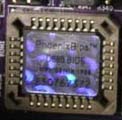
Proposals are Welcome
BIOS: The Poetics of Life in Digital Media, hosted by the Center for Literary Computing at West Virginia University in Morgantown, WV. September 14-16, 2006.
BIOS: The Poetics of Life in Digital Media is an interdisciplinary symposium on the re-invention of life in digital media. The term BIOS captures capture boundary-crossing and hybridization of human and machine. For the ancient Greeks, BIOS referred to particular forms of life rather than life in general (zoe). BIOS therefore, was the form of life specific to the development of human society and political culture. Understanding BIOS means understanding how humans adapt nature into culture. In computer science, by contrast, BIOS means something quite different: the basic input output system, the lowest level of code that allows a computer to run. BIOS is burnt into computer hardware and enables the machine to boot and run software programs and media. The two meanings of BIOS resonate with each other as basic requirements for a social system, whether in civic space or in cyberspace.
BIOS will combine talks and creative work / performances. We already plan a rich and exciting schedule. Proposals are welcome on any area within the topic. Keywords/subtopics include but are not limited to: electronic literature; hypertext; embodiment; media specific analysis; net.art; digital performance; complexity and emergence; the limits of computability; posthumanism and cyborgs; virtual reality; artificial life; biotechnology; cyberfeminism; biopower; social software; ... Innovative formats and approaches are welcome. We will also consider remote/tele-presentations. Webcasts/podcasts of the event and an DVD archive will be available.
Send proposals of no longer than 200 words to clc[at]mail.wvu.edu by July 1, 2006.
BIOS is organized and hosted by the Center for Literary Computing, and co-organized by the Electronic Poetry Center / Digital Media Studies program at SUNY-Buffalo. The symposium is associated with the E-Poetry series of festivals and symposia.
Posted by jo at 10:14 AM | Comments (0)
Sounds of the City

Call for Radio Art
Sounds of the City: Call for Radio Art: Deadline 19 may 2006; organizer: Radio Cult and InterSpace Media Art Center in the frame of Radio Territories and Mobile Studios. Radio Cult is looking for soundart/radioart works that:
- will be of experimental character
- will include sound recording of the city
- will be shaped in sound art radio art form
- will answer to the following technical and thematic requests
Sounds of the city is an open call for participation to Radio Cult contest about radio art/sound art production that will include sound recording of the city Sofia. All artists, sound artists, radio artists, producers… are invited to create 15 to 30 min piece based on sounds of the city. All that should be produced in form of short radio art program. In the production must be included field recordings, sound scapes and various recordings of the sound of the city.
Theme: cityscapes or sound of the city
Based on the subjects: city and sound
Works should be related to topics about urbanity, city and ways of looking on the city. They should provoke question like:
how do you look at the city?
what’s the sound of the city?
how can we transmit a location through sound?
and at once give answer to questions like:
why did you chose that location?
why do we think it is represent of urbanity?
what are the perspectives that we can see the city from...
Sounds of the city contest is organized in the framework of radio Territories project. The selected radio pieces will be presented during Mobile Studios visit in Sofia 21.-28. 05. 2006 and will be part of the broadcast on the same occasion.
There will be 5 prizes for 5 best works. Works will be selected and judged by jury consisted of Radio Cult team.
Winners of the contest will also get chance to produce 30 min program for next round of trans European radio network RADIA.fm broadcasting as participant of radio cult and presentation of his work on more than 10 European radio stations interested in radio art.
In the framework of the Mobile Studios event, Radio Cult will broadcast produced pieces together with other pieces produced on Radio Masters workshops held by Radio Cult in May.
Prizes:
1st prize: 200 leva
2nd prize: 100 leva
3rd prize: 80 leva
4th prize: 60 leva
5th prize: 40 leva
The submission should be uploaded on server and link should be posted vie email for download. Submission format should be mp3 that will not exceed maximum size od 20MB. Exceptions possible on request. The authors/artists keep all rights on their submitted works. Deadline for sending 19 may 2006.
Submitting email should include following info:
1. name of artist, email address, URL
2. short biography/CV
3. link for download of the work in mp3 format
4. short description of the work and how it is related to the topic
Send the complete submission to: radio[at]i-space.org
related links:
http://radio.cult.bg
http://i-space.org
http://radia.fm
http://mobile-studios.org
Posted by jo at 09:58 AM | Comments (0)
Media Art Friesland Festival 2006

Call for Participation
The Media Art Friesland Festival 2006 is the 10th edition of the festival. This anniversary will be celebrated with a special and large programme with a lot of international guests. Recent work from all over the world will be shown in film and video screenings, presentations, exhibitions, conferences and performances.
Do you want to participate in the 10th edition of the festival? Media Art Friesland asks all artists and students to send in their work; video, film, cd-rom and internet projects, installations and performances.
The deadline is June the 1st, 2006. Check the entry form for terms and the procedure.
Posted by jo at 09:17 AM | Comments (0)
May 11, 2006
New Media at the ICA

Body, Space and Cinema
In London's ICA, Body, Space and Cinema, an exhibition featuring selected works by artist Scott Snibbe will open this weekend.
- Theatre and Bar - Scott Snibbe will be showing three interactive installations, including large-scale body-centric physical installations, Outward Mosaic, premiering at the ICA and Visceral Cinema: Chien, to the interactive sculpture, Blow Up, first shown at Ars Electronica in 2005. Known around the world for his beautiful, simple and yet brilliant pieces that engage with visitors of all ages. For inspiration or sheer enjoyment this is an exhibition that's not to be missed.
Sat 13 May - Sun 28 May 2006. 12noon - 7.30pm daily
- Digital Studio - Combining intelligent computer programming with a playful ideas and a philosophical approach to the world we live in his work is simple and yet very engaging. Scott's work includes, emergent behavioural patterns of ants in Myrmegraph, a means of drawing with stars in Gavilux and the simple physical but chaotic system of a pendulum swing in Tripolar. This sample from the breadth of his work, gives an insight into his practice and demonstrates his profound influence on other artists working in this medium.
Fri 12 May - Wed 31 May 2006. 12noon - 7.30pm
Artist's Talk on Saturday 13th May - 3pm As part of his first UK exhibition, Scott will present recent works that explore interaction between cinematic projections and viewers' bodies along with his most recent work, Blow Up, which amplifies human breath as a large field of wind. He will discuss the philosophical divide between language and visceral perception that motivates his creation of interactive media art. There will be time for questions after the talk.
Posted by luis at 12:10 PM | Comments (0)
MASSIVE KNIT @ Washington Square Park
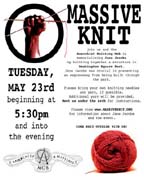
Honoring Jane Jacobs
MASSIVE KNIT: A Knitting Mob Dedicated to the Memory of Jane Jacobs: Tuesday, May 23rd 5:30pm in Washington Square Park, NYC.
"To use parks and squares and public buildings as part of this street fabric; use them to intensify and knit together the fabric's complexity and multiple use." From "The Death and Life of Great American Cities" by Jane Jacobs
EVENT We would like to provide a collective, connected, community of individuals to honor the late Jane Jacobs who passed away on April 25, 2006. Jane Jacobs was an activist, a community leader, a writer, an urban planner, and a hero to many people. One of her great feats was as the chairman of the Joint Committee to Stop the Lower Manhattan Expressway. This expressway would have run through Washington Square Park. We plan to gather in this park on the 23rd of May to memorialize her and her ideas. We want to convene as a community in a loving and subtle way, honoring the park as well as her memory. We plan to do this by knitting the park together.
Knitting is a solitary art form, often resulting in gifts for others. A knitting circle allows one to be social with this solitary art. A city, likewise, is a solitary place to live. There is so much crowding and destination in daily life that one often gets lost in their own world. Parks allow people to come together and be alone peacefully in their solitary life and form temporary and permanent communities. Parks and knitting circles are both public and accessible: but private enough that one can have meaningful communication and a community within their confines.
Using individual sensibilities, we plan to create an open structure in the park. Connecting various elements of the park together such as trees, benches and other structures, we will connect a community and a memory. As people enter the park (the meeting spot is under the arch) they will be directed to a spot in the park to start knitting. People can arrive anytime starting at 5.30 p.m. and stay as long as they like. They should tie, knit, string together long thin pieces of material, and before leaving, tie the material off to a piece of the park, or another individual yarn. By the end of the evening we should have a string of material connecting the park together. We will have connected to the park and to the other individuals as a community.
Posted by jo at 09:54 AM | Comments (0)
PHYSICAL PROCESSING
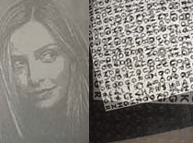
LEGO Flockhart + BINARY Elliot
"Eric Harshbarger is serious. About LEGO. He does “Professional LEGO Sculpting and Mosaic Building”, with some serious building credits to his name. He also has an obvious obsessive streak, most likely a prerequisite for any dedicated LEGO builder.
Harshbarger’s LEGO mosaic of Calista Flockhart uses a quarter million LEGO bricks of the diminutive Modulex variety with letters. Using time-honored ASCII graphic techniques, he was able to turn his multiple bags of bricks into a physical ASCII mosaic, using different letters to create shades of gray. Modulex turns out to be a LEGO curiosity, as Harshbarger explains:
One has to admire the sheer tenacity of anyone willing to assemble an ASCII mosaic out of bricks so small they can barely be handled without special tools. But ultimately the question should be asked: Why Calista Flockhart? Why a photograph? The representational approach seems a waste of (a lot of) good bricks. more... [blogged by marius watz on generatorX]
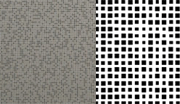
The Waste Land--by Sai Sriskandarajah--is the product of a program that encodes text as binary and represents the resulting code visually. Each of the thousands of little squares in the images represents a 1 or a 0 -- smaller squares are 0s, bigger squares are 1s; every five squares represents a character of the alphabet. Through this simple system, one of the masterpieces of Western literature is both reduced and expanded, its meaning shifted as it moves from the realm of symbolic interpretation into the realm of visual absorption. The image not only allows the viewer to experience a familiar work in a new context, but also demands that she explore the connection between the text and the image, and the way that meaning is conveyed both symbolically and visually.
The text-encoding program itself is extremely flexible. The coding system remains constant, but both the source text and the manner of visual representation can be easily modified. The letter T, for example, is always encoded as 10011; however, these 1s and 0s can be displayed as black and/or white squares, squares of varying sizes, fields of color, or using any other visual system that allows for organization and differentiation. At the moment, the program generates rectangular images that are long and narrow (the exact size being determined by the length of the source text), which are printed on rolls of paper like ticker tape. However, the output can easily be switched to a more traditional landscape or portrait aspect ratio and printed as a large-format poster.
The program was written in Processing. Images are exported as .ai files with the Adobe Illustrator Export Library and printed manually on a large format printer. [via WRT]
Posted by jo at 09:19 AM | Comments (0)
Julius Popp
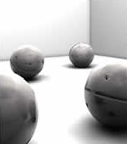
Micro.Spheres
Micro.Spheres by Julius Popp takes place in a room, containing around 16 autonomously acting robots, which visitors are allowed to enter and experience. The robots act according to a dogmatic command that drives them to perpetually place themselves in the spatial centre of their immediate environment.
What results is a chain reaction which seems highly complex but can be easily explained as it is simply a result of each robot having an effect on its neighbour, all the way to the borders of the room. This process necessarily has to affect all elements of the system. The system remains active as long as the visitors continue to move. When the visitor remains still the system is able to find a new stable pattern. When there is more than one visitor within the system, the complexity of the shapes and processes increases. Micro.spheres reflects on the complex interrelations that exist between ‘living’ bodies and their environment. In particular, it addresses the changing social structures of our present day and age. [blogged by Ruairi on Interactive Architecture dot org]
Posted by jo at 08:21 AM | Comments (0)
CALL FOR PROPOSALS: "TRANSPOSITION"
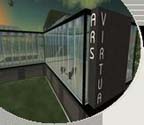
Second Life as Temporary Canvas
In this age of increasing data collection, storage, and management, it becomes necessary to create new visual forms for the representation of such information. Second Life provides an atmosphere in which the environment acts as a canvas for temporal representations of data, not only presented to the user but interacted with, and experienced on a different level of immersion than more traditional displays. The management of tools, data, and environments requires the inception of these interfaces.
Ars Virtua is seeking computational information design projects unique in nature to the environment Second Life provides. Pieces should contain unique techniques and methods in presenting information design, interaction design, communication design, and/or data visualization. Projects that extend their abilities to interactivity within the virtual reality environment are highly encouraged to apply.
Proposals should include:
Name and contact information
Description of the project
Screenshot if available
DEADLINE TO SUBMIT: May 19th, 2006.
please email transposition[at]arsvirtua.com for more information [Related 1, 2, 3, 4, 5, 6]
Posted by jo at 08:04 AM | Comments (0)
Digital Art and Electronic Music Festival

Dissonanze in Rome
Dissonanze is the electronic music and digital art festival of Rome. Since the year 2000, Dissonanze experiments and entertains exploring the relationship between creativity and technology, researching the unusual connections between sight and sound, between lights, rythm, color, noise, silence and the architecture of its magnificent locations. As well as famous artists and successful art works, the festival presents emerging artists, previews, original collaborations and site specific productions commissioned by Dissonanze for the different and unusual spaces that host the event.
"This is our visual music!" is the claim for this edition. Musique concrete and dance music, ambient and noise, techno and electro, 16mm film and neon lights, video and laser… Dissonanze 6 game is to stimulate an encounter of differences, extremes and opposites and let them explode in a flow of "visual music" that warps the normal dimension of a club, a concert room or a gallery, changing the art itself and the architectural structure of its location with 'total' shows that distort the normal dimensions of perception: from the spectacular United Visual Artists lights design and the techno and electro icons sets, to the project curated by eclectic Edwin van der Heide dedicated to the more experimental artists, passing through the selection of hypnotic audio-visuals ideated in collaboration with Digicult. "This is our visual music!"
Dissonanze: 19 - 20 may 2006; Roma Palazzo dei Congressi.
LIVE AND DJ SET:
Sven Väth (Ger), Dave Clarke (UK), Mathew Jonson (Can), Audion aka Matthew Dear (USA), Joris Voorn (NL), Tony Rohr (USA), Pigna People (Ita), Lory D (Ita), Motor (Fra/USA), T.Raumschmiere (Ger), Dj Koze (Ger), Sleeparchive (Ger), Claudio De Tommasi (Ita), Raffaele Costantino (Ita)
light show United Visual Artists (UK)
Yasunao Tone (JP), Maryanne Amacher USA), Francisco Lopez (Spa), Zbigniew Karkowski (Pol), Daniel Menche (USA), Jens Brand (Ger), Carl Michael von Hausswolff (Sve), Olivia Block (USA), M16 (It), tinylittleElements (Aus), Richard Devine (USA), Cristian Vogel (UK) visuals Atsuko Nojiri (JP), Effekt (Dan), Philipp Geist (Ger)
LIVE SET
Otolab (Ita), Bruce Mc Clure (USA)…
AUDIOVIDEO EXHIBITION
Argos, Jeffers Egan, Karl Kliem, Meta, Montevideo, Purform, Ryoichi Kurokawa, Semiconductor, Steve Roden, Stefano Iraci, Stephen Vitello, Tez …
Posted by luis at 06:17 AM | Comments (0)
May 10, 2006
Cybersonica 06 Opens!
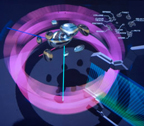
New Interactive Interfaces
"My reason for irregular postings on Pixelsumo has been due to curating and coordinating the Cybersonica 06 Sonic Art exhibition. After a huge amount of work by the team, I can now happily say that the exhibition is now open and we have 12 truly great pieces installed in the gallery space. I highly recommend you get to London to check it out. Full documentation of all the work will be posted online, but I don’t want to ruin any surprises for now.
We have commissioned 5 new works, plus showing many existing works. The works have been selected for their exciting approaches to creative interactivity. They move beyond the ‘screen, keyboard, mouse scenario’ and respond to physical input, proximity, sound, kinetics, elapsed time and the surrounding environment.
Dates: Monday 8th - Saturday 20th May; Location: Phonica Records / Vinyl Factory, Soho London; map & opening hours. Preview video 1 - Preview video 2; Behind the scenes photos; List of artist & works." [blogged by chris on Pixelsumo]
Posted by jo at 01:10 PM | Comments (0)
a network of books
![]()
Connections + Actor-Network Theory
This is the "cover" (it's an email mag) of the latest issue of artkrush. Part of a 2004 installation by Moroccan artist Mounir Fatmi called "The Connections."
Connections is the outcome of a reflection which began in the early Nineties, at the time of the war in the Gulf.... At that time, the operations Desert Storm and Desert Fox, preceding the last operation which could be named "Desert, full stop", established the era of a media oriented war, therefore a war of image, on the very spot of the Revelation, that of the three sacred books, a historic place dedicated to communication. They clearly showed the lack of means of communication and even the lack of communication power of the Arab countries as well as the resurgent fear of technology.
In our calendar, that of Hegira, we are today in 1420, eternally nomads. Our roots are clearly set in the future, as the Arab poet Adonis wrote it. For me, it is an attempt to enter this desert, this collective memory, to remove sand from objects which may lose their identity through the changing of material but will still keep their memory.
A recent comment from Adam Greenfield, author of the just-published "Everyware: The Dawning Age of Ubiquitous Computing," seems apropos:
I've become all but unable to think of the objects around me except in terms of Actor-Network theory, as sort of depositions or instantiations of a great deal of matter, energy and information moving through the world. And of course, a book is nothing but a snapshot in that regard; you have to do a lot of extra work if you want to prise out and examine the flows it is a part of, or even those it has set up. [posted by ben vershbow on Future of the Book]
Posted by jo at 12:38 PM | Comments (0)
ARTNODES
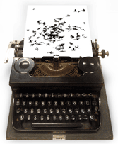
NEW VIDEO-INTERVIEWS
Roger Malina, Michael Naimark, Gerfried Stocker, Amy Alexander, Lab_au y Christa Sommerer y Laurent Mignonneau--This month we have published a new series of video-interviews in Artnodes with various international experts revising the last digital art and electronic art period, analysing its development until now, where is it coming from and where is it focusing on.
This wide cross section of experts gives us the opportunity for a different points of view analyze. We count on the intervention of Roger Malina, Director of Leonardo, telling us about international networks in Internet, and also about the creation and development of Leonardo as part of them; Gerfried Stocker, Director of Ars Electronica and Digital Artist, who points up the importance on offering a digital art history revision in order to analyze its development; Michael Naimark, Digital Artist with more than 25 years of art experience, he has been a witness to very crucial moments in the development of new media; Christa Sommerer y Laurent Mignonneau, Digital Artists, with them we looked through the relation between art, new technologies and nature; Manuel Abendroth y Els Vermang, members of Lab_au, Laboratory of architecture and urbanism, with special interest in language and new terminologies in the new media; and Amy Alexander, one of the pioneer artist of net art, is telling us about the context within she made her first art works in internet and its development until now.
Posted by jo at 11:57 AM | Comments (0)
Mobicapping: Mobile Image Capture in the New Century
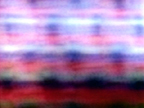
Call for Work
The curators Scott F. Hall and E. Brady Robinson of Mobicapping invite submissions for possible inclusion in their upcoming international juried online art exhibition,"Mobicapping: Mobile Image Capture in the New Century."
Definition: mobicapping is the new creative and technological practice borne of the instant capture and immediate international distribution potential of images, movies, and sounds via cell phones and other portable electronic devices.
Mobicappers may submit their mobicapps by May 15, 2006 to contact at mobicapping.com as email attachments. Submit either A) five still images (600 pixels longest side, max 250 kb per image) or B) two .MOV silent or sound movies (320 pixels longest side, max 500 kb per movie) or C) two MP3 sound files (max size 500 kb per file). Include artist name, email, location, and an artist statement / bio (max 150 words). No fees. Submission deadline: 05-15-2006. Exhibition opens: 08-15-2006.
MOBICAPPING: A PREMISE
Today, we record temporal moments with our cell phones and other small mobile devices which exist now and which are incessantly soon to be invented. The cell phone and its like, however do not elicit familial bonding as it has been in the past with the snapshot. There has been a marked cultural shift; our moments are more empty, more banal. Yet, paradoxically, we find ourselves and our experiences so much more interwoven--so much more widely shared--today than in any age prior. Such moments can now be found throughout the Internet. Instead of having a shell life in a shoebox stowed away in the family closet, our images and moments quickly move between emails, websites and even podcasts. But, where is all the art in this instantly local, regional, national, and international sharing? And, what do we call it?
We feel that this new form of image sharing in the 21st century is best described with a new term: mobicapping. Mobicapping means: mobile image capture (still, moving, and/or with sound). Those who participate in mobicapping--virtually all of us--are no longer photographers but are more accurately to be called mobicappers. Together, we are sending out a call for experimentation and exploration of the potential of the art of the mobicapper. The exhibition that we propose here will feature artists who are investigating this completely new creative and technological practice. "Mobicapping: Mobile Image Capture in the New Century" will open in August, 2006.
--E. Brady Robinson & Scott F. Hall
Posted by jo at 11:42 AM | Comments (0)
Blind Love
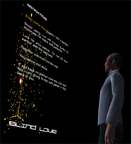
Extensions via Virtual World of Art
In Blind Love (click on Art), two visitors must find each other before they can find the way out of a pitch-black labyrinth. Each is armed with a weapon that shoots luminous particles. The particles explode on the walls and cascade into the corners, revealing the skeletal outline of the labyrinth's architecture. The two visitors must use the light emitted by their weapons to find one another, but-in an inversion of normal game logic-must not hit and kill each other if they hope to win. Like lovers, the visitors must blindly trust each other in order to survive, and must approach one another despite the danger.
Blind Love is one of the art works created for EXTENSION (click on Virtual World of Art, Extensions/SAT), a virtual architectural intervention that explores the potential of digital architecture to reveal and transform urban, cultural, and spatial identities. EXTENSION was created for the SAT in Montreal, one of North America's leading centres for new media. Visitors entering EXTENSION through the SAT terminals find themselves in a virtual space that mirrors their actual physical surroundings.

As they move through the environment, they cross from reality into virtuality, and from simulation into representation. Within the virtual environment, the existing building of the SAT has been recreated as a realistic 3D model. This simulation is transformed and reconfigured with the addition of a vast, zeppelin-shaped structure affixed to the roof. From inside this glass-encased space, visitors have a panoramic view of a virtual Montreal, where the city itself has been reconstructed with a poetic blend of realism and utopian fiction. Visitors to this near-real space discover experimental artworks in the halls and rooms of the virtual environment, and layered in other dimensions accessible through portals that brings the viewer into dedicated art installations. Anchoring virtual experience in real space, EXTENSION blurs the boundaries between imagination and perception. Grounded in the real but not limited to the realistic, EXTENSION is a reflection of the concepts and visions each of us forms about spaces and places.
EXTENSION is one of three nodes of the Virtual World of Art.

As technologically mediated experiences the Internet, games, cinema, television occupy ever more of our time and energy, it becomes increasingly vital that we create alternative spaces and environments for experience within these borderless territories of information and communication. Virtual World of Art invokes, manipulates and transforms the vocabulary and logic of game culture to create artistic engaging spaces which awaken aesthetic, emotional, social and intellectual responses radically different from those engendered by contemporary mass media. The project explores a variety of significant problems that cultural institutions committed to artistic practice within a networked electronic environment continue to face: how to create esthetically compelling and emotional online experiences, how to link physical and data spaces together, and how to effectively enable human communication and exchange in a physical space where local and remote visitors and performers can communicate virtually through technologies and computer interfaces.
Virtual World of Art investigates the artistic possibilities of immersive game technology and proposes new models for experiencing architectural and public spaces, sociability, and cultural production. Grounded in reality but not limited to realism, Virtual World of Art forms a dynamic, socially relevant, independent alternative to the existing art world, enabling artist to emancipate and develop a critical view of the future and meaning of contemporary art.
Virtual World of Art is the title for a series of new media art projects which subvert and reconfigure multi player game technology to create a network of artistic virtual environments. Each of these virtual environments called nodes, containing digital artworks and virtual art installations, is associated both conceptually and thematically with a specific site, arts centre or a public event where the project is presented on a long-term basis. These virtual environments are connected together by the internet forming a new kind of enlarged social and experiential public space for artistic expression and social exchange.
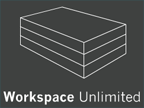
VWA will connect at least 3 locations or nodes in order to function as a complete project. Each node explores a different notion of hybrid between physical and virtual public space. Visitors will be able to interact through terminals installed at the nodes or at any public space in the world that has a high-speed internet connection.
Virtual World of Art is a project of Workspace Unlimited.
Posted by jo at 10:57 AM | Comments (0)
Device Art Brings Technology to Life
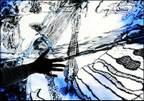
You Don't Try to Hide it
"...The works of art along the Japanese aisle at the International Conference on Virtual Reality in Laval, western France this weekend are not the sort you find protected behind glass. On the contrary, it is up to the spectator to bring them to life. "Please touch", the signs read. "Virtual reality opens up a whole new space, where the work of art becomes dynamic", where "the artist is no longer unique", explains Alain Grumbach, a virtual reality specialist who teaches computer science at the national school of telecommunications in Paris. Spectators "derive emotion from the images, but also from the possibility they have of changing the course of those images," Grumbach notes.
The effect is almost magical. It is an odd sensation, dipping a wooden spoon into an empty bowl and watching it splash around in clear water on the adjacent screen ("Wet-Free Water" by the Nara institute of science and technology, Japan).
It is a funny feeling, pushing a box of tea across a table and feeling a team of tiny virtual imps resisting it with all their might, but visible only through a little wooden window -- as in "Kobito Virtual Brownies" by the Tokyo Institute of Technology.
A little further on, Norimichi Idehara, associate professor of information sciences at Tokyo's Tama university, is fretting over his virtual planet, an ecosystem under a globe, whose "creatures are near to extinction", despite the public's efforts to generate rain by touching the globe.
"It's magical but people know it's a technology", says Machiko Kusahara of the School of Letters, Arts and Sciences at Waseda University in Tokyo. "You don't try to hide it".
"Device art", the latest craze in Japan at the moment, "is often gadget-like", Kusahara continues, "but with carefully designed artistic intention. Artists produce commercial products for available in daily life... [they] try to reach the widest possible audience."
Japanese culture does not draw a firm distinction between noble, "fine art" and "low art", Kusahara explains. Device art reflects the importance of aesthetics in daily life, or "beauty in the tools".
The virtual bowl of water is appealing simply as an image, and the clear sound of flowing and splashing is pretty. Yet neither the camera that films your real-world movement, nor the computer that works out how the virtual water should move, are hidden. The object is a piece of technological virtuosity.
The little tea-box imps are actually already available in the shops. "Imagine life with Kobito", their Internet advertisement says (rogiken.org/vr). "It will give you comfort when you are in trouble".
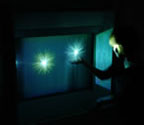
At the end of the Japanese aisle Hideaki Ogawa's installation, "Perfect Time", is of a more philosophical bent. A thin screen veil of golden grains flows out of its "hourglass", onto which images are projected. It is up to the audience to put sand in the "hourglass". If they do not, then they cannot see the images. Our perception of time is thus suspended. The virtual exists only when there is interaction between person and object." From Yahoo News.
Posted by jo at 10:29 AM | Comments (0)
sonambiente berlin 2006
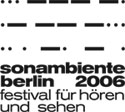
sound art festival in june
Making the city itself a work of sound art — sonambiente berlin 2006 - the festival for hearing and seeing is accompanying the events round the Football World Cup for six weeks, from June 1st to July 16th. For the second time since 1996, the Berlin sound art festival offers a platform to acoustic art of all colours and stripes — visual art, sound art, performance, video art, media art and music. Also the festival looks into the increasing significance of sound in visual art, staging the interplay between visual artists and sound artists at some dozen different locations.
Highlights of the sonambiente berlin 2006 opening weekend, June 1st to 5th, include a site-specific sound and light installation at the Potsdamer Platz metro station by the Austrian artists group [dy’na:mo] and the performance by the freq_out orchestra with the Swedish artist Carl Michael von Hausswolff. Plus, the sonambiente_exhibition, which stands at the centre of the six-week festival, opens its doors to works by some 75 internationally known artists such as Candice Breitz, Janet Cardiff/Georg Bures Miller, Terry Fox, Christina Kubisch, Bernhard Leitner, Aernout Mik, Helen Mirra, Carsten Nicolai, Finnbogi Pétursson and Pipilotti Rist with Gudrun Gut.
Live performances, concerts, conversations with artists, and a film series round out the programme of the exhibition, which can be seen and heard at five central locations, for example both Akademie der Künste buildings, throughout the festival. First-time venues include the Pumpwerk in Holzmarktstraße (Radialsystem V) with its spectacular smokestack and the former Polish Embassy on Unter den Linden. Many works focus on the unusual spatial conditions at the different locations; they relate directly to Berlin and document the city's evolving structure. Alongside established artists, sonambiente berlin 2006 integrates a number of international art colleges and universities by introducing the works of their outstanding students and graduates at the sonambiente_laboratorium.
An additional focus of sonambiente berlin 2006 is the double pass between art and football. Several artists, Tilman Küntzel, Alfred Behrens and others, are setting up special projects round sound, art and football. Also the festival extends an open invitation to follow the World Cup live, inside the artistic framework of the sonambiente_public viewing sound art lounge designed by sound artist Kalle Laar, from June 9th to July 9th at the Haus der Berliner Festspiele.
Projects developed specifically for radio and the Internet are also part of sonambiente berlin 2006. Nicaraguan-born New Yorker Ricardo Miranda Zuñiga intervenes in Berlin's public space. The artist, who received an award at Ars Electronica Linz 2004, is converting a shopping cart into a mobile radio station. Belgian artist and filmmaker Ana Torfs, who also took part in sonambiente 1996, contributes a net art project about Hanns Eisler's "Hollywood-Songbook“, created in collaboration with the Dia Art Foundation in New York, on the sonambiente website www.sonambiente.net, for example.
sonambiente berlin 2006 is presented by the Berliner Festspiele and the Akademie der Künste. The festival is initiated and curated by Georg Weckwerth (free-lance artist and curator) and Matthias Osterwold (Artistic Director of MaerzMusik – Festival of Contemporary Music in the Berlin Festivals). The festival is sponsored by the Capital Cultural Fund and supported by the Allianz Cultural Foundation.
June 1st to July 16th 2006
Opening: June 1st 2006, 6 p.m. at Akademie der Künste, Pariser Platz (opening of the exhibition and bus shuttle for further festival-locations)
Posted by jo at 09:06 AM | Comments (0)
ArtSFest 2006
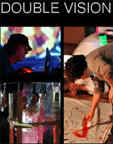
Evolutionary Patterns and the Lonely Owl (Mutation #2)
When: May 26-27 [Fri-Sat] 8:30-11:00pm [Ongoing]
Where: CELLspace, 2050 Bryant Street, San Francisco
Cost: $12 [$8 with ArtSFest Arts Action Pass] BUY TIX ONLINE NOW!
Intermedia performance group DOUBLE VISION will be presenting a large-scale event including simultaneous acts of dance, music, video, art and technology as part of the ArtSFest 2006. The event, entitled Evolutionary Patterns and the Lonely Owl, is part of a series during which the audience roams freely, exploring inflatable projections, mirrored matrices, pulsating pods, and radioactive sonic-works.
Throughout the night, curious onlookers may dine with a family of PAlien sculptures who transmit telepathic communications throughout the venue. The fearful may look above to spot a teleo-operated spy blimp or gaze at an inflatable orchestra of hypnotic video automata. The adventurous can get personal with dancers wielding magic lassos, human-hybrid mud totems, or Pierre's cries for help.
DOUBLE VISION, led by Sean Clute and Pauline Jennings, is group of performers, musicians, dancers and video-artists. By experimenting with different methods of collaboration through the adaptation of social systems, transvergence of scientific models, and mapping of algorithmic structures, DOUBLE VISION unifies multifaceted art forms and ideas.
DOUBLE VISION's artists strike a balance between unity, complexity, chaos and ritual. The collective ingenuity includes constructions by Steven Baudonnet, Matt Bell, Liz Bootz, Sean Clute, Amanda Crawford, Brian Enright, Simran Gleason, Jammin' Ammon, Ron Goldin, Jessica Gomula, Dave Holton, Pauline Jennings, Jason B. Jones, Elisabeth Kohnke, Chris Kruzic, Amy Leonards, Michelle K. Lynch, Wendy Marinacchio, Amy Nielson, Cecelia Peterson, Tim Thompson, Bill Wolter, Nicole Zvarik.
Posted by jo at 08:37 AM | Comments (0)
May 09, 2006
Practical Performances In The Wilderness
![]()
Parts I and II Now On DVblog.org
6 Chapters from the database DVD A Series of Practical Performances In The Wilderness - Summer 2005 are now up on DVBlog.org including "Digging for Chicory," "Doable," and "Home Economics."
A Series of Practical Performances In The Wilderness, Summer 2005 is a video performance work made in the woods and on rural back-lots. Performative chapters on the DVD include, Move This Rock, Waiting On Bob, DoAble, Home Economics, Sticks Like Snakes, Digging for Chicory, and Springwater Finale. This video is the first in a series of forthcoming performance-art videos by Peppermint & Nadir which engage issues, ideas, and mythologies of the American concepts of wilderness, space, the frontier, and humans’ ethical relation to animals, forestlands, and nature. View Chapters 1, 2, and 3; Chapters 4, 5, and 6 are here.
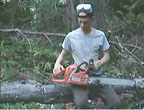
This project is part of Cary Peppermint and Christine Nadir’s series of performance-art videos begun in 2002. Peppermint is an artist who works with new media technologies to create networked environments incorporating the internet, physical installations, experimental music and sound, and live performance. Until recently, Cary directed the Digital Art and Design program of Hartwick College, and in Fall 2006 he will assume the digital media position at Colgate University's Department of Art and Art History. Christine Nadir teaches literature at State University of New York College at Oneonta and is a doctoral candidate at Columbia University where she is completing her dissertation. Its working title is “The Future of the World: Sacrifice, Economy, and Ethics in Environmental Literature and Ecocriticism.”
Christine feels that these videos capture some of the energy, activities, and thoughts that she and Cary have experienced as New Yorkers living in the wilderness for four months every year: trying to establish a functional home without running water, electricity, or maintained roads; developing relationships with locals; un-learning the romanticization of nature while re-learning humanity’s dependence on the environment for survival; and researching the details of the history of the land and the surrounding area (its previous deforestation, its logging, its near use for an auto salvage yard, its use as farmland and grazing ground one hundred years ago, the precolonial possession by Native Americans for centuries before that).
Cary says: The North American concepts of wilderness are informed by nationalist ideologies and concepts of freedom as a wild, un-checked frontier of possibility. I don’t believe there is any such thing as wilderness as we Americans are inclined to see it. How could one know or understand that which is truly wild much less employ it toward nation-building? Also, I find a certain intellectual humor in the offering of performances that purport to be both practical and wild.
Posted by jo at 12:48 PM | Comments (0)
We Feel Fine + Lovelines
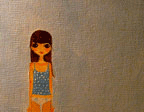
Explorations of Emotions and Desires
Since August 2005, We Feel Fine, An Exploration of Human Emotion, in Six Movements, has been harvesting human feelings from a large number of weblogs. Every few minutes, the system searches the world's newly posted blog entries for occurrences of the phrases "I feel" and "I am feeling". When it finds such a phrase, it records the full sentence, up to the period, and identifies the "feeling" expressed in that sentence (e.g. sad, happy, depressed, etc.). Because blogs are structured in largely standard ways, the age, gender, and geographical location of the author can often be extracted and saved along with the sentence, as can the local weather conditions at the time the sentence was written. All of this information is saved.
The result is a database of several million human feelings, increasing by 15,000 - 20,000 new feelings per day...At its core, We Feel Fine--by Jonathan Harris & Sepandar Kamvar--is an artwork authored by everyone. It will grow and change as we grow and change, reflecting what's on our blogs, what's in our hearts, what's in our minds. We hope it makes the world seem a little smaller, and we hope it helps people see beauty in the everyday ups and downs of life.
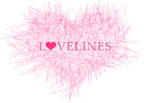
Through large scale blog analysis, Lovelines--also by Jonathan Harris & Sepandar Kamvar-- illuminates the topography of the emotional landscape between love and hate, as experienced by countless normal humans keeping personal online journals.
Using a data collection engine created for We Feel Fine, Lovelines examines thousands of blogs every few minutes to find expressions of love and hate, posted by all manner of people. When it can, Lovelines identifies and saves the age, gender, and geographical location of the person who wrote the post, and then presents that information along with the post. The entries range from frivolous to profound, offering a glimpse into the hearts and minds of people blogging about their wants and needs.
Lovelines presents a stark white screen, bounded on the bottom by a slider running from “Love” to “Hate”, with a draggable heart that becomes scratched out to the point of illegibility as the heart approaches “Hate”. As the slider is pulled through Love, Like, Want, Indifference, Dislike, and Hate, words and pictures appear above to represent the chosen state of desire or despair.
Constructed entirely from found artifacts – words and pictures posted to blogs – Lovelines draws its identity from a world of strangers, brought together by shared degrees of desire.
Posted by jo at 11:35 AM | Comments (0)
[FRAY] Conference
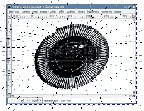
Connectivity and Collaboration
[FRAY] Conference: SATURDAY MAY 13 @ 2 PM; Film, Video & New Media Dept @ The School of the Art Institute of Chicago, Room 1307 in the MacLean Building, 112 S. Michigan Ave., CHI IL .US; FREE.
Join [FRAY] for discussions and presentations on connective and collaborative New Media and Digital Arts with Annette Barbier (UNREAL-ESTATES and Interactive Arts and Media Department Columbia College), Ryan Griffis (The Temporary Travel Office and The School of Art & Design University of Illinois at Champaign Urbana), Mark Hansen (Professor in English Language & Literature, Cinema & Media Studies; University of Chicago), Lynn Marie Kirby (California College of the Arts), Rob Ray (DEADTECH and dorkbot Chicago), Lincoln Schatz (The Upgrade! Chicago) and Daniel Tucker (AREA Chicago).
The [FRAY] Conference consists of the following discussions:
2 PM - 4 PM
Multiplicities
Ryan Griffis (The Temporary Travel Office and The School of Art &
Design University of Illinois at Champaign Urbana)
Rob Ray (DEADTECH and dorkbot Chicago)
Lincoln Schatz (The Upgrade! Chicago)
The Multiplicities discussion focuses on connective + collaborative New Media + Digital Arts praxis in the context of internationalized efforts such as Ryan Griffis' The Temporary Travel Office, Rob Ray's initiation + running of dorkbot Chicago + Lincoln Schatz's development of The Upgrade! Chicago. The Temporary Travel Office, dorkbot Chicago + The Upgrade! Chicago are all effort to organize platforms or networks of New Media + Digital Arts praxis that foreground collaborations, sharing + international connectivities. As platforms, these systems act as connection points or hubs in an emerging + growing network of artistic activities.
4 PM - 6 PM
Connectivities
Annette Barbier (UNREAL-ESTATES and Interactive Arts and Media
Department Columbia College)
Mark Hansen (Professor in English Language & Literature, Cinema &
Media Studies; University of Chicago)
Lynn Marie Kirby (California College of the Arts)
The Connectivities discussion directs our attention to New Media + Digital Arts projects that traverse multiple histories, theories + practices such as Annette Barbier's UNREAL-ESTATES, Mark Hansen's New Philosophy for New Media + Lynn Marie Kirby's Latent Light Excavations. Annette Barbier's collaborative works such as Path of the Dragon are playable New Media experiences that tell poetic + alternative histories of specific places. Mark Hansen's theoretical
work on the multiple connections between + departures from philosophic traditions in New Media art emphasizes lived experiences + embodiment rather than mechanical metaphors for technology. Lynn Marie Kirby's Latent Light Excavations operate out of a poetics of space as well as an interest in digital processing + recording technologies to remember + reconnect to specific locations. Together these projects present varying takes on poetic + philosophic
connections between specific human experiences of New Media.
Then, after the [FRAY] Conference join us for the...
[FRAY] After (Party) Event ++ Performance Inside Out
SATURDAY MAY 13 @ 9 PM - ON
Chicago Art Department
1837 S. Halsted
CHI IL .US
FREE
The Chicago Art Department hosts the [FRAY] After (Party) Event. the [FRAY] After (Party) Event event is co-presented by the Film, Video & New Media and Performance Departments. Students of the Film, Video & New Media and Performance Departments are organizing and curating Performance Inside Out, a program of performance in the context of New Media that will take place @ the Chicago Art Department and online during the After (Party) Event.
// jonCates
# Assistant Professor - Film, Video & New Media
# The School of the Art Institute of Chicago
# http://www.fvnm.info
Posted by jo at 10:15 AM | Comments (0)
Virtual Realism
![]()
A Review of Narrative as Virtual Reality
"...This brings us to the second crucial characteristic of hypertexts: the importance of the reader, who often becomes a player. In most cases, this importance is theorized by means of the concepts of immersion and interactivity. Precisely because of his active involvement, the reader/player loses himself in the computer game he is playing, or in the digital text he is writing with the help of all kinds of computer techniques. According to Marie-Laure Ryan in Narrative as Virtual Reality, this combination of immersion and interaction is not possible with literary texts. Literary texts that force the reader to participate actively - textes scriptibles or ‘writerly’ texts, to use Roland Barthes’ terms - inevitably shatter the effects of realism experienced by the reader; they introduce distance and lead readers to consider literary procedures more closely, which disrupts the immersion.

Ryan relates immersion to the phenomenological approach to reading as a complete conflation of subject (reader) and object (text). She connects interaction with the structuralist approach of the text as a game, a system of rules that induces action. As a combination of immersion and interaction, hypertext would be an object of investigation in which the two traditionally opposed approaches could meet..." From Virtual Realism by Luc Herman and Bart Vervaeck; a review of Marie-Laure Ryan, Narrative as Virtual Reality: Immersion and Interactivity in Literature and Electronic Media, Baltimore, MA: The Johns Hopkins University Press, 2003.
Posted by jo at 10:05 AM | Comments (0)
3rd Beijing International New Media Arts Exhibition and Symposium
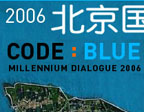
Code : Blue – Confluence of Currents
Code : Blue – Confluence of Currents 3rd Beijing International New Media Arts Exhibition and Symposium--June 30 – July 10 2006; New Media Art Center, China Millennium Art Museum; Beijing Cubic Art Center, Dashanzi Art District (Factory 798) Beijing, CHINA.
The new millennium has witnessed the growing vitality throughout the world of new media art, an art mediated via digital means, often with the internet as its platform. This emerging art, originating from an increasingly technologically dependent society, not only challenges traditional creative media, and ways of thinking, but also posits to artists and cultural workers new questions concerning all realms of contemporary life.
Under the auspices of Millennium Dialogue, the First and Second Beijing International New Media Arts Exhibition and Symposium successfully mounted two ground-breaking exhibitions and symposia in 2004 and 2005 respectively at the China Millennium Museum in Beijing. Enlisting a number of key players in the realm of media art throughout the world as partners, "Millennium Dialogue" aims at establishing a global, constructive platform for dialogue and exchange with the most current discourse in new media arts production and theorization to advance and promote digital arts and education in China.
At the helm of the project are three prominent institutions, with Tsinghua University as host, one of the most acclaimed research and educational institutions of China, joined by ZKM | Center for Art and Media of Karlsruhe, Germany, the World’s largest media arts center, and V2_Institute for the Unstable Media of Rotterdam, the Dutch Electronic Arts Festival maker.
With the repercussion of Millennium Dialogue 2004 and 2005 still undulating, 2006 sees another stellar gathering of the international new media art community in Beijing. The Third Beijing International New Media Arts Exhibition and Symposium, marking the inauguration of the newly established, spectacular Beijing Creative Industries Zone, takes to the Chinese capital another highly charged, thought provoking new media art exhibition revolving on the central theme – Code:Blue, and a symposium which furthers the discourse of new media art practice and education with global perspective.
Theme exhibition and symposium Code:Blue - Confluence of Currents
In the early 1400s, 80 years before Columbus set foot on the Americas, Chinese fleets led by Zheng He, an eunuch admiral, traversed the Indian Ocean reaching the Cape of Good Hope numerous times, establishing peaceful relationships with principalities and kingdoms along their voyage routes, propelling cultural understandings, and precipitating trading activities among many nations. The rise of China in the 21st century as a major economic player in the Pacific region and beyond revives the lost legacy of China as an oceangoing nation, and unveils her creative merchandising spirit. China’s seclusion from the outside world that resulted in an isolated “earth” civilization was but a temporary historical interruption, contrary to the perception that it is the intrinsic nature of Chinese culture.
“Code:Blue” attempts to symbolically establish a relationship between China’s once ocean-minded past and her active engagement and rigorous interaction with current global influences both economically and culturally in an increasingly reciprocal construct, visible in areas such as trade / commerce, migration / mobility, identity / nationality, East / West, South / North and their dichotomies either as librating high tides or as potentially perilous waters. The exhibition and symposium also metaphorically seek the confluence of these multiple cultural and economic currents, and propose Blue as transparency and deepness, flow and volatility, expanse and transcendence. The symposium will examine the increasingly interconnected global flux of information manifested through social and technological networks, reflect on the remapping and reconfiguration of cultural landscapes under the new geopolitical and geo-economic constellation in the 21st century, explore novel ways of artistic intervention in the post-bubble era of the Web2 hype in which a world market consolidates the once discursive, de-centralized net space, and an attention economy replaces the production based economic model, creating new social classes and cultural strata. By re-contextualizing utopian visions and avant-garde propositions that have been the driving force of electronic art and discourse, the symposium proposes the potentials of media art as interventionist, constructing reflexive relationships with technological vehicles at the threshold of new paradigm shift, seeking alternatives at the crossroad of planetary civilization in which global economic redistribution and transcultural production both converge and collide.
“Code: Blue” is an international exhibition and symposium, which comprises works by established and emerging media artists, presenting artist and expert discussions, each giving his/her own insightful approach to the broad thematic structure, rendering a diversity of interpretations and raising issues imminent and critical to the fluctuating social, cultural and economic circumstances across the world. “Code:Blue” presents representative works of telematic art, virtual reality, net art, robotic art, interactive cinema, nano art, and other new forms facilitated through media technologies with critical reflections on the impact of pervasiveness of technology. A subset of the “Code: Blue” is programmed as “The Shipment From China” in which a body of projects by Chinese media artists using shipping containers as a metaphor as well as transporting vehicles for the creation of their works will participate in the ISEA 2006 / ZeroOne Festival in August 2006. The ISEA 2006 in conjunction with ZeroOne: A Global Festival of Art on the Edge, is hosted by the city of San Jose, in the Silicon Valley in the United States. “Container Culture” is one of the exhibition themes of the ISEA2006 / ZeroOne Festival.
Works and Artists Presented in the Theme Exhibition “Code : Blue”
Death Before Disco by Herwig Weiser
Spatial Sound by Marnix De Nijus
Polyptic by George Legrady
Word Processor by Ingo Gunther
Sustainable by David Birchfield, David Lorig, Kelly Phillips
One Thousand Year Dawn by John Gerrard
We Interrupt Your Regularly
Scheduled Programs by Daniel Sauter & Osman Khan
The Well by Art Center Nabi
Field – Granular::Synthesis by Kurt Hentschlåger and Ulf Langheinrich
Poetry Machine by David Link
The Catalogue by Chris Oakley
Banlieue du Vide by Thomas Koener
Pipeline by Steven Silberg
The Tobacco Project by Xu Bing
disCONNECTION by Xing Danwen
Altitude Zero by Hu Jieming
Third Eye by Jin Jiangbo
Drift Bottle by Huang Shi
Water by Yaobin
Academic Exchange Exhibition
1. Teleboat 798 Parsons School of Design and Tsinghua Academy of Art and Desing (Collaboration)
2. Water Bowls UCLA (Victoria Vesna, collaborative)
3. Works from other Chinese art educational institutes including China Academy of Fine Art, Central Academy of Fine Art, Peking University)
Guest Exhibition - The Canadian Link
“Inside”curated by Sylvia Parent, guest curator, Groupe Molio
DATA by AE
Digitale by Alexandre Castonguay
habitgram by beewoo
Perversely Interactive System by Lynn Hughes and Simon Laroche Tact by Jean uboi wave_scan by Brad Todd
Special Screening Programs
1. Ars Electronica - 25 Years of Excellency in Electronic Arts 2. transmediale - estival for Art and Digital Culture
“Code:Blue” Symposium
Part 1:
A) World Art / Regional Culture-Reasoning Global Culture
Brian Holmes (Writer, media theorist)
Angelica Schimtt (Media theorist)
Wang Chunyan (Professor, director of Creative Commons, China Chapter) Soh Yeong Roh (Director, Art Center Nabi)
B) The Future of the Present- Art Institutions in the Age of Globalization
Fan Di’an (Director, China National Art Museum)
Hannah Redler (Media art director, National Science Museum London) Alex Adriaanens (Director, V2_Institute for the Unstable Media)
Part 2
The Vision of Blue
- Artistic Interventions, Strategies, and Prospects
Timothy Druckrey (Curator)
John Gerrad (Artist)
Ai Weiwei (Artist, architect)
Ingo Günther (Artist)
Julianne Piece (Curator)
Victoria Vesna (Professor, UCLA)
Sven Travis (Professor, Parsons School of Design)
David Link (Artist)
Andreas Broeckmann (Director, transmediale)
Thomas Munz (Curator, transmediale)
Artistic Directors:
Lu Xiaobo, Zhang Ga
Curators:
Zhang Ga, Timothy Druckrey
Curatorial Consultants:
Alex Adriaansens - Director, V2_, Rotterdam, Netherlands
Andreas Broeckmann - Director, transmediale, Berlin, Germany
Thomas Munz - Curator, transmediale, Berlin, Germany
Soh Yeong Roh - Director, Art Center NABI, Seoul, S. Korea
Gerfried Stocker - Director, Ars Electronica Center, Linz, Austria
Peter Weibel - CEO, ZKM, Karlsruhe, Germany
Presented by:
Tsinghua University China
Millennium Art Museum
In Collaboration with:
V2_Institute for the Unstable Media
ZKM | Center for Art and Media
Ars Electronica Center
transmediale
art center nabi
Groupe Molior
Posted by jo at 09:15 AM | Comments (0)
threadcloud

Curating Clouds
threadcloud is social artware for collective curatorial activity in distributed space. The project is developed by 03 skripty kittenz: jake elliott + tamas kemenczy + siobhan renfroe. It is part of the [FRAY] series of events. The threadcloud software is split into two components:
01: artcloud (web application front-end): Anyone can access the artcloud at threadcloud.info and anonymously submit links to digital artworks. The artcloud enables users to describe artworks that have been submitted + descriptively connect them with one another.
02: threadcrab (grid gallery): In the language of computer network architecture, a 'grid' refers to a network of computing resources that share a load in a distributed fashion, essentially behaving like a resource-sharing rhizome or a hive mind. The grid gallery is the presentation layer for threadcloud. It is operated by an automatic software preparator named threadcrab, who accesses sites with forum or comment functionality (aka blogs, livejournals and online message boards), and install references to the artwork along with tags, descriptions and relationships drawn from the artcloud's database.
========wtf (aka faq)========
::::what can i do on this site?::::
+ submit, tag, and describe relationships between digital artworks.
::::should i submit artworks i have made or that others have made?::::
+ you can submit anything you like. the process is completely anonymous, so there is never any indication of the relationship between the artist responsible for the artwork and the person responsible for submitting it to threadcloud.
::::who developed threadcloud?::::
+ 03 skripty kittenz in CHI IL US
::::what does the threadcrab do?::::
+ threadcrab installs references to the artworks from the artcloud into online message boards and comments on blogs. threadcrab also uses information added by users of threadcloud.info to position artworks in relationship to one another.
::::is threadcloud social software?::::
+ social software is a term used to describe software technologies that provide a platform for social activity. it is currently used specifically to describe web applications like myspace, livejournal and friendster. threadcloud is social artware; an attempt at a self-reflexive + critical social software platform presented as software art. threadcloud's criticality w/r/t social software is articulated through its emphasis on anonymity, it's avoidance of hierarchy, and its reliance on unsolicited insertion into pre-existing, digitally-mediated communities via the threadcrab.
::::is there an index of websites in which threadcrab is operating?::::
+ threadcrab will be active beginning on may 13th, 2006. threadcrab will report back to the threadcloud about its activities and a map will be accessible at threadcloud.info.
::::what techknowledgies are used to build threadcloud?::::
+ threadcloud is built with four open source techknowledgies. the front-end user interface is built in javascript with MochiKit. the front-end talks to a server-side web services api built in python with the django framework. the display graphics are generated using tamas kemenczy's 'ansinerator' php library, an engine for generating and displaying ANSI-style graphics in the browser (open source, release forthcoming). the threadcrab is a firefox plugin built in javascript with greasemonkey.
===about fray===
[FRAY] is a series of interwoven events organized by the Film, Video and New Media department (FVNM) at The School of the Art Institute of Chicago (SAIC). [FRAY] is focussed on time, screen and code based experimental New Media art. [FRAY] consists of the following
interrelated aspects: a conference, discussions and presentations, screenings and clusters of projects running during the Spring 2006 semester.
Posted by luis at 05:15 AM | Comments (0)
Perimeters, Boundaries and Borders

boundaries of design, space and technology
Perimeters, Boundaries and Borders is an exhibition of design practice concerned with spatially oriented disciplines that use digital technologies at the convergence of sculpture, product design and architecture.
The Call for Entries seeks works that blur the conventional boundaries of arts and design practice through the use of technology such as environments, pervasive, locative. interactive, game and 3d net based.
Posted by michelle at 03:09 AM | Comments (0)
toy game doodle

social collaborations as play
The Benetton Interactive Department Research Centre, FABRICA, recently developed Benettonplay, an online game site exploring play as a form of expression and communication. "We believe that putting people into new kinds of creative and playful relationships with each other is itself an important statement."
Play is now a central part of our cultural life. Interactive gaming has grown into an enormous global media industry. Playing together on computer or console is one of the key ways we know ourselves and each other. We believe that play is too important to be left to shoot 'em ups and driving sims. We believe that the meaning of a game is not what it says directly, but in how it helps players find new ways to be together and to speak to each other.
Posted by michelle at 02:20 AM | Comments (0)
May 08, 2006
unexceptional.net
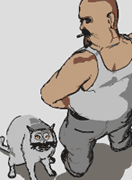
a multimodal,
-pervasive, location-aware, net-centric game
unexceptional.net is the gateway to Robert Nideffer’s mobile game that uses blogging, a GPS-enabled mobile phone, and a 3d game client in a game quest to find spiritual enlightenment, seriously.
Nideffer borrows from comics, graphic novels and computer games. The central character "Guy" has recently found out that his partner is having an affair. This discovery launches him upon a series of quests that you participate in, in effort to help Guy gain insight into the nature of his partner's relationship. The ultimate goal is to help Guy attain "enlightenment." To do this you must find key objects that open Guy’s seven major "Chakras," the energetic centers of the body according to Buddhist doctrine.
The project involves an extensive database infrastructure for storing and delivering game-state data via the Web, GPS enabled mobile phones, and a 3D game client. The Blog provides players information about what’s going on in Guy’s life, current game state, player locations, and quest progress. The Blog also provides an administrative framework enabling game designers to alter the game and have it immediately reflected in the various game clients. Players can also quest via voice. This has been done by integrating telephony software that incorporates automated call routing enabling players to receive calls based on where they are in physical space, as well as who they are in proximity to. Additionally, database and player interactions can be viewed in a Flash-based "Transaction Visualizer."
All data used in the game is location specific and sent to the phone and 3D client from the game server during game-play. Thus the game world is representative of the physical environment it's played in. This makes the game world extremely extensible while allowing for quests to be linked to specific locales. Game state is continually fed to the server via the different client interfaces, and broadcast back out to those interfaces. What happens in each of the interfaces effects the others in real-time.
A goal of unexeceptional.net is to push at the boundaries of network interoperability using a combination of freely available and custom-built software, and make the results easily available to others for their own creative experimentation.
via ucsc danm
Posted by michelle at 10:03 PM | Comments (0)
Come Out & Play Festival
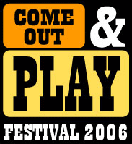
Rediscover the World through Play
The Come Out & Play Festival seeks to provide a forum for new types of public games and play. We want to bring together a public eager to rediscover the world around them through play with designers interested in producing innovative new games and experiences.
The Come Out & Play Festival is a street games fesitval dedicated to exploring new styles of games and play. The festival will feature games from the creators of I love bees, PacManhattan, Conqwest, Big Urban Game and more. From massive multi-player walk-in events to scavenger hunts to public play performances, the festival will give players and the public the chance to take part in a variety of different games.
The Come Out & Play Festival will run from September 22-24, 2006. Games will occur throughout the day in locations around the city. The full festival schedule will be made available in June. Interested in submitting a game to be played in the festival? Apply here to be part of the Come Out & Play Festival. Extended! Submissions due June 30.
Posted by jo at 05:24 PM | Comments (0)
Aperture + Contemplace
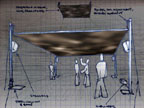
Spatial Experience
Aperture--by transmote.com-- focuses on the ways sound and light affect spatial perception. Spatial experience comprises several related elements. Some of these are ephemeral and difficult to isolate, such as time, context alongside adjacent spaces, and human presence or absence. However, some elements more directly affect spatial experience; in particular, sensory data such as visual changes, aural motion, and tactile input have profound impacts on the way we perceive space.
Multi-channel sonic textures, generated from recordings of existing spaces, encircle the space of the installation. A rear-projected ceiling is used as a display and light source, describing arcs of motion, intensity, and color. Transitions between audiovisual textures echo transitional places in architecture, places that deal with changes in scale, use, material, and motion. By contextualizing these changes of sound and light in physical space, Aperture enables visitors to gain a greater awareness of the composition of their individual perceptions of space.
Aperture is on display as part of Eyebeam's Circuit program from Tuesday, May 9th, through Saturday, May 20th. Eyebeam’s hours are Tuesday - Saturday, 10am-6pm.
Eric will be on hand to discuss the piece during the following times:
Tuesday, May 9th, 4-6pm
Wednesday, May 10th, 6-8pm
Aperture was developed during a fellowship in Eyebeam's Production Studio and is an extension of Contemplace.
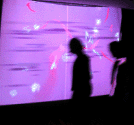
Contemplace is a spatial personality that redesigns itself dynamically according to its conversations with its visitors. Sometimes welcoming, sometimes shy, and sometimes hostile, Contemplace's mood is apparent through a display of projected graphics, spatial sound, and physical motion. contemplace is an environment in which inhabitation becomes a two-way dialogue.
Contemplace is an exploration of possible interactions between people and the spaces they inhabit. Typically, built spaces are passive shells that rely on their inhabitants to provide them with character. What would our spaces be like if they could receive their visitors like a human host?
Contemplace's visual displays and overall structure are built with processing, a java-based programming platform. Contemplace's sounds are generated by max/msp, a graphical programming environment for manipulating sound. processing and max/msp communicate via flosc, a java server designed by Ben Chun to allow communication between OSC/XML-compatible programs over IP. Visitor presence and motion is detected by a webcam and pressure sensors. The same electronic circuit that monitors the pressure sensors also drives a motor that raises and lowers the ceiling with contemplace's mood swings.
Posted by jo at 05:03 PM | Comments (0)
Amnesty International
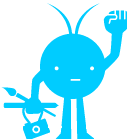
Firefly Commission
In an effort to support Amnesty International’s global advocacy and educational work and provide a forum for critically considering the intersection of the human rights framework and contemporary artistic practices, AI Firefly has announced a juried $3,000 commission for the creation of a new art work to be presented on or around International Human Rights Day, December 10, 2006.
Applicants must make a commitment to produce the project by December 2006 for public presentation on and after International Human Rights Day on December 10; the presentation could include full-scale production of a theatrical performance, launch of a new media or internet-based project, premiere screening of a film or video project, opening reception for a public art project, or similar presentation. Applicants are encouraged to propose innovative work that critically considers the relationship between contemporary artistic practices, including “activist” artistic practices, and human rights.
The concept of “human rights” refers to the minimum standard of legal, civil, and political freedoms guaranteed to all individuals regardless of nationality, ethnicity, and other localizing factors. The clear articulation of these rights in international political conventions and the ongoing discourse around their legislation and enforcement provide a global frame of reference and concrete starting point around which political action—artistic or otherwise—can be organized.
Download guidelines and an application: www.aifirefly.org/commission.
Application deadline: August 4, 2006
Information session: May 24, 2006, 6:30 PM at Alwan for the Arts, 16 Beaver Street. Please visit aifirefly.org/commission to RSVP.
Questions? E-mail commission[at]aifirefly.org.
Amnesty International Firefly Project (AI Firefly) is a New York City-based collective of artists and activists affiliated with Amnesty International USA as local group #704.
Posted by jo at 12:52 PM | Comments (0)
Troy

Alternate Reality Game
"One of the shared characteristics of all the types of game is to be closed systems, limited in time and space, as a sort of 'magic circles' where the player voluntarily decides to enter. Troy is a small but brilliant example of an 'alternate reality game', or a game that uses different media and disregards any formalized rule deliberately trying to wandering off the ludic universe. The game has been created on the occasion of the Experimental Gameplay Competition, themed on 'violation', and it has suddenly threw the publishing portal into turmoil.
The link recommended by the author pointed to a 'file not found' page. Only the most curious users has clicked on the almost standard 'parent directory' link. Doing so the user can see the spartan directory tree, typically listing all the files in the remote folders that have no index file. At first glance it seems a hitch, one of the many interface errors that can be seen during the netsurfing practice, but actually it's the proper game start. The surfer / player can snoop around the Troy's author personal files, collecting information about him, in order to access restricted areas and to search for the elusive videogame, built for the competition.
The player will know about a recent breaking-off of the author's engagement, that will be the key to get an important password. It's a proper meta-game that thematizes the privacy violation on the net, stimulating the player digital voyeurism. It's a tough game, indeed, and it has also a distinct geek taste because of the riddles complexity. Anyway the solution (written by the author, the 'original' one) can be finally found here." -- Paolo Pedercini, NEURAL.
Posted by jo at 12:46 PM | Comments (0)
Meanwhile
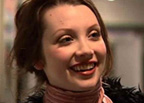
Interactive Online Film
"Godard once said that a film must have a beginning, middle and an end, but not necessarily in this order. This is the source of inspiration of Meanwhile, by David Clark, Jeff Howard, Chris Mendis and Shelley Simmons, an online film that even if it has been made with all the standard movie rules, appropriate the peculiarities of the net (and of the videogame paradigm also). Actually it gives up straightforwardness and embraces a selective enjoyment that allows the user to make a free plot composition, using the nine clips the movie is divided in.
The project is not claiming any originality: amongst the predecessor there are 'Sanctuary', perhaps the first interactive film in history that allowed not only to modify the plot but also to make sort of remixes, and an Italian project funded by the tv on demand 'E' developed by Ebismeda, a film whose plot can be disassembled and re-assembled through the remote control.
But 'Meanwhile' has some food for thought on the evolution of the filmic text. As a matter of fact the scene fragmentation and interchangeability seem to invalidate the intrinsic nature of the movie language causing a significant overlap in the videogame territories. In other words the film becomes a trait d'union between the narration linearity and the text produced in fieri, or between the affective adhesion of the spectator and the claim of an almost absolute player's desire to be the centre of attention. Therefore, if on one hand the new media action and interaction possibilities allow the user to pretend to be an author (here we deal with the net, but the dvd possibilities must not be left out), on the other hand they risk to cause an intellectual levelling off, exchanging an interpretative effort with an exclusive self-referentiality." -- Francesca Tomassini, NEURAL.
Posted by jo at 12:39 PM | Comments (0)
16 Beaver's Monday Night
![]()
Discussion on Rancière's Politics of Aesthetics
16 Beaver's Monday Night -- 05.08.06 -- Discussion on Rancière's Politics of Aesthetics; Where: 16 Beaver Street, 4th Floor; When: Monday Night 05.08.2006 @ 7:30 PM; Who: Open and Free To All
A translation of Jacques Rancière's "the politics of aesthetics" into English was completed in 2004. Since that time, these texts have been in wider circulation and discussion. We have posted below two talks he has given on the subject in the last years which elaborate the positions outlined in the book. In addition to that we have a link below to a text Brian Holmes wrote some years back connecting to Rancière's writings as they pertain to aesthetics and politics. We would like to take a moment to create a forum for discussing these ideas and to connect to some of the ongoing discussions we have been having at 16Beaver.
Check back online before Monday's event, because we hope to be updating the page with some additional texts or resources.
Aesthetics and Politics: rethinking the link: There are different ways of dealing with art and politics. For a long time the issue had been set up as a relationship between two separate terms. The question was raised as follows: must art serve politics or not? Or: how can we assess the political import of artworks? This led to endless controversies about art for art's sake opposed to engaged art. Another way of setting the issue was: how do artworks represent social issues and struggles or matters of identity and difference. This resulted in another kind of endless job. When you started scrutinizing how 19th century French painters or novelists had represented class-war matters, you already knew that they did it inadequately because of their own class position. And when you begin to ferret out hidden representations of social, sexual or racial difference, you never stop finding new biases, the more so significant and perverse as they are the more deeply concealed and indiscernible to everybody's eye. For a while, some concepts offered a mediation, such as culture or modernity. The strategies of the artists, the contents of their representations or of their dismissal of representation were referred to the modes of perception and consumption of the new industrial world of work and leisure that you could call, according to your own political commitment, either capitalism and commodification or modernity and modern life. A lot of cultural and social history of art has been written to show how for instance the impressionist technique of coloured blotches had been fostered by the perception of the new scenery of the modern town with its shops, lights and windows or the new pleasures of urban or suburban leisure, cafés-concerts, boating on rivers and so on. So the issue of the autonomy of art with respect to politics turned out to be the issue of its autonomy in relation to common culture: did the impressionist blotches testify to a 'truth-to-medium" strategy of autonomy or did they chart the new conditions of sensory experience in commodity culture?
"The politics of aesthetics": I shall start from a little fact borrowed from the actuality of art life. A Belgian foundation, the Evens Foundation, created a prize called Community art collaboration. The prize is aimed at supporting artistic projects encouraging " the invention of new social coherence based on diversity of identities ". Last year , the laureate project was presented by a French group of artists called Urban Campment. The project , called"I and us" proposed to create, in a poor and stigmatized suburb of Paris a special place, "extremely useless, fragile and non-productive", a place at remove available to all but than can be used only by one person at once. So a prize destined to art was given to the project of an empty place where nothing designates the specificity of any art. And a prize aimed at creating new forms of community was given to a one seater place. Some people would probably see there the derision of contemporary art and of its political pretensions. I shall take an opposite way. I think that this little example can lead us to the core of our problem. The first point that it reminds us is the following. Art is not political owing to the messages and feelings that it conveys on the state of social and political issues. Nor is it political owing to the way it represents social structures, conflicts or identities. It is political by virtue of the very distance that it takes with respect to those functions. It is political insofar as it frames not only works or monuments, but also a specific space-time sensorium, as this sensorium defines ways of being together or being apart, of being inside or outside, in front of or in the middle of, etc. It is political as its own practices shape forms of visibility that reframe the way in which practices, manners of being and modes of feeling and saying are interwoven in a commonsense, which means a "sense of the common" embodied in a common sensorium.
Hierglyphs of the Future: Jacques Rancière and the Aesthetics of Quality by Brian Holmes: We're not a surplus, we're a plus. The slogan appeared at the demonstrations of the French jobless movement in the mid-90s in journals, on banners, and on tracts printed by the political art group, Ne pas plier. It knitted the critical force and the subjective claims of the movement into a single phrase. To be "a surplus" (laid off, redundant) was to be reduced to silence in a society that subtracted the jobless from the public accounts, that made them into a kind of residue—invisible, inconceivable except as a statistic under a negative sign. Excluded, in short: cut out of a system based on the status of the salaried employee. Until they finally came together to turn the tables, reverse the signs, and claim a new name on a stage they had created, by occupying unemployment offices in a nation-wide protest during the winter of 1997-98. The people with nothing erupted onto the public scene. "We're a plus," they said, intruding through the TV cameras into the country's living rooms. Which also meant, "We'll drink champagne on Christmas eve."
A way to grasp the aesthetic language of the French social movements in the 90s—and of the transnational movements now emerging—is through the work of Jacques Rancière and his writings on the politics of equality. In Disagreement (published originally in 1995), he confronted the philosophy of government with the scandal of the political.1 Government fulfills an ideal of order when it administers, manages, and tries to totally account for a population; but its reality is the police. The police keeps everyone in their place, imposes the calculations of value, apportions out the shares in society.
16 Beaver Group
16 Beaver Street, 4th / 5th fl.
New York, NY 10004
phone: 212.480.2093
for directions/subscriptions/info visit: http://www.16beavergroup.org
TRAINS:
4,5 Bowling Green
R,W Whitehall
2,3 Wall Street
J,M Broad Street
1,9 South Ferry
Posted by jo at 11:30 AM | Comments (0)
electric sheep

Do You Dream in Electronics?
ELECTRIC SHEEP is a blog dedicated to the infiltration of our sleep by the presence of electronic media. Have you had dreams (in the literal sense, while sleeping) that featured electronic media: internet, television, computer games, radio, mobile phones, etc? Maybe you were smooching Jerry Seinfeld or maybe you found yourself confronted with a dysfuntional Powerpoint presentation during a dream. Was it creepy? Is it comforting? Send your stories to: sleep.electric[at]gmail.com
ELECTRIC SHEEP is a project by Fereshteh Toosi. From her statement: "...By seizing the pleasure of mythology and using it proactively, I hope to resist the oversimplification of ideas that such fantasies have come to represent. I have performed as a quack doctor and impersonated a private investigator as a way to ask strangers to share their stories and idiosyncrasies with me. I inhabit characters inspired by existing stereotypes such as the fortune teller/mystic or the romantic image of the early American colonist. Creating an absurd interactive scenario for the audience through these personas is a tactic I use to investigate what people know and how they've come to feel comfortable with their own versions of the truth."
Posted by jo at 11:14 AM | Comments (0)
Man in|e|space.exe + ELEKTRA
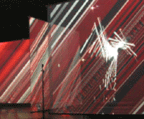
Object + Body in a Technological Perspective
The performance man in |e|space.exe is invited for the opening of the international festival of digital arts Elektra. The performance has been created last november at Carré de Jalles. It's a further step of the questioning about the relationship between the electronic/ physical space and human motion which had been started with the creation man in |e|space.mov. This extended (.exe) version takes place in a strolling immersive space where the public walks around 4 screens representing the digital representation of the dansers mouvement. The creation confronts and combine the representation of human motion in physical and digital 3D space.
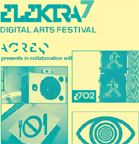
From May 9 to 14, ELEKTRA, the digital arts festival, will take over your senses, digitally. For this 7th edition, the event promises to astonish, both thanks to its bold digital arts works and gripping audiovisual performances. Over the course of six days, the festival proposes unusual, at times edgy experiences combining electronic music and visual creation. On the menu, laser and sound performances, interactive installations, dance and technology, electronic music and live performances. This counter-culture gathering blurs the frontiers of music, design, cinema, video, dance and architecture. Whereas ELEKTRA placed the term “audiovisual” on the map in 2005, this year will mark the exploration of the third dimension of audiovisual. The works selected place a common focus on the relationship between sound and image as it relates to the object and body in a technological perspective. Program; Events [PDF]
Posted by jo at 10:07 AM | Comments (0)
Home-Maker has a new home

What makes a house a home?
Home-Maker by Jeanie Finlay is now available to view online. What makes a house a home, how does this change if you can't leave?
Home-Maker, the interactive documentary project has been touring UK venues for the last 2 years. At the final venue, Hatton Gallery, a team from Heaton Used furniture came in and turned off the computers, packed up the dolls, furniture and ornaments and dismantled the set as they would whenever they perform a House Clearance. Now the only place to view Home-Maker is online.
In an online flash environment built by Gareth Howell you can visit Florrie, Roy, Lilian, Betty, Aiko-san, Emi-san and Monji-san in their new online home and hear the stories linked to the belongings in their Derbyshire and Tokyo living rooms in over an hour of streaming mini documentaries.
"This largely unprecedented, highly novel approach to portraiture brings up all kinds of touching details of life as it is lived between four walls, amid the dreadfully small collections of significant belongings, haunted by the enduring presence of lost loved ones...." Mick Martin, The Guardian.
Home-Maker is the result of two residencies which took place in the living rooms of seven housebound, older people in South Derbyshire, England, and Tokyo, Japan. Jeanie Finlay spent time with each of the seven people, getting to know their histories, preoccupations and passions, creating video and panoramic portraits of each of them in their homes.
A Ruby project made with Peoplexpress and Muse Company. In association with On the Edge Research. Supported by Arts Council of England , EM Media, UK Film Council, YOTA and Esmée Fairbairn Charitable Trust. Design by Ruby. Flash online exhibition by Gareth Howell. Winner of a Canon International Digital Creators Web Award.
Jeanie Finlay
Ruby Digital
jeanie[at]ruby-online.co.uk
http://www.ruby-online.co.uk
[posted by Mark Cooley on Rhizome.org Raw]
Posted by jo at 09:43 AM | Comments (0)
May 07, 2006
Turbulence Spotlight:
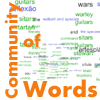
Community of Words
The Community of Words--by Silvia Laurentiz and Martha CC Gabriel--is a 3D environment governed by the Theory of Emergence. Users are invited to add their own words thereby becoming part of the community of words; they can navigate the environment and observe the actions of others. Words already present in the space influence participants who may create new texts in response to them. Characteristics such as language or culture form completely different communities and, subsequently, the words that emerge within them. [Needs Flash plugin, screen resolution 1024 x 768, click on Set Up for browser settings]
BIOGRAPHIES
SILVIA LAURENTIZ: Professor in the department of Fine Arts at the School of Communication and Arts, University of São Paulo, Laurentiz holds a PhD in Communication and Semiotics and a Masters Degree in Multimedia. She is also a graphics and multimedia designer; an artist who works in virtual reality, multimedia and web art; an art and new technologies researcher; and a speaker at art and technology conferences.
MARTHA CARRER CRUZ GABRIEL: An engineer with postgraduate studies in Marketing and Graphic Design, Gabriel's Masters Degree in Art & Technology is in progress at the University of São Paulo. Web/MM artist, professor at the Business School and Digital Design Program of the Universidade Anhembi Morumbi, and director of technology at New Media Developers (NMD), Gabriel is the winner of 11 Internet Best Awards from 1998 to 2005 and a highly acclaimed speaker.
For more information about Turbulence, please visit http://turbulence.org
Posted by jo at 10:17 AM | Comments (0)
May 05, 2006
Robotic Action Painter
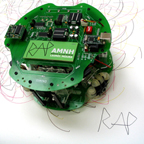
Artist Robot Signs Own Work
RAP (Robotic Action Painter) is a new generation of painting robots designed for Museum or long exhibition displays. It is completely autonomous and need very little assistance and maintenance. RAP creates it's own paintings based on an artificial intelligence algorithm, it decides when the work is ready and signs in the right bottom corner with its distinctive signature. The algorithm combines initial randomness, positive feedback and a positive/negative increment of 'color as pheromone' mechanism based on a grid of nine RGB sensors. Also the 'sense of rightness' - to determine when the painting is ready - is achieved not by any linear method, time or sum, but through a kind of pattern recognition system.
Robotic Action Painter
Leonel Moura (with IdMind), 2006
Posted by luis at 02:21 PM | Comments (0)
Turbulence Commission:
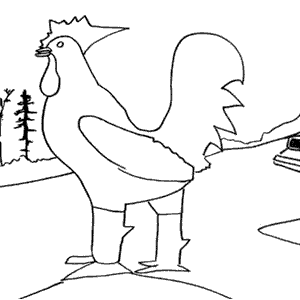
HRRAAGHP-TING!
HRRAAGHP-TING!--by Olen Hsu, Dana Karwas and Steven Lam--is an Internet/video collaboration that connects image and sound filenames available on the web to create an infinite chain of associations. Extruded in real time, and in a linear format, they collapse the Internet’s spatial organization into a single screen to create a cinematic experience. Each time "HRRAAGHP-TING!" is used, it generates an entirely different set of visual, aural and linguistic relationships. This Cagean play with chance destabilizes the intent and authorship implicit in the communication of information; perverts intellectual property through rampant decontextualization; and defies the expectations of the viewer through live reorganization.
"HRRAAGHP-TING!" is a 2006 commission of New Radio and Performing Arts, Inc. (aka Ether-Ore) for its Turbulence web site. It was made possible with funding from The Greenwall Foundation.
BIOGRAPHIES
OLEN HSU constructs installations in porcelain, paper and algorithmically composed sound, converging new media, tactile forms and works for acoustic instruments. He received his BA in Art History and Music from Yale University, a BFA in Ceramics from the Kansas City Art Institute, and an MFA in Sculpture from The School of the Art Institute of Chicago. A fellowship from the Dedalus Foundation brought him to New York where he participated in the Artist in the Marketplace Program at The Bronx Museum of the Arts, the Harvestworks Digital Media Arts Center Artist-in-Residence Program for New Music, and the BCAT/Rotunda Gallery New Media Artist Residency. Hsu is the recipient of grants from the New York State Council on the Arts, the National Endowment for the Humanities, the Joan Mitchell Foundation and the John Michael Kohler Arts Center. His recent work has been shown at The Bronx Museum of the Arts, the InterSpace New Media Arts Center in Sofia, Bulgaria, and James Nicholson Gallery in New York. The artist currently lives and works in New York City.
DANA KARWAS received a baccalaureate degree in Architecture from the University of Kansas and holds a Masters in Interactive Telecommunications from NYU’s Tisch School of the Arts. She is the co-founder of Gorilla Kingdom, a multimedia production company based in NYC. Her main interest lies in transforming and redefining social spaces through the medium of technology. Her work is rooted in architecture and extends to the edges of social and cultural dimensions. She has taught workshops on interactive mobile technology and the connections between architecture and the visual and sonic arts at the Harvestworks Digital Media Arts Center, NYC.
STEVEN LAM is interested in revealing how information becomes distributed, internalized, and performed. His practice is of glitches and reversals, re-enunciation, redubbing, recasting, and appropriation. He employs humor and a DIY sensibility to investigate contemporary issues dealing with institutional and media critique and the relationship of aesthetics with politics. Lam has exhibited at the Bronx Museum of Art, NY; Eyebeam, NY; LEF Embodied Technologies show at Art Interactive, Boston, MA; Silverlake Film Festival, Los Angeles, CA; Diverseworks, TX; The Windtunnel at Art Center College of Art and Design, CA.; Aljira: Center for Contemporary Art, NJ as well premiering video/choreographic work for various performance venues. He received his BA in Art History and Art from Trinity University, and a MFA from the University of California, Irvine.
Posted by jo at 12:15 PM | Comments (0)
Dak’Art Biennale 2006
![]()
African Media Arts
UNESCO-Daniel Langlois Foundation Programme promoting African media arts at Dak’Art_Lab 2006 at the Dak’Art Biennale 2006 (5 May–5 June 2006, Senegal, Dakar).
Exhibition at Dak'Art_Lab 2006: The exhibition displaying a selected number of works of the following African media artists is a timely occasion to increase the visibility of existing digital artistic practises and to sensitize artists of different disciplines and the general public of the potential of digital creation in Africa.
Forum (8 to 12 May 2006): A series of panel discussions is to be held on the aesthetics and practises of media arts in Africa - Maison de la culture Douta Seck. On this occasion, the Lab will be transformed into a place of exchange of experience, of collaboration and of reflection bringing together different role players and their expertise in the contemporary scene of African digital art and furthermore creating a synergy, which could lead to interdisciplinary and cross-sectorial collaboration within the region.
2 Training workshops on creative digital tools and practises (6 to 14 May 2006): As one of the major activities of the UNESCO-Daniel Langlois Foundation Programme at Dak’Art_Lab 2006, two separate workshops are to take place at Ecole Nationale des Arts de Dakar with the participation of its students. One workshop dedicated to visual digital creation is to be held on 8-12 May 2006 with the fine arts students of the Ecole, where as a number of music academy students are to participate in another workshop on electro-acoustic sound practises on 6-7, 13-14 May 2006.
The training programme and resources of the workshops are based on the following two online learning applications of the UNESCO Young Digital Creators Programme of DigiArts.
UNESCO DigiArts Team
http://portal.unesco.org/digiarts
digiarts[at]unesco.org
Posted by jo at 12:04 PM | Comments (0)
CALL FOR PROPOSALS

TALKING MONUMENTS
The art group "Archeopterix" (Izhevsk, Russia) is pleased to invite artists working with different media to take part in the public art project Talking Monuments, which will be realized in the framework of the cultural marathon "Perm Cultural Capital 2006." The event will take place in September 2006 in Perm city, Russia. Please submit your project proposals before July 20, 2006. Further dissemination of the information will be highly appreciated.
Concept: The ten-days public art festival “Talking Monuments” aims to bring together artistic reflections upon the role of monuments in contemporary urban spaces. The idea is to question nowadays city environments from the position of monuments within them as living objects of city public life. How are they integrated into social activities around them? How does public relate to them? How do they participate in the public discourse? Can we make them sound and speak on their own? What kind of observations can be grasped thenWe are looking for new myths and stories about monuments. Within rapidly changing nowadays reality monuments are both cross-historical traces and witnesses of passing epochs and mythologies. They seem to be silent and immobile objects, but what about giving them an opportunity to speak out, to talk back to the public, to turn them into active subjects of communication?
GUIDELINE FOR PROPOSALS SUBMISSION
Please submit your project proposals according to the following four categories:
1. Talking Monument Art projects in formats of multimedia, kinetic installation; staged visual, musical, poetic performance. Your works are expected to be related to already existing monuments in the city and/or their context. Especially works aiming at bringing dynamics and new contextual experiences are welcomed. Works in this category will be selected in cooperation with the city administration. Please pay attention to special criteria for the projects in the category “Talking Monument”: Your project should not cause any damage or material loss to monuments. The project idea should correlate as much as possible with the festival theme “Talking Monuments ." References to the specific topics and aspects of cultural and social context of Perm are encouraged.
Authors of selected projects will be provided with the assistance for their realization, including materials, assistants, expenses. For more details please contact the organizers.
2. Monumental Video-Scape Video art works of the total length of 10 min maximum. The video art works are supposed to provide new environment or background for a monument, so it is going to be presented next to a monument which would be incorporated into the video-scape. The presentation of the project assumes that between the screen and spectators there will be a monument. For further information and assistance in choosing monuments and location please contact the organizers.
3. SMS Perm Novel Projects in the form of short text messages. One of the ideas of presentation of projects in this category assumes: on a pedestal of a monument the board with running line with text is mounted and transmitted. This category is open to your creative suggestion as well.
4. USB Stall or Art into the Masses! Any multimedia projects, which would suggest original ways of distribution of contemporary art content via portable and mobile devices widely used especially by youth: players, phones, PDAs, etc. For that a small mobile stall-poster with USB and flash ports is going to be established, where everybody could download the art, not only the detailed program and documentation of the festival, but also media art works as such. Visually the object will be similar to the flying device from planet Pluke from the cult Russian sci-fi movie "Kin-dza-dza" with mounted screens, speakers and video projector to broadcast the documentation and multimedia projects.
For more information on project, the list, photos and description of Perm monuments look at http://dacha.tyros.ru
DEADLINE for submission of project proposals is July 20, 2006.
Please use the electronic form in DOC format.
Put your last name in the name of your file, for example: (smith.RTF) and send it to anfimx[at]yandex.ru. Please send your files with brief description of the project and pictures illustrating the description in JPG or GIF format together with the electronic form to anfimx[at]yandex.ru
For any questions and suggestion contact: anfimx[at]yandex.ru
Further detailed information can be found at the web site.
The form for the application in categories “Talking Monument,” “USB Stall.” “Monumental Video-Scape” is below:
AUTHOR FULL NAME
ADDRESS
PHONE
TITLE
CONCEPT
BRIEF DESCRIPTION
TECHNICAL SPECIFICATIONS
Posted by jo at 11:33 AM | Comments (0)
European Digital Culture Networking Event
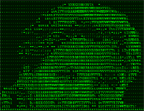
Culture Flows; Mind the Gap
We invite you to join us for Mind the Gap, a european digital culture networking event that will take place in Cluj-Napoca (Romania) in 16-18 June 2006.
Culture flows. And it seems that Bernoulli’s principle laid out in the late 1700’s applies well to this kind of fluid too: you just connect two or more – cultural - recipients and transfer begins. But what is transferred and when? And what is the direction of transfer? In digital culture technology penetration lag or maturization cycles are just two of the parameters affecting all actors on the cultural scene. How do differences or similarities between connected cultures influence transfer? Either cultural producers or audiences, understanding the phenomena of cultural transfer is to our best interest. It helps us fit in the flow.
The meeting aims to contribute to the networking of artists and organisations working in the field of digital culture across Europe and to foster the debate on the trends and developments in media arts in different parts of the continent and the connections and transfers that occur among the producers of digital content. On the same occasion AltArt will officially launch the BINAR Centre for Digital Culture, the first initiative of its kind in the country.
Mind the Gap intends to continue the media picnic series initiated by kuda and V2 in 2004 (Trans-European Picnic, Novi Sad) and continued by SCCA/pro.ba (_Sarajevo Picnic_2005, Lost In Transition) in 2005 in Sarajevo.
We warmly invite you to join us. And also to contribute to the refining and the selection of the topics to be discussed. For more details about the event and to view and comment on the proposed topics please visit our forum.
Partner: Transmediale/Berlin; With financial support from: Romania National Cultural Fund, Goethe Institute, Pro Helvetia – Swiss Cultural Programme in Romania, SC Fornetti SRLFor more information please contact us at the details provided bellow.
Hoping to meet you soon,
Rarita Szakats
AltArt Foundation
Tel +40 723 263072
Fax +40 264 587467
office@altart.org
www.altart.org
www.altart.org/mindthegap
Posted by jo at 11:19 AM | Comments (0)
Aotearoa Digital Arts + UpStage
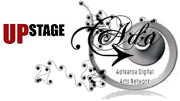
ADA Swaray
You're invited to the first ADA Swaray, on Sunday 7 May at 9pm New Zealand time.
What is the ADA Swaray? Aotearoa Digital Arts, in conjunction with UpStage, is hosting a series of "swarays" - informal social gatherings for digital artists and other interested folk to meet, talk and play online. The idea was born following a demonstration of UpStage at last year's ADA symposium, _emerge_, partly as an opportunity to get to know artists coming to SCANZ but also as an informal networking opportunity for digital artists in New Zealand and overseas.
How do I attend? Put on your favourite frock and point your browser at http://www.aotearoadigitalarts.org.nz/swaray; use the link to check your local time if you're not in NZ, and at the appointed time follow the link to the Swaray Stage. Type into the text chat window to join in the conversations and mingle with the assembled guests. Virtual champagne, cocktails and canapes will be served.
Posted by jo at 11:04 AM | Comments (0)
MIT List Visual Arts Center

Art + Technology
Currently at the MIT List Visual Arts Center, Cambridge, Massachusetts: 9 Evenings Reconsidered: Art, Theatre, and Engineering, 1966; Choreographic Turn: Daria Martin; Peter Welz in collaboration with William Forsythe; and Chris Doyle: Recent Video Works
9 Evenings Reconsidered: Art, Theatre, and Engineering, 1966, Curator: Catherine Morris.
This exhibition, organized by independent curator Catherine Morris, takes a fresh look at 9 evenings: theatre and engineering, a series of performance events organized by Billy Klüver, a Bell Laboratories engineer, that took place at the 69th Regiment Armory in New York from October 13-23, 1966. 9 evenings featured ten artist/engineer collaborators who attempted to realize previously unattainable creative projects. 9 Evenings was a significant turning point for many artists who became aware, many for the first time, of the implications that advancements in technology had for the development of their own work. The exhibition 9 Evenings Reconsidered: Art, Theatre, and Engineering, 1966 includes works of art, ephemera, drawings, film, and photo documentation of the 1966 performances.
The artists involved in 9 evenings: theatre and engineering were John Cage (composer); Lucinda Childs (dancer and choreographer); Öyvind Fahlström (painter and author of theater pieces); Alex Hay (painter and choreographer); Deborah Hay (dancer and choreographer); Steve Paxton (dancer and choreographer); Yvonne Rainer (filmmaker, dancer and choreographer); Robert Rauschenberg (painter and choreographer); David Tudor (musician and composer); and Robert Whitman (film/video artist, author of theater pieces). Bell Laboratories’ Billy Klüver brought these artists together and paired each artist with an/a Bell Labs engineer to create new works. Engineers included: Per Biorn, Cecil Coker, Ralph Flynn, Larry Heilos, Peter Hirsch, Harold Hodges, Robert Keronski, Jim McGee, Robby Robinson, Herb Schneider (MIT Class of 1948), Fred Waldhauer, Witt Wittnebert, and Dick Wolff.
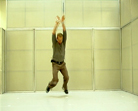
Choreographic Turn: Daria Martin; Peter Welz in collaboration with William Forsythe, Curator: Bill Arning, MIT List Visual Arts Center.
This exhibition features a 16mm film entitled Soft Materials by Daria Martin, an American artist living and working in London, and a large five-screen video installation entitled whenever on on on nohow on / airdrawing by German artist Peter Welz in collaboration with celebrated dancer/choreographer William Forsythe. In bringing together the work of these artists, curator Bill Arning offers audiences the opportunity to consider the space between dance and moving image in contemporary art practice. There is a growing history and cultural practice of choreocinema, or dance on film/video, a hybrid art form that offers previously unavailable experiences of dance. Choreographic Turn celebrates this exciting shift in cultural practice by showing two recent extraordinary iterations of this new form-film/video installations offering new modes of experiencing the art of bodies in motion.
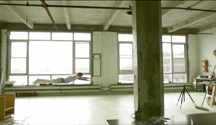
Chris Doyle: Recent Video Works
Flight (2005) 31 seconds
Tower (2005) 4 minutes
Hotel Bernini I (excerpt) (2004) 2 minutes, 33 seconds
Watershed (2004) 3 minutes, 02 seconds
Extraordinary Perceptual Dilemmas and the Madness of Climbing (2003) 1 minute, 30 seconds
Chris Doyle's themes are drawn from the psychology of everyday life. By using only the most low-tech special effects, he transforms everyday images into short films that are magical and moving.
Doyle is perhaps best known for Leap , a public artwork sponsored by Creative Time in April, 2000, for New York City's 2 Columbus Circle. A celebration of hope, Leap , showed moving images projected onto a tall building of various New Yorkers from all five boroughs jumping skyward. Beginning at dusk, depictions of a continuous stream of New Yorkers appeared at the base of the building, and one by one, four hundred and twenty jumpers soared up the height of the facade, slipping into the night sky.
In recent years, Doyle has worked less in the public sphere, and more in the private fictional spaces he creates in his videos. This selection of videos shows a wide range of Doyle's interests, but each manifests a dreamlike vision in which the quotidian becomes extraordinary. Doyle likens his practice to a "Pathetic Magician, a sad sack trying to make magic out of what is at hand."1 Writing in Art News magazine Linda Yablonsky said "(Doyle) has cast hot dogs, red bricks, and lawn chairs as human surrogates in videos that constantly mix storytelling with abstraction." 2
Flight (2005) shows the artist doing aerial circuits in a Superman pose around his Brooklyn studio before heading out the window. Today, when even amateurs have access to Hollywood-quality special effects, the artist's goal is clearly not a seamless effect. The jerky motion is left as a clue to his methodology, in which the artist performed 230 individual leaps and then sequenced the still photographs to depict flight.
Tower (2005) uses an animation technique known as "claymation". Doyle has turned the descriptive form upside down; and we see the effects of unseen artist's hands on the tower, wounding and suturing the form. and twisting it like taffy.
Hotel Bernini I (2004) is among Doyle's most evocative works, in that how one perceives the turbulence of the white hotel sheets will invariably be affected by one's own psychology. Whether it is understood as the result of anxiety, insomnia, or passion, the sheets are now vacant, and the bodies that gave them life are now missing.
Watershed (2004) shows a partly deconstructed bank building that the artist found in upstate New York. Using only flashlights for special effects, Doyle uses the skeletal frame as a metaphor for the psychological structures that contain thought, with the flashes of light serving as the events or perceptions that define human relationships. The artist appears at the very end sweeping up after the emotional fireworks.
Extraordinary Perceptual Dilemmas and the Madness of Climbing (2003) was a site specific project done for an exhibition in East Hampton, Long Island, NY. Like many natural paradises that have become popular resorts, longtime residents describe the area's past in idyllic terms that are too dreamy to be true. The old movie feel and the slightly horrific over-profusion of images are meant to conjure the dark side of paradise.
Posted by jo at 10:51 AM | Comments (0)
Call for Participation
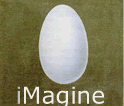
iMagine
iMagine--by Les Liens Invisibles--is a ludic reflection about mainstream imaginary; iMagine wants to be a ludic reflection about overwhelming and overflowing images, it is based on the collaborative mechanics of the Net and freely inspired by René Magritte's works.
The logos of our symbolic system, manipulated and controlled by an élite and not by the whole community, are defined by processes and choices based on marketing techniques and determined by the need to make profit. Symbols, or, as Barthes calls them, logotechnics, that derive from this logical process impose a one-way relationship with the imaginary sphere of every individual, whose only role becomes that of consuming the cultural element through the good/medium that conveys the message. The symbolic relations crystallize the chain of meaning that constitutes the base of the whole system.
iMagine is an image search engine based on a double action:
1. De-automatization > this mechanism allows users to regain a symbol that belongs to the collective media imaginary and to put it in a database, with some information related (TItle, Category, Keywords), so that it will be possible to create a new cultural context for a well-known symbol. The name iMagine comes from the imaginative effort that the user must do when he/she records his/her image;
2. Search > the search allows users to look for images in the database. The recording action allows the change of the mechanism of query/result of the search engine, that will provide only image with a new context, depending on the user's query. The gap between the expected result and the actual one is the starting point to build up new meanings and new correlations based on the new images produced.
Posted by jo at 10:14 AM | Comments (0)
The Future of the Internet
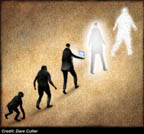
Net will dig deeper into our lives
“One expects there to be much more organic connection between people and technology,” says Google Chief Internet Evangelist Vint Cerf, who is widely known as one of the “fathers” of the Internet for his role in co-designing the TCP/IP protocol and the Internet’s architecture. [...] If Mr. Cerf and about two dozen other pundits Red Herring interviewed about the future of the Internet are right, in 10 years’ time the barriers between our bodies and the Internet will blur as will those between the real world and virtual reality.
Automakers, for instance, might conceivably post their parts catalogs in the virtual world of Second Life, a pixilated 3D online blend of MySpace, eBay, and renaissance fair crossed with a Star Trek convention. Second Life participants—who own the rights to whatever intellectual property they create online—will make money both by using the catalog to design their own cars in cyberspace and by selling their online designs back to the manufacturers, says Danish economist and tech entrepreneur Nikolaj Nyholm.
Today’s devices will disappear. Electronics will instead be embedded in our environment, woven into our clothing, and written directly to our retinas from eyeglasses and contact lenses, predicts inventor, entrepreneur, author, and futurist Ray Kurzweil. “Devices will no longer be spokes on the Internet—they will be the nodes themselves,” he says." From The Future of the Internet, Red Herring, April 10, 2006 Print Issue. [via pasta and vinegar]
Posted by jo at 08:51 AM | Comments (0)
Hyperbody Research Group
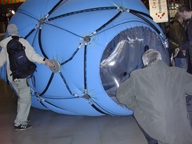
A place like a Muscle
I am really enjoying this Muscle NSA project carried out at the Hyperbody Research Group at Delft University. This is a programmable building that can reconfigure itself.
For the exhibition Non-Standard Architecture ONL and HRG realized a working prototype of the Trans-ports project, called the MUSCLE. (…) Programmable buildings change shape by contracting and relaxing industrial muscles. The MUSCLE programmable building is a pressurized soft volume wrapped in a mesh of tensile muscles, which change length, height and width by varying the pressure pumped into the muscle.
What is interesting is the interaction they designed engaging people in a playful activity:
Visitors of the Architectures Non Standard exhibition play a collective game to explore the different states of the MUSCLE.
The public interacts with the MUSCLE by entering the interactivated sensorial space surrounding the prototype. This invisible component of the installation is implemented as a sensor field created by a collection of sensors. The sensors create a set of distinct shapes in space that, although invisible to the human eye, can be monitored and can yield information to the building body. The body senses the activities of the people and interacts with the players in a multimodal way. The public discovers within minutes how the MUSCLE behaves on their actions, and soon after they start finding a goal in the play. The outcome of this interaction however is unpredictable, since the MUSCLE is programmed to have a will of its own. It is pro-active rather then responsive and obedient. The programmable body is played by its users.
There is also a slight connection with the blogject concept:
For the behavioral system this means that the produced sensorial data is analyzed in real-time and acts as the parameters for pre-programmed algorithms and user-driven interferences in the defined scripts. These author-defined behavioral operations are instantly computed, resulting in a diversity of e-motive behaviors that are experienced as changes in the physical shape of the active structure and the generation of an active immersive soundscape. The MUSCLE really is an interactive input-output device, a playstation augmenting itself through time.
Why do I blog this? what I like in this project is that it mixes different aspects of the HCI world: games, games software, architecture, usage of sensors. In the end, the outcome is pretty original and the visitors’ experience seem to be intriguing. I also like how it modifies the relationship of the visitors to a dynamic place. [blogged by nicolas on pasta and vinegar]
Posted by jo at 08:40 AM | Comments (0)
Tiffany Holmes
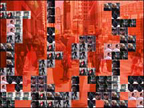
Your face is safe with me
Your face is safe with me, by Tiffany Holmes, is an animation generated from a camera recording live in the gallery and from a database of images the artist collects from Chicago locations surveilled by security cameras.
"What the viewer will see is the computer playing video games against itself for no purpose," said Holmes, "and the surveillance images, which are fairly recognizeable, come up from time to time in the games." The surveillance images of the visitors in the gallery are fed to Pac Man or become the bricks that imprison the player in Breakout.
A large projection portrays the computer playing simple videogames with itself. The games parodied refer to the proliferation of surveillance camera networks and their potential to be perceived as hostile intruders in community spaces—as envisioned in the updated Space Invaders™ game. In one videogame, Pacman™ chomps through a single CCTV screenshot to reveal several others—alluding to our culture’s voracious appetite for covert imagery. The new Asteroids® play involves a tiny ship blasting surveillance camera images into ever smaller ones, alluding to the immense amount of banal imagery generated daily by CCTV networks. The computer used in this exhibition deletes all images gathered live within one hour.
Surveillance-based games: the Zone project, Joey Skaggs's Art Attack. [blogged by Regine on we-make-money-not-art]
Posted by jo at 08:30 AM | Comments (0)
May 04, 2006
Save The Net
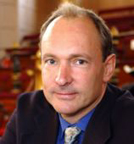
Tim Berners-Lee On Network Neutrality
Tim Berners-Lee, the father of the web, so to speak, weighs in on Net Neutrality.
When, seventeen years ago, I designed the Web, I did not have to ask anyone’s permission. [3]. The new application rolled out over the existing Internet without modifying it. I tried then, and many people still work very hard still, to make the Web technology, in turn, a universal, neutral, platform. It must not discriminate against particular hardware, software, underlying network, language, culture, disability, or against particular types of data. The Internet is increasingly becoming the dominant medium binding us. The neutral communications medium is essential to our society. It is the basis of a fair competitive market economy.
More than anyone, I think it is time for start-ups and their backers to take stock of what the loss of network neutrality would mean to their business. Win or lose, this one has business implications, more so for many of the smaller corporate citizens. [blogged by Om Malik on Broadband] WHAT YOU CAN DO.
Posted by jo at 12:53 PM | Comments (0)
Mobile Processing Workshop

Call for Participants
Mobile Processing Workshop: INTERACTIVE APPLICATIONS FOR MOBILE PHONES WITH FRANCIS LI--Lisbon, Portugal, 15 - 19 May 06, Espaço Atmosferas, Rua da Boavista, 67, Lisbon.
The mobile phone has reached a level of adoption that far exceeds that of the personal computer. As a result, they are an emerging platform for new services and applications that have the potential to change the way we live and communicate.
Mobile Processing is an open source project that aims to drive this innovation by increasing the audience of potential designers and developers through a free, open source prototyping tool based on Processing and the open sharing of ideas and information. This workshop will introduce the Mobile Processing project and prototyping tool and provide hands-on instruction and experience with programming custom applications for the mobile phone.
Contents:
- Introduction to Mobile Processing, phone hardware and development platforms.
- Survey of projects with the phone as both the platform and subject for new forms of interactive applications and electronic art.
- Basic programming and prototyping concepts with 2D graphics and animation.
- Phone input/output handling including keyboard, camera, sound and vibration.
- Internet networking. Parsing and generating XML-formatted data.
- Text messaging and Bluetooth networking.
The workshop will be practical and at the end every participant will develop a personal exercise.
Equipment
Windows highly recommended, but Mac OS X is acceptable, with built-in or USB Bluetooth adapters recommended. Mobile phones with support for Java and Bluetooth recommended.
Participants are encouraged to bring their laptops.
Schedule
20 hours: 5 sessions X 4 h
15 to 19 of May 06 - 18h-22h
Target
Basic programming skills, familiarity with Processing recommended but not required.
About Francis Li: San Francisco, USA, Author of Mobile Processing. He is an interaction designer and software engineer with a passion for working with emerging technologies. In both academia and industry, for both research and production, has participated in the design, development, and evaluation of interactive systems with a focus on user interface design and human-computer interaction. Has a Masters in Interaction Design from the Interaction Design Institute Ivrea and a B.A. and M.S. in Computer Science from the University of California, Berkeley.
Price and Inscriptions: 250 euros
Inscriptions: visit www.atmosferas.net/mobileprocessing/index_en.html
Sponsor: Movensis
Support: www.etic.pt
About Atmosferas, Digital Arts Center: Atmosferas is a digital arts center involved in the production of experimental new media projects. Atmosferas commissions experimental projects, organizes workshops and conferences about current themes on the front line of the creative uses of the new media, created a TV show about electronic arts and promotes an yearly ideas competition.
Atmosferas - Rua da Boavista 102 - 2º,1200-069 Lisbon, Portugal
tel. +351 213213040 info[at]atmosferas.net
Posted by jo at 12:44 PM | Comments (0)
(re)ACTOR: THE FIRST INTERNATIONAL CONFERENCE ON DIGITAL LIVE ART
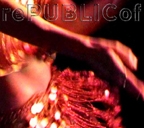
Call for PAPERS, PRESENTATIONS AND PERFORMANCES
(re)ACTOR: THE FIRST INTERNATIONAL CONFERENCE ON DIGITAL LIVE ART September 11, 2006 The Octagon @ Queen Mary, University of London London, England, UK, Deadline for 2-page submissions 26 May 2006. In cooperation with HCI 2006: ENGAGE; The 20th British HCI Group conference in co-operation with ACM
DIGITAL LIVE ART is the intersection of human-computer interaction (HCI), live art and computing. This conference seeks to bring together practitioners and academics from the varying worlds of live art, computing and human-computer interaction for a lively debate and event which will explore this emerging field. Our specific context focuses on club cultures as a living context for digital live arts practices. Our expected outcomes are to create a community of digital live artists and to present strategies for designing, developing and evaluating Digital Live Art. Such an event provides an opportunity to open up conversations between digital art and live performance and will allow us to explore how it is used to increase our understanding of human-computer interaction in general.
The notion of Digital Live Art is that of a hybrid art form which focuses on presence and presupposes the digital as a way of making live engagements. Our particular interest is in exploring the relationship that develops between performers, participants and observers within playful contexts and how Digital Live Art may move people to performative interaction and communal engagement.
THE CONFERENCE
The conference will include both daytime presentations and an evening ambient after party. The daytime event will include a keynote panel with Charles Kriel, Philip Auslander, and Jon Dovey.
Kriel is broadly regarded as one of the world's leading VJs. He VJs regularly for the likes of Pete Tong, Fatboy Slim, DJ Tiesto, Darren Emerson and Sasha and was recently appointed a Senior Lecturer at London Metropolitan University. His pioneering work includes the world's first nationally telecast VJ mix to the UK.
Auslander has written on aesthetic and cultural performances as diverse as theatre, performance art, music, stand-up comedy, and courtroom procedures and is the author of four books and editor or co-editor of two collections, his most current Performing Glam Rock: Gender and Theatricality in Popular Music.
Dovey spent the first 15 years of his working life in video production, working through the early years of Channel Four as a researcher, editor and eventually as Producer. He worked principally in documentary and experimental video, co founding original scratch artists Gorilla Tapes in 1984. His video projects gained international distribution and recognition and have now taken their place in the documented histories of UK Video Art. His forthcoming book is titled Game Cultures.
The schedule includes peer-reviewed paper presentations, interactive installations and performances, a cross-disciplinary discussion forum and an ambient after-party. The conference and evening event will take place in the Octagon at Queen Mary, University London - the recently refurbished library which was originally built in 1888 and was modeled on the Reading Room of the British Library (now the British Museum) and was formerly contained within the famous East End People's Palace.
WHO SHOULD BE ATTENDING?
We are seeking to bring together both working practitioners and academics from the active world of live art and computing, particularly (but not limited to):
Performers: Live artists, digital artists, DJs, VJs, sonic artists, dancers, actors, magicians.
Participants: Computer scientists, technicians, club goers, designers, new media practitioners, decorators
Observers: Cultural theorists, ethnographers, street scientists,her/historians
Orchestrators: Curators, directors, writers, producers, events organisers, club & festival owners/managers and promoters.
WHAT ARE WE LOOKING FOR?
We are seeking to create a dynamic, interactive experience for our delegates. We are soliciting two-page proposals for both the formal daytime conference and the interactive evening event. To this end your contribution can be made in the following ways:
15 minute paper presentation interactive demonstration/presentation of practice performance/installation DJ/VJ performance.
You should indicate on your proposal whether your contribution is best suited to the more formal daytime proceedings or to the after-party which will be taking place that evening.
TOPICS OF INTEREST
Proposals are solicited in all areas of Digital Live Art, including but not limited to:
-Creative clubbing and the playful arena
-Space, body, machine
-Inputs and outputs - co-creation and the dialogic exchange within digital live arts practice
-Computing for the experiential and cerebral Performance and the design of interactive interfaces
-Experimental music technology Creative displays and projections
-Tools for performers, participants and observers
-Networking, open-source clubbing and the free party
-Models and formal methods of interaction
-Her-story and his-story of computing and clubbing.
SUBMISSION OF PROPOSAL
Your proposal should be submitted to Alice Bayliss a.bayliss[at]leeds.ac.uk and Jennifer G. Sheridan sheridaj[at]comp.lancs.ac.uk) and should include:
Your name, contact details, organization/institution
200-word biography
Two-page proposal with title (10 point font)
Technical requirements
Daytime and/or evening program suitability.
DEADLINES
Two-page Proposal for Review Due: 26 May 2006
Notification of Acceptance: 16 June 2006
Early Registration: 23 June 2006
Proceedings of this conference will be published and available at the conference. Authors may be invited to contribute an extended version of their paper for a future publication.
ADDITIONAL INFORMATION
Venue: http://www.octagon-venue.com/
BCS-HCI 2006 - ENGAGE: http://www.hci2006.org/
CONFERENCE CHAIRS
Jennifer G. Sheridan
Computing Department
Lancaster University, UK
Alice Bayliss
School of Performance and Cultural Industries
University of Leeds, UK
CONFERENCE COMMITTEE
Philip Auslander, School of Lit., Communication, and Culture, Georgia Tech, USA
Mark Ball, Fierce Earth Festival, UK
Christopher Baugh, School of Drama, Film and Visual Arts, University of Kent, UK
Johannes Birringer, AlienNation Co. USA, Brunel University, UK, Schmelz, GER
Nick Bryan-Kinns, IMC Group, Queen Mary University of London, UK
Alan Dix, Computing Department, Lancaster University, UK
Jon Dovey, Drama - Theatre, Film, Television, University of Bristol, UK
Dan Fox, Welfare State International, UK Hannah Fox, Welfare State International, UK Bill Gaver, Goldsmiths University of London, UK
Gabriella Giannachi, Centre for Intermedia, University of Exeter, UK
Deborah Kermode, Ikon Gallery UK
Charles Kriel, London Met University, UK
Tom Lloyd, Welfare State International, UK
Joe Paradiso, MIT Media Lab, USA Planet Angel, UK
Sadie Plant, Writer, UK
Sita Popat, School of Performance and Cultural Ind., University of Leeds, UK
Mick Wallis, School of Performance and Cultural Ind., University of Leeds, UK
Posted by jo at 12:10 PM | Comments (0)
CHArt TWENTY-SECOND ANNUAL CONFERENCE

Fast Forward - Art History, Curation and Practice After Media
CALL FOR PAPERS – DEADLINE 31 MAY: Fast Forward - Art history, curation and practice after media; CHArt TWENTY-SECOND ANNUAL CONFERENCE, Thursday 9 - Friday 10 November 2006, London venue to be confirmed.
Everything is changing. In particular our media are changing and developing in extraordinary and unprecedented ways and with great rapidity. This is particularly true of so-called 'new media', such as the Internet and the World Wide Web, mobile telephony, and digital video. All of these either enable us to do things we did before differently, or more often and more easily, or to do things we could previously barely imagine. This is transforming how we understand and use what we still call 'media', even as we enter a 'post-media' age. More dramatically, these developments are in the process of transforming not just our world, but our very selves, how we understand who we are. We are in the midst of dramatic shifts in terms of the paradigms by which we understand and act in the world.
This is being acknowledged increasingly by those working in visual culture, whether in cultural production or cultural heritage, in art practice or in the history of art, in museums, in galleries or in other kinds of arts organisations, in libraries and archives, or in broadcast and media production companies, all of which are facing up to the consequences of rapid technological and cultural change.
For the 2006 CHArt Conference we are looking for proposals for papers that deal with the possibilities, challenges and problems of these changes, as they affect visual culture, in areas including (but not limited to):
Art Practice; Art History; Museums; Galleries; Curation; Archives; Libraries; Education; Media and Broadcast Production; Cultural Assets Management and Access; Hardware; Software; Theory; Practice.
Please email submissions (a three hundred word synopsis of the proposed paper with CV of presenter/s and other key figures) by 31 May 2006 to Hazel Gardiner (hazel.gardiner[at]kcl.ac.uk).
Dr Charlie Gere
Chair, CHArt
CHArt
c/o Centre for Computing in the Humanities
Kings College, University of London
Kay House
7 Arundel Street
WC2R 3DX
Posted by jo at 11:53 AM | Comments (0)
ASiA, IIAS and Waag Society organise Cyberasia Part Three:
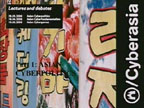
Asian Cyberart - Technology, Memory and Place
ASiA, IIAS and Waag Society organise Cyberasia Part Three: Asian Cyberart - Technology, Memory and Place: Wednesday May 10, 20.00 – 22.00 hrs. Language: English. Location; Waag Society, Nieuwmarkt 4, Amsterdam, The Netherlands. Livestream.
New media are changing the contemporary art world profoundly. Under forces of intense globalization, the internet is being transformed into a worldwide spectacle of utopian fantasies and lost memories. In our highly networked society, however, the longing for a place, for a sense of identity - ‘virtual’ or ‘real’ - remains. At the same time, rapid urbanization and the related destruction of nature, old buildings, and neighbourhoods put places under constant threat. Particularly in Asia. art and technology provide a virtual resort, where the self can have it's own space.
This seminar explores the encounters of technology with contemporary Asian art, bringing together four pioneering artists whose works, often involving the use of new technologies, engage in old questions of memory, place and identity. They will present their works, and discuss the impact of new technologies on contemporary Asian art scenes.
*The speakers are:*
*Mu Yuming* (1971) is an artist from Lijiang, a remote village in Yunnan, China. Mu defines his existence in the art world as a temporary one, as one step toward his great goal in life, that is, to become Farmer Mu: an average farmer. To reach this utopian and perhaps nostalgic goal, Mu makes extensive use of new technologies. See http://www.farmermu.cn/ and http://www.lijiangstudio.org/web/home/index.jsp
*Sookoon Ang* (1977) was born and raised in Singapore where she trained at the Nanyang Academy of fine Arts and the LaSalle/Royal Melbourne Institute of Technology University. She is also a graduate of the School of Visual Arts in New York. Her works, including drawing, videos and installations, have been featured in exhibitions worldwide. Her goal is to dive into the depths of ordinary existence and uncover the multi-faceted, multi-layered, multiple universes beyond the simplistic planes of realism and delusion. She explores in her multidisciplinary works feelings of loss, memory and nostalgia. See http://www.sookoonang.com/
*Onno Dirker (Nono), *a Dutch artist, is part of “Atelier Veldwerk,” together with Rudy Luijters. His works are driven by a desire to grasp the changes in urban landscapes, and to see how these changes affect our sense of identity and memory. In Shanghai, he has tried to capture the radical changes taking place in the city, often involving the massive destruction of buildings and neighborhoods, wondering how such changes will alter our sense of the past and of ourselves. See http://www.atelierveldwerk.nl and
http://www.artlog.nl/pages/left/l_tube.html
*Sjoerd-Jeroen Moenandar* studied literary theory and Scandinavian languages and cultures at Groningen University, where he is now a taff member of the department of Arts, Culture and Media. His research deals with the autonomy of literature, concerning the way in which literature, the literary field and the public debate relate to each other. He lives and works in Amsterdam and Groningen and writes poetry under the name of Munan. His poetry deals with issues from different mystical and romantic traditions and seeks its influences and themes in the poetry of a variety of national and international currents, such as medieval Scandinavian poetry, Sufi love poetry and the Dutch romantics of the 1880's.
*Cyberasia *is a* *series of three seminars that brings together Asian activists, academics and artists to reflect on contemporary political, religious and artistic uses of new technologies. Together, they showcase the current state of Internet affairs in Asia, opening up a unique meeting ground beyond the “Western” world. The previous seminars were held on March 29 on Asian Cyberpolitics and on April 18 on Asian Cyberfundamentalism.
For reservation: reserveren[at]waag.org
For more information: Dr. Jeroen de Kloet (moderator) b.j.dekloet[at]uva.nl
Posted by jo at 10:44 AM | Comments (0)
Art, Time and Technology by Charlie Gere

Book Release and Talk
Art, Time and Technology examines the role of art in an age of 'real time' information systems and instantaneous communication. The increasing speed of technology and of technological development since the early nineteenth century has resulted in cultural anxiety. Humankind now appears to be an ever-smaller component of dauntingly complex technological systems, operating at speeds beyond human control or even perception. This perceived change forces us to rethink our understanding of key concepts such as time, history and art. Art, Time and Technology explores how the practice of art - in particular of avant-garde art - keeps our relation to time, history and even our own humanity open. Examining key moments in the history of both technology and art from the beginnings of industrialization to today, Charlie Gere explores both the making and purpose of art, and how much further it can travel from the human body.
This is the first book that critically situates the technologies of real-time computing within the broader discourses of visual and media history. From Jack Burnham to John Cage, Leroi-Gourhan to Marshall McLuhan, and Les immateriaux to Stanley Kubrick, Gere challenges us to consider the role of the entire apparatus of communication in the ongoing construction of art as information processing system. Barbara Maria Stafford, author of Devices of Wonder: From the World in a Box to Images on a Screen.
Published by Berg in May 2006--Hardback, £50.00, ISBN 1845201345. Paperback, £16.99, ISBN 1845201353.
About the author: Charlie Gere is Reader in New Media Research at Lancaster University and is the author of Digital Culture.
Art at the Edge of Time: Talk and Discussion: Tue 30 May 2006, 19:00; Nash Room, Institute for Contemporary Arts, The Mall, London, SW1Y 5AH.
The average newscast these days is likely to report the outbreak of a new computer virus or a new technique for growing bodily organs. In an age when technology seems increasingly to have a mind of its own, art offers an important check on technology's relentless proliferation. This dialogue between new media artist-curator Jon Ippolito and scholar Charlie Gere probes the seismic shift in art's role during a time of accelerated change. The participants will draw on research from two books just published this spring. At the Edge of Art (Thames & Hudson), by Joline Blais and Jon Ippolito and Art, Time and Technology, by Charlie Gere (Berg Press). Both books are available from the ICA bookshop with a 10% discount for ICA members.
Jon Ippolito is Assistant Curator of Digital Arts at the Guggenheim Museum, New York, and director of The Pool, an online arts group. Charlie Gere is eader in New Media Research at Lancaster University and is the author of Digital Culture. Art at the Edge of Time is part of the Man Machine Season
Full Price : £5. ICA Members : £4.
(In lieu of a more formal book launch for Art, Time and Technology please join me for a drink in the ICA bar after the talk on the 30th).
Posted by jo at 08:45 AM | Comments (0)
Palpable City
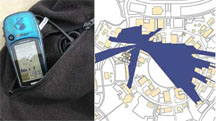
Wearing Tactile Space
Palpable City is a location aware garment that allows walkers to feel the spatial form of the urban grid as vibro-tactile rhythms on their body. The rhythms of the city space are parameterized by local conditions as the walker encounters them, reflecting the influence of time, light, temperature and humidity on the experience of space. The tactile space created can only be explored by moving through it.
The system consists of a GPS and a torso tactile display that communicates tactile textures related to the spatial form of the environment. Vibrotactile actuators are used to produce sensory saltation. Sensory saltation occurs across the senses resulting in the perception of apparent motion.
Three mechanical stimulators are placed on the forearm. The stimulator closest to the wrist delivers 3 short pulses, followed by 3 more at the middle stimulator, then 3 more at the last one. Instead of perceiving 3 pulses at each of the stimulator sites, the observer perceives that all of the pulses are distributed with approximately uniform spacing from the site of the first stimulator to the site of the third. The sensation is described as if a tiny rabbit was hopping up the arm from wrist to elbow.
Using variations in these parameters, a group of concepts which can be perceived through the tactile sense emerged. For example, a single point can be perceived as a direction. Taking advantage of sensory saltation, lines can be perceived, as can their length, straightness, spatial distribution and smoothness. More recent research suggests planes and 3D forms can be perceived. Tactors on the body can create a 360 degree "field of touch" where lines and forms can be perceived not just on the surface of the body, but through the body.
A work by Eric Conrad. Presentation at Subtle Technologies, June 1-4 2006, Toronto, Canada.
Related: The city as a musical interface [blogged by Regine on we-make-money-not-art]
Posted by jo at 08:17 AM | Comments (0)
kollabor8
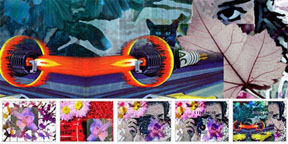
Collaborative Images
An online environment that allows artists, designers, photoshop junkies, pixel pushers, collage artists & photographers to collaboratively design & edit a single image. In kollabor8, each image chain is an open digital image mutation collaboration, displayed like threads in a forum. Each link in the chain is in some way a derivative of the previous image, as designers iteratively add aesthetic features in a collage-like way. See also gridlove & swarmsketch. [blogged on information aesthetics] [Related: Imprimatur]
Posted by jo at 07:43 AM | Comments (0)
May 03, 2006
Andy Gracie + Brian Lee Yung Rowe
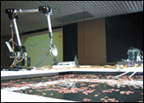
Autoinducer_Ph (Cross Cultural Chemistry)
"The idea of making art with living system is not new; you might ever consider a garden to be biological art. What is new is the degree of control over the biological systems and materials that contemporary art offers us. The aim of some net.art projects, like Telegarden, has always been to articulate a link between natural processes and communication networks in symbolic and mechanical terms. British artist Andy Gracie follows this stream working with events at the intersection of the technological and the biological.
With the collaboration of the American scientist Brian Lee Yung Rowe he has created Autoinducer_Ph (Cross Cultural Chemistry), an installation created for the AV06, Newcastle International Audio Video Festival. The project exploits a traditional rice cultivation technique from Asia based on the symbiotic association between the Anabena, a microscopic filamentous alga, and the water fern Azolla. The installation, which includes an assemblage of pond-like structures, electronics, laboratory and hydroponic equipment, uses the Generalized Cellular Signaling system, a platform for exploring emergent behavior and intelligence, to interfere with the symbiotic relation. The GCS bacteria signals, sometimes translated in sound and lights, are converted into inputs to control various actuators that regulate the environment in which the bacteria are being cultured. The sum effect is a bio-artificial ecosystem, which takes the form of a water garden which sustains living bacteria, robotic systems and artificial lifeforms, pushing our notions of life, intelligence and being into new territories." -- Valentina Culatti, NEURAL.
Posted by jo at 05:38 PM | Comments (0)
Net Community Hacks Cultural Funding System

125,000 euros Distributed
Our much-discussed, game-theory-oriented approach to cultural funding represents a clear rejection of all the Austrian cultural industry’s hegemonic tendencies, states MANA coordinator Stefan Lutschinger: This hack of the outmoded jury and committee system opposes every rationalistic funding cut with pure difference, contingency coping and the fruitful development of paradox.
Software-based Funding Distribution: Last week, a participatory cultural support budget of 125,000 euros was distributed to artists and cultural producers in Vienna using the MANA Community Game – an innovative software-supported selection process. The decision regarding the distribution of funding was not made by curators, juries or committees, but by the submitters themselves. Twelve people will receive project grants between 5,000 and 15,000 euros, whereby 42% of the recipients are women.
“Old” Concepts and “New Thinking”: The Community Game is one of the most innovative distribution systems for cultural funding worldwide. It is based on “old” concepts of the avant-garde – auto-curating and self-organization – and the “new thinking” of second-order cybernetics. MANA’s great advantage is its capacity for self-correction and adaptation to intelligent system environments: errors and irregularities can be recognized and corrected immediately by the net community, which emerges strengthened from this process. Here 120 submitters agreed to a complex set of rules.
A Self-managed Cultural Funding Budget: Since the autumn of 2004, the open net community “netznetz.net” has grown out of the numerous digital cultural initiatives that have developed in Vienna in recent years. In order to do justice to these diverse cultural and artistic modes of expression, an application has been made to the City of Vienna’s Department of Cultural Affairs (Net Culture Unit) for a self-managed cultural funding budget to support this very active scene with around 500,000 euros yearly. The heart of this funding model is the software-based selection process MANA. After a two-month evaluation phase in early summer, the net community will decide on its specific adaptation and further development.
Inquiries:
Stefan Lutschinger, Johannes Grenzfurthner, Hans Bernhard
Email: s.lutschinger[at]digitaldrafts.at
+43 660 6538616
http://mana.netznetz.net
http://en.wikipedia.org/wiki/Netznetz
http://www.parliaments-of-art.net
Posted by jo at 12:12 PM | Comments (0)
Call for Work

Networked Realities & Prospective Locative Hacks
Networked Realities & Prospective Locative Hacks--Art Exhibition: Deadline May 12, 2006: Artist-engineer hybrids are invited to submit artworks for the ACM exhibition to take place in the California Nanosystems Institute at UC Santa Barbara. For this exhibition we seek artworks that raise issues related to human-human, human-machine, human-machine-world, machine-machine, human-world and machine-world interactions, placing a strong emphasis on the role of the notion of awareness, be it cultural, linguistic, network-centric, spatial or geospatial.
In particular, we seek works that focus on the roles that multimedia content and technologies play in exploring human and social aspects of technology and science, including how it may re-define relationships and understanding between cultures and already established disciplines. We welcome any interactive artworks that address the topics above, including multimodal interactive spaces, locative media artworks, networked systems, data visualizations and communications systems.
Please visit the website for up-to-date information including deadlines, procedures, list of exhibition and program review committee.
ACM Multimedia is the premier annual multimedia conference, covering all aspects of multimedia computing. The ACM Multimedia Interactive Art Program seeks to bring together the arts and multimedia communities to create the stage to explore, discuss, and push the limits for the advancement of both multimedia technology through the arts, and the arts through multimedia technology.
The Interactive Art Program consists of a conference track and an art exhibition. We invite artists working with digital media and researchers in technical areas to submit their original contributions.
Posted by jo at 12:02 PM | Comments (0)
Intro Out:

Open Invitation
Intro Out: Open Invitation--Deadline: 12 May ’06: In few days’ time, the second festival of digital art opens up its gates and welcomes once again the artists of information community. Modern forms of expression use technology mechanisms for creating a work of art. Without doubt, the means of producing, reproducing and distributing an artistic experience alter the relationship of the artist with the subject matter and its viewer.
We invite modern artists to stand up to this change and propose new expression strategies by the use of new media.
How is artistic experience, which is promoted by new mass media, shaped today? How do new media assist artists in acquiring a different relationship with the viewer and how is this new relationship defined? Could we be talking about the generation of other aesthetic values?
The Festival will comprise the following subject categories:
o Animation
o Digital Installations
o Digital Music
o Experimental
o Interactive Works
o Performance
o Short-playing fiction movies
o Video art
Artists can participate with one work in each category. The length of each work should not exceed 15 minutes. The “Wood Factory” (the place where the festival will take place) provides all necessary space and equipment for exhibiting the works. Concerning installations and performances, all proposals will be carefully examined so that they are best realized.
Furthermore, an audience vote for the best work in each subject category will be held. Nominated works will have an honourable screening in the last day of the Festival.
How to participate: Download the fill-in form for taking part in Intro Out’06
Please print and fill in the form (.pdf or .doc).
Mail it together with all necessary proofs to the address:
INTRO OUT
20 Valaoritou (office 51)
54625 Thessaloniki
GREECE
For more information you can get in contact with us by emailing to:
intro_ïutfestival[at]yahoo.gr
by phone: ++30 6977 835 422
http://www.kazandb.com
Parallel Happenings
From this year, parallel to the festival, an artistic texts presentation will take place in the site of the festival regarding the new aesthetics reality in the art field. A chance to listen to the way new artists perceive aesthetics today. You can send your texts in the following mail: intro_ïutfestival[at]yahoo.gr The website, in future, aspires to be a dynamic domain for the exchange of ideas.
Action Place
Intro Out’06 Festival will be held at the “Wood Factory” (Ksylourgio), at Mylos
Posted by jo at 11:57 AM | Comments (0)
Schwelle I: Bardo
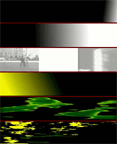
HDV Tryptic for Three Large Screens and Eight Channel Audio
At Elektra7, Thursday, May 11, 2006, 9:00 PM; Usine C, Montreal, Canada.
Schwelle I: Bardo--by Chris Salter--is a turbulent exploration of the experience undergone at the time of the dissolution of the body and consciousness. It is part I of a larger three part performance project currently under development that uses new sensing, electronic, material and computational technologies to tangibly explore the extreme physical and emotional states that might take place in the thresholds before and after death.
Part 1, Bardo, is an extended audio/visual composition/performance lasting approximately forty-five minutes. Partially shot in High Definition video, the work consists of three overlapped and synchronized 720 x 480 projections that form a 2160 x 480 widescreen resolution image with 8 channels of digital surround sound. Over the duration of forty minutes, the spectators undergo a powerful journey through a transforming landscape of abstract, Rothko-like image and dense, tsunami-like walls of sound that builds toward peak intensity, transporting the viewer through the threshold stages of dying and dissolution.
Posted by jo at 11:20 AM | Comments (0)
Rx Gallery and Rhizome.org Present
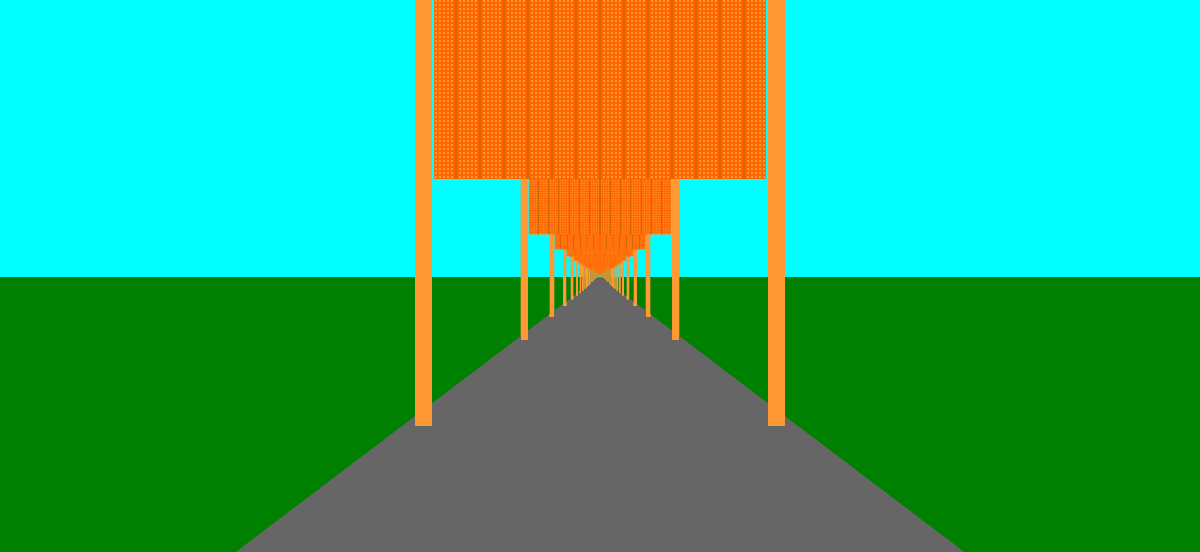
The GIFShow
The GIFShow opens (FREE) TONIGHT, 6-10pm, with live music & visuals by Eats Tapes & Nate Boyce; Rx Gallery - 132 Eddy Street @ Mason; 415-756-8825
The GIFShow takes the pulse of what some net surfers call 'GIF Luv,' a recent frenzy of file-sharing and creative muscle-flexing associated with GIFs (Graphic Interchange Format files). Curated by Marisa Olson in a West Coast Rhizome.org collaboration with Rx, the show presents GIFs and GIF-based videos, prints, readymades, and sculptures by GIF Stars Cory Arcangel, Peter Baldes, Michael Bell-Smith, Jimpunk, Olia Lialina, Abe Linkoln, Guthrie Lonergan, Lovid, Tom Moody, Paper Rad, Paul Slocum, and Matt Smear (aka 893/umeancompetitor). GIFs have a rich cultural life on the internet and each bears specific stylistic markers. From Myspace graphics to advertising images to porn banners, and beyond, GIFs overcome resolution and bandwidth challenges in their pervasive population of the net. Animated GIFs, in particular, have evolved from a largely cinematic, cell-based form of art practice, and have more recently been incorporated in music videos and employed as stimulating narrative devices on blogs. From the flashy to the minimal, the sonic to the silent, the artists in The GIFShow demonstrate the diversity of forms to be found in GIFs, and many of them comment on the broader social life of these image files. The opening is sure to be just as lively, with music by Eats Tapes and visuals by Nate Boyce. Spread the luv!--Rhizome News.
Posted by jo at 10:44 AM | Comments (0)
May 02, 2006
TechnoTexts

CTheory Live
Another installment in the newly launched CTheory Live interview series, N. Katherine Hayles, Professor of Literature and Media, UCLA, reflects on her three books: My Mother Was a Computer, Writing Machines, and How We Became Posthuman.
This interview is a rich, dense conversation in which Katherine Hayles provides the overall context and common threads that led to the three books. From her perspective, there was no interpretive history of cybernetics. She cites her interest in reintroducing embodiment into the discourse and trace the implications for subjectivity regarding the notion of information as disembodied.
Posted by michelle at 11:07 PM | Comments (0)
Electromagnetic Bodies:
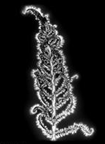
Aether, Desire and Resonance in Art and Technology
Opening Thursday May 4th, 2006, 20.30 at TENT.CBK and 22.30 at V2_Rotterdam--V2_Institute for the Unstable Media in collaboration with TENT. Center for Contemporary Art Rotterdam present Electromagnetic Bodies: Aether, Desire and Resonance in Art and Technology. Referring to the pioneering work of Nikola Tesla (1856 – 1943), the exhibition explores the notions of being and desire in a society determined by our bodily immersion within an ubiquitous and omnipresent electromagnetic realm. This is the zone where the physical boundaries between what may be called "organic", or bodily sensors, and technological constructs intermingle.
Considering the now lengthy history of the cyborg, the electron beam and the warp engine as a cultural concepts, one may wonder whether the distinctions between the natural world and globalised technologies are still valid. These issues were topics of Tesla's investigations a century ago as he sought to create a new utopian ‘World Society’ fueled by free energy created by the earth’s own natural electromagnetic sphere. The contemporary implications of these observations and predictions in today’s world of wireless detachment and unlimited mobility still present enigmatic research material to both scientists and artists alike.
Electromagnetic Bodies features electronic, interactive and acoustic artworks by Ælab, Jean-Pierre Aubé, Craig Baldwin, Matheusz Herczka, Simone Jones, Marie-Jeanne Musiol, Carsten Nicolai, Paulette Phillips, Catherine Richards, Jocelyn Robert, Daan Roosegaarde David Tomas, Edwin van der Heideand Norman T. White, with commissioned works premiering by Michiel van Bakel with Bill Spinhoven,and Marnix de Nijs. Exhibition runs daily except Mondays May 4th - June 4th 11.00 - 18.00 at TENT.CBK and V2_Institute for the Unstable Media Guided tours are available through vera[at]v2.nl by advance reservation.
The Electromagnetic Bride Conference, accompanying the exhibition, hosted by the Goethe-Institut Rotterdam, will take place on Saturday May 6th from 10.00 to 17.00.
The project is supported financially by the Mondriaan Foundation, the Stichting CBK Rotterdam, The Canada Council for the Arts, The Conseil des Arts et des Lettres du Québec, TheFilmfonds Amsterdam, and the Canadian Dept. of Foreign Affaires. Electromagnetic Bodies: Aether, Desire and Resonance in Art and Technologyis based on the Resonance: Electromagnetic Bodies international touring exhibition initiated and curated by Nina Czegledy and Louise Provencher in Canada, and co-curated by Stephen Kovats and Willie Stehouwen in Rotterdam.
Venues:
TENT. Centrum Beeldende Kunst
Witte de Withstraat 50
3012 BR Rotterdam
tel **31 (0)10 413 5498
V2_ Institute for the Unstable Media
Eendrachtsstraat 10
3012 XL Rotterdam
**31 (0)10 206 7272
Goethe-Institut Rotterdam
Westersingel 9
3014 GM Rotterdam
**31 (0)10 209 2090
Posted by jo at 09:17 AM | Comments (0)
Mathieu Briand
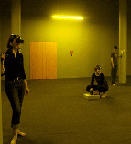
Telepathy Playground
Marseilles-based artist Mathieu Briand makes installations that use light, video, sound, and other media to let viewers destabilize and manipulate their own perceptions. His stylish works adopt the sleek, cold, and ambiguously menacing look of '2001: A Space Odyssey' and other dystopian science fiction fables of that era. Briand's first U.S. solo show recently opened at Los Angeles' Redcat gallery, and its title, Ubiq: A Mental Odyssey references both the Kubrick film and 'Ubik,' the Philip K. Dick classic about telepathy, unstable realities, and an elusive cure-all product. On view through June 18, the exhibition includes a standout work consisting of four retro-futuristic helmets outfitted with cameras and monitors, which allow wearers to swap perspectives and steal each other's points of view as they explore the exhibition. The piece highlights an important difference between Briand's work and the bleak science fiction tradition that he references: his work makes a hallucinatory future of failed technological utopias seem like fun. In these playful installations, a Phillip K. Dick-style confusion between reality and fractured perceptions becomes the perfect context for anarchic play. - Bill Hanley, Rhizome News.
Posted by jo at 08:31 AM | Comments (0)
May 01, 2006
Bion + Lattice Archipelogics
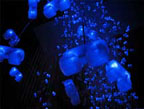
Responsive Fields
Bion is a robotic sculpture that explores the relationship between humans and artificial life. The name makes reference to an individual element of primordial biological energy identified as orgone by Wilhelm Reich. The installation is a sensor network that is composed of 1000 glowing and chirping forms. Each bion is a synthetic "life-form" consisting of a tiny computer, an audio speaker, blue LEDs, and sensors.
As a visitor approaches the installation space, one of the bions is alerted and quickly communicates the presence of a stranger to the swarm of bions. One by one, in rapid succession, the bions signal other bions of the intruder and, in a wave-like pattern, become silent. The bions eventually become accustomed to the visitor's presence and begin to respond to her/him as if s/he was part of their ecosystem. They become attracted to her and glow more intensely when she nears. Eventually, s/he is incorporated into the dynamic array. Video. By Adam Brown and Andrew H. Fagg, University of Oklahoma.
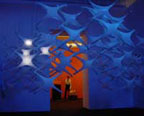
Another responsive field: Lattice archipelogics.
Distributed "sensitive" modules are reacting on the proximity of people approaching and entering the hybrid field of the lattice, translating the motion of individuals into ambient spatial patterns into light and sound.
Inhabitants turn into visitors, users or even actors in these new spatial scenarios, which is spelling another shift in defining architecture as a form of shaping environments.
Designed by Servo and Smart Studio/Interactive Institute. Images from Toby Schneidler's website. [blogged by Regine on we-make-money-not-art]
Posted by jo at 05:24 PM | Comments (0)
Fatso
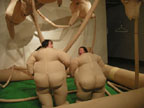
Participation Promotes Growth
Beijing-based, US artist, Rania Ho’s Fatso project “is an interactive installation consisting of inflatable fat suits and a wrestling ring controlled by motion sensors. Made of rip-stop nylon, powerful leaf blowers and motion detectors, audience members are encouraged to don the fat suits, enter the ring and wrestle each other. Any action in the vicinity of the installation initiates the inflation of the suits and the wrestling ring. If there is no one in the ring, the blowers stop and the installation slowly deflates. Each of the suits are linked to the blowers through and intricate umbilical cord-like system.” The project will be set up this summer at ISEA 2006 in San Jose, California. Should be pretty fun to check out! Go Rania! [blogged by Jonah on Coin Operated]
Posted by jo at 04:12 PM | Comments (0)
Turbulence Commission:

The Saddest Thing I Own
The Saddest Thing I Own by Matthew Belanger, A. Elizabeth Mikesell, and Marianne R. Petit: There are some things that we own that are just so sad. You know what we mean. Sad. It seems likely that these sad things illuminate our vulnerable places, one way or another.
"The Saddest Thing I Own" invites people everywhere to share the saddest thing they own. What are these sad things? What makes things sad? Do things start off sad? Do some sad things begin as happy things that then become sad? Are some things only sad because for some sad reason we kept them? Are some things just plain sad no matter what? This is what we want to know.
"The Saddest Thing I Own" is a 2006 commission of New Radio and Performing Arts, Inc. (aka Ether-Ore) for its Turbulence web site. It was made possible with funding from the Jerome Foundation.
BIOGRAPHIES
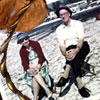
MATTHEW BELANGER is a New York based new media artist, programmer, and consultant. He dedicates this site to his mother, Wendy, who passed away in October of 2005 after a long battle with cancer. His works include documentary video, large-scale digital photography, interactive online applications and software development. His complete portfolio can be seen at: http://www.matthewbelanger.com/
A. ELIZABETH MIKESELL is an artist and writer who lives in New York City. She is on the faculty of New York University's Expository Writing Program, in which she teaches writing to students in the Tisch School of the Arts. Her fiction and non-fiction have been published in a number of small literary magazines.
MARIANNE R. PETIT is an Associate Arts Professor at the Interactive Telecommunications Program at the Tisch School of the Arts at New York University. Her artwork, including video, animation, and installation, has been exhibited in international festivals and exhibits and reviewed in a variety of publications including Leonardo, Wired and World Art. Her work can be seen at: http://www.mariannepetit.com.
Posted by jo at 11:59 AM | Comments (0)
Interview with Anne-Marie Schleiner
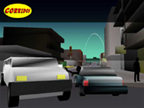
Disrupting Static Environments
An Interview with Anne-Marie Schleiner by Megan Lykins, Emily Hall Tremaine Curatorial Fellow for "All Digital" at the Museum of Contemporary Art Cleveland, showing January to May 2006.
1. How did you come to gaming, or game modding, as a medium for artistic expression? Do you consider gaming an art form in and of itself? Is game modding recognized in the gaming culture, or is it more of an artistic movement?
I was playing games while I was in graduate school at CADRE(Computers in Art Design Research and Education) at San Jose State University in the late 90's with my friends. I recognized computer games as a cultural medium ripe for artistic exploration. I think game modding is both a phenomenom that occurs independently of traditional art contexts as well as a tactic employed by artists with an education in art and awareness of contemporary art contexts.
2. In PS2 Diaries you reference many of the games you played as a child and young adult; is this how you commonly arrive at your material, through your own experience with the games? Are there any games you specifically do not or will not use? If so, why not?
No, I am often interested in games that I dont like to personally play. I enjoy voyeuristically watching other people play games to learn about what kind of modes of play and environments there are. For instance I don't play often online role playing games but I think they are an interesting form of electronic community space and I like to talk to players and learn about their online lives...kind of like being an anthropologist of gaming culture a la Jullien Dibbel but less diligently. I also enjoyed a lot when I went to Seoul, Korea going to the electronics part of town where I found many romantic dating games for teenage girls...a demographic that is pretty much overlooked in the West. I played these games out of curiosity, without understanding the language.
3. In addition to the gaming culture, what are some of the art historical, philosophical, and political references or influences that affect your work?
I am influenced by contemporary art, net art and historical movements like Dada and 70 performance art and conceptual art. I'm also influenced by post-modern theorists, media theorists, culture studies, feminism and gender studies...from Roland Barthes to Judith Butler to Friedrich Kittler to Guy Debord and many others. I am also a science fiction addict--my latest discovery is Louise Marley.
4. Role-playing has become a major aspect of many gaming experiences. Viewers are able to adopt new persona and exist in virtual, or as you call it, "game reality". In what ways does your work explore notions of identity? Having dubbed yourself a "cyberfeminist," in what ways do you specifically explore, analyze, critique and modify the female identity in your work?
It depends which work and when I made it. In the online collection of game hacks Mutation.fem I specifically address early female avatars in shooter games and the dialogue that took place among their mostly male creators about what they should be like. In my thesis project way back in grad school, Madame Polly, I was interested in the Lara Croft Tombraider phenomenom and explored different player/avatar combos, like that of drag queen ... In later works my exploration of gender is less in the foreground but still a component ... its hard not to be when you are a woman working with material in a very male dominated cultural arena ... that of computer games ... also digital and net art can be like that. In OUT, (Operation Urban Terrain) a live wireless series of performances in the city and game interventions, I wanted the ground unit of 2 players in the city to be women as a kind of visual female affront on Americas Army, the game were were intervening in.
5. Though PS2 Diaries is derived from video games, it is not interactive. Are any of your previous works interactive or do you have plans for interactivity in the future? How do you think interactivity would or does change the conception of your work by the viewer?
Machinima is not interactive since it tells a story much like narrative cinema using game environments ... I have just completed another project with machinima components (a documentary about MOUT games and a performance called OUT) and have plans for yet another. I seem to be moving away from interaction and away from collaboration in my recent work whereas previously everything was highly interactive and also collaborative with the audience and other artists (like Velvet-Strike). Maybe it is just a phase. I feel like I have some things I want to say on my own with more control over the process.
6. What are some of the misconceptions about digital art and game modding that you've encountered from viewers, artists, or critics?
Many people in the art world, even younger generations, are turned off by computer games, viewing them as a low class popular pastime so they may have built in aversions to engaging with computer game related work. In the 90's it took a while for even the proponents of virtual reality art to recognize the potential of 3-D game environments, which were below their cultural radar. And of course digital art in general poses the problem of being very ephemeral and difficult to collect to the art world...(the lack of the aura of the singular object). Also the quickly changing formats make the work difficult to view even a few years after it has been created.
7. What projects are you currently working on and what direction do you see your work taking in the future?
I plan to do some work with machinima relating to police brutality that will probably be displayed on portable playstations (psps). Im also interested in developing some game work for cell phones in collaboration with my husband Luis Hernandez ... going to smaller portable formats ... and I plan to do some work that departs from the arena of games following subjects that I am interested in such as disruption of static environments and personal rebellion.
8. Who is Parangari Cutiri, from where does she come, what is she like and what does she do?
She was an alternate persona I created to make net art and visually more formal game and software and music pieces ... somebody who felt different from my usually more conceptually informed artworks who allowed me to explore other things (if I had another life sometimes I think I would be a software programmer) ... she came into existence when I was curating the game/net art show Cracking the Maze and felt like something was missing so I made a game mod to include in the show under her name. A CD of a VJ/Hip Hop Game that she made has been published recently called Heaven711. Check out my website opensorcery.net for more info. Since I so rarely have an "object" resulting from my work I was happy with how the folding cover of the Heaven711 CD came out, with an essay booklet included and music from collaborating artists.
http://www.opensorcery.net
http://www.mocacleveland.org/exhibi tions_details/ex_details_2006-ws.asp
Posted by jo at 11:55 AM | Comments (0)
Call for Participation
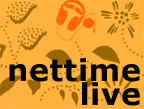
Dear Nettime: WE NEED YOU
This 30th of May 2006, we have confirmed a space and time for a flesh gathering of Nettimers in Montreal, Canada. The Gathering will officially launch the seventh edition of Montreal's MUTEK festival as well as the second year of the Upgrade International. WE NEED YOU TO PARTICIPATE.
- - talk (we're good at that): speakers & presenters, panelists, ranters, poets, net.verbiage & word.age, writers ...
- - perform: sound, video, dance, code, djs, musicians .. we are technically prepared. We hope.
- - intervene ... ... ...
Moderator Ted Byfield will be there. We may supply pies for the occasion. Others will be confirmed shortly.
SEND US YOUR PROPOSALS by POSTING THEM TO THE LIST and cc:ing them to: tobias @ techno . ca .
We will try & accomodate as many of you as we can in the space of approximately 18 hours. We are not here to judge your proposals: there's been flurries of interest, so now we nominate Nettime to come through with bodies in attendance. Once we can confirm your particular presence, we can begin fitting everyone in.
IN THE WORKS : IDEAS ARE CIRCULATING FOR A NETTIME PRINT-ON-DEMAND PUBLICATION. BUT FIRST WE NEED THE EVENT TO COME TOGETHER.
ALSO, this is a great chance to :
a) see the sites & sounds of Mutek (we are inquiring about receiving limited festival passes for participants...)
b) see Montreal
c) get away
d) see Canada
e) see North America
f) learn French, drink on a terrasse, enjoy healthy smoke, etc.
yours,
tobias
sophie
anik
[ http://theupgrade.sat.qc.ca ]
Posted by jo at 11:30 AM | Comments (0)
Jason Van Anden @ Dorkbot

IntelligentDesigner Preview
Jason Van Anden: IntelligentDesigner Preview at Dorkbot May 3rd, 7pm Location One Gallery in Soho, New York City--What do you get when you combine probablistic programming paradigms, computers with feelings and a room full of the gifted and talented? Artist / Technologist / Robot Maker Jason Van Anden will demonstrate the beta of his newest creation (code named IntelligentDesigner) - software that enables pretty much anyone to control things in an uncontrollable way. ID was originally invented to enable improvisational behavior simulating human emotional mechanics between his life-size emotive robots Neil and Iona. In its current incarnation, ID can be used to easily create rich multilayered living music from samples, with many more esoteric applications coming down the pike. Jason hopes to get feedback of ID beta from the Dorkbot ranks and recruit some early adopters to start making things with it before its official release this Fall.
Posted by jo at 11:17 AM | Comments (0)
Mapchester:
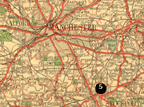
Making an open-source map for Manchester
Mapchester: Making an open-source map for Manchester--Saturday 13th and Sunday 14th May, 2006. When bands like the Happy Mondays stalked the Hacienda, Manchester was dubbed 'Madchester'; now, a new generation of phreaks are in town, renaming the city 'Mapchester', showing that it isn't just music that puts the city on the map.
Mapchester is a collaborative 'wikimap' project, generated and maintained by users in the same way as Wikipedia. It kicks off with a Mapping Weekend, when Manchester is mapped in a weekend! A number of spin off projects will then take place during the Futuresonic festival, 20-23 July 2006 under the Mapchester banner, and the data generated will be used in a test-case festival guide.
Mapchester will generate a new kind map of Manchester - produced by collective, community effort that will be completely copyright-free. Mapchester was first proposed at the PLAN workshop, as a test-case for how a city could be mapped and a guide for a festival created on collaborative and open principles.
Mapping Weekend invitation: We are seeking map hackers and citizen cartographers to participate in mapping the city for free. Our goal is to bring together as wide an array of different people who are interested in mapping and get them to walk / cycle / drive / bus / train / skate / etc / along city streets recording GPS tracks and noting down road names. These tracks will then be put online in the OpenStreetMap database and edited into map features. We hope that collectively people will work to completely map whole quarters of the city over the weekend.
Please spread the word about Mapchester and forward this invitation to come and map Manchester to other people who might be interested.
Getting involved:
|||| How: Just come along and choose an area of central Manchester to map. Head out with a GPS device (Global Positioning System, which monitors signals from satellites to record location) and notepad to record street names and other notable features. You can map for the whole day or just for a few hours. No prior mapping experience needed - intro briefings and equipment training will be provided.
|||| When: Saturday 13th and Sunday 14th May, 2006. Welcome briefings held at 10am and 2pm both days.
|||| Where: Mapchester HQ, Lower Ground Floor, 117-119 Portland Street, Manchester M1 6ED, see http://manchesterdda.com/article/12/ . (The space has been generously provided by the Manchester Digital Development Agency and they are also helping in signing people up to take part.)
|||| Registering: if you are interested in participating please send an email: mapchester@manchesterdda.com or call Jo Blackwell on tele: 0161 255 8111. (Please indicate on what days you want to participate and whether you have your own GPS / laptop.)
|||| Refreshments: Drinks and a sandwich lunch will be provided for participants.
|||| What to bring: If you have it please bring your own mapping equipment (GPS, laptop, camera, notepad + pencil, etc). If you don't have a GPS receiver, don't worry, there will be a number of extra units available on each day. If you have never used a GPS receiver, don't worry either, hands on training will be provided.
|||| Further questions: please contact Martin Dodge (m.dodge[at]manchester.ac.uk).
Some background:
Mapchester is an experiment in 'citizen cartography' that we hope will make a significant contribution to wider efforts in so-called 'open-source' mapping. This an emerging and rapidly growing cartographic activity, driven in part by technology (cheap GPS equipment and online collaboration tools, like OpenStreetMap.org), but also by a very different ethos to knowledge production. Under open-source models the right of authorship are de-centred and the ownership of knowledge is seen as a common resource that can be distributed and re-used without restriction or license. As such 'opening' up mapmaking has real potential to empower people to create their own knowledge and encourages re-use of cartographic resource in novel, creative ways.
The map data produced for central Manchester will contribute to OpenStreetMap.org, one of the leading projects in the open-source mapping field. Currently, OpenStreetMap has mapped 25,000 kilometres of roads in the UK, including all motorways. However, thus far the majority of this data is for London and Birmingham and many other major cities are hardly mapped at all. It is hoped that an intensive effort to build a map of the whole of a city in a weekend will inspire others and be important to build momentum across the country.
All the map data generated for Mapchester will be free to view, edit and use via the OpenStreetMap platform. An editable map will also be created and used as a test-case festival guide for the Futuresonic International Festival, held in Manchester 20-23 July 2006.
Mapchester mapping weekend is supported by:
|||| Future Everything / Futuresonic International Festival
|||| University of Manchester, School of Environment and Development
|||| Manchester Geographical Society
|||| Manchester Digital Development Agency
Mapchester organising committee:
Steve Coast (OpenStreetMap.org); Drew Hemment (Future Everything); Mick Lockwood (Salford University); Martin Dodge & Chris Perkins (Geography, University of Manchester).
Thanks to:
Mikel Maron (WorldKIT), Libby Miller (FOAF), Ben Russell (PLAN), Steve Benford (Mixedreality Lab) and all others supporting this project.
Please spread the word about Mapchester and forward this invitation to come and map Manchester to other people who might be interested.
Posted by jo at 11:06 AM | Comments (0)
ambientTV.NET newsletter 05/2006
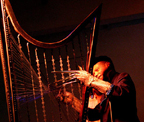
Surveillance Practices
ambientTV.NET is a crucible for independent, interdisciplinary practice ranging from installation and performance, through documentary, dance, and gastronomy, to sound and video composition and real-time manipulation. Techniques and effects of live data broadcasting and transmission provide theme, medium, and performative space for many of the works.
Orchestra of Anxiety @ 12 Int. Festival of Computer Arts in Maribor: The first realized piece from ambientTV.NET's collection of musical instruments constructed using materials and technologies from the security and surveillance industries--a harp with strings of razor wire. After having sliced the fingers of the many courageous Slovakian guest harpists last month, it will be on show in Maribor, Slovenia, 10-12th of May, 2006
---> http://www.ambientTV.NET/5/ooa
---> http://www.kibla.org
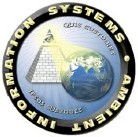
Who Watches the Watchers? @ Skolska28 and FAMU in Prague
Thu., May 18, 6pm - presentation (Skolska28)
Fri., May 19, 2pm - workshop and screening (Film and TV School of the Academy of Performing arts in Prague, Lazansky palac, Room2)
Recent works of artists Manu Luksch and Mukul Patel reflect upon the omnipresence of surveillance technology in our daily environment by making use of it in humorous, unanticipated ways. The artists will show examples of their productions and discuss access to and artistic reinterpretation of these 'tools'...
--> http://www.ambienttv.net/content/?q=thespyschool
--> http://openstudios.info
--> http://www.skolska28.cz
--> http://www.famu.cz

faceless @ GBK Gallery in Sydney
keep the date: opening 6-8pm, 2 June 2006 at Gallery Barry Keldoulis, 2 Danks Street, Waterloo, Sydney Sean Cordeiro & Claire Healy will present new installations in their exhibition Custom Living and Austrian artist Manu Luksch will show her video installation faceless--a sci-fi CCTV thriller.
--> http://www.ambienttv.net/content/?q=faceless
--> http://www.gbk.com.au
Posted by jo at 10:41 AM | Comments (0)
